10.1: Introduction to the Time Value of Money
10.1.1: Importance of the Time Value of Money
Time value of money is integral in making the best use of a financial player’s limited funds.
Learning Objective
Describe why the time value of money is important when analyzing a potential project
Key Points
- Money today is worth more than the same quantity of money in the future. You can invest a dollar today and receive a return on your investment.
- Loans, investments, and any other deal must be compared at a single point in time to determine if it’s a good deal or not.
- The process of determining how much a future cash flow is worth today is called discounting. It is done for most major business transactions during investing decisions in capital budgeting.
Key Terms
- discounting
-
The process of determining how much money paid/received in the future is worth today. You discount future values of cash back to the present using the discount rate.
- interest rate
-
The percentage of an amount of money charged for its use per some period of time. It can also be thought of as the cost of not having money for one period, or the amount paid on an investment per year.
Why is the Time Value of Money Important?
The time value of money is a concept integral to all parts of business. A business does not want to know just what an investment is worth todayit wants to know the total value of the investment. What is the investment worth in total? Let’s take a look at a couple of examples.
Suppose you are one of the lucky people to win the lottery. You are given two options on how to receive the money.
- Option 1: Take $5,000,000 right now.
- Option 2: Get paid $600,000 every year for the next 10 years.
In option 1, you get $5,000,000 and in option 2 you get $6,000,000. Option 2 may seem like the better bet because you get an extra $1,000,000, but the time value of money theory says that since some of the money is paid to you in the future, it is worth less. By figuring out how much option 2 is worth today (through a process called discounting), you’ll be able to make an apples-to-apples comparison between the two options. If option 2 turns out to be worth less than $5,000,000 today, you should choose option 1, or vice versa.
Let’s look at another example. Suppose you go to the bank and deposit $100. Bank 1 says that if you promise not to withdraw the money for 5 years, they’ll pay you an interest rate of 5% a year. Before you sign up, consider that there is a cost to you for not having access to your money for 5 years. At the end of 5 years, Bank 1 will give you back $128. But you also know that you can go to Bank 2 and get a guaranteed 6% interest rate, so your money is actually worth 6% a year for every year you don’t have it. Converting our present cash worth into future value using the two different interest rates offered by Banks 1 and 2, we see that putting our money in Bank 1 gives us roughly $128 in 5 years, while Bank 2’s interest rate gives $134. Between these two options, Bank 2 is the better deal for maximizing future value.

Compound Interest
In this formula, your deposit ($100) is PV, i is the interest rate (5% for Bank 1, 6% for Bank 2), t is time (5 years), and FV is the future value.
10.1.2: Defining the Time Value of Money
The Time Value of Money is the concept that money is worth more today that it is in the future.
Learning Objective
Identify the variables that are used to calculate the time value of money
Key Points
- Being given $100 today is better than being given $100 in the future because you don’t have to wait for your money.
- Money today has a value (present value, or PV) and money in the future has a value (future value, or FV).
- The amount that the value of the money changes after one year is called the interest rate (i). For example, if money today is worth 10% more in one year, the interest rate is 10%.
Key Terms
- Interest Rate (i or r)
-
The cost of not having money for one period, or the amount paid on an investment per year.
- Present Value (PV)
-
The value of the money today.
- Future Value (FV)
-
The value of the money in the future.
One of the most fundamental concepts in finance is the Time Value of Money. It states that money today is worth more than money in the future.
Imagine you are lucky enough to have someone come up to you and say “I want to give you $500. You can either have $500 right now, or I can give you $500 in a year. What would you prefer? ” Presumably, you would ask to have the $500 right now. If you took the money now, you could use it to buy a TV. If you chose to take the money in one year, you could still use it to buy the same TV, but there is a cost. The TV might not be for sale, inflation may mean that the TV now costs $600, or simply, you would have to wait a year to do so and should be paid for having to wait. Since there’s no cost to taking the money now, you might as well take it.
There is some value, however, that you could be paid in one year that would be worth the same to you as $500 today. Say it’s $550- you are completely indifferent between taking $500 today and $550 next year because even if you had to wait a year to get your money, you think $50 is worth waiting.
In finance, there are special names for each of these numbers to help ensure that everyone is talking about the same thing. The $500 you get today is called the Present Value (PV). This is what the money is worth right now. The $550 is called the Future Value (FV). This is what $500 today is worth after the time period (t)- one year in this example. In this example money with a PV of $500 has a FV of $550. The rate that you must be paid per year in order to not have the money is called an Interest Rate (i or r).
All four of the variables (PV, FV, r, and t) are tied together in the equation in . Don’t worry if this seems confusing; the concept will be explored in more depth later.

Simple Interest Formula
Simple interest is when interest is only paid on the amount you originally invested (the principal). You don’t earn interest on interest you previously earned.
10.2: Future Value, Single Amount
10.2.1: Multi-Period Investment
Multi-period investments take place over more than one period (usually multiple years). They can either accrue simple or compound interest.
Learning Objective
Calculate the future value of a multi-period investment with simple and complex interest rates
Key Points
- Investments that accrue simple interest have interest paid based on the amount of the principal, not the balance in the account.
- Investments that accrue compound interest have interest paid on the balance of the account. This means that interest is paid on interest earned in previous periods.
- Simple interest increases the balance linearly, while compound interest increases it exponentially.
Key Terms
- accrue
-
To add, or grow.
- principal
-
The money originally invested or loaned, on which basis interest and returns are calculated.
There are two primary ways of determining how much an investment will be worth in the future if the time frame is more than one period.
The first concept of accruing (or earning) interest is called “simple interest. ” Simple interest means that you earn interest only on the principal. Your total balance will go up each period, because you earn interest each period, but the interest is paid only on the amount you originally borrowed/deposited. Simple interest is expressed through the formula in.

Simple Interest Formula
Simple interest is when interest is only paid on the amount you originally invested (the principal). You don’t earn interest on interest you previously earned.
Suppose you make a deposit of $100 in the bank and earn 5% interest per year. After one year, you earn 5% interest, or $5, bringing your total balance to $105. One more year passes, and it’s time to accrue more interest. Since simple interest is paid only on your principal ($100), you earn 5% of $100, not 5% of $105. That means you earn another $5 in the second year, and will earn $5 for every year of the investment. In simple interest, you earn interest based on the original deposit amount, not the account balance.
The second way of accruing interest is called “compound interest. ” In this case, interest is paid at the end of each period based on the balance in the account. In simple interest, it is only how much the principal is that matters. In compound interest, it is what the balance is that matters. Compound interest is named as such because the interest compounds: Interest is paid on interest. The formula for compound interest is.

Compound Interest
Interest is paid at the total amount in the account, which may include interest earned in previous periods.
Suppose you make the same $100 deposit into a bank account that pays 5%, but this time, the interest is compounded. After the first year, you will again have $105. At the end of the second year, you also earn 5%, but it’s 5% of your balance, or $105. You earn $5.25 in interest in the second year, bringing your balance to $110.25. In the third year, you earn interest of 5% of your balance, or $110.25. You earn $5.51 in interest bringing your total to $115.76.
Compare compound interest to simple interest. Simple interest earns you 5% of your principal each year, or $5 a year. Your balance will go up linearly each year. Compound interest earns you $5 in the first year, $5.25 in the second, a little more in the third, and so on. Your balance will go up exponentially.
Simple interest is rarely used compared to compound interest, but it’s good to know both types.
10.2.2: Approaches to Calculating Future Value
Calculating FV is a matter of identifying PV, i (or r), and t (or n), and then plugging them into the compound or simple interest formula.
Learning Objective
Describe the difference between compounding interest and simple interest
Key Points
- The “present” can be moved based on whatever makes the problem easiest. Just remember that moving the date of the present also changes the number of periods until the future for the FV.
- To find FV, you must first identify PV, the interest rate, and the number of periods from the present to the future.
- The interest rate and the number of periods must have consistent units. If one period is one year, the interest rate must be X% per year, and vis versa.
Key Term
- quarter
-
A period of three consecutive months (1/4 of a year).
The method of calculating future value for a single amount is relatively straightforward; it’s just a matter of plugging numbers into an equation. The tough part is correctly identifying what information needs to be plugged in.
As previously discussed, there are four things that you need to know in order to find the FV:
- How does the interest accrue? Is it simple or compounding interest?
- Present Value
- Interest Rate
- Number of periods
Let’s take one complex problem as an example:
On June 1, 2014, you will take out a $5000 loan for 8-years. The loan accrues interest at a rate of 3% per quarter. On January 1, 2015, you will take out another $5000, eight-year loan, with this one accruing 5% interest per year. The loan accrues interest on the principal only. What is the total future value of your loans on December 31, 2017?
First, the question is really two questions: What is the value of the first loan in 2017, and what is the value of the second in 2017? Once both values are found, simply add them together.
Let’s talk about the first loan first. The present value is $5,000 on June 1, 2014. It is possible to find the value of the loan today, and then find it’s value in 2017, but since the value is the same in 2017, it’s okay to just imagine it is 2014 today. Next, we need to identify the interest rate. The problem says it’s 3% per quarter, or 3% every three months. Since the problem doesn’t say otherwise, we assume that the interest on this loan is compounded. That means we will use the formula in . Finally, we need to identify the number of periods. There are two and a half years between the inception of the loan and when we need the FV. But recall that the interest rate and periods must be in the same units. That means that the interest must either be converted to % per year, or one period must be one quarter. Let’s take one period to be one quarter. That means there are 10 periods. Please note that we don’t really care when the loan ends in this problem–we only care about the value of the loan on December 31, 2017.

Compound Interest
Interest is paid at the total amount in the account, which may include interest earned in previous periods.
Next, we simply plug the numbers into . PV=5000, i=.03, and t=10. That gives us a FV of $6,719.58.
Now let’s find the value of the second loan at December 31, 2017. Again, PV=$5000, but this time, pretend it is January 1, 2015. This time, the interest is 5% per year and it is explicitly stated to be simple interest. That means we use the formula in . January 31, 2017 is exactly two years from the January 1, 2015 and since the interest is measured per year, we can set t=2 years.
When we plug all of those numbers into , we find that FV=$5,500.00

Simple Interest Formula
Simple interest is when interest is only paid on the amount you originally invested (the principal). You don’t earn interest on interest you previously earned.
Since the problem asks for the total FV of the loans, we add $6,719.58 to $5,500.00, and get a total value of $12,219.58
10.2.3: Calculating Future Value
The Future Value can be calculated by knowing the present value, interest rate, and number of periods, and plugging them into an equation.
Learning Objective
Distinguish between calculating future value with simple interest and with compound interest
Key Points
- The future value is the value of a given amount of money at a certain point in the future if it earns a rate of interest.
- The future value of a present value is calculated by plugging the present value, interest rate, and number of periods into one of two equations.
- Unless otherwise noted, it is safe to assume that interest compounds and is not simple interest.
Key Term
- compound interest
-
Interest, as on a loan or a bank account, that is calculated on the total on the principal plus accumulated unpaid interest.
When calculating a future value (FV), you are calculating how much a given amount of money today will be worth some time in the future. In order to calculate the FV, the other three variables (present value, interest rate, and number of periods) must be known. Recall that the interest rate is represented by either r or i, and the number of periods is represented by either t or n. It is also important to remember that the interest rate and the periods must be in the same units. That is, if the interest rate is 5% per year, one period is one year. However, if the interest rate is 5% per month, t or n must reflect the number of periods in terms of months.
Example 1
What is the FV of a $500, 10-year loan with 7% annual interest?
In this case, the PV is $500, t is 10 years, and i is 7% per year. The next step is to plug these numbers into an equation. But recall that there are two different formulas for the two different types of interest, simple interest and compound interest . If the problem doesn’t specify how the interest is accrued, assume it is compound interest, at least for business problems.

Compound Interest
Interest is paid at the total amount in the account, which may include interest earned in previous periods.

Simple Interest Formula
Simple interest is when interest is only paid on the amount you originally invested (the principal). You don’t earn interest on interest you previously earned.
So from the formula, we see that FV=PV(1+i)t so FV=500(1+.07)10. Therefore, FV=$983.58.
In practical terms, you just calculated how much your loan will be in 10 years. This assumes that you don’t need to make any payments during the 10 years, and that the interest compounds. Unless the problem states otherwise, it is safe to make these assumptions – you will be told if there are payments during the 10 year period or if it is simple interest.
Example 2
Suppose we want to again find the future value of a $500, 10-year loan, but with an interest rate of 1% per month. In order to get our total number of periods (t), we would multiply 12 months by 10 years, which equals 120 periods. Therefore:
FV=500(1+.01)120
FV=$1,650.19
10.2.4: Single-Period Investment
Since the number of periods (n or t) is one, FV=PV(1+i), where i is the interest rate.
Learning Objective
Calculate the future value of a single-period investment
Key Points
- Single-period investments use a specified way of calculating future and present value.
- Single-period investments take place over one period (usually one year).
- In a single-period investment, you only need to know two of the three variables PV, FV, and i. The number of periods is implied as one since it is a single-period.
Key Terms
- Single-period investment
-
An investment that takes place over one period, usually one year.
- Multi-period investment
-
An investment that takes place over more than one periods.
- Periods (t or n)
-
Units of time. Usually one year.
Example
- What is the value of a single-period, $100 investment at a 5% interest rate? PV=100 and i=5% (or .05) so FV=100(1+.05). FV=100(1.05) FV=$105.
The amount of time between the present and future is called the number of periods. A period is a general block of time. Usually, a period is one year. The number of periods can be represented as either t or n.
Suppose you’re making an investment, such as depositing your money in a bank. If you plan on leaving the money there for one year, you’re making a single-period investment. Any investment for more than one year is called a multi-period investment.
Let’s go through an example of a single-period investment. As you know, if you know three of the following four values, you can solve for the fourth:
- Present Value (PV)
- Future Value (FV)
- Interest Rate (i or r) [Note: for all formulas, express interest in it’s decimal form, not as a whole number. 7% is .07, 12% is .12, and so on. ]
- Number of Periods (t or n)
In a single-period, there is only one formula you need to know: FV=PV(1+i). The full formulas, which we will be addressing later, are as follows:
Compound interest:
.
Simple interest:
We will address these later, but note that when
both formulas become $FV = PV \cdot (1+i)$.
For example, suppose you deposit $100 into a bank account that pays 3% interest. What is the balance in your account after one year?
In this case, your PV is $100 and your interest is 3%. You want to know the value of your investment in the future, so you’re solving for FV. Since this is a single-period investment, t (or n) is 1. Plugging the numbers into the formula, you get FV=100(1+.03) so FV=100(1.03) so FV=103. Your balance will be $103 in one year.
10.3: Annuities
10.3.1: Calculating Annuities
Understanding the relationship between each variable and the broader concept of the time value of money enables simple valuation calculations of annuities.
Learning Objective
Calculate the present or future value of various annuities based on the information given
Key Points
- Annuities are basically loans that are paid back over a set period of time at a set interest rate with consistent payments each period.
- A mortgage or car loan are simple examples of an annuity. Borrowers agree to pay a given amount each month when borrowing capital to compensate for the risk and the time value of money.
- The six potential variables included in an annuity calculation are the present value, the future value, interest, time (number of periods), payment amount, and payment growth (if applicable).
- Through integrating each of these (excluding payment growth, if payments are consistent over time), it is simple to solve for the present of future value of a given annuity.
Key Term
- annuity
-
A right to receive amounts of money regularly over a certain fixed period in repayment of a loan or investment (or perpetually, in the case of a perpetuity).
Annuities Defined
To understand how to calculate an annuity, it’s useful to understand the variables that impact the calculation. An annuity is essentially a loan, a multi-period investment that is paid back over a fixed (or perpetual, in the case of a perpetuity) period of time. The amount paid back over time is relative to the amount of time it takes to pay it back, the interest rate being applied, and the principal (when creating the annuity, this is the present value).
Generally speaking, annuities and perpetuities will have consistent payments over time. However, it is also an option to scale payments up or down, for various reasons.
Variables
This gives us six simple variables to use in our calculations:
- Present Value (PV) – This is the value of the annuity at time 0 (when the annuity is first created)
- Future Value (FV) – This is the value of the annuity at time n (i.e. at the conclusion of the life of the annuity).
- Payments (A) – Each period will require individual payments that will be represented by this amount.
- Number of Payments (n) – The number of payments (A) will equate to the number of expected periods of payment over the life of the annuity.
- Interest (i) – Annuities occur over time, and thus a given rate of return (interest) is applied to capture the time value of money.
- Growth (g) – For annuities that have changes in payments, there is a growth rate applied to these payments over time.
Calculating Annuities
With all of the inputs above at hand, it’s fairly simply to value various types of annuities. Generally investors, lenders, and borrowers are interested in the present and future value of annuities.
Present Value
The present value of an annuity can be calculated as follows:
For a growth annuity (where the payment amount changes at a predetermined rate over the life of the annuity), the present value can be calculated as follows:
Future Value
The future value of an annuity can be determined using this equation:
In a situation where payments grow over time, the future value can be determined using this equation:
Various Formula Arrangements
It is also possible to use existing information to solve for missing information. Which is to say, if you know interest and time, you can solve for the following (given the following):
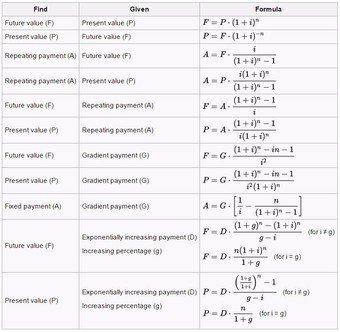
Annuities Equations
This table is a useful way to view the calculation of annuities variables from a number of directions. Understanding how to manipulate the formula will underline the relationship between the variables, and provide some conceptual clarity as to what annuities are.
10.3.2: Present Value of Annuity
The PV of an annuity can be found by calculating the PV of each individual payment and then summing them up.
Learning Objective
Calculate the present value of annuities
Key Points
- The PV for both annuities-due and ordinary annuities can be calculated using the size of the payments, the interest rate, and number of periods.
- The PV of a perpetuity can be found by dividing the size of the payments by the interest rate.
- Payment size is represented as p, pmt, or A; interest rate by i or r; and number of periods by n or t.
Key Term
- perpetuity
-
An annuity in which the periodic payments begin on a fixed date and continue indefinitely.
The Present Value (PV) of an annuity can be found by calculating the PV of each individual payment and then summing them up . As in the case of finding the Future Value (FV) of an annuity, it is important to note when each payment occurs. Annuities-due have payments at the beginning of each period, and ordinary annuities have them at the end.
Recall that the first payment of an annuity-due occurs at the start of the annuity, and the final payment occurs one period before the end. The PV of an annuity-due can be calculated as follows:
where
is the size of the payment (sometimes
or
),
is the interest rate, and
is the number of periods.
An ordinary annuity has annuity payments at the end of each period, so the formula is slightly different than for an annuity-due. An ordinary annuity has one full period before the first payment (so it must be discounted) and the last payment occurs at the termination of the annuity (so it must be discounted for one period more than the last period in an annuity-due). The formula is:
where, again,
,
, and
are the size of the payment, the interest rate, and the number of periods, respectively.
Both annuities-due and ordinary annuities have a finite number of payments, so it is possible, though cumbersome, to find the PV for each period. For perpetuities, however, there are an infinite number of periods, so we need a formula to find the PV. The formula for calculating the PV is the size of each payment divided by the interest rate.
Example 1
Suppose you have won a lottery that pays $1,000 per month for the next 20 years. But, you prefer to have the entire amount now. If the interest rate is 8%, how much will you accept?
Consider for argument purposes that two people, Mr. Cash, and Mr. Credit, have won the same lottery of $1,000 per month for the next 20 years. Now, Mr. Credit is happy with his $1,000 monthly payment, but Mr. Cash wants to have the entire amount now. Our job is to determine how much Mr. Cash should get. We reason as follows: If Mr. Cash accepts x dollars, then the x dollars deposited at 8% for 20 years should yield the same amount as the $1,000 monthly payments for 20 years. In other words, we are comparing the future values for both Mr. Cash and Mr. Credit, and we would like the future values to be equal.
Since Mr. Cash is receiving a lump sum of x dollars, its future value is given by the lump sum formula:
Since Mr. Credit is receiving a sequence of payments, or an annuity, of $1,000 per month, its future value is given by the annuity formula:
The only way Mr. Cash will agree to the amount he receives is if these two future values are equal. So we set them equal and solve for the unknown:
The reader should also note that if Mr. Cash takes his lump sum of $119,554.36 and invests it at 8% compounded monthly, he will have $589,020.41 in 20 years.
Example 2
Find the monthly payment for a car costing $15,000 if the loan is amortized over five years at an interest rate of 9%.
Again, consider the following scenario: Two people, Mr. Cash and Mr. Credit, go to buy the same car that costs $15,000. Mr. Cash pays cash and drives away, but Mr. Credit wants to make monthly payments for five years. Our job is to determine the amount of the monthly payment.
We reason as follows: If Mr. Credit pays x dollars per month, then the x dollar payment deposited each month at 9% for 5 years should yield the same amount as the $15,000 lump sum deposited for 5 years. Again, we are comparing the future values for both Mr. Cash and Mr. Credit, and we would like them to be the same.
Since Mr. Cash is paying a lump sum of $15,000, its future value is given by the lump sum formula:
Mr. Credit wishes to make a sequence of payments, or an annuity, of x dollars per month, and its future value is given by the annuity formula:
We set the two future amounts equal and solve for the unknown:
10.3.3: Future Value of Annuity
The future value of an annuity is the sum of the future values of all of the payments in the annuity.
Learning Objective
Calculate the future value of different types of annuities
Key Points
- To find the FV, you need to know the payment amount, the interest rate of the account the payments are deposited in, the number of periods per year, and the time frame in years.
- The first and last payments of an annuity due both occur one period before they would in an ordinary annuity, so they have different values in the future.
- There are different formulas for annuities due and ordinary annuities because of when the first and last payments occur.
Key Terms
- annuity-due
-
An investment with fixed-payments that occur at regular intervals, paid at the beginning of each period.
- ordinary repair
-
expense accrued in normal maintenance of an asset
- annuity-due
-
a stream of fixed payments where payments are made at the beginning of each period
- ordinary annuity
-
An investment with fixed-payments that occur at regular intervals, paid at the end of each period.
The future value of an annuity is the sum of the future values of all of the payments in the annuity. It is possible to take the FV of all cash flows and add them together, but this isn’t really pragmatic if there are more than a couple of payments.
If you were to manually find the FV of all the payments, it would be important to be explicit about when the inception and termination of the annuity is. For an annuity-due, the payments occur at the beginning of each period, so the first payment is at the inception of the annuity, and the last one occurs one period before the termination.
For an ordinary annuity, however, the payments occur at the end of the period. This means the first payment is one period after the start of the annuity, and the last one occurs right at the end. There are different FV calculations for annuities due and ordinary annuities because of when the first and last payments occur.
There are some formulas to make calculating the FV of an annuity easier. For both of the formulas we will discuss, you need to know the payment amount (m, though often written as pmt or p), the interest rate of the account the payments are deposited in (r, though sometimes i), the number of periods per year (n), and the time frame in years (t).
The formula for an ordinary annuity is as follows:
where m is the payment amount, r is the interest rate, n is the number of periods per year, and t is the length of time in years.
In contrast, the formula for an annuity-due is as follows:
Provided you know m, r, n, and t, therefore, you can find the future value (FV) of an annuity.
10.3.4: Annuities
An annuity is a type of investment in which regular payments are made over the course of multiple periods.
Learning Objective
Classify the different types of annuity
Key Points
- Annuities have payments of a fixed size paid at regular intervals.
- There are three types of annuities: annuities-due, ordinary annuities, and perpetuities.
- Annuities help both the creditor and debtor have predictable cash flows, and it spreads payments of the investment out over time.
Key Term
- period
-
The length of time during which interest accrues.
An annuity is a type of multi-period investment where there is a certain principal deposited and then regular payments made over the course of the investment. The payments are all a fixed size. For example, a car loan may be an annuity: In order to get the car, you are given a loan to buy the car. In return you make an initial payment (down payment), and then payments each month of a fixed amount. There is still an interest rate implicitly charged in the loan. The sum of all the payments will be greater than the loan amount, just as with a regular loan, but the payment schedule is spread out over time.
Suppose you are the bank that makes the car loan. There are three advantages to making the loan an annuity. The first is that there is a regular, known cash flow. You know how much money you’ll be getting from the loan and when you’ll be getting them. The second is that it should be easier for the person you are loaning to to repay, because they are not expected to pay one large amount at once. The third reason why banks like to make annuity loans is that it helps them monitor the financial health of the debtor. If the debtor starts missing payments, the bank knows right away that there is a problem, and they could potentially amend the loan to make it better for both parties.
Similar advantages apply to the debtor. There are predictable payments, and paying smaller amounts over multiple periods may be advantageous over paying the whole loan plus interest and fees back at once.
Since annuities, by definition, extend over multiple periods, there are different types of annuities based on when in the period the payments are made. The three types are:
- Annuity-due: Payments are made at the beginning of the period . For example, if a period is one month, payments are made on the first of each month.
- Ordinary Annuity: Payments are made at the end of the period . If a period is one month, this means that payments are made on the 28th/30th/31st of each month. Mortgage payments are usually ordinary annuities.
- Perpetuities: Payments continue forever. This is much rarer than the first two types.
10.4: Additional Detail on Present and Future Values
10.4.1: Loans and Loan Amortization
When borrowing money to be paid back via a number of installments over time, it is important to understand the time value of money and how to build an amortization schedule.
Learning Objective
Understand amortization schedules
Key Points
- Amortization of a loan is the process of identifying a payment amount for each period of repayment on a given outstanding debt.
- Repaying capital over time at an interest rate requires an amortization schedule, which both parties agree to prior to the exchange of capital. This schedule determines the repayment period, as well as the amount of repayment per period.
- Time value of money is a central concept to amortization. A dollar today, for example, is worth more than a dollar tomorrow due to the opportunity cost of other investments.
- When purchasing a home for $100,000 over 30 years at 8% interest (consistent payments each month), for example, the total amount of repayment is more than 2.5 times the original principal of $100,000.
Key Term
- amortization
-
This is the process of scheduling intervals of payment over time to pay back an existing debt, taking into account the time value of money.
When lending money (or borrowing, depending on your perspective), it is common to have multiple payback periods over time (i.e. multiple, smaller cash flow installments to pay back the larger borrowed sum). In these situations, an amortization schedule will be created. This will determine how much will be paid back each period, and how many periods of repayment will be required to cover the principal balance. This must be agreed upon prior to the initial borrowing occurs, and signed by both parties.
Time Value of Money
Now if you add up all of the separate payments in an amortization schedule, you’ll find the total exceeds the amount borrowed. This is because amortization schedules must take into account the time value of money. Time value of money is a fairly simple concept at it’s core: a dollar today is worth more than a dollar tomorrow.
Why? Because capital can be invested, and those investments can yield returns. Lending your money to someone means incurring the opportunity cost of the other things you could do with that money. This gets even more drastic as the scale of capital increases, as the returns on capital over time are expressed in a percentage of the capital invested. Say you spend $100 on some stock, and turn 10% on that investment. You now have $110, a profit of $10. Say instead of only a $100, you put in $10,000. Now you have $11,000, a profit of $1,000.
Principle and Interest
As a result of this calculation, amortization schedules charge interest over time as a percentage of the principal borrowed. The calculation will incorporate the number of payment periods (n), the principal (P), the amortization payment (A) and the interest rate (r).
To make this a bit more realistic, let’s insert some numbers. Let’s say you find a dream house, at the reasonable rate of $100,000. Unfortunately, a bit of irresponsible borrowing in your past means you must pay 8% interest over a 30 year loan, which will be paid via a monthly amortization schedule (12 months x 30 years = 360 payments total). If you do the math, you should find yourself paying $734 per month 360 times. 360 x 734 will leave you in the ballpark of $264,000 in total repayment. that means you are paying more than 2.5 times as much for this house due to time value of money! This bit of knowledge is absolutely critical for personal financial decisions, as well as for high level business decisions.
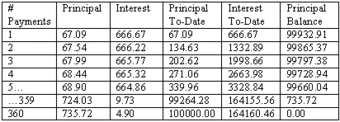
Amortization Schedule Example
This shows the first few installments in the example discussed above (i.e. borrowing $100,000 at 8% interest paid monthly over 30 years).
10.4.2: Calculating Values for Fractional Time Periods
The value of money and the balance of the account may be different when considering fractional time periods.
Learning Objective
Calculate the future and present value of an account when a fraction of a compounding period has passed
Key Points
- The balance of an account only changes when interest is paid. To find the balance, round the fractional time period down to the period when interest was last accrued.
- To find the PV or FV, ignore when interest was last paid an use the fractional time period as the time period in the equation.
- The discount rate is really the cost of not having the money over time, so for PV/FV calculations, it doesn’t matter if the interest hasn’t been added to the account yet.
Key Terms
- time period assumption
-
business profit or loses are measured on timely basis
- compounding period
-
The length of time between the points at which interest is paid.
- time value of money
-
the value of an asset accounting for a given amount of interest earned or inflation accrued over a given period
Up to this point, we have implicitly assumed that the number of periods in question matches to a multiple of the compounding period. That means that the point in the future is also a point where interest accrues. But what happens if we are dealing with fractional time periods?
Compounding periods can be any length of time, and the length of the period affects the rate at which interest accrues.

Compounding Interest
The effect of earning 20% annual interest on an initial $1,000 investment at various compounding frequencies.
Suppose the compounding period is one year, starting January1, 2012. If the problem asks you to find the value at June 1, 2014, there is a bit of a conundrum. The last time interest was actually paid was at January 1, 2014, but the time-value of money theory clearly suggests that it should be worth more in June than in January.
In the case of fractional time periods, the devil is in the details. The question could ask for the future value, present value, etc., or it could ask for the future balance, which have different answers.
Future/Present Value
If the problem asks for the future value (FV) or present value (PV), it doesn’t really matter that you are dealing with a fractional time period. You can plug in a fractional time period to the appropriate equation to find the FV or PV. The reasoning behind this is that the interest rate in the equation isn’t exactly the interest rate that is earned on the money. It is the same as that number, but more broadly, is the cost of not having the money for a time period. Since there is still a cost to not having the money for that fraction of a compounding period, the FV still rises.
Account Balance
The question could alternatively ask for the balance of the account. In this case, you need to find the amount of money that is actually in the account, so you round the number of periods down to the nearest whole number (assuming one period is the same as a compounding period; if not, round down to the nearest compounding period). Even if interest compounds every period, and you are asked to find the balance at the 6.9999th period, you need to round down to 6. The last time the account actually accrued interest was at period 6; the interest for period 7 has not yet been paid.
If the account accrues interest continuously, there is no problem: there can’t be a fractional time period, so the balance of the account is always exactly the value of the money.
10.4.3: The Relationship Between Present and Future Value
Present value (PV) and future value (FV) measure how much the value of money has changed over time.
Learning Objective
Discuss the relationship between present value and future value
Key Points
- The future value (FV) measures the nominal future sum of money that a given sum of money is “worth” at a specified time in the future assuming a certain interest rate, or more generally, rate of return. The FV is calculated by multiplying the present value by the accumulation function.
- PV and FV vary jointly: when one increases, the other increases, assuming that the interest rate and number of periods remain constant.
- As the interest rate (discount rate) and number of periods increase, FV increases or PV decreases.
Key Terms
- discounting
-
The process of finding the present value using the discount rate.
- present value
-
a future amount of money that has been discounted to reflect its current value, as if it existed today
- capitalization
-
The process of finding the future value of a sum by evaluating the present value.
The future value (FV) measures the nominal future sum of money that a given sum of money is “worth” at a specified time in the future assuming a certain interest rate, or more generally, rate of return. The FV is calculated by multiplying the present value by the accumulation function. The value does not include corrections for inflation or other factors that affect the true value of money in the future. The process of finding the FV is often called capitalization.
On the other hand, the present value (PV) is the value on a given date of a payment or series of payments made at other times. The process of finding the PV from the FV is called discounting.
PV and FV are related , which reflects compounding interest (simple interest has n multiplied by i, instead of as the exponent). Since it’s really rare to use simple interest, this formula is the important one.

FV of a single payment
The PV and FV are directly related.
PV and FV vary directly: when one increases, the other increases, assuming that the interest rate and number of periods remain constant.
The interest rate (or discount rate) and the number of periods are the two other variables that affect the FV and PV. The higher the interest rate, the lower the PV and the higher the FV. The same relationships apply for the number of periods. The more time that passes, or the more interest accrued per period, the higher the FV will be if the PV is constant, and vice versa.
The formula implicitly assumes that there is only a single payment. If there are multiple payments, the PV is the sum of the present values of each payment and the FV is the sum of the future values of each payment.
10.4.4: Comparing Interest Rates
Variables, such as compounding, inflation, and the cost of capital must be considered before comparing interest rates.
Learning Objective
Discuss the differences between effective interest rates, real interest rates, and cost of capital
Key Points
- A nominal interest rate that compounds has a different effective rate (EAR), because interest is accrued on interest.
- The Fisher Equation approximates the amount of interest accrued after accounting for inflation.
- A company will theoretically only invest if the expected return is higher than their cost of capital, even if the return has a high nominal value.
Key Term
- inflation
-
An increase in the general level of prices or in the cost of living.
The amount of interest you would have to pay on a loan or would earn on an investment is clearly an important consideration when making any financial decisions. However, it is not enough to simply compare the nominal values of two interest rates to see which is higher.
Effective Interest Rates
The reason why the nominal interest rate is only part of the story is due to compounding. Since interest compounds, the amount of interest actually accrued may be different than the nominal amount. The last section went through one method for finding the amount of interest that actually accrues: the Effective Annual Rate (EAR).
The EAR is a calculation that account for interest that compounds more than one time per year. It provides an annual interest rate that accounts for compounded interest during the year. If two investments are otherwise identical, you would naturally pick the one with the higher EAR, even if the nominal rate is lower.
Real Interest Rates
Interest rates are charged for a number of reasons, but one is to ensure that the creditor lowers his or her exposure to inflation. Inflation causes a nominal amount of money in the present to have less purchasing power in the future. Expected inflation rates are an integral part of determining whether or not an interest rate is high enough for the creditor.
The Fisher Equation is a simple way of determining the real interest rate, or the interest rate accrued after accounting for inflation. To find the real interest rate, simply subtract the expected inflation rate from the nominal interest rate.

Fisher Equation
The nominal interest rate is approximately the sum of the real interest rate and inflation.
For example, suppose you have the option of choosing to invest in two companies. Company 1 will pay you 5% per year, but is in a country with an expected inflation rate of 4% per year. Company 2 will only pay 3% per year, but is in a country with an expected inflation of 1% per year. By the Fisher Equation, the real interest rates are 1% and 2% for Company 1 and Company 2, respectively. Thus, Company 2 is the better investment, even though Company 1 pays a higher nominal interest rate.
Cost of Capital
Another major consideration is whether or not the interest rate is higher than your cost of capital. The cost of capital is the rate of return that capital could be expected to earn in an alternative investment of equivalent risk. Many companies have a standard cost of capital that they use to determine whether or not an investment is worthwhile.
In theory, a company will never make an investment if the expected return on the investment is less than their cost of capital. Even if a 10% annual return sounds really nice, a company with a 13% cost of capital will not make that investment.
10.4.5: Calculating Values for Different Durations of Compounding Periods
Finding the Effective Annual Rate (EAR) accounts for compounding during the year, and is easily adjusted to different period durations.
Learning Objective
Calculate the present and future value of something that has different compounding periods
Key Points
- The units of the period (e.g. one year) must be the same as the units in the interest rate (e.g. 7% per year).
- When interest compounds more than once a year, the effective interest rate (EAR) is different from the nominal interest rate.
- The equation in skips the step of solving for EAR, and is directly usable to find the present or future value of a sum.
Key Terms
- Future Value
-
The value of an asset at a specific date. It measures the nominal future sum of money that a given sum of money is “worth” at a specified time in the future, assuming a certain interest rate, or more generally, rate of return, it is the present value multiplied by the accumulation function.
- present value
-
Also known as present discounted value, is the value on a given date of a payment or series of payments made at other times. If the payments are in the future, they are discounted to reflect the time value of money and other factors such as investment risk. If they are in the past, their value is correspondingly enhanced to reflect that those payments have been (or could have been) earning interest in the intervening time. Present value calculations are widely used in business and economics to provide a means to compare cash flows at different times on a meaningful “like to like” basis.
Sometimes, the units of the number of periods does not match the units in the interest rate. For example, the interest rate could be 12% compounded monthly, but one period is one year. Since the units have to be consistent to find the PV or FV, you could change one period to one month. But suppose you want to convert the interest rate into an annual rate. Since interest generally compounds, it is not as simple as multiplying 1% by 12 (1% compounded each month). This atom will discuss how to handle different compounding periods.
Effective Annual Rate
The effective annual rate (EAR) is a measurement of how much interest actually accrues per year if it compounds more than once per year. The EAR can be found through the formula in where i is the nominal interest rate and n is the number of times the interest compounds per year (for continuous compounding, see ). Once the EAR is solved, that becomes the interest rate that is used in any of the capitalization or discounting formulas.

EAR with Continuous Compounding
The effective rate when interest compounds continuously.

Calculating the effective annual rate
The effective annual rate for interest that compounds more than once per year.
For example, if there is 8% interest that compounds quarterly, you plug .08 in for i and 4 in for n. That calculates an EAR of .0824 or 8.24%. You can think of it as 2% interest accruing every quarter, but since the interest compounds, the amount of interest that actually accrues is slightly more than 8%. If you wanted to find the FV of a sum of money, you would have to use 8.24% not 8%.
Solving for Present and Future Values with Different Compounding Periods
Solving for the EAR and then using that number as the effective interest rate in present and future value (PV/FV) calculations is demonstrated here. Luckily, it’s possible to incorporate compounding periods into the standard time-value of money formula. The equation in is the same as the formulas we have used before, except with different notation. In this equation, A(t) corresponds to FV, A0 corresponds to Present Value, r is the nominal interest rate, n is the number of compounding periods per year, and t is the number of years.

FV Periodic Compounding
Finding the FV (A(t)) given the PV (Ao), nominal interest rate (r), number of compounding periods per year (n), and number of years (t).
The equation follows the same logic as the standard formula. r/n is simply the nominal interest per compounding period, and nt represents the total number of compounding periods.
Solving for n
The last tricky part of using these formulas is figuring out how many periods there are. If PV, FV, and the interest rate are known, solving for the number of periods can be tricky because n is in the exponent. It makes solving for n manually messy. shows an easy way to solve for n. Remember that the units are important: the units on n must be consistent with the units of the interest rate (i).

Solving for n
This formula allows you to figure out how many periods are needed to achieve a certain future value, given a present value and an interest rate.
10.4.6: Calculating Perpetuities
The present value of a perpetuity is simply the payment size divided by the interest rate and there is no future value.
Learning Objective
Calculate the present value of a perpetuity
Key Points
- Perpetuities are a special type of annuity; a perpetuity is an annuity that has no end, or a stream of cash payments that continues forever.
- To find the future value of a perpetuity requires having a future date, which effectively converts the perpetuity to an ordinary annuity until that point.
- Perpetuities with growing payments are called Growing Perpetuities; the growth rate is subtracted from the interest rate in the present value equation.
Key Term
- growth rate
-
The percentage by which the payments grow each period.
Perpetuities are a special type of annuity; a perpetuity is an annuity that has no end, or a stream of cash payments that continues forever. Essentially, they are ordinary annuities, but have no end date. There aren’t many actual perpetuities, but the United Kingdom has issued them in the past.
Since there is no end date, the annuity formulas we have explored don’t apply here. There is no end date, so there is no future value formula. To find the FV of a perpetuity would require setting a number of periods which would mean that the perpetuity up to that point can be treated as an ordinary annuity.
There is, however, a PV formula for perpetuities . The PV is simply the payment size (A) divided by the interest rate (r). Notice that there is no n, or number of periods. More accurately, is what results when you take the limit of the ordinary annuity PV formula as n → ∞.
It is also possible that an annuity has payments that grow at a certain rate per period. The rate at which the payments change is fittingly called the growth rate (g). The PV of a growing perpetuity is represented as
. It is essentially the same as in except that the growth rate is subtracted from the interest rate. Another way to think about it is that for a normal perpetuity, the growth rate is just 0, so the formula boils down to the payment size divided by r.
10.5: Yield
10.5.1: Calculating the Yield of a Single-Period Investment
The yield of a single period investment is simply
.
Learning Objective
Differentiate between the different methods of calculating yield of a single period investment
Key Points
- There are a number of ways to calculate yield, but the most common ones are to calculate the percent change from the initial investment, APR, and APY (or EAR).
- APR (annual percentage rate) is a commonly used calculation that figures out the nominal amount of interest accrued per year. It does not account for compounding interest.
- APY (annual percentage yield) is a way of using the nominal interest rate to calculate the effective interest rate per year. It accounts for compounding interest.
- EAR (effective annual rate) is a special type of APY that uses APR as the nominal interest rate.
Key Terms
- effective-interest method
-
amortizing a debt according to the effective interest rate paid
- Nominal Interest
-
The amount of interest accrued per year without accounting for compounding.
- Effective Interest
-
The amount of interest accrued per year after accounting for compounding.
Determining Yield
The yield on an investment is the amount of money that is returned to the owner at the end of the term. In short, it’s how much you get back on your investment.
Naturally, this is a number that people care a lot about. The whole point of making an investment is to get a yield. There are a number of different ways to calculate an investment’s yield, though. You may get slightly different numbers using different methods, so it’s important to make sure that you use the same method when you are comparing yields. This section will address the yield calculation methods you are most likely to encounter, though there are many more.
Change-In-Value
The most basic type of yield calculation is the change-in-value calculation. This is simply the change in value (FV minus PV) divided by the PV times 100%. This calculation measures how different the FV is from the PV as a percentage of PV.

Percent Change
The percent change in value is the change in value from PV to FV (V2 to V1) divided by PV (V1) times 100%.
Annual Percentage Rate
Another common way of calculating yield is to determine the Annual Percentage Rate, or APR. You may have heard of APR from ads for car loans or credit cards. These generally have monthly loans or fees, but if you want to get an idea of how much you will accrue in interest per year, you need to calculate an APR. Nominal APR is simply the interest rate multiplied by the number of payment periods per year. However, since interest compounds, nominal APR is not a very accurate measure of the amount of interest you actually accrue.
Effective Annual Rate
To find the effective APR, the actual amount of interest you would accrue per year, we use the Effective Annual Rate, or EAR.

EAR
The Effective Annual Rate is the amount of interest actually accrued per year based on the APR. n is the number of compounding periods of APR per year.
For example, you may see an ad that says you can get a car loan at an APR of 10% compounded monthly. That means that APR=.10 and n=12 (the APR compounds 12 times per year). That means the EAR is 10.47%.
The EAR is a form of the Annual Percentage Yield (APY). APY may also be calculated using interest rates other than APR, so a more general formula is in . The logic behind calculating APY is the same as that used when calculating EAR: we want to know how much you actually accrue in interest per year. Interest usually compounds, so there is a difference between the nominal interest rate (e.g. monthly interest times 12) and the effective interest rate.

Annual Percentage Yield
The Annual Percentage Yield is a way or normalizing the nominal interest rate. Basically, it is a way to account for the time factor in order to get a more accurate number for the actual interest rate.inom is the nominal interest rate.N is the number of compounding periods per year.
10.5.2: Calculating the Yield of an Annuity
The yield of an annuity is commonly found using either the percent change in the value from PV to FV, or the internal rate of return.
Learning Objective
Calculate the yield of an annuity using the internal rate of return method
Key Points
- The yield of an annuity may be found by discounting to find the PV, and then finding the percentage change from the PV to the FV.
- The Internal Rate of Return (IRR) is the discount rate at which the NPV of an investment equals 0.
- The IRR calculates an annualized yield of an annuity.
Key Terms
- Net Present Value (NPV)
-
The present value of a project or an investment decision determined by summing the discounted incoming and outgoing future cash flows resulting from the decision.
- Internal Rate of Return (IRR)
-
The discount rate that will cause the NPV of an investment to equal 0.
- yield
-
In finance, the term yield describes the amount in cash that returns to the owners of a security. Normally it does not include the price variations, at the difference of the total return. Yield applies to various stated rates of return on stocks (common and preferred, and convertible), fixed income instruments (bonds, notes, bills, strips, zero coupon), and some other investment type insurance products
The yield of annuity can be calculated in similar ways to the yield for a single payment, but two methods are most common.
The first is the standard percentage-change method. Just as for a single payment, this method calculated the percentage difference between the FV and the PV. Since annuities include multiple payments over the lifetime of the investment, the PV (or V1 in is the present value of the entire investment, not just the first payment.
The second popular method is called the internal rate of return (IRR). The IRR is the interest rate (or discount rate) that causes the Net Present Value (NPV) of the annuity to equal 0. That means that the PV of the cash outflows equals the PV of the cash inflows. The higher the IRR, the more desirable is the investment. In theory, you should make investment with an IRR greater than the cost of capital.
Let’s take an example investment: It is not technically an annuity because the payments vary, but still is a good example for how to find IRR:
Suppose you have a potential investment that would require you to make a $4,000 investment today, but would return cash flows of $1,200, $1,410, $1,875, and $1,050 in the four successive years. This investment has an implicit rate of return, but you don’t know what it is. You plug the numbers into the NPV formula and set NPV equal to 0. You then solve for r, which is your IRR (it’s not easy to solve this problem by hand. You will likely need to use a business calculator or Excel). When r = 14.3%, NPV = 0, so therefore the IRR of the investment is 14.3%.

IRR Example
The setup to find the IRR of the investment with cash flows of -4000, 1200, 1410, 1875, and 1050. By setting NPV = 0 and solving for r, you can find the IRR of this investment.
10.6: Valuing Multiple Cash Flows
10.6.1: Present Value, Multiple Flows
The PV of multiple cash flows is simply the sum of the present values of each individual cash flow.
Learning Objective
Calculate the present value of an investment portfolio that has multiple cash flows
Key Points
- To find the PV of multiple cash flows, each cash flow much be discounted to a specific point in time and then added to the others.
- To discount annuities to a time prior to their start date, they must be discounted to the start date, and then discounted to the present as a single cash flow.
- Multiple cash flow investments that are not annuities unfortunately cannot be discounted by any other method but by discounting each cash flow and summing them together.
Key Terms
- discount
-
To find the value of a sum of money at some earlier point in time. To find the present value.
- net present value
-
the present value of a project or an investment decision determined by summing the discounted incoming and outgoing future cash flows resulting from the decision
The PV of multiple cash flows follows the same logic as the FV of multiple cash flows. The PV of multiple cash flows is simply the sum of the present values of each individual cash flow .

Sum FV
The PV of an investment is the sum of the present values of all its payments.
Each cash flow must be discounted to the same point in time. For example, you cannot sum the PV of two loans at the beginning of the loans if one starts in 2012 and one starts in 2014. If you want to find the PV in 2012, you need to discount the second loan an additional two years, even though it doesn’t start until 2014.
The calculations get markedly simpler if the cash flows make up an annuity. In order to be an annuity (and use the formulas explained in the annuity module), the cash flows need to have three traits:
- Constant payment size
- Payments occur at fixed intervals
- A constant interest rate
Things may get slightly messy if there are multiple annuities, and you need to discount them to a date before the beginning of the payments.
Suppose there are two sets of cash flows which you determine are both annuities. The first extends from 1/1/14 to 1/1/16, and the second extends from 1/1/15 to 1/1/17. You want to find the total PV of all the cash flows on 1/1/13.
The annuity formulas are good for determining the PV at the date of the inception of the annuity. That means that it’s not enough to simply plug in the payment size, interest rate, and number of periods between 1/1/13 and the end of the annuities. If you do, that supposes that both annuities begin on 1/1/13, but neither do. Instead, you have to first find the PV of the first annuity on 1/1/14 and the second on 1/1/15 because that’s when the annuities begin.
You now have two present values, but both are still in the future. You then can discount those present values as if they were single sums to 1/1/13.
Unfortunately, if the cash flows do not fit the characteristics of an annuity, there isn’t a simple way to find the PV of multiple cash flows: each cash flow much be discounted and then all of the PVs must be summed together.
Example
A corporation must decide whether to introduce a new product line. The new product will have start-up expenditures, operational expenditures, and then it will have associated incoming cash receipts (sales) and disbursements (Cash paid for materials, supplies, direct labor, maintenance, repairs, and direct overhead) over 12 years. This project will have an immediate (t=0) cash outflow of 100,000 (which might include all cash paid for the machinery, transportation-in and set-up expenditures, and initial employee training disbursements. ) The annual net cash flow (receipts less disbursements) from this new line for years 1-12 is forecast as follows: -54672, -39161, 3054, 7128, 25927, 28838, 46088, 77076, 46726, 76852, 132332, 166047, reflecting two years of running deficits as experience and sales are built up, with net cash receipts forecast positive after that. At the end of the 12 years it’s estimated that the entire line becomes obsolete and its scrap value just covers all the removal and disposal expenditures. All values are after-tax, and the required rate of return is given to be 10%. (This also makes the simplifying assumption that the net cash received or paid is lumped into a single transaction occurring on the last day of each year. )
The present value (PV) can be calculated for each year:
T=0:
T=1:
T=2:
T=3:
T=4:
T=5:
T=6:
T=7:
T=8:
T=9:
T=10:
T=11:
T=12:
The sum of all these present values is the net present value, which equals 65,816.04. Since the NPV is greater than zero, it would be better to invest in the project than to do nothing, and the corporation should invest in this project if there is no alternative with a higher NPV.
10.6.2: Future Value, Multiple Flows
To find the FV of multiple cash flows, sum the FV of each cash flow.
Learning Objective
Calculate the Future Value of Multiple Annuities
Key Points
- The FV of multiple cash flows is the sum of the FV of each cash flow.
- To sum the FV of each cash flow, each must be calculated to the same point in the future.
- If the multiple cash flows are a fixed size, occur at regular intervals, and earn a constant interest rate, it is an annuity. There are formulas for calculating the FV of an annuity.
Key Terms
- incremental cash flows
-
the additional money flowing in or out of a business due to a project
- annuity
-
A specified income payable at stated intervals for a fixed or a contingent period, often for the recipient’s life, in consideration of a stipulated premium paid either in prior installment payments or in a single payment. For example, a retirement annuity paid to a public officer following his or her retirement.
- cash flow
-
The sum of cash revenues and expenditures over a period of time.
Future Value, Multiple Cash Flows
Finding the future value (FV) of multiple cash flows means that there are more than one payment/investment, and a business wants to find the total FV at a certain point in time. These payments can have varying sizes, occur at varying times, and earn varying interest rates, but they all have a certain value at a specific time in the future.
The first step in finding the FV of multiple cash flows is to define when the future is. Once that is done, you can determine the FV of each cash flow using the formula in . Then, simply add all of the future values together.

FV of a single payment
The FV of multiple cash flows is the sum of the future values of each cash flow.
Manually calculating the FV of each cash flow and then summing them together can be a tedious process. If the cash flows are irregular, don’t happen at regular intervals, or earn different interest rates, there isn’t a special way to find the total FV.
However, if the cash flows do happen at regular intervals, are a fixed size, and earn a uniform interest rate, there is an easier way to find the total FV. Investments that have these three traits are called “annuities. “
There are formulas to find the FV of an annuity depending on some characteristics, such as whether the payments occur at the beginning or end of each period. There is a module that goes through exactly how to calculate the FV of annuities.
If the multiple cash flows are a part of an annuity, you’re in luck; there is a simple way to find the FV. If the cash flows aren’t uniform, don’t occur at fixed intervals, or earn different interest rates, the only way to find the FV is do find the FV of each cash flow and then add them together.
10.7: Present Value, Single Amount
10.7.1: The Discount Rate
Discounting is the procedure of finding what a future sum of money is worth today.
Learning Objective
Describe what real world costs to the investor comprise an investment’s interest rate
Key Points
- The discount rate represents some cost (or group of costs) to the investor or creditor.
- Some costs to the investor or creditor are opportunity cost, liquidity cost, risk, and inflation.
- The discount rate is used by both the creditor and debtor to find the present value of an amount of money.
Key Terms
- discount rate
-
The interest rate used to discount future cash flows of a financial instrument; the annual interest rate used to decrease the amounts of future cash flow to yield their present value.
- discounting
-
The process of finding the present value using the discount rate.
- discount
-
to account for the time value of money
Another common name for finding present value (PV) is discounting. Discounting is the procedure of finding what a future sum of money is worth today. As you know from the previous sections, to find the PV of a payment you need to know the future value (FV), the number of time periods in question, and the interest rate. The interest rate, in this context, is more commonly called the discount rate.
The discount rate represents some cost (or group of costs) to the investor or creditor. The sum of these costs amounts to a percentage which becomes the interest rate (plus a small profit, sometimes). Here are some of the most significant costs from the investor/creditor’s point of view:

Borrowing and lending
Banks like HSBC take such costs into account when determining the terms of a loan for borrowers.
- Opportunity Cost: The cost of not having the cash on hand at a certain point of time. If the investor/creditor had the cash s/he could spend it, but since it has been invested/loaned out, s/he incurs the cost of not being able to spend it.
- Inflation: The real value of a single dollar decreases over time with inflation. That means that even if everything else is constant, a $100 item will retail for more than $100 in the future. Inflation is generally positive in most countries at most times (if it’s not, it’s called deflation, but it’s rare).
- Risk: There is a chance that you will not get your money back because it is a bad investment, the debtor defaults. You require compensation for taking on that risk.
- Liquidity: Investing or loaning out cash necessarily reduces your liquidity.
All of these costs combine to determine the interest rate on an account, and that interest rate in turn is the rate at which the sum is discounted.
The PV and the discount rate are related through the same formula we have been using,
.
If FV and n are held as constants, then as the discount rate (i) increases, PV decreases. PV and the discount rate, therefore, vary inversely, a fundamental relationship in finance. Suppose you expect $1,000 dollars in one year’s time (FV = $1,000) . To determine the present value, you would need to discount it by some interest rate (i). If this discount rate were 5%, the $1,000 in a year’s time would be the equivalent of $952.38 to you today (1000/[1.00 + 0.05]).
10.7.2: Number of Periods
The number of periods corresponds to the number of times the interest is accrued.
Learning Objective
Define what a period is in terms of present value calculations
Key Points
- A period is just a general term for a length of time. It can be anything- one month, one year, one decade- but it must be clearly defined and fixed.
- For both simple and compound interest, the number of periods varies jointly with FV and inversely with PV.
- The number of periods is also part of the units of the discount rate: if one period is one year, the discount rate must be defined as X% per year. If one period is one month, the discount rate must be X% per month.
Key Term
- period
-
The length of time during which interest accrues.
In , nrepresents the number of periods. A period is just a general term for a length of time. It can be anything- one month, one year, one decade- but it must be clearly defined and fixed. The length of one period must be the same at the beginning of an investment and at the end. It is also part of the units of the discount rate: if one period is one year, the discount rate must be defined as X% per year. If one period is one month, the discount rate must be X% per month.

FV of a single payment
The PV and FV are directly related.
The number of periods corresponds to the number of times the interest is accrued. In the case of simple interest the number of periods, t, is multiplied by their interest rate. This makes sense because if you earn $30 of interest in the first period, you also earn $30 of interest in the last period, so the total amount of interest earned is simple t x $30.
Simple interest is rarely used in comparison to compound interest . In compound interest, the interest in one period is also paid on all interest accrued in previous periods. Therefore, there is an exponential relationship between PV and FV, which is reflected in (1+i)n .

Car
Car loans, mortgages, and student loans all generally have compound interest.
For both forms of interest, the number of periods varies jointly with FV and inversely with PV. Logically, if more time passes between the present and the future, the FV must be higher or the PV lower (assuming the discount rate remains constant).
10.7.3: Calculating Present Value
Calculating the present value (PV) is a matter of plugging FV, the interest rate, and the number of periods into an equation.
Learning Objective
Distinguish between the formula used for calculating present value with simple interest and the formula used for present value with compound interest
Key Points
- The first step is to identify if the interest is simple or compound. Most of the time, it is compound.
- The interest rate and number of periods must have consistent units.
- The PV is what a future sum is worth today given a specific interest rate (often called a “discount rate”).
Key Terms
- compound interest
-
Interest, as on a loan or a bank account, that is calculated on the total on the principal plus accumulated unpaid interest.
- simple interest
-
interest paid only on the principal.
Finding the present value (PV) of an amount of money is finding the amount of money today that is worth the same as an amount of money in the future, given a certain interest rate.
Calculating the present value (PV) of a single amount is a matter of combining all of the different parts we have already discussed. But first, you must determine whether the type of interest is simple or compound interest. If the interest is simple interest, you plug the numbers into the simple interest formula.

Simple Interest Formula
Simple interest is when interest is only paid on the amount you originally invested (the principal). You don’t earn interest on interest you previously earned.
If it is compound interest, you can rearrange the compound interest formula to calculate the present value.

Present Value Single Payment
Finding the PV is a matter of plugging in for the three other variables.
Inputs
- Future Value: The known value of the money at a declared point in the future.
- Interest Rate (Discount Rate): Represented as either i or r. This is the percentage of interest paid each period.
- Number of periods: Represented as n or t.
Once you know these three variables, you can plug them into the appropriate equation. If the problem doesn’t say otherwise, it’s safe to assume the interest compounds. If you happen to be using a program like Excel, the interest is compounded in the PV formula. Simple interest is pretty rare.
One area where there is often a mistake is in defining the number of periods and the interest rate. They have to have consistent units, which may require some work. For example, interest is often listed as X% per year. The problem may talk about finding the PV 24 months before the FV, but the number of periods must be in years since the interest rate is listed per year. Therefore, n = 2. As long as the units are consistent, however, finding the PV is done by plug-and-chug.
10.7.4: Multi-Period Investment
Multi-period investments require an understanding of compound interest, incorporating the time value of money over time.
Learning Objective
Calculate the return on a multi-period investment over time
Key Points
- A dollar today is worth more than a dollar tomorrow, and the time value of money must take into account foregone opportunities.
- Single period investments are relatively simple to calculate in terms of future value, applying the interest rate to a present value a single time.
- Multi-period investments require a slightly more complex equation, where interest gets compounded based on the number of periods the investment spans.
- As a result of multiple periods, it is usually a good idea to calculate the average rate of return (cumulatively) over the lifetime of the investment.
Key Term
- Compound interest
-
An interest rate applied to multiple applications of interest during the lifetime of the investment.
When investing, the time value of money is a core concept investors simply cannot ignore. A dollar today is valued higher than a dollar tomorrow, and when utilizing the capital it is important to recognize the opportunity cost involved in what could have been invested in instead.
Single Period Investments
With single period investments, the concept of time value of money is relatively straightforward. The future value is simply the present value applied to the interest rate compounded one time. When comparing this to the opportunity costs involved, the rate of return of an alternative investment during the same time is similarly straightforward.
The variables involved in understanding the time value of money in these investments are:
- Present Value (PV)
- Future Value (FV)
- Interest Rate (i or r) [Note: for all formulas, express interest in its decimal form, not as a whole number. 7% is .07, 12% is .12, and so on. ]
- Number of Periods (t or n)
With these variables, a single period investment could be calculated as follows:
‘t’ in this equation would simply be 1, simplifying this equation to FV = PV(1+r).
Multi-period Investments
With multi-periods in mind, interest begins to compound. Compound interest simple means that the interest from the first period is added to the future present value, and the interest rate the next time around is now being applied to a larger amount. This turns into an exponential calculation of interest, calculated as follows:
This means that the interest rate of a given period may not be the same percentage as the interest rate over multiple periods (in most situations). A useful tool at this point is a way to create an average rate of return over the life of the investment, which can be derived with the following:
Conclusion
All and all, the difference from a time value of money perspective between single and multiple period investments is relatively straightforward. Normalizing expected returns in present value terms (or projecting future returns over multiple time periods of compounding interest) paints a clearer and more accurate picture of the actual worth of a given investment opportunity.
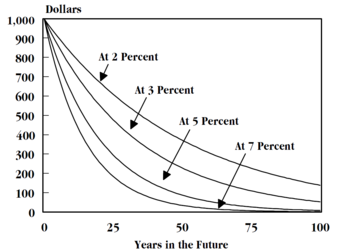
Time Value of Money
Time value of money requires an understanding of how return rates impact fixed values over time.
10.7.5: Single-Period Investment
When considering a single-period investment, n is one, so the PV is simply FV divided by 1+i.
Learning Objective
Calculate the present value of a future, single-period payment
Key Points
- A single period investment has the number of periods (n or t) equal to one.
- For both simple and compound interest, the PV is FV divided by 1+i.
- The time value of money framework says that money in the future is not worth as much as money in the present.
Key Terms
- interest rate
-
The percentage of an amount of money charged for its use per some period of time. It can also be thought of as the cost of not having money for one period, or the amount paid on an investment per year.
- period
-
The length of time during which interest accrues.
The time value of money framework says that money in the future is not worth as much as money in the present. Investors would prefer to have the money today because then they are able to spend it, save it, or invest it right now instead of having to wait to be able to use it.
The difference between what the money is worth today and what it will be worth at a point in the future can be quantified. The value of the money today is called the present value (PV), and the value of the money in the future is called the future value (FV). There is also a name for the cost of not having the money today: the interest rate or discount rate (i or r). For example, if the interest rate is 3% per year, it means that you would be willing to pay 3% of the money to have it one year sooner. The amount of time is also represented by a variable: the number of periods (n). One period could be any length of time, such as one day, one month, or one year, but it must be clearly defined, consistent with the time units in the interest rate, and constant throughout your calculations.

FV of a single payment
The FV is related to the PV by being i% more each period.
All of these variables are related through an equation that helps you find the PV of a single amount of money. That is, it tells you what a single payment is worth today, but not what a series of payments is worth today (that will come later). relates all of the variables together. In order to find the PV, you must know the FV, i, and n.
When considering a single-period investment, n is, by definition, one. That means that the PV is simply FV divided by 1+i. There is a cost to not having the money for one year, which is what the interest rate represents. Therefore, the PV is i% less than the FV.
Chapter 9: Reporting of Current and Contingent Liabilities
9.1: Introduction to Liabilities
9.1.1: Defining Liabilities
A liability is defined as an obligation of an entity arising from past transactions/events and settled through the transfer of assets.
Learning Objective
Explain how to identify a liability
Key Points
- Some of the characteristics of a liability include: a form of borrowing, personal income that is payable, a responsibility to others settled through the transfer of assets, a duty obligated to another without avoiding settlement, and a past transaction that obligates the entity.
- The IASB’s definition of a liability is: a present obligation of the enterprise arising from past events, the settlement of which is expected to result in an outflow from the enterprise of resources embodying economic benefits.
- Types of liabilities found in the balance sheet include current liabilities, such as payables and deferred revenues, and long-term liabilities, such as bonds payable.
Key Terms
- deferred
-
Of or pertaining to a value that is not realized until a future date (e.g., annuities, charges, taxes, income, either as an asset or liability.
- obligation
-
A legal agreement stipulating a specified payment or action; the document containing such agreement.
- fiscal year
-
An accounting period of one year, not necessarily coinciding with the calendar year.
Liability Definition & Characteristics
In financial accounting, a liability is defined as an obligation of an entity arising from past transactions or events, the settlement of which may result in the transfer or use of assets, provision of services or other yielding of economic benefits in the future. A liability is defined by the following characteristics:
- Any type of borrowing from persons or banks for improving a business or personal income that is payable in the current or long term.
- A duty or responsibility to others that entails settlement by future transfer or use of assets, provision of services, or other transaction yielding an economic benefit due at a specified or determinable date, on occurrence of a specified event, or on demand.
- A duty or responsibility that obligates the entity to another, leaving it little or no discretion to avoid settlement.
- A transaction or event that has already occurred and which obligates the entity.
Liability Defined by the IASB
Probably the most accepted accounting definition of a liability is the one used by the International Accounting Standards Board (IASB). The following is a quotation from the International Financial Reporting Standards (IFRS) Framework: “A liability is a present obligation of the enterprise arising from past events, the settlement of which is expected to result in an outflow from the enterprise of resources embodying economic benefits. “
Examples of Liabilities
Types of liabilities found on a company’s balance sheet include: current liabilities like notes payable, accounts payable, interest payable, and salaries payable. Liabilities can also include deferred revenue accounts for monies received that may not be earned until a future accounting period. An example of a deferred revenue account is an annual software license fee received on January 1 and earned over the course of a year. The company’s fiscal year end is May 31. For the current fiscal year, the company will earn 5/12 of the fee and the remaining amount (7/12) stays in a deferred revenue account until it is earned in the next accounting period. Long-term liabilities have maturity dates that extend past one year, such as bonds payable and pension obligations.
9.1.2: Classifying Liabilities
Two typical classification types for liabilities are current and long-term.
Learning Objective
Differentiate between current and long-term liabities
Key Points
- Current liabilities are often loosely defined as liabilities that must be paid within one year. For firms having operating cycles longer than one year, current liabilities are defined as those which must be paid during that longer operating cycle.
- Long-term liabilities are reasonably expected not to be liquidated or paid off within a year. They usually include issued long-term bonds, notes payables, long-term leases, pension obligations, and long-term product warranties.
- Contingent liabilities can be current or long-term and usually deal with legal actions or litigation claims against the entity or claims, such as penalties or fees, an organization encounters throughout the course of business.
Key Terms
- callable
-
That which may be redeemed by its holder before it matures.
- contingent
-
An event which may or may not happen; that which is unforeseen, undetermined, or dependent on something future; a contingency.
Types of Liabilities
Liabilities are classified in different types. The two main categories of these are current liabilities and long-term liabilities.
Current Liabilities
Current liabilities are often loosely defined as liabilities that must be paid within a single calender year. For firms with operating cycles that last longer than one year, current liabilities are defined as those liabilities which must be paid during that longer operating cycle. A better definition, however, is that current liabilities are liabilities that will be settled either by current assets or by the creation of other current liabilities.
Example of current liabilities include accounts payable, short-term notes payable, commercial paper, trade notes payable, and other liabilities incurred in the normal operations of the business. Some of these normal operating costs include salaries payable, wages payable, interest payable, income tax payable, and the current balance of a long-term debt that will be due within a single year. Other long-term obligations, such as bonds, can be classified as current because they are callable by the creditor. When a debt becomes callable in the upcoming year (or operating cycle, if longer), the debt is required to be classified as current, even if it is not expected to be called. If a particular creditor has the right to demand payment because of an existing violation of a provision or debt statement, then that debt should be classified as current also. In situations where a debt is not yet callable, but will be callable within the year if a violation is not corrected within a specified grace period, that debt should be considered current. The only conditions under which the debt would not be classified as current would be if it’s probable that the violation will be collected or waived.

Excessive debt can cripple a business and a country.
A business can have different liabilities depending on the debt instruments into which they enter.
Long-term Liabilities
Long-term liabilities are reasonably expected not to be liquidated or paid off within the span of a single year. These usually include issued long-term bonds, notes payables, long-term leases, pension obligations, and long-term product warranties.
Contingent Liabilities
Contingent liabilities can be current or long-term. They typically deal with legal actions or litigation claims against the entity or claims (such as penalties or fees) an organization encounters throughout the course of business. Contingent items are accrued if the claims and their likelihood of occurring are probable, and if the relevant amount of the liability can be reasonably estimated.
9.2: Current Liabilities
9.2.1: Defining Current Liabilities
Current liabilities are usually settled with cash or other assets within a fiscal year or operating cycle, whichever period is longer.
Learning Objective
Identify a current liability
Key Points
- A current liability can be defined in one of two ways: (1) all liabilities of the business that are to be settled in cash within a firm’s fiscal year or operating cycle, or (2) all liabilities of the business that are to be settled by current assets or by the creation of new current liabilities.
- Common characteristics of liabilities are (1) borrowed funds for use that must be repaid, (2) a duty to another party that involves the payment of an economic benefit, (3) a duty that obligates the entity to another without avoiding settlement, and (4) a past transaction that obligates the entity.
- Current liabilities are many times not “current” and are actually past due. For example, accounts payable are due within 30 days and are typically paid within 30 days. However, they do often run past 30 days in some situations.
Key Terms
- obligation
-
A legal agreement stipulating a specified payment or action; the document containing such agreement.
- settlement
-
The delivery of goods by the seller and payment for them by the buyer, under a previously agreed trade or transaction or contract entered into.
Definition of a Liability
In financial accounting, a liability is defined as an obligation of an entity arising from past transactions or events, the settlement of which may result in the transfer or use of assets, provision of services or other yielding of future economic benefits. Liabilities are reported on the balance sheet, along with assets and owner’s equity. They are an important part of the basic accounting equation — assets = liabilities + owner’s equity. A liability is defined by one of the following characteristics:
- A borrowing of funds from individuals or banks for improving a business or personal income that is payable during a short or long time period.
- A duty or responsibility to others that entails settlement by future transfer or use of assets, provision of services, or other transaction yielding an economic benefit, at a specified date, on occurrence of a specified event, or on demand.
- A duty or responsibility that obligates the entity to another entity, with no option to avoid settlement.
- A transaction or event that has already occurred and obligates the entity .
Definition of a Current Liability
A current liability can be defined in one of two ways: (1) all liabilities of the business that are to be settled in cash within a firm’s fiscal year or operating cycle, whichever period is longer or (2) all liabilities of the business that are to be settled by current assets or by the creation of new current liabilities. Another important point is that current liabilities are many times not “current” and are actually past due. For example, accounts payable are due within 30 days and are typically paid within 30 days. However, they do often run past 30 days or 60 days in some situations. So, the accounts payable balance reported on the balance sheet under “current” liabilities may include amounts that are over 30 days due.
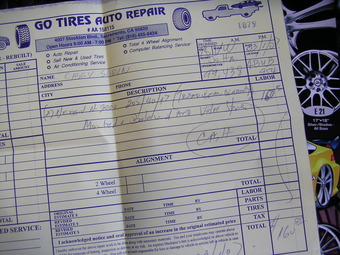
A current liability, such as a credit purchase, can be documented with an invoice.
Current liabilities are debt owed and payable no later than the current accounting period.
9.2.2: Accounts Payable
Accounts payable is money owed by a business to its suppliers and creditors and typically shown on its balance sheet as a current liability.
Learning Objective
Differentiate between trade and expense payables and give examples of common accounts-payable terms
Key Points
- Accounts payable is recorded in the A/P sub-ledger at the time an invoice is vouchered for payment. Vouchered means that an invoice is approved for payment and has been recorded in the general ledger or A/P subledger as an outstanding, or open, liability because it has not been paid.
- Payables are often categorized as trade payables, which are for the purchase of physical goods that are recorded in inventory; another category is expense payables or purchases of goods or services that are expensed.
- Common examples of expense payables are advertising, travel, entertainment, office supplies, and utilities. These items are obtained through credit that suppliers offer to their customers by allowing them to pay for a product or service after it has been received or used.
Key Term
- sub-ledger
-
A subset of the general ledger used in accounting. The subledger shows detail for part of the accounting records such as property and equipment, prepaid expenses, etc.
Definition of Accounts Payable
Accounts payable (A/P) is money owed by a business to its suppliers and creditors. It is typically shown on its balance sheet as a current liability. In addition to its disclosure on the balance sheet, accounts payable is recorded in the A/P sub-ledger at the time an invoice is vouchered for payment. Vouchered, or vouched, means that an invoice is approved for payment and has been recorded in the general ledger or A/P sub-ledger as an outstanding, or open, liability because it has not been paid. Payables are often categorized as trade payables, or purchases of physical goods that are recorded in inventory. Another category is expense payables, or purchases of goods or services that are expensed. Common examples of expense payables are advertising, travel, entertainment, office supplies, and utilities. A/P is a form of credit that suppliers offer to their customers by allowing them to pay for a product or service after it has been received. Suppliers offer various payment terms for an invoice .
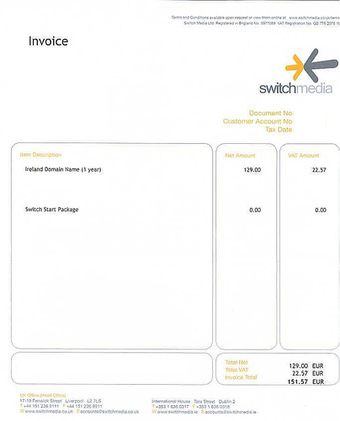
An invoice payable in 30 days is typically recorded as accounts payable.
In most businesses, accounts payable is a common type of current liability.
Processing Accounts Payable
A/P payment terms may include the offer of a cash discount for paying an invoice within a defined number of days. For example, the 2/10 Net 30 term means that the seller will deduct 2% from the invoice total if payment is made within 10 days and the invoice must be paid within 30 days. If the payment is delayed until Day 31 then the full amount of the invoice is due and past due charges may apply. As invoices are paid, the amounts are recorded as reductions to the accounts payable balance in the liability section and cash in the assets section of the balance sheet. The A/P payment process begins as an invoice is received by the purchaser and matched to a packing (receiving) slip and purchase order. When the three documents are matched, the invoice is paid. This is referred to as the three-way match. The three-way match can be modified to expedite payments. For example, three-way matching may be limited solely to large-value invoices, or the matching is automatically approved if the received quantity is within a certain percentage of the amount authorized in the purchase order.
9.2.3: Notes Payable
A note payable is a liability where one party makes an unconditional written promise to pay a specific sum of money to another.
Learning Objective
Explain how a note payable differs from other liabilities
Key Points
- The terms of a note usually include the principal amount, interest rate (if applicable), parties involved, date, terms of repayment (which may include interest), and maturity date.
- Negotiable promissory notes are used extensively in combination with mortgages in the financing of real estate transactions. Notes are also issued, along with commercial papers, to provide capital to businesses.
- To report the note as a current liability it should be due within a 12-month period or current operating cycle, whichever is longer. The note payable amount can include the principal as well as the interest payment amounts due.
Key Terms
- mortgage notes payable
-
a written promise to repay a specified sum of money plus interest at a specified rate and length of time to fulfill the promise, specifically for a loan secured by real property
- notes payable
-
promisory notes due to the company
- default
-
The condition of failing to meet an obligation.
- negotiable
-
Able to be transferred to another person, with or without endorsement.
Definition of Promissory Note
A promissory note is a negotiable instrument, where one party (the maker or issuer) makes, under specific terms, an unconditional promise in writing to pay a determined sum of money to the other (the payee), either at a fixed or determinable future time or on demand by the payee. The terms of a note usually include the principal amount, interest rate (if applicable), parties involved, date, terms of repayment (which may include interest), and maturity date. Sometimes, provisions are included concerning the payee’s rights in the event of a default, which may include foreclosure of the maker’s assets. Demand promissory notes are notes that do not carry a specific maturity date, but are due on demand by the lender. Usually the lender will only give the borrower a few days notice before the payment is due. For loans between individuals, writing and signing a promissory note are often instrumental for tax and record keeping purposes .
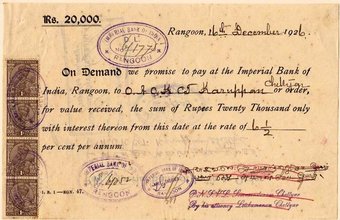
A 1926 promissory note from the Bank of India.
A promissory note due in less than a year is reported under current liabilities.
Accounting for Notes Payable
Negotiable promissory notes are used extensively in combination with mortgages in the financing of real estate transactions. Notes are also issued, along with commercial papers, to provide capital to businesses. When a note is signed and it becomes a binding agreement, a notes payable can be recorded to report the debt on the balance sheet. To report the note as a current liability it should be due within a 12-month period or current operating cycle, whichever is longer. The note payable amount can include the principal as well as the interest payment amounts due. If periodic payments are made throughout the term of the note, the payments will reduce the notes payable balance. It’s important not to confuse a note with a loan contract, which is a legally distinct document from a note. It is non-negotiable, and does not include an unconditional promise to pay clause.
9.2.4: Current Maturities of Long-Term Debt
The portion of long-term liabilities that must be paid in the coming 12-month period are classified as current liabilities.
Learning Objective
Explain the reporting of the current portion of a long-term debt
Key Points
- Long-term liabilities are liabilities with a due date that extends over one year, such as bonds payable with a maturity date of 10 years. Long-term liabilities are a way to show the existence of debt that can be paid in a time period longer than one year.
- The portion of long-term liabilities that must be paid in the coming 12-month period are moved from the long-term liability section to the current liability section of the balance sheet.
- Current debt on the balance sheet is listed by maturity date, in relation to the due date of other current liabilities. If a current liability section has an accounts payable account (due in 30 days), a current balance of loans payable (due in 12 months) would be listed after accounts payable.
Key Terms
- bond
-
Evidence of a long-term debt, by which the bond issuer (the borrower) is obliged to pay interest when due, and repay the principal at maturity, as specified on the face of the bond certificate. The rights of the holder are specified in the bond indenture, which contains the legal terms and conditions under which the bond was issued. Bonds are available in two forms: registered bonds and bearer bonds.
- debenture
-
A certificate that certifies an amount of money owed to someone; a certificate of indebtedness.
- declaration date
-
the day the Board of Directors announces its intention to pay a dividend
- current liability
-
all liabilities of the business that are to be settled in cash within the fiscal year or the operating cycle of a given firm, whichever period is longer
Definition of Long-Term Debt
Long-term liabilities are liabilities with a due date that extends over one year, such as a notes payable that matures in 2 years. In accounting, the long-term liabilities are shown on the right side of the balance sheet, along with the rest of the liability section, and their sources of funds are generally tied to capital assets. Examples of long-term liabilities are debentures, bonds, mortgage loans and other bank loans (it should be noted that not all bank loans are long term since not all are paid over a period greater than one year. ) Also long-term liabilities are a way for a company to show the existence of debt that can be paid in a time period longer than one year, a sign that the company is able to obtain long-term financing .

War bonds were used to support World War II.
Bonds are a form of long-term debt because they typically mature several years after their original issue date.
Long-Term Debt Due in the Current Period
The portion of long-term liabilities that must be paid in the coming 12-month period are classified as current liabilities. The portion of the liability considered “current” is moved from the long-term liabilities section to the current liabilities section. The position of where the debt should be disclosed is based on its maturity date in relation to the due date of other current liabilities. For example, a loan for which two payments of USD 1,000 are due–one in the next 12 months and the other after that date–would be split into one USD 1000 portion of the debt classified as a current liability, and the other USD 1000 as a long-term liability (note this example does not take into account any interest or discounting effects, which may be required depending on the accounting rules that may apply). If the current liability section already has an accounts payable account (balance which is usually paid off in 30 days), the current portion of the loan payable (due within 12 months) would be listed after accounts payable.
9.2.5: Current Obligations Expected to Be Refinanced
Per FASB 6, current obligations that an enterprise intends and is able to refinance with long term debt have different reporting requirements.
Learning Objective
Explain why a company would refinance a debt
Key Points
- Refinancing may refer to the replacement of an existing debt obligation, or current liability, with a debt obligation under different terms.
- The most common type of debt refinancing occurs in the home mortgage market. Reasons to refinance include to obtain a better interest rate; to consolidate current debt; to free up cash and reduce periodic payments; and to reduce debt risk.
- Calculating the up-front, ongoing, and potentially variable transaction costs of refinancing is an important part of the decision on whether or not to refinance, since they can wipe out any savings generated by the new loan terms.
Key Terms
- closing fees
-
a variety of costs associated with the transaction (above and beyond the price of the asset itself) and incurred by either the buyer or the seller. These costs are typically paid at a future point in time, known as the “closing” when title switches hands.
- non-recourse debt
-
a secured loan (debt) that is secured by a pledge of collateral, typically real property, but for which the borrower is not personally liable. If the borrower defaults, the lender/issuer can seize the collateral, but the lender’s recovery is limited to the collateral.
- recourse debt
-
a debt that is not backed by collateral from the borrower.
- current replacement cost
-
the amount that an entity would have to pay to replace an asset at the present time, according to its current worth
Definition of Refinancing
Refinancing may refer to the replacement of an existing debt obligation with a debt obligation under different terms. The terms and conditions of refinancing may vary widely by the type of debt involved and is based on several economic factors such as:
- the inherent and projected risk of the asset(s) backing the loan,
- the financial stability of the lender,
- credit availability,
- banking regulations,
- the borrower’s credit worthiness, and
- the borrower’s net worth.
If the replacement of debt occurs under financial distress, refinancing might be referred to as debt restructuring. The most common type of debt refinancing occurs in the home mortgage market.
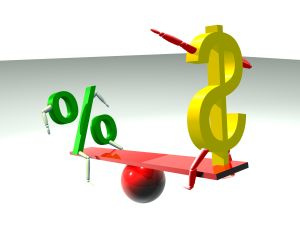
Deciding to refinance debt can be a balancing act between the funds requested and the interest rate charged on the funds.
Refinanced debt must be finalized and the new loan terms approved before reporting it and replacing it for the old debt in the liability section.
Reasons to Refinance Debt
A loan or other type of debt can be refinanced for various reasons:
- To take advantage of a better interest rate or loan terms (a reduced monthly payment or a reduced term)
- To consolidate other debt(s) into one loan (a potentially longer/shorter term contingent on interest rate differential and fees)
- To reduce the monthly repayment amount (often for a longer term, contingent on interest rate differential and fees)
- To reduce or alter risk (e.g. switching from a variable-rate to a fixed-rate loan)
- To free up cash (often for a longer term, contingent on interest rate differential and fees)
Risks of Refinanced Debt
Calculating the up-front, ongoing, and potentially variable transaction costs of refinancing is an important part of the decision on whether or not to refinance. If the refinanced loan has lower monthly repayments or consolidates other debts for the same repayment, it will result in a larger total interest cost over the life of the loan and will result in the borrower remaining in debt for many more years. Most fixed-term loans are subject to closing fees and points and have penalty clauses that are triggered by an early repayment of the loan, in part or in full.
Penalty clauses are only applicable to loans paid off prior to maturity and involve the payment of a penalty fee. The above-mentioned items are considered the transaction fees on the refinancing. These fees must be calculated before substituting an old loan for a new one, as they can wipe out any savings generated through refinancing.
In some jurisdictions, refinanced mortgage loans are considered recourse debt, meaning that the borrower is liable in case of default, while un-refinanced mortgages are non-recourse debt.
9.2.6: Dividends Payable
Dividends are payments made by a corporation to its shareholders; the payment amount is reported as dividends payable on the balance sheet.
Learning Objective
Explain what a dividend is and how it is reported on the financial statements
Key Points
- There are two ways to distribute cash to shareholders: share repurchases (reported as treasury stock in the owner’s equity section of the balance sheet) and dividends (liability).
- A shareholder receives a dividend in proportion to the shares he owns. He must also be a shareholder on the date of record in order to be eligible for the dividend.
- The declared per share dividend amount is multiplied by the number of shares outstanding and this result is debited to retained earnings and credited to dividends payable. Dividends payable is recorded as a current liability on the company’s books when the dividend is declared.
Key Terms
- treasury stock
-
A treasury or “reacquired” stock is one which is bought back by the issuing company, reducing the amount of outstanding stock on the open market (“open market” including insiders’ holdings).
- retained earnings
-
Retained earnings are the portion of net income that is retained by the corporation rather than distributed to its owners as dividends.
Dividends are the portion of corporate profits paid out to shareholders. When a corporation earns a profit or surplus, that money can be put to two uses: it can either be re-invested in the business (called retained earnings), or it can be distributed to shareholders as dividends.
There are two ways to distribute cash to shareholders: share repurchases (reported as treasury stock in the owner’s equity section of the balance sheet) or dividends.
Many corporations retain a portion of their earnings and pay out the remaining earnings as a dividend. A dividend is allocated as a fixed amount per share. Therefore, a shareholder receives a dividend in proportion to the shares he owns — for example, if shareholder Y owns 100 shares when company Z declares a dividend of USD 1.00 per share. then shareholder Y will receive a dividend of USD 100 for his shares.
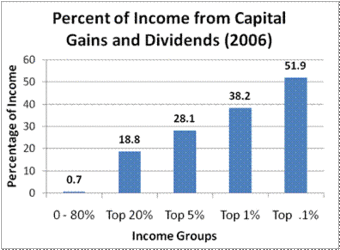
Dividends are considered a form of passive income for investors.
Companies that declare dividends must record a liability for the amount of the dividends that will be paid to investors.
For the company, a dividend payment is not an expense, but the division of after tax profits among shareholders. On the dividend declaration date, a company’s board of directors announces its intention to pay a dividend to shareholders on record as of a certain date (date of record). The per share dividend amount is multiplied by the number of shares outstanding and this result is debited to retained earnings and credited to dividends payable.
Dividends payable is recorded as a current liability on the company’s books; the journal entry confirms that the dividend payment is now owed to the stockholders. On the declaration date, the Board announces the date of record and a payment date; the payment date is the date when the funds are sent to the shareholders and the dividends payable account is reduced for the payment amount.
9.2.7: Unearned and Deferred Revenues
A deferred revenue is recognized when cash is received upfront for a product before delivery or for a service before rendering.
Learning Objective
Explain the purpose of classifying transactions as either deferred or unearned revenue
Key Points
- A deferred item, in accrual accounting, is any account where a revenue or expense, recorded as an liability or asset, is not realized until a future date (accounting period) or until a transaction is completed.
- Unearned revenues are recorded because the earnings process is not complete when the cash is received, so the cash is recorded as a liability for the products or services that are due to the buyer.
- An example of a deferred revenue is the monies received for a 12-month magazine subscription. The proceeds on the subscription relate to a future benefit (magazine) for the buyer that he will receive over the course of 12 months.
Key Terms
- unearned revenue
-
money received for goods or services which have not yet been delivered
- expense
-
In accounting, an expense is money spent or costs incurred in an businesses efforts to generate revenue
- revenue
-
Income that a company receives from its normal business activities, usually from the sale of goods and services to customers.
Definition of Deferred and Unearned Revenues
A deferred item, in accrual accounting, is any account where a revenue or expense, recorded as an liability or asset, is not realized until a future date (accounting period) or until a transaction is completed. Examples of deferred items include annuities, charges, taxes, income, etc. If the deferred item relates to an expense (cash has been paid out), it is carried as an asset on the balance sheet. If the deferred item relates to revenue (cash has been received), it is carried as a liability. A deferred revenue is specifically recognized when cash is received upfront for a product before delivery or for a service before rendering. In these cases, the earnings process is not complete when the cash is received, so the cash is recorded as a liability for the products or services that are due to the buyer .

Receipts for magazine subscriptions are a type of deferred revenue.
A deferred revenue item involves cash received before the earnings process is complete.
Accounting for Deferred and Unearned Revenues
An example of a deferred revenue is the monies received for a 12-month magazine subscription. The proceeds on the subscription relate to a future benefit (magazine) for the buyer that he will receive over the course of 12 months. Since the seller has received full payment for all 12 issues that will be delivered over the course of the year, the payment is recorded as unearned or deferred revenue in the current liability section of the balance sheet. If cash received is for benefits that extend past the current accounting period, a long-term liability would be recorded instead. As each magazine is delivered to the buyer (earnings process is now complete), the applicable “earned” portion of the original payment is transferred from the liability account to subscription revenue, which is disclosed on the income statement.
9.2.8: Other Current Liabilities: Sales Tax, Income Tax, Payroll, and Customer Advances
Other current liabilities reported on the balance sheet are sales tax, income tax, payroll, and customer advances (deferred revenue).
Learning Objective
Explain how sales tax payable, income tax payable, salaries and wages payable and deferred revenue appear on the financial statements
Key Points
- A sales and use tax is a tax paid to a governing body by a seller for the sales of certain goods and services.
- An income tax is a tax levied on the income of individuals or businesses (corporations or other legal entities).
- Wages and salaries in cash consist of wages or salaries payable at regular weekly, monthly or other intervals. This includes payments by results and piecework payments, plus allowances such as those for working overtime.
- Deferred revenue is, in accrual accounting, money received for goods or services which have not yet been delivered and revenue on the sale has not been earned.
Key Terms
- capital gains
-
a profit that results from a disposition of a capital asset , such as stock , bond or real estate , where the amount realized on the disposition exceeds the purchase price.
- jurisdiction
-
the limits or territory within which authority may be exercised
- deferred tax
-
A timing difference arises when an item of income or expense is recognized for tax purposes but not accounting purposes, or vice versa, creating an asset or liability.
Other Current Liabilities
Sales Tax Payable
The sales and use tax is a tax paid to a governing body by a seller for the sales of certain goods and services. The payment of the tax by the seller occurs periodically and varies depending on the jurisdiction. Usually laws allow (or require) the seller to collect funds for the tax from the consumer at the point of purchase. Laws may allow sellers to itemized the tax separately from the price of the goods or services, or require it to be included in the price (tax-inclusive). The tax amount is usually calculated by applying a percentage rate to the taxable price of a sale. Sales tax payable can be accrued on a monthly basis by debiting sales tax expense and crediting sales tax payable for the tax amount applicable to monthly sales. The sales tax payable account is reported in the current liability section of the balance sheet until the tax is paid.

A company can incur different types of tax liabilities.
Taxes, employee salaries, and customer advances that will be payable or earned within a 12-month period can be reported as current liabilities.
Income Tax Payable
Income tax is a tax levied on the income of individuals or businesses (corporations or other legal entities). Corporate tax refers to a direct tax levied on the net earnings made by companies or associations and often includes the capital gains of a company. Net earnings are generally considered gross revenue minus expenses. Expenses can vary; for example, corporate expenses related to fixed assets are usually deducted in full over their useful lives by using percentage rates based on the class of asset to which they belong. Accounting principles and tax rules about recognition of expenses and revenue will vary at times, giving rise to book-tax differences. If the book-tax difference is carried over more than a year, it is referred to as a deferred tax. Future assets and liabilities created by a deferred tax are reported on the balance sheet. Income tax payable can be accrued by debiting income tax expense and crediting income tax payable for the tax owed; the payable is disclosed in the current liability section until the tax is paid.
Salaries and Wages Payable
Wages and salaries in cash consist of wages or salaries payable at regular weekly, monthly, or other intervals, including payments by results and piecework payments, plus allowances like:
- working overtime;
- amounts paid to employees away from work for short periods (e.g., on holiday);
- ad hoc bonuses and similar payments;
- commissions, gratuities and tips received by employees.
Customer Advances (Deferred Revenue)
Deferred revenue is, in accrual accounting, money received for goods or services that have not yet been delivered and revenue on the sale has not been earned. According to the revenue recognition principle, the deferred amount is recorded as a liability until delivery is made, at which time it is converted into revenue. An example of a typical customer advance is the receipt of an annual maintenance contract fee, where the entire contract is paid up front. The receipt of $12,000 for the annual maintenance contract is initially recorded as deferred revenue. As the maintenance service is rendered and a portion of the fee is earned, $1,000 is recognized periodically each month as revenue and the deferred revenue account is reduced.
9.3: Contingencies
9.3.1: Gain Contingencies
Gain contingencies, or possible occurrences of a gain on a claim or obligation involving the entity, are reported when realized (earned).
Learning Objective
Explain how a company reports a gain contingency on their financial statements
Key Points
- If a specific event that can cause the gain occurs, and the gain is realized, then the gain is accrued for and reported in the financial statements. It is also disclosed in the notes section.
- Probable and quantifiable gains are not accrued for reporting purposes, but they can be disclosed in the notes to the financial statements if they are material. If the gain is not probable or reasonably estimated, but could materially effect financial statements, the gain is disclosed in a note.
- The materiality concept states that if a gain contingency, that remains unrealized, affects the economic decision of statement users, it should be disclosed in the notes.
- Following conservative constraints for a gain contingency, only a realized gain should be accrued for and disclosed on an income statement.
Key Terms
- Contingency
-
A possibility; something which may or may not happen. This also can mean a chance occurrence, especially in, unexpected expenses
- unrealized
-
Not realized; possible to obtain, yet not obtained.
Gain Contingency
Gain contingencies, or the possible occurrences of a gain on a claim or obligation that involves the entity, are reported when realized (earned). If a specific event that can cause the gain occurs, and the gain is realized, then the gain is disclosed . If the gain is probable and quantifiable, the gain is not accrued for financial reporting purposes, but it can be disclosed in the notes to financial statements. If the gain is not probable or its amount cannot be reasonably estimated, but its effect could materially affect financial statements, a note disclosing the nature of the gain is also disclosed in the notes. Care should be taken that misleading language is not used regarding the potential for the gain to be realized. The disclosure of gain contingencies is affected by the materiality concept and the conservatism constraint.

Renovation
Renovation plans and projects can increase the value of a building and eventually bring about a gain. However these gains should only be accrued when the gain is realized.
Materiality
Materiality is a concept or convention within auditing and accounting that relates to the importance/significance of an amount, transaction, or discrepancy. For example, an auditor expresses an opinion on whether financial statements are prepared, in all material aspects, in conformity with generally accepted accounting principles (GAAP). Professional judgment is required to determine what is material and what isn’t. Generally, if the omission or misstatement of information can influence the economic decision of financial statement users, the missing or incorrect information is considered material. Thus, if a gain contingency, that remains unrealized, affects the economic decision of statement users, it should be disclosed in the notes.
Conservatism
Most accounting principles follow the conservative constraint, which encourages the immediate disclosure of losses and expenses on the income statement. This constraint also encourages the omission of revenues and gains until those gains are realized. Thus, for a gain contingency, only a realized gain is accrued for and disclosed on the income statement. A material gain contingency that is both probable and reasonably estimated can be disclosed in the notes to financial statements.
9.3.2: Loss Contingencies
A loss contingency may be incurred by the entity based on the outcome of a future event, such as litigation.
Learning Objective
Summarize how a company would report a loss contingency on their financial statements
Key Points
- Due to conservative accounting principles, loss contingencies are reported on the balance sheet and footnotes on the financial statements, if they are probable and their quantity can be reasonably estimated.
- Unlike gain contingencies, losses are reported immediately as long as they are probable and reasonably estimated. They do not have to be realized in order to report them on the balance sheet.
- For losses that are material, but may not occur and their amounts can not be estimated, a note to the financial statements disclosing the loss contingency is reported.
Key Terms
- incur
-
To render somebody liable or subject to.
- probable
-
Likely or most likely to be true.
Definition of Loss Contingencies
A loss contingency is incurred by the entity based on the outcome of a future event, such as litigation. Due to conservative accounting principles, loss contingencies are reported on the balance sheet and footnotes on the financial statements, if they are probable and their quantity can be reasonably estimated. A footnote can also be included to describe the nature and intent of the loss. The likelihood of the loss is described as probable, reasonably possible, or remote. The ability to estimate a loss is described as known, reasonably estimable, or not reasonably estimable .

Calculating cash flow
The indirect method adjusts net income (rather than adjusting individual items in the income statement).
Contingent Liabilities for Losses
Loss contingencies can refer to contingent liabilities that may arise from discounted notes receivable, income tax disputes, or penalties that may be assessed because of some past action or failure of another party to pay a debt that a company has guaranteed. Unlike gain contingencies, losses are reported immediately as long as they are probable and reasonably estimated. They do not have to be realized in order to report them on the balance sheet. At least a minimum amount of the loss expected to be incurred is accrued. For losses that are material, but may not occur and their amounts cannot be estimated, a note to the financial statements disclosing the loss contingency is reported.
Example of a Disclosed Loss Contingency
A jury awarded $5.2 million to a former employee of the Company for an alleged breach of contract and wrongful termination of employment. The Company has appealed the judgment on the basis of errors in the judge’s instructions to the jury and insufficiency of evidence to support the amount of the jury’s award. The Company is vigorously pursuing the appeal. The Company and its subsidiaries are also involved in other litigation arising in the ordinary course of business. Since it presently is not possible to determine the outcome of these matters, no provision has been made in the financial statements for their ultimate resolution. The resolution of the appeal of the jury award could have a significant effect on the Company’s earnings in the year that a determination is made. However, in management’s opinion, the final resolution of all legal matters will not have a material adverse effect on the Company’s financial position.
9.4: Reporting and Analyzing Current Liabilities
9.4.1: Reporting Current Liabilities
Current liabilities are reported first in the liability section of the balance sheet because they have first claim on company assets.
Learning Objective
Explain how current liabilities are shown on the financial statements
Key Points
- Current liabilities are typically due and paid for during the current accounting period or within a one year period. They are paid off with assets or other current liabilities.
- For many companies, accounts payable is the first balance sheet account listed in the current liabilities section. Accounts payable includes goods, services, or supplies that were purchased with credit and for use in the operation of the business and payable within a one year period.
- Long-term liabilities are listed in a separate section after current debt; however, for all long-term liabilities, any amounts due in the current fiscal year are reported under the current liability section.
Key Terms
- bond
-
Evidence of a long-term debt, by which the bond issuer (the borrower) is obliged to pay interest when due, and repay the principal at maturity, as specified on the face of the bond certificate. The rights of the holder are specified in the bond indenture, which contains the legal terms and conditions under which the bond was issued. Bonds are available in two forms: registered bonds and bearer bonds.
- audit
-
An independent review and examination of records and activities to assess the adequacy of system controls, to ensure compliance with established policies and operational procedures, and to recommend necessary changes in controls, policies, or procedures
Current Liabilities in the Balance Sheet
The balance sheet, or statement of financial position, is a snapshot of a company’s assets, liabilities, and owner’s equity on a given date. The presentation of the balance sheet should support the accounting equation of assets = liabilities + owner’s equity. Liabilities are disclosed in a separate section that distinguishes between short-term and long-term liabilities. Short-term, or current liabilities, are listed first in the liability section of the statement because they have first claim on company assets. Current liabilities are typically due and paid for during the current accounting period or within a one year period. They are paid off with assets or other current liabilities .

Most current liabilities have a claim on cash or other assets.
Current liabilities is the first section reported under liabilities on the balance sheet.
Accounts Payable
For many companies, accounts payable is the first balance sheet account listed in the current liabilities section. For example, accounts payable for goods, services, or supplies that were purchased with credit and for use in the operation of the business and payable within a one-year period would be current liabilities. Accounts payable are typically due within 30 days. Amounts listed on a balance sheet as accounts payable represent all bills payable to vendors of a company, whether or not the bills are more or less than 30 days old. Therefore, late payments are not disclosed on the balance sheet for accounts payable. An aging schedule showing the amount of time certain amounts are past due may be presented in the notes to audited financial statements; however, this is not common accounting practice.
Other Liabilities
In addition to current liabilities, long-term liabilities are listed in a separate section after current debt. Long-term liabilities can include bonds, mortgages, and loans that are payable over a term exceeding one year. However, for all long-term liabilities, any amounts due in the current fiscal year are reported under the current liability section.
9.4.2: What Goes on the Balances Sheet and What Goes in the Notes
The balance sheet lists current liability accounts and their balances; the notes provide explanations for the balances, which are sometimes required.
Learning Objective
Explain why a company would use a note to the balance sheet
Key Points
- All liabilities are typically placed on the same side of the balance sheet as the owner’s equity because both those accounts have credit balances.
- Current liabilities and their account balances as of the date on the balance sheet are presented first on the balance sheet, in order by due date. The balances in these accounts are typically due in the current accounting period or within one year.
- Current liability information found in the notes to the financial statements provide additional explanation on the account balances and any circumstances affecting them. Accounting principles can sometimes require this type of disclosure.
Key Terms
- LLP
-
Limited liability partnership.
- pension
-
A regularly paid gratuity paid regularly as benefit due to a person in consideration of past services; notably to one retired from service, on account of retirement age, disability, or similar cause; especially, a regular stipend paid by a government to retired public officers, disabled soldiers; sometimes passed on to the heirs, or even specifically for them, as to the families of soldiers killed in service.
- LLC
-
Limited liability company.
The Balance Sheet
In financial accounting, a balance sheet or statement of financial position is a summary of the financial balances of a sole proprietorship, a business partnership, a corporation, or other business organization, such as an LLC or an LLP. Assets, liabilities, and the equity of stockholders are listed as of a specific date, such as the end of a fiscal year or accounting period. Of the four basic financial statements, the balance sheet is the only statement which applies to a single point in time of a company’s calendar year. Balance sheets are presented with assets in one section, and liabilities and equity in the other section, so that the two sections “balance. ” The fundamental accounting equation is: assets = liabilities + equity ([).
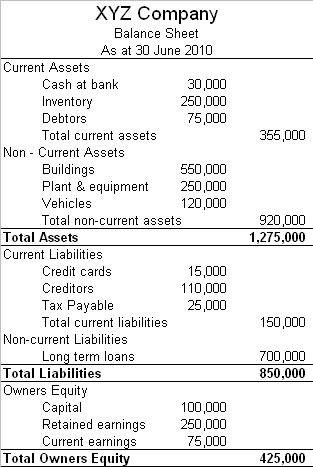
The Balance Sheet
If an error is found on a previous year’s financial statement, a correction must be made and the financials reissued.
Current Liabilities on the Balance Sheet
All liabilities are typically placed on the same side of the report page as the owner’s equity because both those accounts have credit balances (asset accounts, on the other hand, have debit balances). Current liabilities and their account balances as of the date on the balance sheet are presented first, in order by due date. The balances in these accounts are typically due in the current accounting period or within one year. Current liabilities can represent costs incurred for employee salaries and wages, production and build up of inventory, and acquisition of equipment which are needed and used up during normal business operations.
Information in the Notes
Current liability information found in the notes to the financial statements provide additional explanation on the liability balances and any circumstances affecting them. Accounting principles can sometimes require the disclosure of specific information for the benefit of the financial statement user. For example, companies that pay pension plan benefits require additional footnote disclosure that provide the user with additional details on pension costs and the assets used to fund it.
9.4.3: Reporting Contingencies
Contingencies are reported as liabilities if it is probable they will incur a loss, and their amounts can be reasonably estimated.
Learning Objective
Summarize how contingencies are reported on the financial statements
Key Points
- A loss contingency is not reported if it can not be recognized due to improbability (not more than 50% likely to occur) and/or the amount of the loss can not be reliably measured or estimated. Gain contingencies are reported on the income statement when they are realized (earned).
- A probable contingency is defined as more than 50% likely to occur because there was a past obligating event.
- If a probable loss can be estimated based on historical information, then it can be reliably measured.
Key Terms
- product warranty
-
In retail, a guarantee of the reliability of a product under conditions of ordinary use; should the product malfunction within a stipulated amount of time after the purchase, the manufacturer or distributor is typically required to provide the customer with a replacement, repair, or refund.
- obligation
-
A legal agreement stipulating a specified payment or action; the document containing such agreement.
Reporting Contingencies
Loss Contingencies and Liabilities
Contingencies are reported as liabilities on the balance sheet and/or disclosed in the notes to the financial statements when it is probable they will incur a loss and when the loss can be reasonably estimated.
Probability
Probable is defined as more than 50% likely to occur due to a past obligation. The past obligating event defines a future payment event as a payment due on a specific date from the company, who is linked to an obligating event by a specific agreement.
Loss Contingency
A loss contingency is not reported if:
- A loss contingency is less than 50% likely to occur due to a past obligation.
- The amount of the loss can not be reliably measured or estimated.
Gain Contingency
Gain contingencies are reported on the income statement when they are realized (earned).

Funds may be lost due to contingent liabilities.
Conservative accounting principles state that companies should report loss contingencies as they occur.
Estimating a Loss Contingency
Reliability
A probable loss contingency can be measured reliably if it can be estimated based on historical information. For example, to accrue a provision for product warranty costs, assume that minor repairs cost 5% of the total product sales and an estimated 5% of products may require minor repairs within 1 year of sale. Major repairs cost 20% and 1% of products may require major repairs in 3 years.

Car Repairs
Cars require regular maintenance. Such contingent liabilities can be estimated reliably based on historical cost and readily available information.
Provision Estimation
The provision is calculated by multiplying 5% of total product cost by 5% of products needing minor repair and then adding 20% of cost for major repair, multiplied by 1% of products needing major repair.
5% x 5% + 20 % x 1% (of budgeted total sales)
A warranty expense is debited for the provision amount that will offset product sales revenue in the income statement and a credit is posted to warranty provision liability. The amount for repairs occurring in year one is reported in the current liability section of the balance sheet; the portion relating to major repairs in three years is disclosed as long-term liability. As the warranty claims are made, the liability account is debited and cash is credited for the cost of the repair. The long-term liability warranty provision is moved to the current liability section in the accounting period occurring three years after the product sale.
9.4.4: Current Ratio
The current ratio is a financial ratio that measures whether or not a firm has enough resources to pay its debts over the next 12 months.
Learning Objective
Explain how a company would use the current ratio
Key Points
- The current ratio is calculated by taking total current assets and dividing by total current liabilities. The ratio is an indication of a firm’s market liquidity and ability to meet creditor’s demands.
- Acceptable current ratios vary from industry to industry and are generally between 1.5% and 3% for healthy businesses. If a company’s current ratio is in this range, then it generally indicates good short-term financial strength.
- If the value of a current ratio is considered high, then the company may not be efficiently using its current assets, specifically cash, or its short-term financing options. A high current ratio can be a sign of problems in managing working capital.
- When a current ratio is low and current liabilities exceed current assets (the current ratio is below 1), then the company may have problems meeting its short-term obligations (current liabilities).
Key Terms
- current ratio
-
current assets divided by current liabilities
- current liabilities
-
obligations of the business that are to be settled in cash within the fiscal year or the operating cycle of a given firm, whichever period is longer
- liquidity
-
An asset’s property of being able to be sold without affecting its value; the degree to which it can be easily converted into cash.
- creditor
-
A person to whom a debt is owed.
Current & Financial Ratios
The current ratio is a financial ratio that measures whether or not a firm has enough resources to pay its debts over the next 12 months. It compares a firm’s current assets to its current liabilities. Along with other financial ratios, the current ratio is used to try to evaluate the overall financial condition of a corporation or other organization. Financial ratios may be used by managers within a firm, by current and potential shareholders (owners) of a firm, and by a firm’s creditors. Financial analysts use financial ratios to compare the strengths and weaknesses in various companies. Ratios can be expressed as a decimal value, such as 0.10, or given as an equivalent percent value, such as 10% .

Ratios can be used to analyze financial trends.
The current ratio can be use to evaluate a company’s liquidity.
The current ratio is calculated by taking total current assets and dividing by total current liabilities.
Uses for Current Ratio
The ratio is an indication of a firm’s market liquidity and ability to meet creditor’s demands. Acceptable current ratios vary from industry to industry and are generally between 1.5% and 3% for healthy businesses.
If a company’s current ratio is in this range, then it generally indicates good short-term financial strength. If current liabilities exceed current assets (the current ratio is below 1), then the company may have problems meeting its short-term obligations (current liabilities).
High vs. Low Current Ratio
If the value of a current ratio is considered high, then the company may not be efficiently using its current assets, specifically cash, or its short-term financing options. A high current ratio can be a sign of problems in managing working capital (what is leftover of current assets after deducting current liabilities). While a low current ratio may indicate a problem in meeting current obligations, it is not indicative of a serious problem. If an organization has good long-term revenue streams, it may be able to borrow against those prospects to meet current obligations. Some types of businesses usually operate with a current ratio of less than one. For example, when inventory turns over more rapidly than accounts payable becomes due, the current ratio will be less than one. This can allow a firm to operate with a low current ratio.
9.4.5: Acid Test Ratio
The acid-test, or quick ratio, measures the ability of a company to use its near cash or quick assets to pay off its current liabilities.
Learning Objective
Describe how a company uses the acid test ratio
Key Points
- The acid-test ratio is calculated by adding cash, cash equivalents, marketable securities, and accounts receivable. The sum is then divided by current liabilities.
- Generally, the acid test ratio should be 1:1 or higher; however, this varies widely by industry. In general, the higher the ratio is, the greater the company’s liquidity (i.e., the better able to meet current obligations using liquid assets).
- The acid-test ratio, like other financial ratios, is a test of viability for business entities but does not give a complete picture of a company’s health.
Key Terms
- liquidity
-
An asset’s property of being able to be sold without affecting its value; the degree to which it can be easily converted into cash.
- inventory
-
A detailed list of all of the items on hand.
Acid-Test and Financial Ratios
The acid-test ratio, also known as the quick ratio, measures the ability of a company to use its near cash or quick assets to immediately extinguish or retire its current liabilities. Quick assets include the current assets that can presumably be quickly converted to cash at close to their book values. The numerator of the ratio includes “quick assets,” such as cash, cash equivalents, marketable securities, and accounts receivable.
The acid-test ratio, like other financial ratios, is a test of viability for business entities but does not give a complete picture of a company’s health. For example, if a business has large amounts in accounts receivable which are due for payment after a long period (say 120 days) and essential business expenses and accounts payable are due for immediate payment, the quick ratio may look healthy when the business is actually about to run out of cash. In contrast, if the business has negotiated fast payment terms with customers and long payment terms from suppliers, it may have a very low quick ratio yet good liquidity .

A low acid-test ratio may be a sign of poor use of cash by a business.
The acid-test ratio is similar to the current ratio except the value of inventory is omitted from the calculation.
Uses of Acid-Test Ratio
The acid-test ratio is calculated by adding cash, cash equivalents, marketable securities, and accounts receivable. The sum is then divided by current liabilities. Note that the calculation omits inventory and a different version of the formula involves subtracting inventory from current assets and dividing by current liabilities. Generally, the acid test ratio should be 1:1 or higher; however, this varies widely by industry. In general, the higher the ratio is, the greater the company’s liquidity (i.e., the better able to meet current obligations using liquid assets). A company with a quick ratio of less than 1 cannot currently pay back its short-term liabilities.
9.4.6: Working Capital Management Analysis
Working capital is a financial metric that represents the operational liquidity of a business, organization, or other entity.
Learning Objective
Identify working capital and discuss how a company would use it
Key Points
- Net working capital is calculated as current assets minus current liabilities. Positive working capital is required to ensure that a firm is able to continue its operations and has sufficient funds to satisfy both maturing short-term debt and upcoming operational expenses.
- Cash flows can be evaluated using the cash conversion cycle — the net number of days from the outlay of cash for raw material to receiving payment from the customer.
- Profitability can be evaluated by looking at return on capital (ROC). This metric is determined by dividing relevant income for the 12 months by the cost of capital used. When ROC exceeds the cost of capital, firm value is enhanced and profits are expected in the short term.
Key Terms
- discounted cash flows
-
A method of valuing a project, company, or asset using the concepts of the time value of money. All future cash flows are estimated and discounted to give their present values (PVs) — the sum of all future cash flows, both incoming and outgoing, is the net present value (NPV), which is taken as the value or price of the cash flows in question.
- deficiency
-
Inadequacy or incompleteness.
Definition of Working Capital
Working capital (abbreviated WC) is a financial metric that represents the operational liquidity of a business, organization, or other entity. Along with fixed assets, such as property, plant, and equipment, working capital is considered a part of operating capital. Positive working capital is required to ensure that a firm is able to continue its operations and has sufficient funds to satisfy both maturing short-term debt and upcoming operational expenses. A company can be endowed with assets and profitability but short on liquidity if its assets cannot be converted into cash .

If money grew on trees, companies would never have a working capital shortage.
Sufficient working capital ensures a company is able to meet its short term obligations.
Uses of Working Capital
Net working capital is calculated as current assets minus current liabilities. It is a derivation of working capital commonly used in valuation techniques such as discounted cash flows (DCFs). If current assets are less than current liabilities, an entity has a working capital deficiency, also called a working capital deficit. The ability to meet the current portion of debt (payable within 12 months) is critical because it represents a short-term claim to current assets and is often secured by long term assets. Common types of short-term debt are bank loans and lines of credit.
Managing Working Capital
Decisions relating to working capital and short term financing are referred to as working capital management. These involve managing the relationship between a firm’s short-term assets and its short-term liabilities. The goal of working capital management is to ensure that the firm is able to continue its operations and that it has sufficient cash flow to satisfy both maturing short-term debt and upcoming operational expenses. Working capital management entails short-term decisions, usually relating to the next one-year period and are based in part on cash flows and/or profitability.
Evaluating Working Capital Management
Cash flows can be evaluated using the cash conversion cycle — the net number of days from the outlay of cash for raw material to receiving payment from the customer. Because this number effectively corresponds to the time that the firm’s cash is tied up in operations and unavailable for other activities, management generally aims for a low net count.
Profitability can be evaluated by looking at return on capital (ROC). This metric is determined by dividing relevant income for the 12 months by the cost of capital used. When ROC exceeds the cost of capital, firm value is enhanced and profits are expected in the short term.
Chapter 8: Valuation and Reporting of Investments in Other Corporations
8.1: Approaches to Investment Accounting
8.1.1: Types of Investments: Dependence on Ownership Share
Types of investments include: 20% to 50% (as an asset), greater than 50% (as a subsidiary), and less than 20% (as an investment position).
Learning Objective
Distinguish between a 20% to 50%, greater than 50% and less than 20% investment
Key Points
- A share is a single unit of ownership in a corporation, mutual fund, or any other organization.
- Equity method in accounting is the process of treating equity investments, usually 20% to 50%, in associate companies. The investor keeps such equities as an asset.
- The ownership of more than 50% of voting stock creates a subsidiary. Its financial statements consolidate into the parent’s financial statements.
- The ownership of less than 20% creates an investment position carried at historic book or fair market value (if available for sale or held for trading) in the investor’s balance sheet.
Key Terms
- prima facie
-
at first sight; on the face of it
- fair market value
-
The price at which the buyer and seller are willing to do business.
- face value
-
The amount or value listed on a bill, note, stamp, etc.; the stated value or amount.
A share is a single unit of ownership in a corporation, mutual fund, or any other organization. A joint stock company divides its capital into issuing shares, which are offered for sale to raise capital. A share is thus an indivisible unit of capital, expressing the proprietary relationship between the company and the shareholder. The denominated value of a share is its face value, as calculated by dividing the total capital of a company by the total number of shares.
Shares are valued according to various principles in different markets, but a basic premise is that a share is worth the price at which a transaction would be likely to occur were the shares to be sold. The liquidity of markets is a major consideration as to whether a share is able to be sold at any given time. An actual sale transaction of shares between buyer and seller is usually considered to provide the best prima facie market indicator as to the “true value” of shares at that particular time.
20% to 50%
Equity method in accounting is the process of treating equity investments, usually 20% to 50%, in associate companies. The investor keeps such equities as an asset. The investor’s proportional share of the associate company’s net income increases the investment (and a net loss decreases the investment), and proportional payment of dividends decreases it. In the investor’s income statement, the proportional share of the investee’s net income or net loss is reported as a single-line item.
More Than 50%
The ownership of more than 50% of voting stock creates a subsidiary. Its financial statements consolidate into the parent’s financial statements.
A subsidiary company, subsidiary, or daughter company is a company that is completely or partly owned and partly or wholly controlled by another company that owns more than half of the subsidiary’s stock. The subsidiary can be a company, corporation, or limited liability company. In some cases, it is a government or state-owned enterprise. The controlling entity is called its parent company, parent, or holding company.
An operating subsidiary is a business term frequently used within the United States railroad industry. In the case of a railroad, it refers to a company that is a subsidiary but operates with its own identity, locomotives, and rolling stock. In contrast, a non-operating subsidiary would exist on paper only (i.e. stocks, bonds, articles of incorporation) and would use the identity and rolling stock of the parent company.
Less Than 20%
The ownership of less than 20% creates an investment position carried at historic book or fair market value (if available for sale or held for trading) in the investor’s balance sheet .
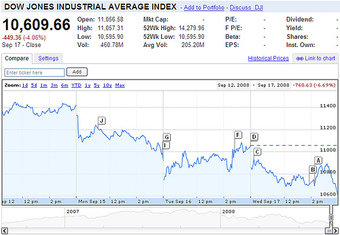
Dow Jones Industrial Average
The DJIA depicts the volume of shares traded over a specific period of time.
8.1.2: Accounting Methodologies: Amortized Cost, Fair Value, and Equity
Due to different durations of holding and other factors, companies use several accounting methodologies, including amortized cost, fair value, and equity.
Learning Objective
Explain the difference between amortized cost, fair value and the equity method for reporting debt securities
Key Points
- Debt securities that the enterprise has the positive intent and ability to hold to maturity are classified as held-to-maturity securities and reported at amortized cost less impairment.
- Debt and equity securities that are bought and held principally for the purpose of selling them in the near term are classified as trading securities and reported at fair value, with unrealized gains and losses included in earnings.
- Debt and equity securities not classified as either held-to-maturity securities or trading securities are classified as available-for-sale securities and reported at fair value, with unrealized gains and losses excluded from earnings and reported in a separate component of shareholders’ equity.
Key Terms
- fair value
-
Fair value, also called “fair price” (in a commonplace conflation of the two distinct concepts) is a concept used in accounting and economics, defined as a rational and unbiased estimate of the potential market price of a good, service, or asset.
- impairment
-
A downward revaluation, a write-down.
Accounting Methodologies
Amortized Cost
If a business holds debt securities to maturity with the intent to sell are classified as held-to-maturity securities. Held to maturity securities are reported at amortized cost less impairment.
Fair Value
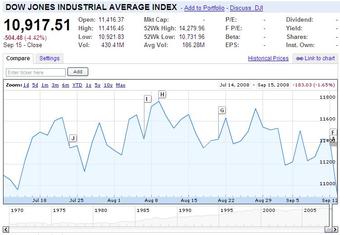
Fair value
Fair value, defined as a rational and unbiased estimate of the potential market price of a good, service, or asset.
Fair value, also called fair price, is a concept used in accounting and economics, defined as a rational and unbiased estimate of the potential market price of goods, services, or assets, taking into account such objective factors as:
- acquisition/production/distribution costs, replacement costs, or costs of close substitutes;
- actual utility at a given level of development of social productive capability;
- supply vs. demand;
- subjective factors such as risk characteristics, cost of and return on capital and individually perceived utility.
Debt and equity securities that are bought and held principally for the purpose of selling them in the near term are classified as trading securities. These securities are reported at fair value, with unrealized gains and losses included in earnings.
Debt and equity securities not classified as either held-to-maturity securities or trading securities are classified as available-for-sale securities. These securities are reported at fair value, with unrealized gains and losses excluded from earnings and reported in a separate component of shareholders’ equity (Other Comprehensive Income).
Equity Method
Equity method in accounting is the process of treating equity investments, usually 20–50%, in associate companies. The investor keeps such equities as an asset. The investor’s proportional share of the associate company’s net income increases the investment (a net loss decreases the investment), and proportional payment of dividends decreases it. In the investor’s income statement, the proportional share of the investee’s net income or net loss is reported as a single-line item.The ownership of more than 50% of voting stock creates a subsidiary. Its financial statements consolidate into the parent’s.
The ownership of less than 20% creates an investment position carried at historic book or fair market value (if available for sale or held for trading) in the investor’s balance sheet.
8.2: Debt Held to Maturity
8.2.1: Amortized Cost Method
Debt held to maturity is shown on the balance sheet at the amortized acquisition cost.
Learning Objective
Explain how a company would apply the amortized cost method to a debt held to maturity
Key Points
- To find the the amortized acquisition cost the securities are amortized like a mortgage or a bond.
- All changes in market value are ignored for debt held to maturity.
- Debt held to maturity is classified as a long-term investment and it is recorded at the market value (original cost) on the date of acquisition.
Key Terms
- acquisition
-
The thing acquired or gained; a gain.
- maturity
-
Date when payment is due
Debt Held to Maturity
The definition of a debt is held-to-maturity is a debt which the company has both the ability and intent to hold until maturity. Debt held to maturity is classified as a long-term investment and it is recorded at the market value (original cost) on the date of acquisition. All changes in market value are ignored for debt held to maturity.
Debt held to maturity is shown on the balance sheet at the amortized acquisition cost. To find the amortized acquisition cost the securities are amortized like a mortgage or a bond.
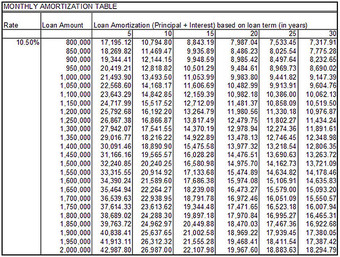
Amortization Schedule
Debt held to maturity is shown on the balance sheet at the amortized acquisition cost. To find the amortized acquisition cost the securities are amortized like a mortgage or a bond.
Example:
Z company purchases 40,000 of the 8%, 5-year bonds of Tee Company for $43,412. The bonds provide a 6% return, with interested paid semiannually. Z Company has both the ability and intent to hold the securities until the maturity date.
The journal entry to record the purchase:
Investment in bonds debit ——— 40,000
Premium on bonds debit ———— 3,412
Cash credit ——————————43,412
The accounting records show the debt at the amortized cost (face amount plus premium/less discount) and the difference between the maturity value and the cost of the bonds is amortized to the income statement over the life of the bonds.
In order to record the interim interest revenue and report the investment on the balance sheet, it is necessary to prepare an amortization schedule for the debt.
The first interest payment is $1,600, but since the company paid a premium, the effective interest earned is $1,302 (net the amortization of the premium).
Example:
The Journal Entry:
Cash debit ———————$1,600
Premium on bonds credit —-$298
Interest revenue credit ——- 1,302
The Z Company’s investment in Tee company is shown on the balance sheet as follows:
Held-to-Maturity Investments
Corporate bonds —————— $40,000
Plus: unamortized premium —– 2,166
Book value (amortized cost)—- $42,166
8.2.2: Accounting for Interest Earned and Principal at Maturity
At maturity, firms should debit cash and credit held to maturity investments the balance of the principal payment.
Learning Objective
Summarize the journal entry required to record a debt held to maturity
Key Points
- When money is borrowed, interest is typically paid to the lender as a percentage of the principal, the amount owed to the lender.
- Nominal, principal, par, or face amount is the amount on which the issuer pays interest, and which, most commonly, has to be repaid at the end of the term.
- The issuer has to repay the nominal amount on the maturity date. As long as all due payments have been made, the issuer has no further obligations to the bond holders after the maturity date.
Key Terms
- maturity date
-
the date on which a principal amount of a note, draft, acceptance bond, or other debt instrument becomes due or payable
- maturity
-
Date when payment is due
- Interest
-
The price paid for obtaining, or price received for providing, money or goods in a credit transaction, calculated as a fraction of the amount of value of what was borrowed.
Interest Defined
Interest is a fee paid by a borrower of assets to the owner as a form of compensation for the use of the assets. It is most commonly the price paid for the use of borrowed money, or money earned by deposited funds.
When money is borrowed, interest is typically paid to the lender as a percentage of the principal, the amount owed to the lender. The percentage of the principal that is paid as a fee over a certain period of time (typically one month or year) is called the interest rate.
Principal At Maturity
Nominal, principal, par, or face amount —is the amount on which the issuer pays interest, and which, most commonly, has to be repaid at the end of the term. Some structured bonds can have a redemption amount which is different from the face amount and can be linked to performance of particular assets such as a stock or commodity index, foreign exchange rate, or a fund. This can result in an investor receiving less or more than his original investment at maturity.

Principal is repaid at maturity
Some structured bonds can have a redemption amount which is different from the face amount and can be linked to performance of particular assets such as a stock or commodity index, foreign exchange rate, or a fund. This can result in an investor receiving less or more than his original investment at maturity
The issuer has to repay the nominal amount on the maturity date (which can be any length of time). As long as all due payments have been made, the issuer has no further obligations to the bond holders after the maturity date. The maturity can be any length of time, although debt securities with a term of less than one year are generally
Accounting for Interest Earned and Principal at Maturity
During the life of the debt held to maturity, the company holding the debt will record the interest received at the designated payment dates.
Journal
entry
Debit cash
Credit interest revenue
If a company paid $10,000 for 8% bonds, a journal entry is required to record the payment of principal at maturity.
Journal entry
Debit cash $10,000
Credit held to maturity investments $10,000
Remember the original entry debited the held to maturity investment account and credit cash.
8.3: Debt for Sale
8.3.1: Accounting for Sale of Debt
How debt sales are recorded depends on whether the debt is classified as “held-to-maturity,” “a trading security,” or “available-for-sale”.
Learning Objective
Summarize how to record the sale of a held-to-maturity, trading security and available for sale debt
Key Points
- Because of fluctuations in market value, held-to-maturity debt is not periodically adjusted while owned. Recording the sale is simply a matter of recording how much cash was received and recording any gain or loss from the transaction.
- The book value of trading security debt changes based on its market value. Any increase or decrease in the value of the debt is recorded as an unrealized gain or loss in a company’s income statement. Any gain or loss from the sale is based on the current book value of the debt.
- The book value of available-for-sale debt changes based on market value. Any increase/decrease in the value of the debt is recorded as an unrealized gain/loss in equity. When debt is sold, the company should recognize all unrecognized gain/loss, and the gain/loss based on the current book value.
Key Terms
- trading securities
-
any financial instrument an investor acquires and intends to resell in the short-term
- available-for-sale
-
securities that do not qualify as “held-to-maturity” or as a “trading security”
- Held-to-maturity
-
any security that an investor intends to retain until its term expires
Under FASB 115, a part of US GAAP (Generally Accepted Accounting Principles), a company must classify all of the debt securities it owns into one of three categories. If the company intends to hold the debt until it matures, it must be classified as a “held-to-maturity” security. If the company acquires the debt with the intent to resell it in the short-term, then it must be listed as a “trading security. ” If the debt is acquired without the intent to resell it in the short-term, nor the intent to hold it to maturity, it should be classified as “available-for-sale” . Each of these three classifications is treated differently for accounting purposes, both prior to sale and during the sale.
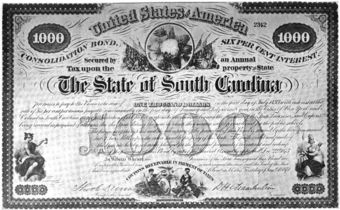
A bond certificate
A bond certificate issued via the South Carolina Consolidation Act of 1873. How the sale of a bond is recorded on a company’s books depends on how the debt is initially classified by the acquiring investor. Debt securities can be classified as “held-to-maturity,” a “trading security,” or “available-for-sale. “
Held-to-Maturity
When debt is acquired and is intended to be held until maturity, it is recorded first by debiting a “Debt Investment Account,” and then by crediting “Cash” for the amount the debt was purchased. For example, if a company purchased $1000 in debt securities, the transaction would be recorded like this:
Investments – Corporate Debt : $1000
Cash : $1000.
While the market value of the debt may vary over time, the company does not need to adjust the value of the debt on its books. Once the company sells the bond, it must report any gains or losses on the sale of the debt. So, in the example above, if the company sold the debt for $1200, it would need to make the following journal entry.
Investments : $1000
Net Gain on Sale : $200
Cash : $1200
If the company sold the debt for $800, it would need to make the following journal entry:
Investments : $1000
Cash : $800
Net Loss on Sale : $200
Trading Securities
If a company acquires debt that it intends to sell in the short-term, it must still record the sale. If a company acquired debt for $1000, and this debt is classified as a trading security, the company would still need to make the first journal entry in the aforementioned manner.That being said, the value of the debt on the owner’s books must be adjusted to match the market value of the debt. For example, if the market value of the debt declined $200 from its original value to $800, a company would need to make the following journal entry:
Unrealized loss on trading security : $200
Investments : $200
The unrealized loss would be included on the company’s income statement for the period it was recorded. If immediately after the accounting period, the company sold the debt for $800, it would need to make the following journal entry:
Cash : $800
Investments : $800
Because both the loss and the decrease in the debt asset’s value were already recorded in the prior accounting period, the company would not have to make any additional adjustments.
Available-for-Sale
If a company acquires debt that is available-for-sale, it would still need to make a first journal entry in the same way that it would if the debt was “held-to-maturity” or a “trading security. ” It would also need to adjust the value of its debt asset in relation to its current market value. Using the same example above, assume a debt asset was acquired for $1000 but declined in value by $200. In the case of an available-for-sale asset, the following journal entry should be made in the following accounts:
(Equity) Unrealized loss on security investment : $200
(Asset) Investments : $200
Unlike trading securities, the unrealized gain is recorded in the equity section of the balance sheet and does not effect the current year income statement at all. This is because, unlike trading securities, the loss from an available-for-sale security is not expected to be realized in the near future. Returning to the example, assume that the debt asset is sold immediately after the end of the accounting period where it first recognized the unrealized loss. The asset is sold for $800. In such a case, the following entries would be appropriate:
(Asset) Cash : $800
(Income Statement) Loss on Investment : $200
(Asset) Investments : $800
(Equity) Unrealized loss on security investment : $200
The result of the journal entry is that the unrealized loss is realized, so the company’s profit for the period is decreased by $200. The debt asset, as well as the unrealized loss, is removed from the company’s books.
8.3.2: Accounting for Sale of Stock
How the stock sale is accounted for depends on the type of stock sold.
Learning Objective
Summarize how to account for the sale of common stock, preferred stock and treasury stock
Key Points
- For common stock at par value, debit cash and credit common stock. For common stock sold above par, debit cash, credit common stock, and credit additional paid in capital.
- For preferred stock, debit cash and credit preferred stock.
- For sales of treasury stock, debit cash and credit treasury stock.
Key Terms
- preferred
-
Preferred stock.
- par value
-
The amount or value listed on a bill, note, stamp, etc.; the stated value or amount.
Accounting for the Sale of Stock
Often times companies offer their stock for sale as a way to generate cash. How the stock sale is accounted for depends on the type of stock sold. Most stock sales involve common stock or preferred stock.
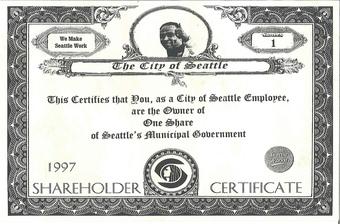
Sale of Stock.
Often times companies offer their stock for sale as a way to generate cash. How the stock sale is accounted for depends on the type of stock sold. Most stock sales involve common stock or preferred stock.
Common Stock-sold at par value
Journal
entry
Debit cash
Credit common stock
If the common stock is sold above par value the journal entry is slightly different.
Debit cash
Credit common stock
Credit additonal paid in capital (to account for the difference between par value and sell value)
Preferred Stock
The sale of preferred stock is similarly treated, but a separate accounts should be established to record preferred stock and any additional paid in capital for preferred stock sold at above par value.
Journal entry
Debit cash
Credit preferred stock
Credit additional paid in capital preferred stock (if needed)
Treasury stock
Treasury stock is issued stock that the company has bought back from its shareholders. Since a corporation can’t be its own shareholder, the “bought back” stocks are not considered assets of the corporation. Treasury stock also doesn’t have the right to vote, receive dividends or receive liquidation value.
If the company plans to re issue the shares in the future, it would hold them in treasury and report the reduction in stockholder’s equity on the balance sheet.
There are several reasons a company may purchase treasury stock, it may need it for employee compensation plans, to buy another company or to reduce the number of outstanding shares.
Journal entry
Debit treasury stock
Credit cash
When treasury stock is sold the accounts used to record the transaction will vary depending on whether the stock sold above or below the cost of purchase.
Sold above purchase cost
Debt cash
Credit treasury stock
Credit additional paid in capital (the difference between sale price and purchase price)
8.3.3: Assessing Fair Value
Companies must calculate the fair market value for these available for sale securities at the end of each subsequent accounting period.
Learning Objective
Explain why a company calculates the fair market value of available for sale securities
Key Points
- The difference between the purchase price and the current fair market value results in a an unrealized gain or loss.
- Realized gains and losses are included in income; unrealized amounts are included in income (trading investments) or in other comprehensive income (available-for-sale investments).
- Unrealized holding gains (unrealized because asset is not sold yet)-increase in fair value of an asset while held.
- Realized holding gain (realized through sale) increase in fair value of an asset while held.
Key Term
- unrealized
-
Not realized; possible to obtain, yet not obtained.
Fair Value Method
Often companies use excess cash to purchase stocks and bonds from other companies. If a company purchases stocks or bonds with the intent to sell these items at a future date when they need cash, these are referred to as “Available-for-sale securities”.
A company initially records the “available for sale securities” at cost. While holding onto the securities the company must calculate the fair market value for these securities at the end of each subsequent accounting period.

Debt
A company initially records the “available for sale securities” at cost. While holding onto the securities the company must calculate the fair market value for these securities at the end of each subsequent accounting period.
The difference between the purchase price and the current fair market value results in an unrealized gain or loss. The unrealized gain or loss affects the company’s accumulated other comprehensive income, a component of stockholders’ equity.
Realized gains and losses are included in income; unrealized amounts are included in income (trading investments) or in other comprehensive income (available-for-sale investments).
Unrealized holding gains (unrealized because asset is not sold yet)-increase in fair value of an asset while held.
Realized holding gain (realized through sale) increase in fair value of an asset while held.
Using the fair value method, available for sale investment with unrealized gains and losses included in other comprehensive income should have:
- The original investment is recorded at its investment cost.
- Transaction costs, such as brokerage fees, included in acquisition cost and capitalized, or immediately expensed.
- Interest or dividends declared are recorded as investment income.
- Interest income includes amortization of any premium or discount inherent in the initial purchase price
- At the end of each reporting period, the investments are revalued to fair value (market
- value), whether this is higher or lower than the existing balance in the investment account.
- Unrealized holding gains, defined as the difference between the existing balance in the
- investment account (the new fair value) and the old fair value, are recorded in other comprehensive income.
- The investment is reported at fair value on the balance sheet.
Using the fair value method, available for sale investment with unrealized gains and losses recognized in net income should have:
- The original investment is recorded at its investment cost. This is fair value on the purchase date.
- Transaction costs, such as brokerage fees, may be included in acquisition cost and capitalized, or immediately expensed.
- Interest or dividends declared are recorded as investment income.
- At the end of each reporting period, the investments are revalued to fair value, whether
- this is higher or lower than the existing balance in the investment account.
- Holding gains, defined as the difference between the existing balance in the investment
- account (the new fair value) and the old fair value, are recorded in net income.
- The investment is reported at fair value on the balance sheet.
8.4: Holding Less than 20% of Shares
8.4.1: Fair Value Method
The ownership of less than 20% creates an investment position carried at fair market value in the investor’s balance sheet.
Learning Objective
Explain how the Fair Value Method is used to calculate the value of holding of less than 20%
Key Points
- Fair market value (FMV) is an estimate of the market value of a property, based on what a knowledgeable, willing, and unpressured buyer would probably pay to a knowledgeable, willing, and unpressured seller in the market.
- An estimate of Fair Market Value is usually subjective due to the circumstances of place, time, the existence of comparable precedents, and the evaluation principles of each involved person.
- The fair market value is the price at which the property would change hands between a willing buyer and a willing seller, neither being under any compulsion to buy or to sell and both having reasonable knowledge of relevant facts.
- For assets carried at historical cost, the fair value of the asset is not used.
Key Terms
- book value
-
The value of an asset as reflected on an entity’s accounting books, net of depreciation, but without accounting for market value appreciation.
- fair market value
-
The price at which the buyer and seller are willing to do business.
- eminent domain
-
(US) The right of a government over the lands within its jurisdiction. Usually invoked to compel land owners to sell their property in preparation for a major construction project such as a freeway.
Fair Value Method
The ownership of less than 20% creates an investment position carried at historic book value or fair value (if available for sale or held for trading) in the investor’s balance sheet.
In accounting, fair value (also knows as “fair market value”) is used as a certainty of the market value of an asset (or liability) for which a market price cannot be determined (usually because there is no established market for the asset). Under US GAAP (FAS 157), fair value is the amount at which the asset could be bought or sold in a current transaction between willing parties, or transferred to an equivalent party, other than in a liquidation sale. This is used for assets whose carrying value is based on mark-to-market valuations; for assets carried at historical cost, the fair value of the asset is not used.

A gold nugget
Fair market value (FMV) is an estimate of the market value of a property.
Since market transactions are often not observable for assets such as privately held businesses and most personal and real property, fair value must be estimated. An estimate of fair value is usually subjective due to the circumstances of place, time, the existence of comparable precedents, and the evaluation principles of each involved person. Opinions on value are always based upon subjective interpretation of available information at the time of assessment. This is in contrast to an imposed value, in which a legal authority (law, tax regulation, court, etc.) sets an absolute value upon a product or a service.
A property sale, in lieu of an eminent domain taking, would not be considered a fair market transaction since one of the parties (i.e., the seller) was under undue pressure to enter into the transaction. Other examples of sales that would not meet the test of fair market value include a liquidation sale, deed in lieu of foreclosure, distressed sale, and similar types of transactions.
In United States tax law, the definition of fair value is found in the United States Supreme Court decision in the Cartwright case: the fair market value is the price at which the property would change hands between a willing buyer and a willing seller, neither being under any compulsion to buy or to sell and both having reasonable knowledge of relevant facts.
The term fair market value is used throughout the Internal Revenue Code among other federal statutory laws in the USA including bankruptcy, many state laws, and several regulatory bodies.
8.4.2: Calculating Fair Value
Calculating fair value involves considering objective factors including acquisition, supply vs. demand, actual utility, and perceived value.
Learning Objective
Summarize how to calculate fair value for holdings of less than 20%
Key Points
- Fair value, also called “fair price”, is a concept used in accounting and economics, defined as a rational and unbiased estimate of the potential market price of a good, service, or asset.
- In accounting, a three-level framework is used to calculate an asset or liability’s fair value — Level 1 is based on quoted market prices, Level 2 is based on estimated market observables, and Level 3 uses unobservable inputs derived internally by the company.
- Under US GAAP, when purchasing less than 20% of a company’s stock, the cost method is used to account for the investment.
- As required by FAS 115, investments accounted for under the cost method should be adjusted to current fair value at the end of each accounting period, in cases where the fair value is readily determinable.
Key Terms
- supply vs. demand
-
Supply and demand is an economic model of price determination in a market. It concludes that in a competitive market, the unit price for a particular good will vary until it settles at a point where the quantity demanded by consumers (at current price) will equal the quantity supplied by producers (at current price), resulting in an economic equilibrium of price and quantity.
- return on capital
-
Return on capital (ROC) is a ratio used in finance, valuation, and accounting. The ratio is estimated by dividing the after-tax operating income (NOPAT) by the book value of invested capital.
Example
- An example of how to determine fair value can involve the purchase of company shares of less than 20% total equity — assume ABC Corporation purchases 10% of XYZ’s Corporation’s common stock, or 50,000 shares. The market price of the stock is USD 1. When purchasing less than 20% of a company’s stock, the cost method is used to account for the investment. ABC records a journal entry for the purchase by debiting Investment in XYZ Corp. for USD 50,000 and crediting Cash for USD 50,000.
Determining Fair Value
Fair value, is a concept used in accounting and economics, defined as a rational and unbiased estimate of the potential market price of a good, service, or asset, taking into account such objective factors as:

Fair value
Fair value is defined as a rational and unbiased estimate of the potential market price of a good, service, or asset.
- acquisition/production/distribution costs, replacement costs, or costs of close substitutes
- actual utility at a given level of development of social productive capability
- supply vs. demand
- subjective factors such as: risk characteristics; cost of and return on capital; individually perceived utility
In accounting, fair value is used as an approximation of the market value of an asset (or liability) for which a market price cannot be determined (usually because there is no established market for the asset). When an active market does not exist other methods have to be used to estimate the fair value. Assumptions used to estimate fair value should be from the perspective of an unrelated market participant. This necessitates identification of the market in which the asset or liability trades. If more than one market is available, the “most advantageous market” should be used. Both the price and costs to do the transaction must be considered in determining which market is the most advantageous market.
A three-level framework is used to determine an asset or liability’s fair value:
- Level One — The preferred inputs to valuation are “quoted prices in active markets for identical assets or liabilities,” with the caveat that the reporting entity must have access to that market. An example would be a stock trade on the New York Stock Exchange. Information at this level is based on direct observations of transactions involving the identical assets or liabilities being valued.
- Level Two — This valuation is based on market observables. FASB indicates that assumptions enter into models that use Level 2 inputs, a condition that reduces the precision of the outputs (estimated fair values), but nonetheless produces reliable numbers that are representationally faithful, verifiable and neutral.
- Level Three — The FASB describes Level 3 inputs as “unobservable.” If observable inputs from levels 1 and 2 are not available, the entity may only rely on internal information if the cost and effort to obtain external information is too high. Within this level, fair value is also estimated using a valuation technique. Significant assumptions or inputs used in the valuation technique are based upon inputs that are not observable in the market and are based on internal information. This category allows “for situations in which there is little, if any, market activity for the asset or liability at the measurement date.
Under US GAAP (FAS 157), fair value is the amount at which the asset could be bought or sold in a current transaction between willing parties or transferred to an equivalent party other than in a liquidation sale. This is used for assets whose carrying value is based on mark-to-market valuations; for assets carried at historical cost, the fair value of the asset is not used.
An example of how to determine fair value can involve the purchase of company shares of less than 20% total equity — assume ABC Corporation purchases 10% of XYZ’s Corporation’s common stock, or 50,000 shares. The market price of the stock is USD 1. When purchasing less than 20% of a company’s stock, the cost method is used to account for the investment. ABC records a journal entry for the purchase by debiting Investment in XYZ Corp. for USD 50,000 and crediting Cash for USD 50,000.
Adjusting Fair Value
As required by FAS 115, investments accounted for under the cost method should be adjusted to current fair value at the end of each accounting period, in cases where the fair value is readily determinable. Adjustments are debited (for gains in fair value) or credited (for losses) to a fair value adjustment account that will adjust the investment account balance to its fair value at the end of the reporting period.
If the investment is considered a “trading security” or stock purchased for the purpose of selling it in the near term, the balancing debit or credit is charged to an unrealized loss or gain account. If the investment is an “available for sale” security, the balancing debit or credit also goes to an unrealized loss or gain account. For investments where the fair value is not readily determinable, the investment is carried at cost.
8.4.3: Reporting Fair Value
Stock investments of 20% or less are recorded at cost (considered its fair value) and reported as an asset on the balance sheet.
Learning Objective
Explain how to record stock investments of less than 20% using Fair Value
Key Points
- Fair value accounting, also known as mark-to-market accounting, can change values on the balance sheet as market conditions change. In contrast, historical cost accounting, based on the past transactions, is simpler, more stable, and easier to perform, but does not represent current market value.
- Ownership of less than 20% of a company’s stock dictates that the investor is not able to exercise significant influence in the company or participate in shareholder meetings where business decisions are made.
- Dividends declared on investments of less than 20% equity are reported as current assets on the balance sheet and other income on the income statement.
Key Terms
- journal entry
-
A journal entry, in accounting, is a logging of transactions into accounting journal items. The journal entry can consist of several items, each of which is either a debit or a credit. The total of the debits must equal the total of the credits or the journal entry is said to be “unbalanced. ” Journal entries can record unique items or recurring items, such as depreciation or bond amortization.
- dividend
-
A pro rata payment of money by a company to its shareholders, usually made periodically (eg, quarterly or annually).
Example
- The following is an example of how to report investments of less than 20% of shares — assume ABC Corporation purchases 10% of XYZ’s Corporation’s common stock, or 50,000 shares. The market price of the stock is USD 1. When purchasing less than 20% of a company’s stock, the cost method is used to account for the investment. ABC records a journal entry for the purchase by debiting Investment in XYZ Corp. for USD 50,000 and crediting Cash for USD 50,000. The investment in XYZ Corporation is reported at cost in the asset section of the balance sheet. If the investee declares dividends, the investor records a journal entry for their share of the investment. Assume XYZ Corporation declares a dividend of USD 1 per share. ABC records a journal entry debiting Dividends Receivable for USD 50,000 and crediting Dividend Income for USD 50,000. The Dividend Receivable is reported on the balance sheet under current assets and Dividend Income is reported on the income statement under a section for other income.
Fair Value Accounting and Financial Statements
Fair value accounting, also known as mark-to-market accounting, can change values on the balance sheet as market conditions change. In contrast, historical cost accounting, based on past transactions, is simpler, more stable, and easier to perform, but does not represent current market value. It summarizes past transactions instead. Mark-to-market accounting can become inaccurate if market prices fluctuate greatly or change unpredictably. Buyers and sellers may claim a number of specific instances when this is the case, including inability to value the future income and expenses on the income statement accurately and collectively, often due to unreliable information, or overly-optimistic/ overly-pessimistic expectations.
Reporting Stock Investments of Less Than 20% of Shares
Ownership of less than 20% of a company’s stock dictates that the investor is not able to exercise significant influence in the company or participate in shareholder meetings where business decisions affecting the company are made. Ownership of this quantity of stock is recorded using the cost method.
The following is an example of how to report investments of less than 20% of shares — assume ABC Corporation purchases 10% of XYZ’s Corporation’s common stock, or 50,000 shares. The market price of the stock is USD 1. When purchasing less than 20% of a company’s stock, the cost method is used to account for the investment. ABC records a journal entry for the purchase by debiting Investment in XYZ Corp. for USD 50,000 and crediting Cash for USD 50,000. The investment in XYZ Corporation is reported at cost in the asset section of the balance sheet.
If the investee declares dividends, the investor records a journal entry for their share of the investment. Assume XYZ Corporation declares a dividend of USD 1 per share. ABC records a journal entry debiting Dividends Receivable for USD 50,000 and crediting Dividend Income for USD 50,000. The Dividend Receivable is reported on the balance sheet under current assets and Dividend Income is reported on the income statement under a section for other income.
Reporting Adjustments in Fair Value
As required by FAS 115, the value of an investment accounted for under the cost method should be adjusted to current fair value at the end of each accounting period, in cases where the fair value is readily determinable. Changes in fair value are debited (for gains in fair value) or credited (for losses) to a fair value adjustment account reported on the balance sheet to adjust the investment account balance to its end of period fair value.
If the investment is considered a “trading security” or stock purchased for the purpose of selling it in the near term, the balancing debit or credit is charged to an unrealized loss or gain reported on the income statement. If the investment is an “available for sale” security, the balancing debit or credit goes to an unrealized loss or gain account reported in the other comprehensive income section of owner’s equity on the balance sheet. When the investment is sold, all losses or gains from the transaction become realized and flow through into the income statement to adjust revenues for the period.
8.5: Holding 20-50% of Shares
8.5.1: Equity Method
Equity method is the process of treating equity investments (usually 20–50%) of companies. The investor keeps such equities as an asset.
Learning Objective
Summarize how a company uses the Equity Method to record their investment in another company
Key Points
- Equity method in accounting is the process of treating equity investments, usually 20–50%, in associate companies. The investor keeps such equities as an asset.
- The investor’s proportional share of the associate company’s net income increases the investment; net loss, and proportional payment of dividends, decreases it.
- Typically, equity holders receive voting rights on certain issues, residual rights, meaning that they share the company’s profits, and are allowed to recover some of the company’s assets in the event that it folds (although they generally have the lowest priority in recovering their investment).
Key Terms
- Pension funds
-
A pension fund is any plan, fund, or scheme which provides retirement income.
- mutual funds
-
A mutual fund is a type of professionally-managed collective investment vehicle that pools money from many investors to purchase securities.
Equity method in accounting is the process of treating equity investments, usually 20–50%, in associate companies. The investor keeps such equities as an asset. The investor’s proportional share of the associate company’s net income increases the investment; a net loss, or proportional payment of dividends, decreases the investment. In the investor’s income statement, the proportional share of the investee’s net income or net loss is reported as a single-line item .
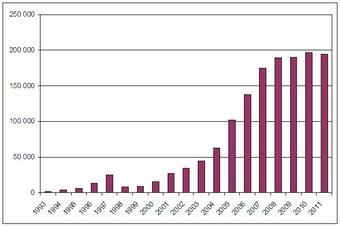
Equity
Investors keep equities as assets using equity method.
An equity investment generally refers to the buying and holding of shares of stock by individuals and firms in anticipation of income from dividends and capital gains. Typically, equity holders receive voting rights, meaning that they can vote on candidates for the board of directors (shown on a proxy statement received by the investor) as well as certain major transactions. Equity holders also receive residual rights, meaning that they share the company’s profits, as well as the right to recover some of the company’s assets in the event that it folds—although they generally have the lowest priority in recovering their investment. It may also refer to the acquisition of equity (ownership) participation in a private (unlisted) company or a startup company. When the investment is in infant companies, it is referred to as venture capital investing and is generally regarded as a higher risk than investment in listed going-concern situations.
Equities held by private individuals are often held as mutual funds or as other forms of collective investment schemes, many of which have quoted prices that are listed in financial newspapers or magazines. Mutual funds are typically managed by prominent fund management firms, such as Schroders, Fidelity Investments, or The Vanguard Group. Such holdings allow individual investors to obtain diversification of the fund(s) and to make use of the skill of the professional fund managers in charge of the fund(s). An alternative, which is usually employed by large private investors and pension funds, is to hold shares directly. In the institutional environment, many clients who own portfolios have what are called segregated funds, as opposed to or in addition to the pooled mutual fund alternatives.
A calculation can be made to assess whether an equity is over- or under-priced, compared with a long-term government bond. This is called the Yield Gap or Yield Ratio. It is the ratio of the dividend yield of an equity and that of the long-term bond.
8.5.2: Assessing Control
20-50% of overall shares in a firm is referred to as a minority interest, which is a non-controlling position from a strategic frame.
Learning Objective
Understand the role minority interest shareholders hold in decision-making, and the accounting method used to report it
Key Points
- Holding company shares in an organization technically imparts voting rights to the shareholder, though the percentage of the organization owned impacts the scale of this influence.
- Ownership between 20-50% is referred to as a minority interest in the organization, and must be reported using the equity method.
- In regards to control, minority interest is a not a controlling position in the firm. In most situations, 51% ownership is required (majority).
- However, a minority interest stakeholder may be consulted on certain strategic decisions and may be on the board of directors.
Key Term
- minority interest
-
Ownership between 20-50% in an organization.
Holding shares in an organization grants a certain level of voting rights and ownership of that organization. This becomes particularly relevant when ownership of the firm reaches or exceeds 20% of the overall value of the organization. Over 50% ownership indicates an actual transfer of ownership, often recorded as a subsidiary by the owning party.
The space between 20% and 50% has specific guidelines in regards to reporting, ownership, and the assessment of control. This is referred to as an associate company, and must be reported utilizing the equity method.
The Equity Method
This is the method used to record an investment at the level of an associate company (20-50% ownership). This is considered an asset on behalf of the investor, and reported accordingly. An investment’s percentage ownership of the company appreciates when the net income increases and depreciates when it decreases. This share is reported on the investor’s income statement as a single-line item.
Assessing Control
Control of an organization is in the hands of the owners. The owners, in most publicly traded situations, are represented by the individual who hold significant percentages of the overall organization’s value. In a situation where an individual or organization owns more than 20% and less than 50% of the overall shares, this control is referred to as a minority interest.
Minority Interest
Owning 50% or more of the shares is a majority interest, granting the owner volume control over significant organizational decisions. However, a minority interest is still a primary shareholder that will (in most situations) have influence on the decisions being made at the strategic level.
Generally speaking, minority interest is still non-controlling interest. 51% is required to make substantial decisions regarding the organization itself. That being said, a minority interest is still a significant share of the organization. As a result, it is not uncommon for minority interest shareholders to hold a seat on the board of directors, or to be consulted regarding the decisions.

Intel Board of Directors
This image is from Intel’s Board of Directors.
8.5.3: Reporting Equity Investments
Investments recorded under the equity method usually consist of stock ownership of a company between 20% to 50%.
Learning Objective
Explain why a company would use the Equity Method to determine how to report their 20-50% investment
Key Points
- When the amount of stock purchased is between 20% and 50% of the common stock outstanding, the purchasing company’s influence over the acquired company is often significant and the investor participates in business decision-making.
- Under the equity method, the purchaser records its investment at the original cost. The balance of the investment increases by the pro-rata share of the investee’s income and decreases by the pro-rata share of dividends declared by the subsidiary.
- At the time of purchase, goodwill can arise from the difference between the cost of the investment and the book value of the underlying assets.
Key Terms
- pro forma income
-
a statement of the company’s revenue while excluding “unusual and nonrecurring transactions” when stating how much money the company actually made
- pro-rata
-
in proportion to some other factor, such as shares owned
- FASB
-
The Financial Accounting Standards Board (FASB) is a private, not-for-profit organization whose primary purpose is to developgenerally accepted accounting principles (GAAP) within the United States in the public’s interest.
Reporting Stock Investments of 20-50% of Equity
When the amount of stock purchased is between 20% and 50% of the common stock outstanding, the purchasing company’s influence over the acquired company is often significant. The deciding factor, however, is significant influence or the ability for the investor to have a say in business decisions made by company owners. If other factors exist that reduce the influence, or if significant influence is gained at an ownership of less than 20%, the equity method may be appropriate. FASB interpretation 35 (FIN 35) underlines the circumstances where the investor is unable to exercise significant influence).
To account for this type of investment, the purchasing company uses the equity method. Under the equity method, the purchaser records its investment at the original cost. The balance of the investment increases by the pro-rata share of the investee’s income and decreases by the pro-rata share of dividends declared by the subsidiary.
An example of how to apply the equity method to a stock investment — assume ABC Corporation purchases 30% of XYZ Corporation (or 80,000 shares) and can exercise significant influence. The market price of the stock is USD 1. At the end of 201X, XYZ earns net income of 100,000 and declares a dividend of USD 1 per share. The following journal entries are made by ABC to record the investment in XYZ:
Journal entry for the stock investment purchase:
- DR – Investment in XYZ Corporation USD 80,000 (80,000 shares * USD 1 market price/share)
- CR – Cash USD 80,000
Journal entry to account for the pro-rata share of XYZ annual income:
- DR – Investment in XYZ Corporation USD 30,000 (100,000 net income * .30)
- CR – Equity in XYZ Corp. Income USD 30,000
Journal entry to account for the pro-rata share of XYZ dividends:
- DR – Dividends Receivable 80,000 (80,000 shares * USD 1 dividend per share)
- CR – Investment in XYZ Corporation 80,000
Goodwill and Equity Investments
At the time of purchase, goodwill can arise from the difference between the cost of the investment and the book value of the underlying assets. The component that can give rise to goodwill is: the difference between the fair market value of the underlying assets and their book value .

Goodwill
Goodwill is an accounting concept meaning the excess value of an asset acquired over its book value due to a company’s competitive advantages.
Goodwill is no longer amortized under U.S. GAAP (FAS 142) of June 2001. Companies objected to the removal of the option to use pooling-of-interests, so amortization was removed by the Financial Accounting Standards Board as a concession. As of January 1, 2005, it is also forbidden under International Financial Reporting Standards. Goodwill can now only be impaired under these GAAP standards.
To test goodwill for impairment, companies are now required to determine the fair value of the reporting units, using the present value of future cash flow, and compare it to their carrying value (book value of assets plus goodwill minus liabilities). If the fair value is less than carrying value (impaired), the goodwill value needs to be reduced so that the fair value is equal to the carrying value. The impairment loss is reported as a separate line item on the income statement, and the new adjusted value of goodwill is reported in the balance sheet.
8.6: Holding More than 50% of Shares (Ownership)
8.6.1: Reporting for a Combined Entity
When the amount of stock owned is >50% of common stock, a parent-subsidiary relationship is formed that requires consolidated reporting.
Learning Objective
Explain how to report for a combined entity
Key Points
- A subsidiary company, or daughter company is a company that is completely or partly owned and partly or wholly controlled by another company that owns more than half of the subsidiary’s stock.
- Consolidated financial statements show the parent and subsidiary as one single entity. During the year, the parent company uses the equity method to account for its investment. At the end of the year, a consolidation working paper eliminates intercompany transactions between parent and subsidiary.
- As of 2004, the acquisition method is the only allowable method that can be used to prepare consolidated financial statements for companies that combined after 2004. Other consolidation methods previously used were the purchase and the pooling of interests methods.
Key Term
- state-owned enterprise
-
A government-owned corporation, state-owned company, state-owned entity, state enterprise, publicly owned corporation, government business enterprise, commercial government agency,public sector undertaking or parastatal is a legal entity created by a government to undertake commercial activities on behalf of an owner government.
Reporting for a Combined Entity
The ownership of more than 50% of voting stock creates a subsidiary. The financial statements of the parent and subsidiary are consolidated for reporting purposes.
A subsidiary company, or daughter company is a company that is completely or partly owned and partly or wholly controlled by another company that owns more than half of the subsidiary’s stock. The subsidiary can be a company, corporation, or limited liability company. In some cases it is a government or state-owned enterprise. The controlling entity is called its parent company, parent, or holding company.
An operating subsidiary is a business term frequently used within the United States’s railroad industry. In the case of a railroad, it refers to a company that is a subsidiary but operates with its own identity, locomotives, and rolling stock. In contrast, a non-operating subsidiary would exist on paper only (i.e. stocks, bonds, articles of incorporation) and would use the identity and rolling stock of the parent company.
When the amount of stock purchased is more than 50% of the outstanding common stock, the purchasing company usually has control over the acquired company. Control in this context is defined as ability to direct policies and management. In this type of relationship the controlling company is the parent and the controlled company is the subsidiary. The parent company needs to issue consolidated financial statements at the end of the year to reflect this relationship.
Consolidated financial statements show the parent and the subsidiary as one single entity. During the year, the parent company can use the equity or the cost method to account for its investment in the subsidiary. Each company keeps separate books. However, at the end of the year, a consolidation working paper is prepared to combine the separate balances and to eliminate the intercompany transactions between the parent and the subsidiary, along with the subsidiary’s stockholder equity and the parent’s subsidiary investment account. The result is one set of financial statements that reflect the financial results of the consolidated entity. As of 2004, the acquisition method is the only allowable method that can be used to prepare consolidated financial statements for companies that combined after 2004. Other consolidation methods previously used were the purchase and the pooling of interests methods .
The following is an example of how to calculate consolidated net income — assume ABC Corporation owns 80% of XYZ Corporation; the remaining 20% is a non-controlling ownership interest.
Net Income for 201X for ABC is USD 20,000 and for XYZ net income is USD 8,000. First, to arrive at consolidated net income for the two companies, ABC must eliminate the effect of the equity method used to account for its investment.
ABC’s net income for the year includes 80% of XYZ’s net income, or USD 6,400. This amount must be subtracted from the net income figure to arrive at 13,600 (20,000 – 6,400).
The consolidated net income for both companies after this adjustment is USD 21,600 (20,000 – 6,400 + XYZ’s total net income of 8,000). Second, the portion of net income attributed to the non-controlling ownership interest must be deducted, or USD 1,600 (8,000 * .20).
Therefore, consolidated income for ABC and its controlling interest in XYZ is USD 20,000 (21,600 – 1,600).
Chapter 7: Controlling and Reporting of Intangible Assets
7.1: Introduction to Intangible Assets
7.1.1: Characteristics of Intangible Assets
Intangible assets are identifiable non-monetary assets that cannot be seen, touched, or physically measured.
Learning Objective
Differentiate between legal intangibles and competitive intangibles
Key Points
- Intangible assets are either legal or competitive in nature, and can be very valuable to a company’s competitive position.
- Intangible assets can have either identifiable or indefinite useful or legal lives.
- The nature of an intangible asset will determine what costs are initially capitalized and how expenses related to the intangible asset are subsequently recognized.
Key Terms
- monetary
-
1. Of, pertaining to, or consisting of money.
- intangible asset
-
1. Assets that are non-current, non-monetary, and non-physical.
- monetary unit assumption
-
the business should have one dollar (or corresponding currency) to record its transactions
Intangible Assets
Intangible assets are defined as identifiable non-monetary assets that cannot be seen, touched or physically measured, and are created through time and effort. Intangible assets are identified separately on a company’s financial statements, and come in two primary forms: legal intangibles and competitive intangibles.
Legal intangibles are also known as intellectual property, and include trade secrets, copyrights, patents, and trademarks. An example would be Coca-Cola’s drink formula which is a closely held trade secret that only a few employees know; this is an example of an internally developed intangible asset.

Coca-Cola
The year 1950 ushered in an era marked by the consolidation of large companies.
Competitive intangibles include collaboration, leverage, structural activities, and customer loyalty. Human capital is the primary source of competitive intangibles.
Goodwill
Goodwill is technically an intangible asset, but is usually listed separately on a company’s balance sheet. Goodwill is only recognized through an acquisition of a company or business combination and is calculated as the difference between the amount of money paid to acquire a company and the fair or book value of the acquired company’s net assets. Goodwill is a type of intangible asset that is acquired and recorded due to a business acquisition or combination rather unlike other intangible assets, which may be internally developed by the company.
Example
Company
is a car dealership with assets consisting of 10 cars valued at $100,000, an office valued at $150,000, and long-term debt valued at $25,000. Company
‘s net assets total
. Company
has a top-performing sales personnel who are loyal to the company and refuse to leave. Company
is a larger car dealership in the area and decides to purchase Company
for $300,000 in order to capitalize on Company
‘s sales force. The extra
that Company
paid above Company
‘s net assets are recognized by Company
as Goodwill on their balance sheet.
Useful Lives
Intangible assets have a useful life that is either identifiable or indefinite. Intangible assets with identifiable useful lives are amortized on a straight-line basis over their economic or legal life, which ever is shorter. Intangible assets with indefinite useful lives are assessed each year for impairment. Impairment losses are determined by subtracting the asset’s market value from the asset’s book/carrying value. If an impairment loss is found it is recognized on the income statement and the intangible asset value is reduced.
Under US GAAP, intangible assets are classified into: Purchased vs. Internally Created Intangibles, and Limited-Life vs. Indefinite-Life Intangibles.
Financial Statement Recognition
Firms initially record intangible assets at cost, however only costs associated with the outright purchase in the acquisition of an intangible asset. Research and development costs incurred during the internal development or self-creation of an intangible asset are not costs that can be capitalized. This then means that some companies have very valuable assets that they are not allowed to recognize on their balance sheets under US GAAP.
7.1.2: Valuation of Intangible Assets
The valuation of intangible assets are primarily derived from transactions involving intangible assets.
Learning Objective
Summarize how to calculate the value of an intangible asset
Key Points
- Intangible assets include items such as patents, copyrights, software, trade secrets, and goodwill. However, not all intangible assets are recognized on the financial statements of a company.
- The costs to acquire and defend intangible assets are used by accountants to establish intangible asset values.
- Valuation is an estimate that is subject to change based on market conditions and advances in technology.
Key Terms
- valuation
-
An estimation of something’s worth.
- Trademark
-
A word, symbol, or phrase used to identify a particular company’s product and to differentiate it from other companies’ products.
Valuation of Intangible Assets
Valuation models can be used to value intangible assets such as patents, copyrights, software, trade secrets, and customer relationships. Since few sales of intangible assets are observable, benchmarking the value of intangible assets can be difficult. As a result, present value models or estimating of the cost to recreate an intangible asset are often used to is these valuations.
Although they have no physical characteristics, intangible assets have value because of the advantages or exclusive privileges they provide to a business. Intangible assets generally arise from two sources: (1) exclusive privileges granted by governmental authority or by legal contract, such as patents, copyrights, franchises, trademarks and trade names; and (2) superior entrepreneurial capacity or management know-how and customer loyalty , which is called goodwill.

Goodwill is an intangible asset
Strong customer relationships often generate goodwill. This is a long line of customers queued up at an Apple store.
Intangible assets are initially recorded on financial statements at their purchase price, or the cost of acquiring the asset. If an intangible asset is internally generated, its cost is immediately expensed.
The valuation of intangible assets with identifiable useful lives such as patents, trademarks, and copyrights are initially valued at acquisition costs. The value of these assets can be increased or decreased, based on the outcomes of court proceedings. If a company incurs legal costs to successfully defend an intangible asset, those costs are capitalized and increase the value of the intangible. On the other hand, if a company is unsuccessful in defending an intangible asset, the intangible is worthless and the company is required to write it off.
U.S. GAAP has very specific rules regarding the recognition of intangible assets on financial statements. With that said, a company can still have very valuable intangible assets that are not recognized on its financial statements. From an accounting perspective, intangible asset valuation is primarily derived from acquisition costs. An acquisition identifies the value one party was willing to pay for an asset while at the same time identifying the value another party was willing to accept to relinquish that asset.
Goodwill is an excellent example of how intangible assets are valued. Let’s say Company A has net assets equal to 150,000 and is acquired by Company B for 200,000. Why would Company B pay a 50,000 premium? Goodwill! Company B believes that Company A has value in excess of their net identifiable assets, and was willing to pay an additional 50,000 to acquire it. The 50,000 value of Company A’s goodwill was derived from a transaction.
7.1.3: Amortization of Intangible Assets
The costs of intangible assets with identifiable useful lives are amortized over their economic/legal life.
Learning Objective
Explain how to amortize an intangible asset
Key Points
- Intangible assets are amortized using the straight line amortization method.
- Goodwill is an intangible asset that is not amortized, but is instead tested for impairment on an annual basis.
- The economic or useful life of an intangible asset is based on an estimate made by management and is subject to change under certain market conditions.
Key Terms
- goodwill
-
The value of an asset that is considered intangible but has a quantifiable “value” in a business. For example, a reputation the firm enjoys with its clients.
- Indefinite
-
Without limit; forever, or until further notice; not definite
- impairment
-
When the carrying value exceeds the fair value.
Amortization of Intangible Assets
Under US GAAP, the cost of intangible assets are either amortized over their respective useful/legal lives, or are tested for impairment on an annual basis. Amortization is the systematic write-off of the cost of an intangible asset to an expense, which effectively allocates a portion of the intangible asset’s cost to each accounting period in the economic or legal life of the asset (an amortization expense). Only recognized intangible assets with finite useful lives are amortized. This differs from tangible assets which are depreciated (resulting in a depreciation expense) over their useful life.
Useful Lives
Intangible assets have a useful life that is either identifiable or indefinite. Intangible assets with identifiable useful lives are amortized on a straight-line basis over their economic or legal life, whichever is shorter. The finite useful life of an intangible asset is considered to be the length of time it is expected to contribute to the cash flows of the reporting entity. Pertinent factors that should be considered in estimating the useful lives of intangible assets include legal, regulatory, or contractual provisions that may limit the useful life.
Costs of Intangible Assets
Firms may only include the immediate purchase costs of an intangible asset, which do not include the costs associated with internal development or self-creation of the asset. If an intangible asset is internally generated in its entirety, none of the costs related to the asset are capitalized.
Straight Line Amortization vs. Testing for Impairment
An intangible asset is amortized if the asset has an identifiable useful life. The annual expense recognized as a result of straight line amortization is simply the cost of the intangible asset divided by the number of years in it’s estimated useful life. The amortization expense recognized each year will be the same, and the value of the intangible asset will be 0 at the end of its useful life
Example:
Company X purchases a patent for $17,000, which enables the owner to manufacture, sell, lease, or otherwise benefit from an invention for 17 years. Company X would recognize an intangible asset valued at $17,000 and amortize that cost over 17 years. Each year, Company X will recognize an expense of $1,000 in addition to decreasing the value of the patent reported on the balance sheet by $1,000. See the figure below for an example of a U.S. patent .

Example Patent Drawing
An example of a U.S. Patent drawing
Scenario A: After 5 years Company X is sued for patent infringement and is required to hire a lawyer. The patent lawyer charges $10,000 and is successful in defending Company X’s patent. The $10,000 spent to defend the patent is capitalized to the value of the patent on Company X’s balance sheet and then amortized over the remaining 12 years of the patent’s legal life.
Scenario B: After 5 years Company X realizes that their patent is worthless due to advances in technology. As a result of the useful life of their patent being reduced from 17 years to just 5 years, the remaining unamortized value of $12,000 is expensed and the patent is written down to a value of $0.
Goodwill is an example of an intangible asset that has an indefinite useful life, and is therefore tested for impairment on an annual basis as opposed to being amortized on a straight line basis. A company cannot purchase goodwill by itself; it must buy an entire business or a part of a business to obtain the accompanying intangible asset. Under current US GAAP, firms are required to compare the fair value of reporting units to the respective reporting unit’s book value, which is calculated as assets plus goodwill less liabilities. If the fair value of the reporting unit is less than its carrying value, goodwill has been impaired. An impairment loss is recognized on the income statement and the goodwill account is reduced. The impairment loss is calculated by subtracting the fair value of a reporting unit’s net assets from the reporting unit’s carrying value.
7.2: Types of Intangible Assets
7.2.1: Trademarks
A trademark is an intangible asset legally preventing others from using a business’s logo, name, or other branding.
Learning Objective
Summarize how a company would value a trademark
Key Points
- As a trademarks are used to identify a specific type of business or service, they are important for businesses that want to protect their branding.
- A trademark’s value for accounting purposes equals what it cost to acquire.
- Trademarks are not amortized, but if one loses its value, it can be impaired.
Key Terms
- Trademark
-
A word, symbol, or phrase used to identify a particular company’s product and differentiate it from other companies’ products.
- impairment
-
A downward revaluation, a write-down.
Trademarks

Trademark Symbol
The following symbol is attached to images or text that have been trademarked with the federal government.
A trademark is an image, word, phrase, logo or combination of those elements used to identify a specific type of business or service. A trademark allows a customer to instantly identify a product and associate the item with a response regarding its quality and price. If developed properly, a trademark will allow customers to make a positive connection with the product to which it is attached. In short, a trademark is a visual representation of a business’s brand or logo.
To protect the work that it puts into developing its brand, a company will obtain a trademark. The legal protection of a trademark prevents other businesses from using the specific image and text associated with the brand. In some circumstances, a business may obtain a “common law” trademark. This offers the business some legal protection. Generally, American businesses will register their logo with the U.S. Patent and Trademark Office. This offers them more legal protection, but can also be more expensive to obtain.
A trademark is an intangible asset, as it’s a nonphysical item granting a business the legal right to exclusively use a logo or other item. This means it is reported on a business’s balance sheet.
Valuing Trademarks
Trademarks have enormous value to businesses, although that may not translate to a business’s financial report. A business can only value any intangible asset, including a trademark, based on what it cost to acquire. For example, if a business purchased a product line from another company, the trademark associated with that product could have a high value on the acquiring company’s books.
The value of a trademark can also be quite low. All costs associated with creating the logo or promoting its public awareness are not included in the trademark’s value if the business did all these tasks internally. As a result, some trademarks could have no value on a company’s books despite a significant investment by the business.
Annual Review of Trademarks
Some intangible assets are amortized over time. This means that the value decreases every year as an expense for using the item. The amount the value of the asset decreases also decreases the business’s income for that year. Trademarks are not amortized since each is considered to have an indefinite life, meaning a perception exists that a trademark can retain its value forever.
However, a business must reassess the value of its trademarks annually. If a business determines that one of its trademarks is worth less than it was a year ago, the value of the intangible asset must be impaired. When an impairment occurs, the value of the asset must be decreased to its current market value. The difference between the current value of the trademark and its former value must be recorded as a financial loss.
7.2.2: Copyrights
A copyright is an amortizable, intangible asset that is used to secure the legal right to publish a work of authorship.
Learning Objective
Describe how to value a copyright
Key Points
- A work of authorship can include poetry, novels, computer software, movies, plays, songs and architectural drawings.
- Most copyrights last for the duration of an author’s life plus 70 years.
- The value of a copyright equals the cost it took to secure the legal copyright on a work the business created, or the price the business paid to purchase the copyright from the original owner.
- Every year, the company must amortize the value of the copyright by an amount equal to the original value of the copyright divided by the projected amount of time that the copyright will be able to generate revenue.
Key Terms
- amortization
-
The cost distribution of an intangible asset, like an intellectual property right, over the projected useful life of the asset.
- Copyright
-
the right by law to be the entity which determines who may publish, copy and distribute a piece of writing, music, picture or other work of authorship
Copyrights

Copyright
This is the emblem attached to something that is copyrighted.
A copyright is a legal protection preventing others from publishing or reproducing works of authorship. A work of authorship can include poetry, novels, plays, computer software and architectural drawings. A person who creates a work of authorship has a copyright the moment the work is created and is fixed in a form that either a person or machine can read. As a result, an author does not have to register their work with the U.S. Copyright Office. Formally registering a work is generally recommend because it provides additional legal protection against those who would copy the work.
A copyright only lasts so long, but how long it lasts depends on several factors. Generally, most copyrights last for the duration of an author’s life plus 70 years. If it is an anonymous work or something done for hire, the copyright lasts for 95 years after it was published or 120 years from the year it was created.
While a copyright is associated with a tangible work, since it is a legal right it is also classified as an intangible asset and can be included on a business’s balance sheet.
Valuing a Copyright
The value a business attaches to a copyright depends on how it was acquired. If the business developed the work in question, the value of the copyright is equal to the cost the business incurred securing the copyright. This would include any legal or application fees it might have incurred to obtain the copyright.
If the business purchased the copyright from another company, the business will record the acquired asset at it acquisition cost.
Amortizing a Copyright
Since a copyright eventually terminates, it is amortized. This means that every year the value of the copyright on the company’s books will decrease. The business will record an amortization expense to reflect the decrease in the asset’s value. Generally, an intangible asset like a copyright is amortized via the straight-line method. This means that the book value of the copyright is divided by the useful life of the copyright to determine the amortization amount. The useful life determines how long the business expects the copyright to provide it revenue, and therefore may not equal the full term of the copyright.
Every year, the amortization amount is subtracted from the value of the copyright and is listed as an expense. This continues until the value of the copyright equals zero.
7.2.3: Patents
A patent is an amortizable, intangible asset that grants a business the sole right to manufacture and sell an invention.
Learning Objective
Explain how a company values a patent
Key Points
- There are three types of patents. A utility patent is for processes, machines, and articles of manufacture. A design patent is used for any new, original ornamental design that can be affixed to an item of manufacture. A plant patent is granted to anyone that has invented or created a new plant.
- A U.S. patent lasts for 20 years.
- The value of a patent depends on how it was acquired. If developed internally, the book value of the patent could be quite low since all R&D expenditures are listed as expenses when incurred. If the business purchased the patent, its value equals the acquisition cost.
- The value of the patent must be amortized over its useful life, which can be no longer than 20 years.
Key Terms
- book value
-
The value of an asset as reflected on an entity’s accounting books, net of depreciation, but without accounting for market value appreciation.
- patent
-
A declaration issued by a government agency declaring someone the inventor of a new invention and having the privilege of stopping others from making, using, or selling the claimed invention.
- incur
-
To render somebody liable or subject to.
Patents
A patent is a legal license granting its holder the exclusive right to make, use, or sell a specific invention. There are three types of patents. A utility patent is for processes, machines, and articles of manufacture. The light bulb and the Model T would have been utility patents. A design patent is used for any new, original ornamental design that can be affixed to an item of manufacture, such as a hood ornament for a Model T. A plant patent is granted to anyone that has invented or created a new plant, such as a unique strain of corn.
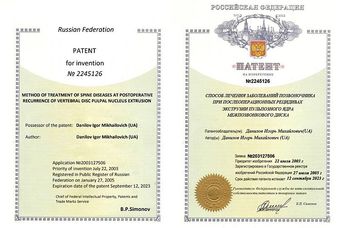
A patent is an example of an intangible asset with a limited life.
A patent is an example of an intangible asset with a limited life.
A U.S. patent currently lasts 20 years. Despite the fact that a patent is connected to a specific type of item, a patent represents a legal right and not a tangible item. A patent is classified as an intangible asset and is listed on a company’s balance sheet.
Valuing a Patent
The value of a patent that a company would record on its books depends on how it acquired the patent. If the business developed the invention internally, all the research and development costs associated with that item would have been listed as an expense as those fees were incurred. Therefore, the initial value of an internally developed patent could be quite low.
If the business purchased the patent from the original holder, the value of the patent equals the acquisition cost.
The value of the patent may be increased if a patent holding company defends its rights to the invention in a lawsuit. If the company uses an outside law firm, all fees the business pays to the firm to defend the patent will be included as part of the patent’s book value.
Amortizing a Patent
Since a patent is only valid for a limited number of years, a business is required to amortize it. The process of amortization requires decreasing the value of the asset annually by an amount equal to the value of the asset divided by the number of years of the patent’s useful life. The useful life of the patent can be no longer than how much time is left on the patent’s term, but should reflect the period that the underlying invention can generate revenue for the business that owns it. Every year the business records a decrease in the patent’s value, it must also record a corresponding amortization expense equal to the decrease.
For example, assume a business acquires a patent that has 15 years left on its term for 1 million dollars. However, the invention the patent secures will only generate revenue for ten years. For the next ten years, the company must decrease the value of the asset by 100,000. To ensure the books are balanced, the business must also record a $100,000 amortization expense for the next ten years.
7.2.4: Goodwill
Goodwill is an intangible asset that equals an acquired company’s purchase price minus the value of its net assets when it was acquired.
Learning Objective
Describe how a company values Goodwill
Key Points
- A company may only record goodwill on its balance sheet in connection to a business or business segment it acquired.
- Goodwill = acquisition price – net assets.
- Goodwill is not amortized, but it can be impaired if the present value of the future revenues of the related business segment are less than the net assets (including goodwill) of the business segment.
Key Terms
- net assets
-
The value of a business’s assets minus the value of its liabilities.
- impair
-
To decrease the value of an intangible asset.
- goodwill
-
Represents the difference between the firm’s total net assets and its market value; the amount is recorded at time of acquisition.
Goodwill
The value of a business is not always defined by what assets it owns and what it owes. A successful business will develop customer loyalty and an overall positive reputation in its community, which will cause its market value to be greater than its book value. A company may also generate a higher value if it proves over time that it can generate superior revenues than its competition through managerial expertise, its reputation within its business sector, and other company attributes.
The difference between the value of a company as reflected in its balance sheet and its market value is known as its goodwill. Accounting goodwill is the excess value of a firm’s net assets and is recorded at time of business acquisition or combination. Goodwill is not associated with a physical object that the business owns, so it is an intangible asset and is listed on a company’s balance sheet. In comparison, economic goodwill refers to company attributes that are hard to quantify, such as brand loyalty, brand recognition, company innovation, and executive talent .

Apple is a successful company with considerable goodwill.
Apple is a successful company with considerable goodwill.
Valuing Goodwill
A company can list goodwill on its balance sheet when it acquires another business at a higher cost than what the assets and liabilities on the acquired company’s balance sheet dictate. In short, goodwill equals the acquisition price minus net assets.
Say a business was purchased for 100 million. Its assets were worth 80 million but it had 30 million in liabilities. The acquired business’ assets would be equal to 50 million, and the acquiring business would record 50 million worth of goodwill on its balance sheet.
However a business may not record goodwill that it generates for itself. Using the same example, assume the business was not acquired, but it was worth 100 million and still had 80 million of assets with 30 million in liabilities. The business would not be able to record the 50 million of goodwill on its own balance sheet. Goodwill can only be recorded when an entire business or an entire section of a business is purchased at a price greater than the value of its assets.
Annual Review of Goodwill
It used to be that goodwill was amortized. This meant that the value of goodwill was decreased annually, with the business recording a loss equal to the amount of the decrease in value. As of 2001, goodwill is no longer amortized.
Every year the value of goodwill must be evaluated by the business that owns it. The company must determine the present value of all of the future revenues of the business segment associated with the goodwill. If the present value of those revenues equal or exceed the value of the business segment’s carrying value, or its total assets (including goodwill) minus assets, the business does not have to make any changes.
If the present value of the future revenues is less than the business segment’s carrying value, the business must impair, or decrease the value, of the goodwill account. Goodwill must be decreased so that the segment’s carrying value equals the present value of its revenues. If the the total value of goodwill is not enough to make up the difference, the goodwill balance must be set to zero. A business cannot have a negative goodwill balance.
Any impairment of goodwill is recognized as a loss for year of the decrease and reported on the income statement.
7.2.5: Franchises and Licenses
Franchises and licenses are intangible assets that legally entitle a business to sell a product or service developed by another entity.
Learning Objective
Explain how a company values a franchise or license
Key Points
- If a franchisee makes periodic payments to the franchisor, it does not record a franchise asset. If the contract requires that a lump sum be paid up front to secure the franchise rights for several years, the franchisee would record a franchise asset on its balance sheet.
- A business only records a license asset on its balance sheet if the term of the license ends after the date of the balance sheet.
- Amortizing only applies if the business records an asset. The amortization rate is calculated by dividing the initial value of the asset by its useful life. Every accounting period, the business decreases the value of the asset by the amortization rate and records an expense equal to the rate.
Key Terms
- license
-
the legal terms under which a person is allowed to use a product
- franchise
-
The authorization granted by a company to sell or distribute its goods or services in a certain area.
- franchisee
-
A holder of a franchise; a person who is granted a franchise.
- franchisor
-
A company which or person who grants franchises.

McDonald’s, Oldham Road, Manchester.
McDonald’s is one well known organization that operates using franchises.
A franchise is a contract that grants a business the right to operate using the name and products of an established brand. A franchisor will develop the brand, produce goods and develop marketing campaigns for its products. A franchisee will then purchase the rights to sell the franchisor’s products in a given area and benefit from the franchisor’s marketing efforts. The franchisor makes money by selling rights to franchisees, while the franchisee profits by selling directly to customers. A common industry that uses franchising is fast food.
A license is similar to a franchise, in that it grants someone the right to legally use someone else’s intellectual property or gooda. This license will contain terms that will define how the purchaser can use the product and whether she can share it. A common example of a license a business might purchase is for software.
Valuing Franchises and Licenses
How a franchise is recorded on a balance sheet depends on the conditions of the contract. If a franchisee makes periodic payments to the franchisor over the contract’s term, the franchisee does not record a franchise asset. Instead, the franchisee records a franchise expense when she pays the franchise fee.
If the contract requires that a lump sum be paid up front to secure the franchise rights for several years, the franchisee would record a franchise asset on its balance sheet. Therefore, the value of the franchise asset equals what it cost to acquire.
The same rules apply to a license. If a business must pay licensing fees on a monthly or on an annual basis that coincides with the end of the business’s fiscal year, the business does not record a license asset. The fees that the business paid for those licenses are included as an expense. If the license is for multiple years or accounting periods and is acquired by paying an initial fee, the license is recorded as an asset on the balance sheet and its value equals what it cost to acquire the license.
Amortizing Franchises and Licenses
Amortizing is a term that only applies if there is a franchise or license asset. Amortization is the process of writing off the cost of an asset over its useful life. Useful life is the amount of time that a business can generate revenues from the asset. For a franchise, the useful life is generally the length of the franchise contract. The useful life of a license is how long it grants the holder the exclusive right to use the underlying product.
The amortization rate is calculated by dividing the initial value of the asset by its useful life. Depending on when the balance sheet is issued, the useful life is presented as a number of months, quarters, or years. Every accounting period, the value of the asset is decreased by the amortization rate. The business also records an expense equal to the amortization rate every accounting period.
7.3: Intangible Asset Impairment
7.3.1: Limited-Life Impairment
Limited-life intangibles are amortized throughout the useful life of the intangible asset using either the units of activity or the straight-line method.
Learning Objective
Summarize how to calculate the impairment on a limited life asset
Key Points
- Limited-life intangibles are intangible assets with a limited useful life, such as copyrights, patents and trademarks.
- Intangible assets are non-monetary assets that cannot be seen, touched or physically measured. Intangible assets are created through time and effort, and are identifiable as separate assets.
- Non-physical or “intangible” assets are amortized to reflect the change in their value due to use, expiration or obsolescence over time.
Key Terms
- asset
-
Items of ownership convertible into cash; total resources of a person or business, as cash, notes and accounts receivable; securities and accounts receivable, securities, inventories, goodwill, fixtures, machinery, or real estate (as opposed to liabilities).
- intangible
-
Incapable of being perceived by the senses; incorporeal.
- amortization
-
The distribution of the cost of an intangible asset, such as an intellectual property right, over the projected useful life of the asset.
- straight-line method of amortization
-
debt paid off with regular, equal sized payments
- straight-line method
-
the company charges the same amount to depreciation each year over that period until the value shown for the asset has reduced from the original cost to the salvage value
Example
- A software company has a patent valued at $10 million with a useful life of 40 years. Due to market conditions, the company believes the patent’s value has decreased and tests it for impairment at the end of the year. Year end calculations reveal the patent is valued at $8 million and an impairment loss of $2 million is recorded as a debit to Loss on Patent Impairment on the income statement and a credit to Accumulated Impairment Losses on the balance sheet (disclosed as a contra asset account to the intangible asset). As a result of the impairment, the amortization expense on the patent should be adjusted to reflect the new value.
Limited-Life Impairment
Intangible assets are non-monetary assets that cannot be seen, touched, or physically measured. Intangible assets are created through time and effort, and are identifiable as separate assets. They are classified into categories: either purchased vs. internally created intangible assets; and limited-life or indefinite-life intangible assets.
The two primary forms of intangibles are legal intangibles, which includes trade secrets, copyrights, patents, and trademarks (also referred to as Intellectual Property) and competitive intangibles, which includes knowledge activities, collaboration activities, leverage activities, and structural activities. Limited-life intangibles are intangible assets with a limited useful life, such as copyrights, patents and trademarks
Intangible assets are amortized to reflect their consumption, expiry, obsolescence or other decline in value as a result of use or the passage of time, process which is similar to the deprecation process for tangible assets. Intangible assets can have either a limited or an indefinite useful life. Intangible assets with a limited-life are amortized on a straight-line basis over their economic or legal life, based on whichever is shorter. Examples of intangible assets with a limited-life include copyrights and patents. Only intangible assets with an indefinite life are reassessed each year for impairment.
Limited-life intangibles are systemically amortized throughout the useful life of the intangible asset using either units of activity method or straight-line method. The amortization amount is equal to the difference between the intangible asset cost and the asset residual value. That calculated amount is credited to either the appropriate intangible asset account or accumulated amortization account .
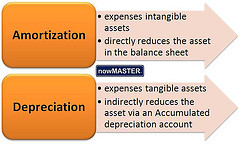
Amortization & depreciation in the accounting cycle
A bond’s discount amount must be amortized over the term of the bond.
Reversal of Impairment Loss
When an intangible asset’s impairment reverses and value is regained, the increase in value is recorded as a gain on the income statement and reduction to accumulated impairment loss on the balance sheet, up to the amount of impairment loss recorded in prior periods. Increases in value in excess of prior impairment loss are debited directly to the asset and credited to a revaluation reserve account in the equity section of the balance sheet. Asset amortization for future periods should be adjusted due to the increase in value.
7.3.2: Indefinite-Life Impairment
Because Indefinite-life tangibles continue to generate cash they can’t be amortized; they must be evaluated for impairment yearly.
Learning Objective
Summarize how to impair indefinite life intangibles
Key Points
- Examples of Indefinite-life intangibles are goodwill, trademarks, and perpetual franchises.
- Instead of amortization, indefinite-life assets are evaluated for impairment yearly.
- The Impairment cost is calculated as: Carrying value – Recoverable amount.
Key Terms
- intangible
-
Incapable of being perceived by the senses; incorporeal.
- impairment
-
When the carrying value exceeds the fair value.
- Indefinite
-
Without limit; forever, or until further notice; not definite
Example
- A software company has a trademark valued at $10 million with an indefinite useful life. Due to market conditions, the company believes the trademark’s value has decreased and tests it for impairment at the end of the year. Year end calculations reveal the trademark is valued at $8 million and an impairment loss of $2 million is recorded as a debit to Loss on Trademark Impairment on the income statement and a credit to Accumulated Impairment Losses on the balance sheet (disclosed as a contra asset account to the intangible asset).
Indefinite-Life Impairment
In accounting, intangible assets are defined as non-monetary assets that cannot be seen, touched or physically measured.
Under US GAAP, intangible assets are classified into: Purchased vs. internally created intangibles, and Limited-life vs. indefinite-life intangibles.
Since intangible assets are typically expensed according to their respective life expectancy, it is important to understand the difference between limited-life intangible assets and indefinite-life intangible assets. Intangible assets with identifiable useful lives (limited-life) include copyrights and patents. These items are amortized on a straight-line basis over their economic or legal life, whichever is shorter.
Some examples of indefinite-life intangibles are goodwill, trademarks, and perpetual franchises. Indefinite-life tangibles are not amortized because there is no foreseeable limit to the cash flows generated by those intangible assets. Instead of amortization, indefinite-life assets are evaluated for impairment yearly. If an impairment has occurred, then a loss must be recognized.
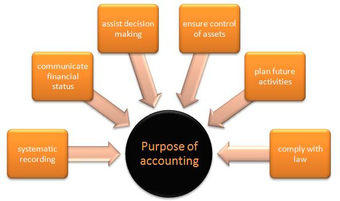
The purpose of the accounting cycle
Properly reporting items is important to the accounting cycle.
An Impairment cost must be included under expenses when the carrying value of a non-current asset exceeds the recoverable amount. The Impairment cost is calculated as:
Carrying value – Recoverable amount
The carrying amount is defined as the value of the asset as displayed on the balance sheet. The recoverable amount is the higher of either the asset’s future value for the company or the amount it can be sold for, minus any transaction cost.
Intangibles can also be classified as: legal intangibles or competitive intangibles. Legal intangibles are also known as Intellectual Property. They include trade secrets, copyrights, patents, and trademarks. Competitive intangibles comprise knowledge activities, know-how, collaboration activities, leverage activities, and structural activities.
Reversal of Impairment Loss
When an intangible asset’s impairment reverses and value is regained, the increase in value is recorded as a gain on the income statement and reduction to accumulated impairment loss on the balance sheet, up to the amount of impairment loss recorded in prior periods. Increases in value in excess of prior impairment loss is debited directly to the asset and credited to a revaluation reserve account in the equity section of the balance sheet. According to IAS 36, reversal of impairment losses for goodwill are not allowed.
7.3.3: Goodwill Impairment
Goodwill is an intangible asset that is tested yearly for impairment; it is not amortized.
Learning Objective
Explain how to calculate impairment on goodwill
Key Points
- Goodwill is the value of an asset that is considered intangible but has a quantifiable “prudent value” in a business.
- A firm’s reputation with its clients is an example of goodwill.
- If the fair value is less than carrying value (impaired), the goodwill value will need to be reduced so that the fair value is equal to the carrying value.
Key Terms
- impairment
-
When the carrying value exceeds the fair value.
- asset
-
Items of ownership convertible into cash; total resources of a person or business, as cash, notes and accounts receivable; securities and accounts receivable, securities, inventories, goodwill, fixtures, machinery, or real estate (as opposed to liabilities).
- goodwill
-
The value of an asset that is considered intangible but has a quantifiable “value” in a business. For example, a reputation the firm enjoys with its clients.
Example
- A software company has net assets valued at $1 million, but the company’s overall value (including brand, customers, intellectual capital) is valued at $10 million. Upon purchase, the buyer records $9 million in goodwill and tests it for impairment at the end of the year. Year end calculations reveal the goodwill is valued at $8 million and an impairment loss of $1 million is recorded as a debit to Loss on Goodwill Impairment on the income statement and a credit to Accumulated Impairment Losses on the balance sheet (disclosed as a contra asset account to goodwill).
Business Goodwill
In accounting, goodwill is the value of an asset that is considered intangible but has a quantifiable “prudent value” in a business. For example, goodwill could be the reputation the firm enjoys with its clients. While goodwill is technically an intangible asset, it is usually listed as a separate item on a company’s balance sheet .
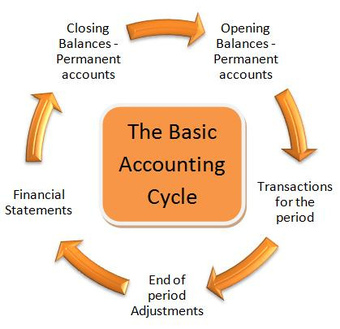
The Accounting Cycle
Correctly reporting intangible assets is important to the accounting cycle.
Accounting for Goodwill
Instead of deducting the value of goodwill annually over a period of maximal 40 years ( amortization ), companies are now required to determine the fair value of the reporting units, using the present value of future cash flow , and compare it to their carrying value (book value of assets + goodwill – liabilities. ).
If the fair value is less than carrying value (impaired), the goodwill value will need to be reduced so that the fair value is equal to carrying value. The impairment loss is reported as a separate line item on the income statement, and new adjusted value of goodwill is reported in the balance sheet.
Impairment of Goodwill
If there is an indication that the book value of goodwill is greater than the recoverable value of net assets, an assessment of the recoverable value is made, and if the suspicion is correct, then an impairment expense is recorded. Goodwill’s value on the balance sheet is reported at net of accumulated impairment loss, a contra asset account; the current impairment loss is reported on the income statement.
An impairment cost must be included under expenses when the carrying value of a non-current asset on the balance sheet exceeds the asset’s market value subtracted by any transaction costs (recoverable amount). The impairment cost is calculated as follows: carrying value – recoverable amount.
The carrying amount is defined as the value of the asset as it is displayed on the balance sheet. The recoverable amount is the higher of either the asset’s future value for the company or the amount it can be sold for, minus any transaction cost.
According IAS 36, reversal of goodwill impairment losses are not allowed.
7.4: Research & Development Cost
7.4.1: What Is R&D?
The primary function of R&D is to develop new products or discover and create new knowledge about scientific and technological topics.
Learning Objective
Summarize research and developments role within a corporation
Key Points
- The primary function of R&D is to develop new products or discover and create new knowledge about scientific and technological topics for the purpose of uncovering and enabling development of valuable new products, processes, and services.
- New product design and development is more often than not a crucial factor in the survival of a company. In an industry that is changing fast, firms must continually revise their design and range of products.
- In the U.S., a typical ratio of research and development for an industrial company is about 3.5% of revenues. A high technology company such as a computer manufacturer might spend 7%.
Key Terms
- research
-
Diligent inquiry or examination to seek or revise facts, principles, theories, and applications; laborious or continued search after truth.
- ROI
-
The return on investment (ROI) is the ratio of money gained or lost (whether realized or unrealized) on an investment relative to the amount of money invested.
- development
-
The process of developing; growth, directed change.
Example
- In the U.S., a typical ratio of research and development for an industrial company is about 3.5% of revenues. A high technology company such as a computer manufacturer might spend 7%. Although Allergan (a biotech company) tops the spending table with 43.4% investment, anything over 15% is remarkable and usually gains a reputation for being a high technology company. Companies in this category include pharmaceutical companies such as Merck & Co. (14.1%) or Novartis (15.1%), and engineering companies like Ericsson (24.9%). Such companies are often seen as credit risks because their spending ratios are so unusual.
What is R&D?
The term R&D or research and development refers to a specific group of activities within a business. The activities that are classified as R&D differ from company to company, but there are two primary models. In one model, the primary function of an R&D group is to develop new products; in the other model, the primary function of an R&D group is to discover and create new knowledge about scientific and technological topics for the purpose of uncovering and enabling development of valuable new products, processes, and services. Under both models, R&D differs from the vast majority of a company’s activities which are intended to yield nearly immediate profits or immediate improvements in operations and involve little uncertainty as to the return on investment (ROI). The first model of R&D is generally staffed by engineers while the second model may be staffed with industrial scientists. R&D activities are carried out by corporate and governmental entities.

A worker makes final checks
This is an example of R&D in action.
R&D’s Role
New product design and development is more often than not a crucial factor in the survival of a company. In an industry that is changing fast, firms must continually revise their design and range of products. This is necessary due to continuous technological change and development as well as other competitors and the changing preference of customers. Without an R&D program, a firm must rely on strategic alliances, acquisitions, and networks to tap into the innovations of others.

Microscopy lab
Research being carried out at the Microscopy lab of the Idaho National Laboratory.
In the U.S., a typical ratio of research and development for an industrial company is about 3.5% of revenues. A high technology company such as a computer manufacturer might spend 7%. Although Allergan (a biotech company) tops the spending table with 43.4% investment, anything over 15% is remarkable and usually gains a reputation for being a high technology company. Companies in this category include pharmaceutical companies such as Merck & Co. (14.1%) or Novartis (15.1%), and engineering companies like Ericsson (24.9%). Such companies are often seen as credit risks because their spending ratios are so unusual.
Generally such firms prosper only in markets whose customers have extreme needs, such as medicine, scientific instruments, safety-critical mechanisms (aircraft), or high technology military armaments. The extreme needs justify the high risk of failure and consequently high gross margins from 60% to 90% of revenues. Gross profits will be as much as 90% of the sales cost, with manufacturing costing only 10% of the product price, because so many individual projects yield no exploitable product. Most industrial companies get only 40% of revenues.
History of R&D
Research and development costs are costs incurred in a planned search for new knowledge and in translating such knowledge into new products or processes. Prior to 1975, businesses often capitalized research and development costs as intangible assets when future benefits were expected from their incurrence. Due to the difficulty of determining the costs applicable to future benefits, many companies expensed all such costs as incurred. Other companies capitalized those costs that related to proven products and expensed the rest as incurred.
As a result of these varied accounting practices, in 1974 the Financial Accounting Standards Board in Statement No. 2 ruled that firms must expense all research and development costs when incurred, unless they were directly reimbursable by government agencies and others. Immediate expensing is justified on the grounds that (1) the amount of costs applicable to the future cannot be measured with any high degree of precision; (2) doubt exists as to whether any future benefits will be received; and (3) even if benefits are expected, they cannot be measured. Thus, research and development costs no longer appear as intangible assets on the balance sheet. The Board applies the same line of reasoning to other costs associated with internally generated intangible assets, such as the internal costs of developing a patent.
7.4.2: Accounting for R&D Activity
Research and development costs no longer appear as intangible assets on the balance sheet, but as expenses on the income statement.
Key Points
- Research and development costs no longer appear as intangible assets on the balance sheet. The Board applies the same line of reasoning to other costs associated with internally generated intangible assets, such as the internal costs of developing a patent.
- Immediate expensing is justified on the following grounds: the amount of costs applicable to the future cannot be measured with any high degree of precision, doubt exists as to whether any future benefits will be received, and even if benefits are expected, they cannot be measured.
- In the U.S., a typical ratio of research and development for an industrial company is about 3.5% of revenues. A high technology company such as a computer manufacturer might spend 7%.
Key Terms
- research
-
Diligent inquiry or examination to seek or revise facts, principles, theories, and applications; laborious or continued search after truth.
- intangible
-
Incapable of being perceived by the senses; incorporeal.
- incur
-
To render somebody liable or subject to.
Accounting for Research and Development Activity
In general, research and development (R&D) activities are conducted by specialized units or centers belonging to a company, or can be outsourced to contract research organizations, universities, or state agencies . In the context of commerce, research and development normally refers to future-oriented, long-term activities in science or technology, using similar techniques to scientific research but directed toward desired outcomes and with broad forecasts of commercial yield.
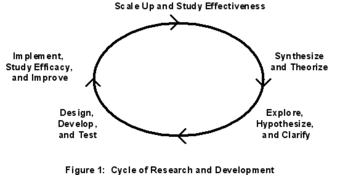
Cycle of Research and Development
Cycle of Research and Development, from “Research and Evaluation on Education in Science and Engineering (REESE), Program Solicitation NSF 09-601”
In the United States, a typical ratio of research and development for an industrial company is about 3.5% of revenues. A high technology company such as a computer manufacturer might spend 7%. Although Allergan (a biotech company) tops the spending table with 43.4% investment, anything over 15% is remarkable and usually gains a reputation for being a high technology company. Companies in this category include pharmaceutical companies such as Merck & Co. (14.1%) or Novartis (15.1%), and engineering companies like Ericsson (24.9%). Such companies are often seen as credit risks because their spending ratios are so unusual.
Research and development costs are the costs incurred in a planned search for new knowledge and in translating such knowledge into new products or processes. Prior to 1975, businesses often capitalized research and development costs as intangible assets when future benefits were expected from their incurrence. Due to the difficulty of determining the costs applicable to future benefits, many companies expensed all such costs as incurred. Other companies capitalized those costs that related to proven products and expensed the rest as incurred.
As a result of these varied accounting practices, in 1974 the Financial Accounting Standards Board in Statement No. 2 ruled that firms must expense all research and development costs when incurred, unless they were directly reimbursable by government agencies and others. Immediate expensing is justified on the following grounds:
- The amount of costs applicable to the future cannot be measured with any high degree of precision
- Doubt exists as to whether any future benefits will be received
- Even if benefits are expected, they cannot be measured
Research and development costs thus no longer appear as intangible assets on the balance sheet. The Board applies the same line of reasoning to other costs associated with internally generated intangible assets, such as the internal costs of developing a patent.
R&D As an Administrative cost
Administrative costs are non-manufacturing costs that include the costs of top administrative functions and various staff departments such as accounting, data processing, and personnel. Executive salaries, clerical salaries, office expenses, office rent, donations, research and development costs, and legal costs are also administrative costs. As with selling costs, all organizations have administrative costs.
7.5: Reporting and Analyzing Intangibles
7.5.1: Reporting Intangibles
Intangible assets are either recorded at cost or expensed as they are created.
Learning Objective
Explain how to value an intangible asset for reporting purposes
Key Points
- The most common types of intangibles are patents, copyrights, franchises or licenses, trademarks or trade names, and goodwill.
- In most cases, intangible assets provide services over a period of years.
- Intangibles purchased from another party are recorded at cost.
- The cost of created intangibles is generally expensed as incurred.
- Intangible assets derive their value from the rights and privileges granted to the company using them.
Key Terms
- Capitalized
-
To capitalize is to treat costs as capital not an expense. The capital expenditure costs are then amortized or depreciated over the life of the asset.
- Intangibles
-
Things that are recognized but not easily quantified.
Intangibles
Intangible assets lack physical existence. Unlike tangible assets such as property, plant, and equipment, intangible assets derive their value from the rights and privileges granted to the company using them.
They are not financial instruments. Assets such as bank deposits, accounts receivable, and long-term investments in bonds and stocks lack physical substance, but are not classified as intangible assets. These assets are financial instruments and derive their value from the right or claim to receive cash or cash equivalents in the future.
In most cases, intangible assets provide services over a period of years. As a result, they are normally classified as long-term assets. The most common types of intangibles are patents, copyrights, franchises or licenses, trademarks or trade names, and goodwill.
Valuation and Accounting
Intangibles purchased from another party are recorded at cost . Cost includes all costs of acquisition and expenditures necessary to make the intangible asset ready for its intended use—for example, purchase price, legal fees, and other incidental expenses.

Reporting Intangibles
Valuation and Accounting
If intangibles are acquired for stock or in exchange for other assets, the cost of the intangible is the fair value of the consideration given or the fair value of the intangible received, whichever is more clearly evident.
The accounting treatment for purchased intangibles closely parallels that followed for purchased tangible assets. The cost of created intangibles is generally expensed as incurred. Therefore, even though a company may incur substantial research and development costs to create an intangible, these costs are expensed.
Various reasons are given for this approach. Some argue that the costs incurred internally to create intangibles bear no relationship to their real value. Therefore, expensing these costs is appropriate. Others note that with a purchased intangible, a reliable number for the cost of the intangible can be determined. With internally developed intangibles, it is difficult to associate costs with specific intangible assets. And others argue that due to the underlying subjectivity related to intangibles, a conservative approach should be followed—that is, expense as incurred.
The accounting for intangible assets depends on whether the intangible has a limited or an indefinite life. The costs of acquiring and defending a copyright may be capitalized, but the research and development costs involved must be expensed as incurred. Generally, the useful life of the copyright is less than its legal life. The costs of the copyright should be allocated to the years in which the benefits are expected to be received. The difficulty of determining the number of years over which benefits will be received normally encourages the company to write these costs off over a fairly short period of time.
7.5.2: Reporting R&D Cost
Expense R&D, unless items have alternative future uses, then allocate as consumed, or capitalize and depreciate as used.
Learning Objective
Summarize how to report research and development costs on the financials statements
Key Points
- R&D costs may be expensed. A cost which cannot be deducted in the year in which it is paid or incurred must be capitalized.
- If the acquired property’s useful life is longer than the taxable year, then the cost must be capitalized. The capital expenditure costs are then amortized or depreciated over the life of the asset.
- Choice of the appropriate accounting treatment should be guided by the degree of certainty of future benefits and the principle of matching revenues and expenses.
Key Terms
- development
-
Development is the application of research findings to a plan or design for the production of new or substantially improved materials, devices, products, processes, systems, or services, before the start of commercial production or use.
- research
-
Research is original and planned investigation undertaken with the prospect of gaining new scientific or technical knowledge and understanding.
Research and Development Defined
Research is original and planned investigation undertaken with the prospect of gaining new scientific or technical knowledge and understanding.
Development is the application of research findings to a plan or design for the production of new or substantially improved materials, devices, products, processes, systems, or services, before the start of commercial production or use.
Reporting R&D Costs
R&D costs may be expensed. A cost which cannot be deducted in the year in which it is paid or incurred must be capitalized. The general rule is that if the acquired property’s useful life is longer than the taxable year, then the cost must be capitalized. The capital expenditure costs are then amortized or depreciated over the life of the asset. Choice of the appropriate accounting treatment for such costs should be guided by the degree of certainty of future benefits and the principle of matching revenues and expenses.
Some companies conduct R&D activities for other entities under a contractual arrangement. In this case, the contract usually specifies that all direct costs, certain specific indirect costs, plus a profit element, should be reimbursed to the enterprise performing the R&D work. Because reimbursement is expected, such R&D costs should be recorded as a receivable. It is the company for whom the work has been performed that reports these costs as R&D and expenses them as incurred.
It should be emphasized that R&D activities do not include routine or periodic alternatives to existing products, production lines, manufacturing processes, and other ongoing operations even though these alterations may represent improvements. For example, routine ongoing efforts to refine, enrich, or improve the qualities of an existing product are not considered R&D activities.
Reporting R&D Activities
The costs associated with R&D activities and the accounting treatment accorded them are as follows: expense the entire costs, unless the items have alternative future uses (in other R&D projects or otherwise), then carry as inventory and allocate as consumed, or capitalize and depreciate as used.
7.5.3: Analyzing Intangible Assets
Intangibles with identifiable useful lives are amortized on a straight-line basis over their economic or legal life, whichever is shorter.
Learning Objective
Explain how to report intangible assets on the financial statements
Key Points
- Intangible assets are typically expensed according to their respective life expectancy. Intangible assets have either an identifiable or indefinite useful life.
- Examples of intangible assets with identifiable useful lives include copyrights and patents.
- Intangible assets with indefinite useful lives are reassessed each year for impairment. If an impairment has occurred, then a loss must be recognized.
- Some costs with respect to intangible assets must be capitalized rather than treated as deductible expenses.
Key Terms
- Amortized
-
Refers to expensing the acquisition cost in a systematic manner over economic or legal lives so as to reflect their consumption, expiry, obsolescence or other decline in value as a result of use or the passage of time.
- goodwill
-
The value of an asset that is considered intangible but has a quantifiable “value” in a business. For example, a reputation the firm enjoys with its clients.
- impairment
-
When the carrying value exceeds the fair value.
Analyzing Intangible Assets
Intangible assets are defined as identifiable non-monetary assets that cannot be seen, touched or physically measured. Intangible assets are created through time and effort, and are identifiable as a separate asset .

Analyzing Intangibles
How to Analyze Intangible Assets
Intangible assets are typically expensed according to their respective life expectancy. Intangible assets have either an identifiable or indefinite useful life. Those with identifiable useful lives are amortized on a straight-line basis over their economic or legal life, whichever one is shorter. Examples of intangible assets with identifiable useful lives include copyrights and patents.
Intangible assets with indefinite useful lives are reassessed each year for impairment. If an impairment has occurred, then a loss must be recognized. An impairment loss is determined by subtracting the asset’s fair value from the asset’s book or carrying value. Trademarks and goodwill are examples of intangible assets with indefinite useful lives. Goodwill has to be tested for impairment rather than amortized. If impaired, goodwill is reduced and loss is recognized in the Income statement.
Capitalization
Some costs with respect to intangible assets must be capitalized rather than treated as deductible expenses. Treasury regulations generally require capitalization of costs associated with acquiring, creating, or enhancing intangible assets. For example, an amount paid to obtain a trademark must be capitalized. Certain amounts paid to facilitate these transactions are also capitalized. Some types of intangible assets are categorized based on whether the asset is acquired from another party or created by the taxpayer. The regulations contain many provisions intended to make it easier to determine when capitalization is required.
Research and Development
Research and development (R&D) costs are not in and of themselves intangible assets. R&D activities frequently result in the development of something that is patented or copyrighted (such as a new product, process, idea, formula, composition, or literary work). Many businesses spend considerable sums of money on research and development to create new products or processes, improve present products, and discover new knowledge that may be valuable.
Chapter 6: Controlling and Reporting of Real Assets: Property, Plant, Equipment, and Natural Resources
6.1: Introduction to Long-Lived Assets
6.1.1: Defining Long-Lived Assets
Long-lived assets are those that provide a company with a future economic benefit beyond the current year or operating period.
Learning Objective
Differentiate between an asset and a long-lived asset
Key Points
- Long term assets are used over multiple operating cycles.
- Assets are economic resources. Anything tangible or intangible that is capable of being owned or controlled to produce value and that is held to have positive economic value is considered an asset.
- Since non-current, or long-lived, assets are expected to last for longer than one year, accounting treats long-lived assets differently according to their useful life.
Key Terms
- economic entity assumption
-
the business is a separate and distinct from its owner(s)
- Assets
-
A resource with economic value that an individual, corporation, or country owns or controls with the expectation that it will provide future benefit.
Assets
Assets are economic resources. It is anything tangible or intangible that is capable of being owned or controlled to produce value and that is held to have positive economic value is considered an asset. Simply stated, assets represent value of ownership that can be converted into cash.
Asset Characteristics
- Assets represent probable present benefit, involving a capacity, solely, or in combination with other assets, to contribute directly or indirectly to future net cash flows, and, in the case of not-for-profit organizations, to provide services;
- The entity can control access to the benefit;
- The transaction or event giving rise to the entity’s right to, or control of, the benefit has already occurred .
Interestingly enough, employees are not considered to be assets, like machinery is, even though they are capable of generating future economic benefits. This is because an entity does not have sufficient control over its employees to satisfy the definition of an asset.
Long-Lived Assets
Long-lived assets provide a company with a future economic benefit beyond the current year or operating period. It may be helpful to remember that most, but not all, long-lived assets start as some sort of purchase by the company. Since non-current, or long-lived, assets are expected to last for longer than one year, accounting treats long-lived assets differently according to their useful life.
All assets are resources controlled by the enterprise as a result of past events and from which future economic benefits are expected to flow to the enterprise. When assets are expected to contribute to earnings for multiple years, such assets are referred to as long-lived, non-current or long-term assets. In general terms, it is “long-lived” because it is going to be around for some time and not quickly consumed.
6.1.2: Types of Long-Lived Assets
The two major asset classes are tangible assets (e.g., buildings and equipment) and intangible assets (e.g. copy rights).
Learning Objective
Differentiate between intangible and tangible assets
Key Points
- Accounting principles determine which assets can be recognized and which cannot; regulation is most restrictive on capitalizing intangible assets that are self-developed (such as brand names).
- Capital expenditures are incurred when a business spends money either to buy fixed assets or to add to the value of an existing fixed asset with a useful life extending beyond the taxable year.
- If an asset can be recognized, the items that are spent to get the asset “up and running” are allowed to be capitalized..
Key Term
- Capital Expenditures
-
A capital expenditure is incurred when a business spends money either to buy fixed assets or to add to the value of an existing fixed asset with a useful life extending beyond the taxable year.
Asset Classes
There are two major types of long-term assets: tangible and non-tangible. Tangible assets include fixed assets, such as buildings and equipment. Intangible assets includes non-physical resources and rights that a firm deems useful in securing an advantage in the marketplace. Examples of intangible assets are copyrights, trademarks, patents and computer programs, financial assets– including such items as accounts receivable, bonds and stocks– and goodwill.
Long-term Investments
Long-term investments are often referred to simply as “investments. ” Long-term investments are meant to be held for many years and are not intended to be disposed of in the near future. They usually consist of three possible types of investments: investments in securities (such as bonds), common stock, or long-term notes. Other types of investments include investments in special funds– e.g. sinking funds or pension funds– and different forms of insurance.
Fixed Assets
Fixed assets– also referred to as property, plant, and equipment– are purchased for continued and long-term use in generating profit for a business. Fixed assets include asset land, buildings, machinery, furniture, tools, IT equipment– e.g. laptops– and certain limited resources– e.g. timberland and minerals. Most of these, with the exception of land assets, are written off against profits over their anticipated life by accumulating depreciation expenses.
Property, Plant and Equipment
Property, plant, and equipment are tangible, long-lived assets used in the operations of the business. Land, natural resources, buildings, furniture, equipment, and machinery are included in this category. They are listed under the asset portion of the balance sheet.
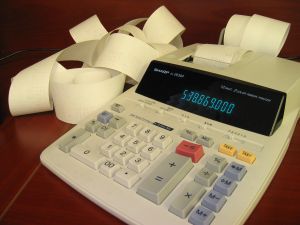
Asset Classes
Capital expenditures are incurred to get the asset “up and running”.
6.1.3: Accounting Perspectives on Long-Lived Assets
All money that is spent to get the asset up and running is capitalized as part as the cost of the asset.
Learning Objective
Distinguish between the capitalized and expensed costs of an asset
Key Points
- Figuring the cost of an item takes into consideration more than just the purchase price.
- Examples that are excluded from the asset are expense, rather than capital costs.
- If accounting principles allow recognition of an asset, the next issue is which items can be included, and which items need to be expensed.
Key Term
- Capital Costs
-
Capital costs are fixed, one-time expenses incurred on the purchase of land, buildings, construction, and equipment used in the production of goods or in the rendering of services. Put simply, it is the total cost needed to bring a project to a commercially operable status.
Asset Recognition
If accounting principles allow recognition of an asset, the next issue concerns which items can be included and which items need to be expensed. The basic rule here is that—when recognizing the asset is allowed—all money that is spent to get the asset up and running is capitalized as part as the cost of the asset.

Asset Recognition
Items spent to get the asset up and running is capitalized as part as the cost of the asset.
Capital Costs
Items that can be capitalized when the firm purchases a machine include the machine itself, transportation, getting the machine in place, fees paid for having the machine installed and tested, the cost of a trial run, and alike. If the firm’s own personnel are involved with installing the machine, their wage expenses can be allocated to the machine as well.
Examples that are excluded from the asset, and consequently are expense rather than capital costs, include the training of personnel to learn how to use the machine, unexpected damages while installing the machine, or the drinks and snacks to celebrate the machine’s successful launch.
Figuring the cost of an item takes into consideration more than just the purchase price. Added to that would be any taxes paid, less any discounts received, cost of transportation that a company pays to bring the item to where it needs to go, and the cost of getting it ready for use.
So, for example, the cost of land would include any attorney fees, real estate fees, title fees, back taxes that need to be paid, and the cost of preparation for the lands intended use.
Buildings also have additional costs such as legal fees and remodeling fees to prepare it for use. The same goes for natural resources. Basically any costs that are necessary to get an item or land ready to use for business is included in the cost of the item.
6.2: Components of Asset Cost
6.2.1: Cost of Land
Land is recognized at its historical cost or purchase price, and can include any other related initial costs spent to put the land into use.
Learning Objective
Describe how land is reported on the financial statements
Key Points
- Land is defined as the ground the company uses for business operations; it includes ground on which the company locates its headquarters or land used for outside storage space or as a parking lot.
- Unlike a majority of fixed assets, land is not subject to depreciation.
- Land is listed on the balance sheet under the section for non-current assets. Increases in market value are disregarded on the balance sheet.
- At time of sale, the difference between a land’s market value and historical cost is recognized as a gain or loss on the income statement.
Key Terms
- balance sheet
-
A balance sheet is often described as a “snapshot of a company’s financial condition. ” A standard company balance sheet has three parts: assets, liabilities, and ownership equity.
- income statement
-
Displays the revenues recognized for a specific period and the cost and expenses charged against these revenues, including write-offs (e.g., depreciation and amortization of various assets) and taxes. The purpose of the income statement is to show managers and investors whether the company made or lost money during the reporting period.
Land and Historical Cost
Land is defined as the ground occupied by a business’ operations. This can include a company’s headquarters, outside storage space or the company’s parking lot.
Land is recognized at its historical cost, or the cost paid to purchase the land, along with any other related initial costs spent to put the land into use.
Land is a type of fixed asset, but unlike a majority of fixed assets, it is not subject to depreciation.

The cost of land is based on its acquisition price.
All costs associated with acquiring land and putting it to use are included in the cost of land.
Land on the Balance Sheet
Land is listed on the balance sheet under the section for long-term or non-current assets. If the land’s market value increases over time, its value on the balance sheet remains at historical cost.
For example, land purchased in 1988 for $90,000, would still appear on the December 31, 2010 balance sheet at $90,000, even though its market value is now $300,000. This is based on the assumption that land is acquired for business use and not as an asset held for sale.
Sale of Land
If at a future date the land is sold due to a business relocation or other reason, the difference between the land’s market value and its historical cost will result in a gain or loss disclosed on the income statement. If the sale of land results in a gain, the additional cash or value received in excess of historical cost will increase net income for the period. If the sale results in a loss and the business receives less than the land’s historical cost, the loss will reduce net income for the period.
6.2.2: Cost of Buildings
The cost of a building is its original purchase price or historical cost and includes any other related initial costs.
Learning Objective
Summarize how a company would calculate the cost of a building
Key Points
- Buildings are listed at historical cost on the balance sheet as a long-term or non-current asset.
- Buildings are subject to depreciation or the periodic reduction of value in the asset that is expensed on the income statement and reduces net income.
- Since buildings are subject to depreciation, their cost is adjusted by accumulated depreciation to arrive at their net carrying value on the balance sheet.
- If at a future date a building is sold, any gain or loss on the sale is based on the difference between the building’s net carrying value and the market sales price.
Key Term
- Accumulated Depreciation
-
Accumulated depreciation is known as a contra account, because it separately shows a negative amount that is directly associated with another account.
Buildings and Historical Cost
A building is an asset used for commercial purposes and includes office buildings, warehouses, or retail establishments (i.e., convenience stores, “big box” stores, shopping malls, etc.). The cost of a building is its original purchase price or historical cost and includes any other related initial costs spent to put it into use. Similar to land, buildings are also a type of fixed asset purchased for continued and long-term use in earning profit for a business. Unlike land, buildings are subject to depreciation or the periodic reduction of value in the asset that is expensed on the income statement and reduces income. They also can incur substantial maintenance costs, which are expensed on the income statement and reduce an accounting period’s income.

The cost of a building can include construction costs and other costs incurred to put the building into use.
Delays in construction can effect the total cost of a building.
Buildings on the Balance Sheet
Buildings are listed at historical cost on the balance sheet as a long-term or non-current asset, since this type of asset is held for business use and is not easily converted into cash. Since buildings are subject to depreciation, their cost is adjusted by accumulated depreciation to arrive at their net carrying value on the balance sheet. For example, on Acme Company’s balance sheet, their office building is reported at a cost of $150,000, with accumulated depreciation of $40,000. The building’s net carrying value or net book value, on the balance sheet is $110,000.
Sale of Buildings
If at a future date a building is sold due to a business relocation or other reason, any gain or loss on the sale is based on the difference between the building’s net book value and the market sales price. If the sale results in a gain, the excess received over the building’s net book value is disclosed on the income statement as an increase to the accounting period’s income. If the sale results in a loss and the business receives less than book value, the loss is also disclosed on the income statement as a decrease to income.
6.2.3: Cost of Equipment
The cost of equipment is the item’s purchase price, or historical cost, plus other initial costs related to acquisition and asset use.
Learning Objective
Describe how a company calculates the cost of a piece of equipment
Key Points
- Fixed assets are long term items such as property plant or equipment.
- Equipment is listed on the balance sheet at its historical cost amount, which is reduced by accumulated depreciation to arrive at a net carrying value or net book value.
- Selling equipment triggers a gain or a loss, depending on the difference between the equipment’s net book value and its sale price.
Key Terms
- property, plant, and equipment
-
an accounting term for certain fixed assets and property which will be used for a long period of time, such as land, machinery, and factories
- International Accounting Standard
-
accounting rules that are a part of IFRS (International Financial Reporting Standards), a common global language for business affairs so that company accounts are understandable and comparable across international boundaries.
- book value
-
the value is based on the original cost of the asset less any depreciation, amortization or Impairment costs made against the asset.
Equipment and Historical Cost
Fixed assets, also known as non-current or tangible assets, include property, plant, and equipment. Fixed assets, according to International Accounting Standard (IAS) 16, are long range assets whose cost can be measured reliably.
The equipment’s cost is calculated by adding the item’s purchase price, or historical cost, to the other costs related to acquiring the asset. These additional costs can include import duties and deductible trade discounts and rebates.
Historical cost also includes delivery and installation of the asset, as well as the dismantling and removal of the asset when it is no longer in service. Equipment is subject to depreciation. Depreciation is a periodic reduction in an asset’s value. It is disclosed on the income statement and appears as a contra-asset account on the balance sheet.

The cost of equipment includes all costs paid to put the asset into use.
Equipment is listed in a separate section within the balance sheet.
Equipment and the Balance Sheet
Since accounting standards state that an asset should be carried at the net book value, equipment is listed on the balance sheet at its historical cost amount. The cost is then reduced by accumulated depreciation to arrive at a net carrying value or net book value. A company is free to decide what depreciation method to use on the equipment.
Sale of Equipment
When an equipment is sold, the sale of the asset can trigger a gain or a loss, depending on the difference between the equipment’s net book value and its sale price. As with other assets, gain or losses on sales of equipment are disclosed on the income statement as a reduction or addition to income for the period.
6.2.4: Cost of Improvements
The cost of an asset improvement is capitalized and added to the asset’s historical cost on the balance sheet.
Learning Objective
Describe how a company would account for costs associated with improving an asset
Key Points
- Asset improvements are undertaken to enhance or improve a business asset that is in use.
- Since the cost of the improvement is capitalized, the asset’s periodic depreciation expense will be affected (increased).
- If the asset improvement is financed, the interest cost associated with the improvement should not be capitalized as an addition to the asset’s historical cost.
- Depending on the nature of the improvement, it also is possible that the asset’s useful life and salvage value may change as a result of the enhancements.
- Note the difference between an improvement (capitalized) and a maintenance charge (expensed) from a reporting perspective.
Key Terms
- cost principle
-
assets should always be recorded at their purchase price
- capital improvements
-
Activities directed towards expanding the capacity of an asset or otherwise upgrading it to serve needs different from, or significantly greater than, its current use.
- historical cost
-
The original monetary value of an economic item and based on the stable measuring unit assumption. Improvements may be added to an asset’s cost.
Capitalization of Asset Improvements
Asset or capital improvements are undertaken to enhance or improve a business asset that is in use. The cost of the improvement is capitalized and added to the asset’s historical cost on the balance sheet. Since the cost of the improvement is capitalized, the asset’s periodic depreciation expense will be affected, along with other factors used in calculating depreciation. Capital improvements should not be confused with regular maintenance expenses to maintain an asset’s functionality, which are regarded as period costs that are expensed on the income statement and reduce income for the period.

An example of an asset improvement can be the addition of a logo to a delivery truck.
The cost of the improvement adds value to the asset.
Financing Improvements
If the capital improvement is financed, the interest cost associated with the improvement should not be capitalized as an addition to the asset’s historical cost. Interest costs are not capitalized for assets that are not under construction. For example, Acme Company decides to add the company’s logo to their delivery trucks and takes out a $5,000 loan. In 201X, the interest expense is $50; the interest expense is a period cost and reported on the income statement for 201X and not added to the asset’s historical cost.
Asset Improvements and Depreciation
When the cost of a capital improvement is capitalized, the asset’s historical cost increases and periodic depreciation expense will increase. Depending on the nature of the improvement, it is also possible that the asset’s useful life and salvage value may change as a result. The change in periodic depreciation expense also can be impacted by the method used to calculate depreciation and may also have federal income tax consequences.
Asset Improvement vs. Maintenance
Asset improvements are capitalized and reported on the balance sheet because they are for expenses that will provide a benefit beyond the current accounting period. For example, costs expended to place the company logo on a delivery truck or to expand the space on a warehouse would be capitalized because the value they provide will extend into future accounting periods. Maintenance costs are expensed and reported on the income statement as a reduction to current revenues because they provide a benefit in the current accounting period and should be matched with the revenues earned during this period. Examples of expensed costs include payment of regular service maintenance on equipment and machinery.
6.2.5: Cost of Interest During Construction
The amount of interest cost incurred and/or paid during an asset’s construction phase is part of an asset’s cost on the balance sheet.
Learning Objective
Explain how a company records interest on a construction loan
Key Points
- The cost of interest incurred and/or paid is included as part of the historical cost of the asset under construction. No separate line item is needed on the balance sheet.
- The asset under construction should be intended for the generation of company earnings and should not be retail inventory or inventory held for sale.
- Do not capitalize interest costs during delays in the construction phase.
- When the asset’s construction is complete and the asset is ready for use, any additional interest expense incurred is no longer capitalized as part of the asset’s cost.
Key Terms
- inventory
-
A detailed list of all of the items on hand.
- capitalization
-
The act of calculating the present value of an asset.
Capitalizing Interest Costs
Interest is defined as a fee paid by a borrower of assets to the owner as a form of compensation for the use of the assets. It is most commonly the price paid for the use of borrowed money, or money earned by deposited funds. When an asset is constructed, a company typically borrows funds to finance the costs associated with the construction. The amount of cash borrowed will incur interest expense to the borrower; the interest paid by the borrower serves as interest income to the lender. The capitalization of interest costs involves adding the amount of interest expense incurred and/or paid during the asset’s construction phase to the asset’s cost recorded on the balance sheet. The asset’s intended use should be for the generation of company earnings. Interest cost capitalization does not apply to retail inventory constructed or held for sale purposes.
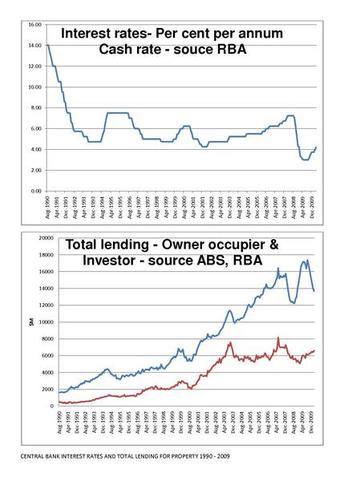
Most of the interest paid during construction is part of an asset’s cost.
Interest paid during delays in construction is excluded from the asset’s cost.
Interest Costs on the Balance Sheet
The cost of interest incurred and/or paid is included as part of the historical cost of the asset under construction. No separate line item is needed on the balance sheet to disclose the interest costs associated with the asset. If any delays occur during the construction phase, the interest costs incurred during the delay are not capitalized. This interest cost is recorded as interest expense and reported as a period cost on the income statement rather than the balance sheet.
Interest Costs After Construction
When the asset’s construction is complete and the asset is ready for use, any additional interest expense incurred is no longer capitalized as part of the asset’s cost. This interest is expensed on the income statement and reduces income for the accounting period.
6.3: Valuing of Assets
6.3.1: Basic Components of Asset Valuation
Assets are valued using absolute value, relative value, or option pricing models, which require different inputs.
Learning Objective
Differentiate between the absolute value, relative value, fair value and option pricing methods of valuing an asset
Key Points
- Absolute value models that determine the present value of an asset’s expected future cash flows. These kinds of models take two general forms: multi-period models (discounted cash flow models) or single-period models. These models rely on mathematics rather than price observation.
- Relative value models determine value based on the observation of market prices of similar assets.
- Option pricing models are used for certain types of financial assets (e.g., warrants, put options, call options, employee stock options, investments with embedded options such as a callable bond) and are a complex present value model.
- The book value of an asset is its recorded cost less accumulated depreciation. An old asset’s book value is usually not a valid indication of the new asset’s fair market value. However, if a better basis is not available, a firm could use the book value of the old asset.
- An appraised value is an expert’s opinion of an item’s fair market price if the item were sold. Appraisals are used often to value works of art, rare books, and antiques.
Key Terms
- liability
-
An obligation, debt or responsibility owed to someone.
- valuation
-
The process of estimating the market value of a financial asset or liability.
- asset
-
Something or someone of any value; any portion of one’s property or effects so considered
Example
- Occasionally, a company receives an asset without giving up anything for it. For example, to attract industry to an area and provide jobs for local residents, a city may give a company a tract of land on which to build a factory. Although such a gift costs the recipient company nothing, it usually records the asset (land) at its fair market value. Accountants record gifts of plant assets at fair market value to provide information on all assets owned by the company. Omitting some assets may make information provided misleading. They would credit assets received as gifts to a stockholders’ equity account titled Paid-in Capital—Donations.
Basic Asset Valuation
In finance, valuation is the process of estimating what something is worth. Items that are usually valued are a financial asset or liability. Valuations can be done on assets (for example, investments in marketable securities such as stocks, options, business enterprises, or intangible assets such as patents and trademarks) or on liabilities (e.g., bonds issued by a company). Valuations are needed for many reasons such as investment analysis, capital budgeting, merger and acquisition transactions, financial reporting, taxable events to determine the proper tax liability, and in litigation.
Overview
Valuation of financial assets is done using one or more of these types of models:
- Absolute value models that determine the present value of an asset’s expected future cash flows. These kinds of models take two general forms: multi-period models such as discounted cash flow models or single-period models such as the Gordon model. These models rely on mathematics rather than price observation.
- Relative value models determine value based on the observation of market prices of similar assets.
- Option pricing models are used for certain types of financial assets (e.g., warrants, put/call options, employee stock options, investments with embedded options such as a callable bond) and are a complex present value model. The most common option pricing models are the Black–Scholes-Merton models and lattice models.
- Fair value is used in accordance with US GAAP (FAS 157), where fair value is the amount at which the asset could be bought or sold in a current transaction between willing parties, or transferred to an equivalent party, other than in a liquidation sale. This is used for assets whose carrying value is based on mark-to-market valuations; for fixed assets carried at historical cost (less accumulated depreciation), the fair value of the asset is not used.
Common terms for the value of an asset or liability are fair market value, fair value, and intrinsic value. The meanings of these terms differ. For instance, when an analyst believes a stock’s intrinsic value is greater (less) than its market price, an analyst makes a “buy” (“sell”) recommendation. Moreover, an asset’s intrinsic value may be subject to personal opinion and vary among analysts.
When a plant asset is purchased for cash, its acquisition cost is simply the agreed on cash price. However, when a business acquires plant assets in exchange for other non-cash assets (shares of stock, a customer’s note, or a tract of land) or as gifts, it is more difficult to establish a cash price. This section discusses three possible asset valuation bases.

Emerging Values: Environmentalism and Green Energy
Image of an energy plant.
The general rule on non-cash exchanges is to value the non-cash asset received at its fair market value or the fair market value of what was given up, whichever is more clearly evident. The reason for not using the book value of the old asset to value the new asset is that the asset being given up is often carried in the accounting records at historical cost. In the case of a fixed asset, its value on the balance sheet is historical cost less accumulated depreciation, or book value. Neither amount may adequately represent the actual fair market value of either asset. Therefore, if the fair market value of one asset is clearly evident, a firm should record this amount for the new asset at the time of the exchange.
Appraised Value
Sometimes, neither of the items exchanged has a clearly determinable fair market value. Then, accountants record exchanges of items at their appraised values as determined by a professional appraiser. An appraised value is an expert’s opinion of an item’s fair market price if the item were sold. Appraisals are used often to value works of art, rare books, antiques, and real estate.
Book Value
The book value of a fixed asset asset is its recorded cost less accumulated depreciation. An old asset’s book value is usually not a valid indication of the new asset’s fair market value. However, if a better basis is not available, a firm could use the book value of the old asset.
Occasionally, a company receives an asset without giving up anything for it. For example, to attract industry to an area and provide jobs for local residents, a city may give a company a tract of land on which to build a factory. Although such a gift costs the recipient company nothing, it usually records the asset (land) at its fair market value. Accountants record gifts of plant assets at fair market value to provide information on all assets owned by the company. Omitting some assets may make information provided misleading. They would credit assets received as gifts to a stockholders’ equity account titled Paid-in Capital—Donations.
6.3.2: Additional Factors to Consider
There are additional factors to consider when valuing a business including competition, management stability, etc.
Key Points
- An important aspect of company valuation is determined when examining it in comparison to competitors. The company’s relative size compared with other businesses in its industry, relative product or service quality, etc. are important.
- When looking at management stability as a part of business valuation, one must consider if the management is skilled and experienced enough to maintain the company’s position and, potentially, improve it in the future.
- Consideration of financial strength entails a number of ratios, including a company’s total debt to assets, long-term debt to equity, current and quick ratios, interest coverage, and operating cycle.
- The book value of an asset is its recorded cost less accumulated depreciation. An old asset’s book value is usually not a valid indication of the new asset’s fair market value. However, if a better basis is not available, a firm could use the book value of the old asset.
- An appraised value is an expert’s opinion of an item’s fair market price if the item were sold. Appraisals are used often to value works of art, rare books, and antiques.
Key Terms
- competitor
-
A person or organization against whom one is competing.
- management
-
Administration; the process or practice of managing.
- intangible
-
Incapable of being perceived by the senses; incorporeal.
Example
- An important aspect of company valuation is determined when examining it in comparison to competitors. For example: the company’s relative size compared with other businesses in its industry, relative product or service quality, product or service differentiation from others in the industry, market strengths, market size and share, competitiveness within its industry in terms of price and reputation, and copyright or patent protection.
Additional Factors to Consider
Competition
An important aspect of company valuation is determined when examining it in comparison to competitors. The company’s relative size compared with other businesses in its industry, relative product or service quality, product or service differentiation from others in the industry, market strengths, market size and share, competitiveness within its industry in terms of price and reputation, and copyright or patent protection of its products are all important in this examination.
- The most narrow form is direct competition (also called “category competition” or “brand competition”), where products which perform the same function compete against each other. For example, one brand of pick-up trucks competes with several other brands of pick-up trucks. Sometimes, two companies are rivals, and one adds new products to their line, which leads to the other company distributing the same new things, and in this manner they compete.
- The next form is substitute or indirect competition, where products which are close substitutes for one another compete. For example, butter competes with margarine, mayonnaise, and other various sauces and spreads.
- The broadest form of competition is typically called “budget competition. ” Included in this category is anything on which the consumer might want to spend their available money. For example, a family which has $20,000 available may choose to spend it on many different items, which can all be seen as competing with each other for the family’s expenditure. This form of competition is also sometimes described as a competition of “share of wallet. “
Management Ability
When examining this factor as a part of business valuation, one must consider if the management is skilled and experienced enough to maintain the company’s position, and potentially improve it in the future. Several factors can indicate management ability: accounts receivable, inventory, fixed assets, and total asset turnover; employee turnover; condition of the facilities; family involvement, if any; quality of books and records; and sales, as well as gross and operating profit.
Financial Strength
Consideration of financial strength entails a number of ratios, including a company’s total debt to assets, long-term debt to equity, current and quick ratios, interest coverage, and operating cycle.
- Total debt to assets: total debt/total assets or total liability/total assets
- Long term debt to equity: long term debt(liabilities)/equity
- Current ratio: current assets/current liabilities
Profitability and Stability of Earnings
In accounting, profit is the difference between the purchase and the component costs of delivered goods and/or services and any operating or other expenses. This can help determine the financial stability of a company when viewing its profitability during its operating history, including the number of years the company has been in business, its sales and earnings trends, the life cycle of the industry as a whole, and returns on sales, assets and equity.
Other Factors
Along with the aforementioned considerations, a valuator must also keep in mind the economic conditions in which the company is operating, including the broad industry outlook and the impact of various IRS rulings and court cases that may affect the company’s value.
In addition, the valuator must analyze the values of comparable companies to determine their relationship to the company’s value. Intangible factors such as goodwill and non-compete agreements are important as well.
Finally, the valuator needs to consider the discount or capitalization rate of the company, specify what percentage of the company is being valued, and take into account any marketability or minority interest discounts.
Perhaps the most difficult part of the entire process is knowing how to combine all of these factors in a meaningful way to reach a value that will withstand any challenges by potential buyers, the IRS, dissatisfied partners or others.
Fair value should also be a consideration when valuing certain assets. Under US GAAP (FAS 157), fair value is the amount at which the asset could be bought or sold in a current transaction between willing parties, or transferred to an equivalent party, other than in a liquidation sale. This is used for assets whose carrying value is based on mark-to-market valuations; for fixed assets carried at historical cost (less accumulated depreciation), the fair value of the asset is not used.

Apple is a successful company with considerable goodwill.
This is an example of an additional factor beyond book value that contributes to the overall valuation of a company.
6.3.3: Valuing Repairs, Maintenance, and Additions
Improvements to existing plant assets are capital expenditures because they increase the quality of services obtained from the asset.
Learning Objective
Explain what a capital expenditure is and how a company would account for it.
Key Points
- Because betterments or improvements add to the service-rendering ability of assets, firms charge them to the asset accounts.
- Occasionally, expenditures made on plant assets extend the quantity of services beyond the original estimate but do not improve the quality of the services. Since these expenditures benefit an increased number of future periods, accountants capitalize rather than expense them.
- Deferred maintenance is the practice of postponing maintenance activities such as repairs on both real property (i.e. infrastructure) and personal property (i.e. machinery) in order to save costs, meet budget funding levels, or realign available budget monies.
Key Terms
- deferred maintenance
-
The failure to perform needed repairs could lead to asset deterioration and, ultimately, asset impairment.
- capital expenditure
-
Funds spent by a company to acquire or upgrade a long-term asset.
- depreciation
-
The measurement of the decline in value of assets. Not to be confused with impairment, which is the measurement of the unplanned, extraordinary decline in value of assets.
- additions and improvement
-
expense accrued to increase the productivity of an asset
Example
- For example, installing an air conditioner in an automobile that did not previously have one is a betterment. The debit for such an expenditure is to the asset account, Automobiles.
Valuing Repairs, Maintenance, and Additions
Betterments or improvements to existing plant assets are capital expenditures because they increase the quality of services obtained from the asset. Because these add to the service-rendering ability of assets, firms charge them to the asset accounts.
For example, installing an air conditioner in an automobile that did not previously have one is a betterment. The debit for such an expenditure is to the asset account, Automobiles.

Car Repairs
Cars require regular maintenance. Such contingent liabilities can be estimated reliably based on historical cost and readily available information.
Occasionally, expenditures made on plant assets extend the quantity of services beyond the original estimate but do not improve the quality of the services. Since these expenditures benefit an increased number of future periods, accountants capitalize rather than expense them. However, since there is no visible, tangible addition to, or improvement in, the quality of services, they charge the expenditures to the accumulated depreciation account, thus reducing the credit balance in that account. Such expenditures cancel a part of the existing accumulated depreciation; firms often call them extraordinary repairs.
If an expenditure that should be expensed is capitalized, the effects are more significant. Assume now that USD 6,000 in repairs expense is incurred for a plant asset that originally cost USD 40,000 and had a useful life of four years and no estimated salvage value. This asset had been depreciated using the straight-line method for one year and had a book value of USD 30,000 (USD 40,000 cost—USD 10,000 first-year depreciation) at the beginning of 2010. The company capitalized the USD 6,000 that should have been charged to repairs expense in 2010. The charge for depreciation should have remained at USD 10,000 for each of the next three years. With the incorrect entry, however, depreciation increases.
Deferred maintenance is the practice of postponing maintenance activities such as repairs on both real property (i.e. infrastructure) and personal property (i.e. machinery) in order to save costs, meet budget-funding levels, or realign available budget monies. The failure to perform needed repairs could lead to asset deterioration and, ultimately, asset impairment. Generally, a policy of continued deferred maintenance may result in higher costs, asset failure, and in some cases, health and safety implications.
Valuing Asset-Related Costs
Under US GAAP (FAS 157), fair value is the amount at which an asset and its related costs could be bought or sold in a current market transaction between willing parties or transferred to an equivalent party other than in a liquidation sale. Therefore, asset repairs and maintenance are expensed on the income statement at the market value paid for the services rendered. Asset additions/improvements are capitalized to their respective asset accounts on the balance sheet at the market value of the addition.
6.4: Depreciation of Assets
6.4.1: What Is Depreciation?
Depreciation is defined as the expensing of the cost of an asset involved in producing revenues throughout its useful life.
Learning Objective
Summarize the purpose of depreciating an asset
Key Points
- Depreciation expense reduces the book value of an asset and reduces an accounting period’s earnings. The expense is recognized throughout an asset’s useful life.
- The calculation of depreciation expense follows the matching principle, which requires that revenues earned in an accounting period be matched with related expenses.
- Depreciation expense can be calculated in a variety of ways; the method chosen should be appropriate to the asset type, the asset’s expected business use, and its estimated useful life.
Key Terms
- residual value
-
In accounting, residual value is another name for salvage value, the remaining value of an asset after it has been fully depreciated.
- accrual accounting
-
refers to the concept of recognizing and reporting revenues when earned and expenses when incurred, regardless of the effect on cash.
Definition of Depreciation
Depreciation is defined as the expensing of an asset involved in producing revenues throughout its useful life. Depreciation for accounting purposes refers the allocation of the cost of assets to periods in which the assets are used (depreciation with the matching of revenues to expenses principle). Depreciation expense affects the values of businesses and entities because the accumulated depreciation disclosed for each asset will reduce its book value on the balance sheet. Depreciation expense also affects net income. Generally the cost is allocated as depreciation expense among the periods in which the asset is expected to be used. Such expense is recognized by businesses for financial reporting and tax purposes.

Depreciation reflects the wear and tear experienced by an asset in use.
Cars depreciate in value throughout their useful life.
Depreciation and the Matching Principle
Depreciation expense reduces an accounting period’s income even though the expense does not require a cash or credit payment. The reason for the expense is to comply with the matching principle required by accrual accounting. According to the principle, expenses are recognized regardless of cash payment when obligations are:
- incurred (usually when goods are transferred (sold) or services rendered),
- generated by expenses involved in the earning of the accounting period’s revenues.
Depreciation Expense Calculation
Depreciation expense can be calculated using a variety of methods. The depreciation method chosen should be appropriate to the asset type, its expected business use, its estimated useful life, and the asset’s residual value. The expense is recognized and reported when the asset is placed into use and is calculated for each accounting period and reported under Accumulated Depreciation on the balance sheet and Depreciation Expense on the income statement. The amount reduces both the asset’s value and the accounting period’s income. A depreciation method commonly used to calculate depreciation expense is the straight line method.
6.4.2: Factors for Calculating Depreciation
There are four main factors that affect the calculation of depreciation expense: asset cost, salvage value, useful life, and obsolescence.
Learning Objective
Summarize how a company would determine the appropriate depreciation method to use
Key Points
- A company is free to adopt the most appropriate depreciation method for its business operations.
- Companies can choose a method that allocates asset cost to accounting periods according to benefits received from the use of the asset.
- The depreciation method used should allocate asset cost to accounting periods in a systematic and rational manner.
Key Term
- obsolescence
-
The process of becoming obsolete, outmoded, or out of date.
Factors Affecting Depreciation Expense
There are four main factors to consider when calculating depreciation expense:
- The cost of the asset
- The estimated salvage value of the asset. Salvage value (or residual value) is the amount of money the company expects to recover, less disposal costs, on the date the asset is scrapped, sold, or traded in.
- Estimated useful life of the asset. Useful life refers to the window of time that a company plans to use an asset. Useful life can be expressed in years, months, working hours, or units produced.
- Obsolescence should be considered when determining an asset’s useful life and will affect the calculation of depreciation. For example, a machine capable of producing units for 20 years may be obsolete in six years; therefore, the asset’s useful life is six years.
Factors Affecting the Depreciation Method
A company is free to adopt the most appropriate depreciation method for its business operations. Accounting theory suggests that companies use a depreciation method that closely reflects the operations’ economic circumstances. So, companies can choose a method that allocates asset cost to accounting periods according to benefits received from the use of the asset. Most companies use the straight-line method for financial reporting purposes, but they may also use different methods for different assets. The most important criteria to follow: Use a depreciation method that allocates asset cost to accounting periods in a systematic and rational manner.
Types of Depreciation Methods
The following four methods allocate asset cost in a systematic and rational manner: straight line, units of production, sum-of-years-digits, and double-declining balance.
Examples of Depreciation Expense Calculations
Here is an example of how to calculate depreciation expense under the straight-line method. Assume a purchased truck is valued at $10,000, has a residual value of $5,000, and a useful life of 5 years. Its depreciation expense for year 1 is
. The journal entry for this transaction is a debit to Depreciation Expense for $1,000 and a credit to Accumulated Depreciation for $1,000. The depreciation expense is reported on the income statement as a reduction to revenues and accumulated depreciation is reported as a contra account to its related Delivery Truck asset account (reduces the asset’s cost to its book value) on the balance sheet.
Here is an example of how to calculate depreciation expense under the units of production. Assume a piece of machinery, purchased for $100,000 with a residual value of $40,000, is expected to produce 10,000 units over its useful life. First, calculate the depreciation per unit:
The depreciation expense for the period is the per unit amount multiplied by the period’s production amount: if 1,000 units were produced, the depreciation expense is
. This amount is disclosed on the income statement and is part of the asset’s accumulated depreciation on the balance sheet.
Here is an example of how to calculate depreciation expense under the sum-of-years-digits. Assume a piece of machinery is purchased for USD 100,000 with a residual value of $40,000 and a useful life of 5 years. First, calculate the depreciation rate by adding the years of useful life, or
. Second, calculate the depreciation expense for year 5:
For year 4, the calculation uses the asset’s book value (
) subtracted by its residual value (
) and multiplied by the rate for year 4
.
To calculate depreciation using the double-declining method, its possible to double the amount of depreciation expense under the straight-line method. To do this, divide 100 per cent by the number of years of useful life of the asset. Then, multiply this rate by 2. Next, apply the resulting double-declining rate to the declining book value of the asset (cost subtracted by accumulated depreciation). Ignore salvage value in making the calculations. At the point where book value is equal to the salvage value, no more depreciation is taken.
6.4.3: Methods of Depreciation
There are various methods that can calculate depreciation expense for the period; the method used should reflect the asset’s business use.
Learning Objective
Differentiate between the straight-line, units of production, sum of the years digits and double declining methods of calculating depreciation
Key Points
- Straight-line depreciation is the simplest and most popular method; it charges an equal amount of depreciation to each accounting period.
- The units-of-production depreciation method assigns an equal amount of expense to each unit produced or service rendered by the asset.
- The sum-of-the-years digits method determines annual depreciation by multiplying the asset’s depreciable cost by a series of fractions based on the sum of the asset’s useful life digits.
- The double-declining balance is a type of accelerated depreciation method that calculates a higher depreciation charge in the first year of an asset’s life and gradually decreases depreciation expense in subsequent years.
Key Terms
- salvage value
-
also known as residual value; the remaining value of an asset after it has been fully depreciated.
- historical cost
-
The original monetary value of an economic item and based on the stable measuring unit assumption. Improvements may be added to an asset’s cost.
- useful life
-
the length of time, typically in years, that an asset is expected to function and be useful.
Methods of Depreciation
Some of the most common methods used to calculate depreciation are straight-line, units-of-production, sum-of-years digits, and double-declining balance, an accelerated depreciation method. The Modified Accelerated Cost Recovery System (MACRS) is the current tax depreciation system used in the United States .

There are several asset depreciation methods to choose from.
The depreciation method for an automobile should reflect the asset’s use throughout its life.
Straight-Line
Straight-line depreciation has been the most widely used depreciation method in the U.S. for many years due to its simplicity. To apply the straight-line method, a company charges an equal amount of the asset’s cost to each accounting period. The straight-line formula used to calculate depreciation expense is: (asset’s historical cost – the asset’s estimated salvage value) / the asset’s useful life.
An example of how to calculate depreciation expense under the straight-line method — assume a purchased truck is valued at USD 10,000, has a residual value of USD 5,000, and a useful life of 5 years. Its depreciation expense for year 1 is USD 1,000 (10,000 – 5,000 / 5). The journal entry for this transaction is a debit to Depreciation Expense for USD 1,000 and a credit to Accumulated Depreciation for USD 1,000. The depreciation expense is reported on the income statement as a reduction to revenues and accumulated depreciation is reported as a contra account to its related Delivery Truck asset account (reduces the asset’s cost to its book value).
Units of Production
The units-of-production depreciation method assigns an equal amount of expense to each unit produced or service rendered by the asset. This method is typically applied to assets used in the production line. The formula to calculate depreciation expense involves two steps: (1) determine depreciation per unit ((asset’s historical cost – estimated salvage value) / estimated total units of production during the asset’s useful life); (2) determine the expense for the accounting period (depreciation per unit X number of units produced in the period).
An example of how to calculate depreciation expense under the units of production — assume a piece of machinery, purchased for USD 100,000 with a residual value of 40,000, is expected to produce 10,000 units over its useful life. First, calculate the depreciation per unit — 100,000 – 40,000 / 10,000, or USD 6 per unit. The depreciation expense for the period is the per unit amount multiplied by the period’s production amount — if 1,000 units were produced, depreciation expense equals USD 6,000 (1,000 * 6). This amount is disclosed on the income statement and is part of the asset’s accumulated depreciation on the balance sheet.
Sum-of-years-digits
Sum-of-years’ digits is a depreciation method that results in a more accelerated write-off than straight line, but less accelerated than that of the double-declining balance method. Under this method, annual depreciation is determined by multiplying the depreciable cost by a series of fractions based on the sum of the asset’s useful life digits. The sum of the digits can be determined by using the formula (n2+n)/2, where n is equal to the useful life of the asset.
To calculate depreciation expense under the sum-of-years-digits — assume a piece of machinery is purchased for USD 100,000 with a residual value of 40,000 and a useful life of 5 years. First, calculate the depreciation rate by adding the years of useful life, or 1+2+3+4+5 (equal to 15). Second, calculate the depreciation expense for year 5 — 100,000 – 40,000 * 5/15, or USD 20,000. For year 4, the calculation uses the asset’s book value (100,000 – 20,000) subtracted by its residual value (40,000) and multiplied by the rate for year 4 (4/15).
Double-declining Balance
The double-declining balance method is a type of accelerated depreciation method that calculates a higher depreciation charge in the first year of an asset’s life and gradually decreases depreciation expense in subsequent years.
To calculate depreciation expense, use double the straight-line rate. For example, suppose a business has an asset with a cost of 1,000, 100 salvage value, and 5 years useful life. First, calculate the straight-line depreciation rate. Since the asset has 5 years useful life, the straight-line depreciation rate equals (100% / 5) or 20% per year. With double-declining-balance, double that rate to arrive at 40%. Apply the rate to the book value of the asset (cost subtracted by accumulated depreciation) and ignore salvage value. At the point where book value is equal to the salvage value, no more depreciation is taken.
MACRS
Under MACRS, the capitalized cost (basis) of tangible property is recovered by annual deductions for depreciation over a specified life. The lives are specified in the Internal Revenue Service’s (IRS) Tax Co de. The IRS publishes detailed tables of asset lives by asset class. The deduction for depreciation is computed under one of two methods (declining balance switched to straight line or only straight line ) at the election of the taxpayer. Certain limitations may apply.
6.4.4: Impact of Depreciation Method
The choice of depreciation method can impact revenues on the income statement and assets on the balance sheet.
Learning Objective
Explain how the choice of depreciation method affects a company’s revenue
Key Points
- These four methods of depreciation (straight line, units of production, sum-of-years-digits, and double-declining balance) impact revenues and assets in different ways.
- The effect of the straight-line method is a stable and uniform reduction in revenues and asset values in every accounting period of the asset’s useful life.
- Depreciation expense under units-of-production, based on units produced in the period, will be lower or higher and have a greater or lesser effect on revenues and assets.
- Sum-of-years digits is a depreciation method that results in a more accelerated write off of the asset than straight line but less than declining-balance method.
- For the double-declining balance method, revenues and assets will be reduced more in the early years of an asset’s life, due to the higher depreciation expense, and less in the later years.
Key Terms
- accelerated-depreciation method
-
a company, for ‘financial accounting’ or tax purposes, depreciates a fixed asset in such a way that the amount of depreciation taken each year is higher during the earlier years of an asset’s life
- accelerated depreciation
-
Accelerated depreciation methods calculate a higher depreciation charge in the first year of an asset’s life, with gradually decreasing charges in subsequent years. This may be a more realistic reflection of an asset’s actual expected benefit based on the use of the asset; many assets are most useful when they are new.
- income statement
-
A calculation which shows the profit or loss of an accounting unit (company, municipality, foundation, etc.) during a specific period of time, providing a summary of how the profit or loss is calculated from gross revenue and expenses.
- balance sheet
-
A summary of a person’s or organization’s assets, liabilities. and equity as of a specific date.
- declining-balance method
-
depreciation is based on a percent of the asset’s previous year ending book value
Impact of Depreciation Methods
Depreciation is a required expense for all business with fixed assets, excluding land. The choice of the depreciation method can impact revenues on the income statement and assets on the balance sheet. The four most common methods of depreciation that impact revenues and assets are: straight line, units of production, sum-of-years-digits, and double-declining balance.

Different depreciation methods have different effects on revenues and assets.
The depreciation method used to depreciate a car calculates an expense that reduces income.
Straight Line
When using the straight-line method, a company charges the same depreciation expense every accounting period throughout an asset’s useful life, so the effect is a stable and uniform reduction in revenues and asset values in every accounting period of the asset’s useful life.
Here is an example of how to calculate depreciation expense under the straight-line method. Assume a purchased truck is valued at $10,000, has a residual value of $5,000, and a useful life of 5 years. Its depreciation expense for year 1 is
. The journal entry for this transaction is a debit to Depreciation Expense for 1,000 and a credit to Accumulated Depreciation for 1,000. The depreciation expense is reported on the income statement as a reduction to revenues and accumulated depreciation is reported as a contra account to its related Delivery Truck asset account (reduces the asset’s cost to its book value).
Units of Production
The units-of-production method is calculated based on the units produced in the accounting period. Depreciation expense will be lower or higher and have a greater or lesser effect on revenues and assets based on the units produced in the period.
Here is an example of how to calculate depreciation expense under the units of production. Assume a piece of machinery, purchased for $100,000 with a residual value of $40,000, is expected to produce 10,000 units over its useful life. First, calculate the depreciation per unit:
The depreciation expense for the period is the per unit amount multiplied by the period’s production amount: if 1,000 units were produced, the depreciation expense is
. This amount is disclosed on the income statement and is part of the asset’s accumulated depreciation on the balance sheet.
Sum-Of-Years-Digits
Sum-of-years-digits depreciation is determined by multiplying the asset’s depreciable cost by a series of fractions based on the sum of the asset’s useful life digits. Sum-of-years digits is a depreciation method that results in a more accelerated write off of the asset than straight line but less than double-declining balance method. This method will reduce revenues and assets more rapidly than the straight-line method but not as rapidly as the double-declining method.
Here is an example of how to calculate depreciation expense under the sum-of-years-digits. Assume a piece of machinery is purchased for USD 100,000 with a residual value of $40,000 and a useful life of 5 years. First, calculate the depreciation rate by adding the years of useful life, or
. Second, calculate the depreciation expense for year 5:
For year 4, the calculation uses the asset’s book value (
) subtracted by its residual value (
) and multiplied by the rate for year 4
.
Double-Declining Balance
Double-declining balance is a type of accelerated depreciation method. This method records higher amounts of depreciation during the early years of an asset’s life and lower amounts during the asset’s later years. Thus, in the early years, revenues and assets will be reduced more due to the higher depreciation expense. In later years, a lower depreciation expense can have a minimal impact on revenues and assets. However, revenues may be impacted by higher costs related to asset maintenance and repairs.
To calculate depreciation using the double-declining method, its possible to double the amount of depreciation expense under the straight-line method. To do this, divide 100 per cent by the number of years of useful life of the asset. Then, multiply this rate by 2. Next, apply the resulting double-declining rate to the declining book value of the asset (cost subtracted by accumulated depreciation). Ignore salvage value in making the calculations. At the point where book value is equal to the salvage value, no more depreciation is taken.
6.5: Impairment of Assets
6.5.1: Impairment Recognition
An impairment loss is recognized and accrued through a journal entry to record and reevaluate the asset’s value.
Learning Objective
Explain how to assess an asset for impairment
Key Points
- Business assets should be tested for impairment when a situation occurs that causes the asset to lose value. Certain intangible assets, such as goodwill, are tested for impairment on an annual basis.
- Impairment losses can occur for a variety of reasons: physical damage to the asset, a permanent reduction in market value, legal issues against the asset, and early asset disposal.
- An impairment loss is recognized through a journal entry that debits Loss on Impairment, debits the asset’s Accumulated Depreciation and credits the Asset to reflect its new lower value.
Key Terms
- depreciation
-
The measurement of the decline in value of assets. Not to be confused with impairment, which is the measurement of the unplanned, extraordinary decline in value of assets.
- accrue
-
To increase, to augment; to come to by way of increase; to arise or spring as a growth or result; to be added as increase, profit, or damage, especially as the produce of money lent.
Impairment Recognition
Business assets should be tested for impairment when a situation occurs that causes the asset to lose value. An impairment loss is recognized and accrued to record the asset’s revaluation. Once an asset has been revalued, fluctuations in market value are calculated periodically. Certain intangible assets, such as goodwill, are tested for impairment on an annual basis. Impairment losses can occur for a variety of reasons:
- when an asset is badly damaged (negative change in physical condition)
- the asset’s market price has been significantly reduced
- legal issues have had a negative impact on the asset
- the asset is set for disposal before the end of its useful life A loss on impairment is recognized as a debit to Loss on Impairment (the difference between the new fair market value and current book value of the asset) and a credit to the asset. The loss will reduce income in the income statement and reduce total assets on the balance sheet.
A loss on impairment is recognized as a debit to Loss on Impairment (the difference between the new fair market value and current book value of the asset) and a credit to the asset.The loss will reduce income in the income statement and reduce total assets on the balance sheet.

The impairment of an asset reduces its value on the balance sheet.
The cost of an impaired building beyond repair is disclosed as a loss on the income statement.
For an example, take a retail store that is recorded on the owner’s balance sheet as a non-current asset worth USD 20,000 (book value or carrying value is USD 20,000). Based on the asset’s book value, assume the store has a historical cost of USD 25,000 and accumulated depreciation of USD 5,000. A hurricane sweeps through the town and damages the store’s building. After assessing the amount of the damage, the owner calculates that the building’s market value has fallen to USD 12,000.
The Loss on Impairment is calculated to be USD 8,000 (20,000 book value – 12,000 market value)
The journal entry to recognize the Loss on Impairment:
- Debit Loss on Impairment for USD 8,000
- Debit Store Building-Accumulated Depreciation for USD 5,000
- Credit Store Building for USD 13,000
The Loss on Impairment for USD 8,000 is recognized on the income statement as a reduction to the period’s income and the asset Store Building is recognized at its reduced value of USD 12,000 on the balance sheet (25,000 historical cost – 8,000 impairment loss – 5,000 accumulated depreciation). After the impairment, depreciation expense is calculated using the asset’s new value.
6.5.2: Impairment Measurement
Business assets that have suffered a loss in value are given two tests to measure and recognize the amount of the loss.
Learning Objective
Summarize the steps a company takes to measure an assets impairment
Key Points
- Two tests are performed to determine the amount of an impairment loss: recoverability and measurement.
- The recoverability test evaluates if an asset’s undiscounted future cash flows are less than the asset’s book value. When cash flows are less, the loss is measured.
- The measurement test uses the difference between the asset’s market value and book value to calculate the amount of the impairment loss.
Key Terms
- intangible asset
-
Any valuable property of a business that does not appear on the balance sheet, including intellectual property, customer lists, and goodwill.
- cash flows
-
cash received or paid by a company for its business activities.
- recoverability
-
The property of being able to recover.
Business assets that have suffered a loss in value are subject to impairment testing to measure and recognize the amount of the loss.

Physical damage to an asset can result in an impairment loss.
The impairment of a building is measured by determining the amount of value the asset has lost.
To measure the amount of the loss involves two steps:
- Perform a recoverability test is to determine if an impairment loss has occurred by evaluating whether the future value of the asset’s undiscounted cash flows is less than the book value of the asset. If the cash flows are less than book value, the loss is measured.
- Measure the impairment loss by calculating the difference between the book value and the market value of the asset.
The use of undiscounted cash flows in determining impairment loss assumes that the cash flows are certain and risk-free, and the timing of the cash flows is ignored. For example, assume a new USD 20,000 sewing machine, with a useful of life of 3 years, is damaged and has a new book value of USD 10,000.
The expected undiscounted cash flows generated by the machine after the damage are:
- USD 2,000 in Year1
- USD 2,000 in Year2
- USD 2,000 in Year3
Since the asset’s future undiscounted cash flows are USD 6,000, less than the USD 10,000 book value, an impairment loss has occurred. Use the market value of the sewing machine, USD 20,000, and deduct the USD 10,000 book value to arrive at an impairment loss of USD 10,000.
Certain assets with indefinite lives require an annual test for impairment. Trademarks and Goodwill are examples of intangible assets that are tested for impairment on an annual basis.
6.5.3: Loss Restoration
Fixed asset values can be revised to reflect an increase or decrease in value; upward revisions can recover earlier impairment losses.
Learning Objective
Explain when it would be applicable to revalue an impaired asset
Key Points
- A revaluation that increases or decreases an asset’s value can be accounted for with a journal entry that will debit or credit the asset account.
- An increase in the asset’s value should not be reported on the income statement; instead an equity account is credited and called a “Revaluation Surplus”.
- The revaluation surplus account accounts for increases in asset value and it also offsets any downward revisions, such as an impairment loss, in asset value.
- When the credit balance in the revaluation surplus account zeros out, an impairment loss is reported on the income statement.
- Under US GAAP, once an asset is impaired, its value cannot be increased regardless of its fair market value. Once the value of an asset is decreased, it stays at that value unless its market value declines again.
Key Terms
- International Financial Reporting Standards
-
International Financial Reporting Standards (IFRS) are designed as a common global language for business affairs so that company accounts are understandable and comparable across international boundaries
- Comprehensive Income
-
The change in a company’s owner’s equity [net assets] due to transactions and other events and circumstances from non-owner sources. Comprehensive income is the sum of net income and other items that must bypass the income statement because they have not been realized
Asset Revaluation and Impairment Loss
Under US GAAP, once an asset is impaired its value cannot be increased regardless of what its fair market value is; once the value of an asset is decreased, it stays at that value unless its market value declines again. US GAAP does require that a business impair its assets if its fair market value decreases.
Under International Financial Reporting Standards, once a fixed asset has been revalued its book value can be adjusted periodically to market value using the cost model or the revaluation model. The cost model records an asset at its historical cost. If an asset becomes impaired and an impairment loss results, the asset can fall under the revaluation model that allows periodic adjustments to the asset’s book value. Future upward revisions to the value of the asset can recover losses from prior years under the revaluation model.

An upward revision to an asset’s value can recover prior impairment losses
Only assets accounted for under the revaluation model can have their book value adjusted to market value.
Revaluation Surplus
A revaluation that increases or decreases an asset’s value can be accounted for with a journal entry. The asset account is debited (increased) for the increase in value or credited (decreased) for a decrease in value. An increase in the asset’s value should not be reported on the income statement; instead an equity account is credited called “Revaluation Surplus. ” Revaluation surplus is reported in the other comprehensive income sub-section of the owner’s equity section in the balance sheet. The revaluation surplus account accounts for increases in asset value, and it also offsets any downward revisions, such as an impairment loss, in asset value. When the credit balance in the revaluation surplus account zeros out, an impairment loss is reported on the income statement.
Revaluation and Depreciation
After an asset have been revalued, the asset’s depreciation expense must change to reflect the new value. The asset’s new book value can be divided by its remaining useful life to adjust the amount of depreciation expense reported on the income statement after the revaluation.
6.6: Disposal of Assets
6.6.1: Sale
The disposal sale of an asset is similar to a regular asset sale, where cash proceeds are received and a loss or gain may be realized.
Learning Objective
Summarize how a company records the sale of an asset for disposal purposes
Key Points
- When an asset set for disposal is sold, depreciation expense must be computed up to the sale date to adjust the asset to its current book value.
- Compare the cash proceeds received from the sale with the asset’s book value to determine if a gain or loss on disposal has been realized. The gain or loss should be reported on the income statement.
- The asset account and its accumulated depreciation account are removed off the balance sheet when the disposal sale takes place.
Key Terms
- book value
-
The value of an asset as reflected on an entity’s accounting books, net of depreciation, but without accounting for market value appreciation.
- depreciation
-
The measurement of the decline in value of assets. Not to be confused with impairment, which is the measurement of the unplanned, extraordinary decline in value of assets.
- realize
-
To acquire as an actual possession; to obtain as the result of plans and efforts; to gain; to get.
Disposal of an Asset via Sale
The sale of an asset for disposal purposes is similar to a regular asset sale. Unlike a regular disposal of an asset, where the asset is abandoned and written off the accounting records, an asset disposal sale involves a receipt of cash or other proceeds. When the sale takes places, a journal entry is recorded that (1) updates depreciation expense, (2) removes the asset and its accumulated depreciation account off the balance sheet, (3) increases cash or other asset with the amount of proceeds received, and (4) records a gain or loss on the sale.
Depreciation Expense at Disposal
At the time of disposal, depreciation expense should be recorded to update the asset’s book value. A journal entry is recorded to increase (debit) depreciation expense and increase (credit) accumulated depreciation. Depreciation expense is reported on the income statement as a reduction to income. The increase in the accumulated depreciation account reduces the asset to its current book value .

An Asset for Sale — one way of disposing an asset is by selling it.
A business disposing of a building through a sale receives cash proceeds and may realize a gain or loss.
Proceeds Received and Loss/Gain at Disposal
The proceeds received on the asset sale are compared to the asset’s book value to determine if a gain or loss on disposal has been realized. If the proceeds are less than book value, a loss on disposal has been realized. If the proceeds are more than book value, the result is a gain. The proceeds from the sale will increase (debit) cash or other asset account. Depending on whether a loss or gain on disposal was realized, a loss on disposal is debited or a gain on disposal is credited. The loss or gain is reported on the income statement. The loss reduces income, while the gain increases it.
Asset Disposal and the Balance Sheet
The entry to remove the asset and its contra account off the balance sheet involves decreasing (crediting) the asset’s account by its cost and decreasing (crediting) the accumulated depreciation account by its account balance. Prior to zeroing out their account balances, these accounts should reflect the updated depreciation expense computed up to the disposal sale date.
6.6.2: Involuntary Conversion
Involuntary conversion of assets occurs when disposal is due to unforeseen circumstances, such as theft or casualty.
Learning Objective
Explain how a company accounts for the involuntary conversion of an asset
Key Points
- The forced disposal of the asset may result in cash proceeds from the filing and payment of an insurance claim on the asset or the receipt of a casualty award. A gain or loss on disposal can result.
- Involuntary conversion of assets can involve an asset exchange for monetary or non-monetary assets.
- An involuntary conversion involving an exchange for monetary assets is accounted for the same way as a sales transaction, with a gain or loss reported on the income statement.
- An exchange between non-monetary assets should be analyzed to determine if the exchange has commercial substance. An asset exchange with commercial substance will cause future cash flows to materially change.
- A non-monetary asset exchange with commercial substance may result in a gain or loss reported on the income statement. An exchange without commercial substance does not recognize gains or losses.
Key Terms
- depreciation
-
The measurement of the decline in value of assets. Not to be confused with impairment, which is the measurement of the unplanned, extraordinary decline in value of assets.
- condemnation
-
The process by which a public entity exercises its powers of eminent domain.
- casualty
-
Something that happens by chance, especially an unfortunate event; an accident, a disaster.
Definition of Involuntary Conversion
The involuntary conversion of an asset occurs when an asset must be disposed of due to unforeseen circumstances, such as theft, casualty, or condemnation. The forced disposal of the asset may result in cash proceeds from the filing and payment of an insurance claim on the asset or the receipt of a casualty award. If the monetary exchange is more than the asset’s book value, updated for depreciation up to the disposal date, a gain on disposal results; if the proceeds are less, the disposal realizes a loss. Unlike a voluntary sale, involuntary conversion of assets can involve an asset exchange for monetary or non-monetary assets .

An involuntary conversion is the forced disposal of an asset.
An airplane manufacturer’s involuntary conversion of a plane can result in a loss or gain on the income statement.
Exchange for Monetary Assets
Monetary assets consist of cash or cash-equivalent assets. An involuntary conversion involving an exchange for monetary assets is accounted for the same way as a typical sales transaction, with a gain or loss reported in the income statement in the period the conversion took place. The gain or loss is the difference between the proceeds received and the book value of the asset disposed of, updated for current depreciation expense.
Exchange for Non-Monetary Assets
Non-monetary assets are not easily converted to cash, such as equipment. An exchange between non-monetary assets should be analyzed to determine if the exchange has commercial substance. An asset exchange with commercial substance will cause future cash flows to materially change. If the exchange has commercial substance, the asset received is recorded on the balance sheet at either (1) the market value (purchase price) of the asset received or (2) the market value of the asset given up plus any cash paid. If the value of the new asset exceeds the book value of the old asset, a gain is recognized. If the new asset’s value is less, a loss is recognized.
For non-monetary asset exchanges without commercial substance, the expectation is that the exchange will not materially alter future cash flows. This type of exchange usually involves like-kind property, such as exchanging a truck for another truck. The asset received is recorded on the balance sheet at the book value of the asset given up plus any cash paid. Gains or losses on these transactions are not recognized.
6.7: Depletion of Assets
6.7.1: Depletion Base
The depletion base is the total cost of a natural resource and includes acquisition, exploration, development, and restoration costs.
Learning Objective
Differentiate between percentage depletion and cost depletion
Key Points
- Two methods are used to calculate depletion: percentage and cost.
- Percentage depletion is calculated by multiplying a certain percentage, specified for each mineral, by your gross income from the property during the year.
- Cost depletion is computed by (1) estimating the total quantity of mineral or resources acquired,(2) assigning a proportionate amount of the total resource cost to the quantity extracted in the period (total cost of the property/(the quantity extracted in the period/total estimated production).
- Industries involved in mining, timber, petroleum, and the extraction or use of natural resources are the types of businesses most affected by depletion.
Key Terms
- depreciation
-
The measurement of the decline in value of assets. Not to be confused with impairment, which is the measurement of the unplanned, extraordinary decline in value of assets.
- adjusted basis
-
The net cost of an asset after adjusting for various tax-related items.
Example
- This example calculates depletion expense using cost depletion: Big Texas Oil, Co. discovers a large reserve of oil. The company has estimated the oil well will produce 200,000 barrels of oil. The company invests $100,000 to extract the oil, and they extract 10,000 barrels the first year. Therefore, the depletion deduction is $5,000 ($100,000 X 10,000/200,000).
Definition of Depletion
Depletion is a method of recording the use of natural resources over time. It is the amount of resources used in each accounting period that is expensed for U.S. tax and financial reporting purposes. Depletion is similar to depreciation, in that it is a cost recovery system for accounting and tax reporting. Industries involved in mining, timber, petroleum, and the extraction or use of natural resources are the types of businesses most affected by depletion. The depletion base is the total cost of the natural resource. It can include costs related to the acquisition of the asset, exploration, development and preparation of the asset for use, and performance of restoration work .
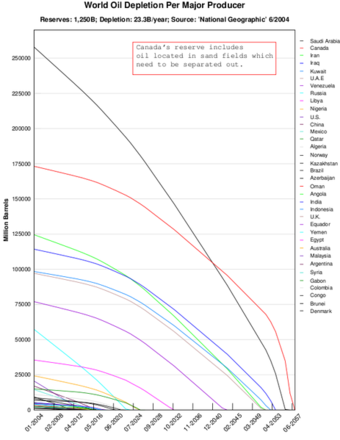
The depletion base for oil reserves includes all the costs incurred to put the asset into use.
Types of costs include acquisition, exploration, development, and restoration costs.
Methods to Calculate Depletion
Percentage Depletion:
To calculate, multiply a certain percentage, specified for each mineral, by your gross income from the property during the tax year. For this purpose, the term “property” means each separate interest business owned in each mineral deposit in each separate tract or parcel of land. Businesses can treat two or more separate interests as one property or as separate properties.
Cost Depletion:
This is an accounting method by which costs of natural resources are allocated to depletion over the period that make up the life of the asset. Cost depletion is computed by (1) estimating the total quantity of mineral or other resources acquired and (2) assigning a proportionate amount of the total resource cost to the quantity extracted in the period.Cost Depletion FormulaAccording to the IRS Newswire, over 50 percent of oil and gas extraction businesses use cost depletion to figure their depletion expense. Mineral property includes oil and gas wells, mines, and other natural deposits (including geothermal deposits). The cost depletion formula for financial reporting purposes is the total investment cost of the property / (the quantity extracted during the period / the property’s total estimated production). When calculating cost depletion for tax purposes, multiply the formula by the property’s adjusted basis or the property’s historical cost subtracted by depletion expense for prior years.
6.7.2: Resource Cost Write-Off
The term write-off describes removing an asset whose value is zero and is no longer in use from the balance sheet.
Learning Objective
Explain how to write off a natural resource asset
Key Points
- When a natural resource has been depleted to a value of zero, the asset’s remaining book value, as calculated by the original historical cost minus the depletion of prior years, is removed from the balance sheet through a write-off journal entry.
- The write-off journal entry will credit the asset’s account balance and debit the balance in the accumulated depletion account. The asset’s book value is the amount debited to an expense or loss account reported on the income statement.
- Write-offs should not be confused with impairment. A write-off journal entry removes an asset not in use and its related contra account from the balance sheet. An entry to record impairment merely reduces the asset’s value.
Key Terms
- contra asset account
-
an account that corresponds to another is affected when a transaction is recorded
- impairment
-
A downward revaluation, a write-down.
- journal entry
-
A journal entry, in accounting, is a logging of transactions into accounting journal items. The journal entry can consist of several items, each of which is either a debit or a credit. The total of the debits must equal the total of the credits or the journal entry is said to be “unbalanced. ” Journal entries can record unique items or recurring items, such as depreciation or bond amortization.
- salvage value
-
also known as residual value; the remaining value of an asset after it has been fully depreciated.
Example
- Assume that in 2010 a company paid USD 650,000 for a tract of land containing ore deposits. Preliminary study results indicated that approximately 900,000 tons of ore can be removed economically from the land, after which the land will be worth USD 50,000. To record the land purchase, Land is debited for USD 50,000 along with Ore Deposits for USD 600,000 and a credit is posted to Cash for USD 650,000. After mining begins, it is deemed impossible to extract the ore and the Ore Deposits account must be written off by debiting Loss on Ore Deposits for USD 600,000 and crediting Ore Deposits for USD 600,000.
Definition of Asset Write-offs:
The term write-off describes a reduction in recognized value. In accounting terminology, it refers to recognition of the reduced or zero value of an asset no longer in use. Assets that are natural resources, which are used throughout the course of business, are subject to periodic depletion. When the asset has been depleted to a value of zero or its value has dropped to less than its salvage value, the asset’s remaining book value, as calculated by the original historical cost minus the depletion of prior years, is removed from the balance sheet through a write-off.

When natural resources have their value reduced to zero they are written off.
An asset write-off removes an asset’s cost off the balance sheet and expenses it on the income statement.
Writing Off Assets with No Value
An asset is written off the balance sheet by recording a journal entry. The write-off journal entry moves the asset’s book value to the income statement, where it is reported as an expense or loss and reduces the accounting period’s income. The journal entry will credit (decrease) the asset’s account balance (equal to its historical cost) and debit (decrease) the balance in the accumulated depletion account. The asset’s book value (historical cost minus accumulated depletion) is the amount debited (increased) to an expense or loss account reported on the income statement for the accounting period. The decrease in the asset and accumulated depletion accounts reduces the balance to zero and removes the account from the balance sheet.
Asset Write-offs Vs. Impairment
Asset write-offs should not be confused with impairment. A write-off journal entry removes an asset not in use and its related contra account (accumulated depletion) from the balance sheet. If the asset has suffered a permanent reduction in value, the amount of the asset impairment is expensed on the income statement as a reduction to the accounting period’s income. The asset’s balance is reduced by the impairment amount to reflect the asset’s new economic value and the account remains on the balance sheet.
6.7.3: Recoverable Reserves
Recoverable reserves are the amount of a natural resource present and their value is used to compute the resource’s depletion expense.
Learning Objective
Explain how to calculate a natural resources recoverable reserve
Key Points
- On the balance sheet, natural resources are part of non-current assets and classified as separate groups, such as oil reserves.
- The natural reserves recovered involve several costs related to acquisition, exploration, development, and restoration of the natural resources.
- Natural reserve costs are reported on the balance sheet and assigned to the asset in question, such as “timber stands” or “oil reserves. ” They are reported at their total cost, less accumulated depletion.
- Depletion expense allows a business to account for the reduction in value of natural reserves. Similar to depreciation, depletion reflects the use and reduction of value of an asset over the course of time.
Key Terms
- non-current assets
-
Also known as fixed assets, a non-current asset is a term used in accounting for assets and property which cannot easily be converted into cash.
- depreciation
-
The measurement of the decline in value of assets. Not to be confused with impairment, which is the measurement of the unplanned, extraordinary decline in value of assets.
Example
- Big Texas Oil Co. discovers a large reserve of oil and pays USD 500,000 to acquire the land. The company spends USD 100,000 to explore and develop the land and will spend USD 200,000 to restore the land after it no longer produces oil and is estimated to be valued at USD 20,000. The cost of the recoverable oil reserves are USD 780,000 (500,000 – 20,000 value of land +100,000 + 200,000). This cost is subject to depletion –the company has estimated the oil well will produce 200,000 barrels of oil. After they extract 10,000 barrels the first year, the depletion deduction is USD 39,000 (USD 780,000 X 10,000/200,000). The recoverable oil reserves account is valued at 741,000 (780,000 – 39,000) after one year of extraction activity.
Accounting for Natural Reserves
Natural reserves supplied by nature, such as ore deposits, mineral deposits, oil reserves, gas deposits, and timber stands, are natural resources or wasting assets. Natural resources represent inventories of raw materials that are consumed (exhausted) through extraction or removal from their natural setting (e.g. removing oil from the ground). On the balance sheet, natural resources are part of non-current assets and classified as separate groups, such as oil reserves .

Recoverable copper reserves include the amount of the current copper deposits present.
The amount of recoverable reserves are used to compute an asset’s depletion.
The Recovery of Natural Reserves
Businesses that are involved in the recovery of natural resources, such as mining, growing timber, and extracting petroleum will incur costs related to the resource recovery. The natural reserves recovered involve several costs related to acquisition, exploration, development, and restoration of the natural resources. These costs are reported on the balance sheet and assigned to the asset in question, such as “timber stands” or “oil reserves. ” They are reported at their total cost, less accumulated depletion.
The Effect of Depletion
As these natural resources are used throughout the course of business, their value will be reduced by periodic depletion. Depletion expense allows a business to account for the reduction in value of natural reserves. Similar to depreciation, depletion reflects the use and reduction of value of an asset over the course of time. Two methods are available to calculate depletion: the cost and percentage method. Cost depletion is the most commonly used by oil and gas companies. The depletion amount can also vary when calculating it for financial reporting and tax purposes, so it can have a different effect on the accounting period’s income and income tax expense.
6.8: Natural Resources
6.8.1: Special Considerations for Acquisition and Depletion of Natural Resources
Resources supplied by nature are subject to special accounting conventions to calculate cost and depletion.
Learning Objective
Define a natural resource and how to properly account for its depletion
Key Points
- Resources supplied by nature, such as ore deposits, mineral deposits, and timberstands, are natural resources or wasting assets. Natural resources represent inventories of raw materials that can be consumed (exhausted) through extraction or removal from their natural setting.
- Typically, we record natural resources at their cost of acquisition plus exploration and development costs; on the balance sheet, we report them at total cost less accumulated depletion.
- Depletion is the exhaustion that results from the physical removal of a part of a natural resource. In each accounting period, the depletion recognized is an estimate of the cost of the natural resource that was removed from its natural setting during the period.
- To record depletion, debit a depletion account and credit an accumulated depletion account, which is a contra account to the natural resource asset account.
Key Terms
- depletion
-
The act of depleting, or the state of being depleted; exhaustion.
- natural resource
-
Any source of wealth that occurs naturally, especially minerals, fossil fuels, timber, etc.
- asset
-
Something or someone of any value; any portion of one’s property or effects so considered
Example
- Kerr-McGee Corporation is a global energy and chemical company engaged in oil and gas exploration and production and the production and marketing of titanium dioxide pigment. In notes to its financial statements, Kerr-McGee states that the company’s geologists and engineers in accordance with the Securities and Exchange Commission definitions have prepared estimates of proved reserves. These estimates include reserves that may be obtained in the future by improved recovery methods now in operation or for which successful testing has been exhibited.
Natural Resources
Resources supplied by nature, such as ore deposits, mineral deposits, oil reserves, gas deposits, and timberstands, are natural resources or wasting assets. Natural resources represent inventories of raw materials that can be consumed (exhausted) through extraction or removal from their natural setting (e.g., removing oil from the ground).
On the balance sheet, we classify natural resources as a separate group among noncurrent assets under headings such as “timber stands” and “oil reserves. ” Typically, we record natural resources at their cost of acquisition plus exploration and development costs; on the balance sheet, we report them at total cost less accumulated depletion. (Accumulated depletion is similar to the accumulated depreciation used for plant assets. ) When analyzing the financial condition of companies owning natural resources, exercise caution because the historical costs reported for the natural resources may be only a small fraction of their current value.

Carson Fall, Mt. Kinabalu in Malaysia
Carson Fall in Mount Kinabalu, Malaysia is an example of an undisturbed natural resource. Waterfalls provide spring water for humans, animals, and plants for survival and also provides habitat for marine organisms. The water current can be used to turn turbines for hydroelectric generation.

Rainforest Fatu Hiva
The rainforest on Fatu Hiva, Marquesas Islands is an example of an undisturbed natural resource. Forest provides timber for humans and food and shelter for flora and fauna. The nutrient cycle between organisms form food chains and biodiversity of species.
Depletion is the exhaustion that results from the physical removal of a part of a natural resource. In each accounting period, the depletion recognized is an estimate of the cost of the natural resource that was removed from its natural setting during the period. To record depletion, debit a depletion account and credit an accumulated depletion account, which is a contra account to the natural resource asset account.
By crediting the accumulated depletion account instead of the asset account, the original cost of the entire natural resource is continues to be reported on the financial statements. Thus, statement users can see the percentage of the resource that has been removed. To determine the total cost of the resource available, combine this depletion cost with other extraction, mining, or removal costs. Then assign this total cost to either the cost of natural resources sold or the inventory of the natural resource still on hand. Thus, all, some, or none of the depletion and removal costs recognized in an accounting period can be expensed, depending on the portion sold. If all of the resource is sold, expense all of the depletion and removal costs. The cost of any portion not yet sold is part of the cost of inventory.
Computing Periodic Depletion Cost
To compute depletion charges, companies usually use the units-of-production method. They divide total cost by the estimated number of units–tons, barrels, or board feet–that can be economically extracted from the property. This calculation provides a per-unit depletion cost.
For example, assume that in 2010 a company paid $650,000 for a tract of land containing ore deposits and $100,000 in exploration costs. The results indicated that approximately 900,000 tons of ore can be removed economically from the land, after which the land will be worth $50,000. The company incurred costs of $200,000 to develop the site, including the cost of running power lines and building roads. Total cost subject to depletion is the net cost assignable to the natural resource, plus the exploration and development costs. When the property is purchased, a journal entry assigns the purchase price to the two assets purchased–the natural resource and the land.
In some instances, companies buy only the right to extract the natural resource from someone else’s land. When the land is not purchased, its residual value is irrelevant and should be ignored. If there is an obligation to restore the land to a usable condition, the firm adds these estimated restoration costs to the costs to develop the site. In the example where the land was purchased, the total costs of the mineral deposits equal the cost of the site ($650,000) (minus the residual value of land and $50,000) plus costs to develop the site ($300,000), or a total of $900,000. The unit (per ton) depletion charge is
per ton.
6.9: Reporting and Analyzing Assets
6.9.1: Reporting Assets
A business must report an asset’s acquisition cost, how it is depreciated, any subsequent expenditures tied to it, and how it is disposed.
Learning Objective
Explain how to value and report an asset from its acquisition to its disposal
Key Points
- An asset’s value on a business balance sheet equals its acquisition cost, or the amount of cash and other property given up to acquire it and place it into operation.
- When determining how to depreciate an asset, a business should consider the cost of the asset, its residual value, its useful life, and what depreciation method it wants to use.
- If a business improves an asset’s ability to provide a service, it increases the asset’s value. If a business somehow extends a asset’s useful life, the asset’s value remains the same but its accumulated depreciation is decreased.
- When disposing of an asset, the business must ensure that the asset’s depreciation accounts is up to date and then off the asset balance and its accumulated depreciation balance. It must also record any cash or property it received for the disposed asset and record any gain or loss it incurred.
Key Term
- depreciation
-
The measurement of the decline in value of assets. Not to be confused with impairment, which is the measurement of the unplanned, extraordinary decline in value of assets.
Reporting Assets
One section of the balance sheet consists solely of the business’s property, plant, and equipment . To be included in this section of the balance sheet, the asset must last longer than a year, be tangible, be used in business operations, and cannot be held for resale. Common examples of items that would be included are buildings, machinery, and delivery vehicles. Accounting for these types of assets involves following four steps.

Factory Workers Assembling an Engine
The equipment and plant used to product a business’s product must be recorded on its balance sheet.
Record the Acquisition Cost
The acquisition cost is how the asset is valued on a business’s balance sheet. The acquisition cost equals the amount of cash and other property given up to acquire it and place it into operation. All expenses that are normal, reasonable, and necessary to obtain and place the property into use are included in the acquisition cost. Costs associated with fixing used property so it can be used by the company are included in the acquisition costs. Unnecessary costs associated with initially transporting the property to where it needs to go is not included in the acquisition cost.
Record Depreciation
The act of using an asset can often cause it to lose value because it physically wears out the property. Or an asset can be inadequate for future needs or become obsolete. In all of these cases, the underlying value of the asset decreases over time. Depreciation is a measure of how property values decrease. Depreciation does not apply to assets that do not lose value over time, such as land.
Depreciation can be calculated different ways for different types of asset. However, there are four things that a business must consider when determining how it will depreciate the asset. The first is the cost of the asset. Next, how much will the company be able to sell the asset for when it is of no longer of use to the company, or its residual value? The value could be based on its scrap value or the fact that the asset may have value to others as is. The company should also determine how long it will be able to use the asset. This period is known as the asset’s useful life.
Finally a business must choose a depreciation method. The most common depreciation method type is “straight-line,” where the depreciation rate is calculated by subtracting the asset’s residual value from its acquisition cost and dividing the result by its useful life.
To insure that the balance sheet reflects the accurate value of its assets, a business will not decrease the value of each asset as it depreciates. Instead, it will record a negative asset balance called accumulated depreciation. By adding the accumulated depreciation with the asset’s value, a person reading the balance sheet will be able to determine the asset’s current value.
Record Subsequent Expenditures on the Asset
A business can spend money on an asset that will increase its overall value in one of two ways. The first is if the business improves the asset in some way that makes it more valuable. A way an asset may become more valuable is if the business somehow enhances the asset’s ability to provide services. For example, if a business installs GPS into one of its trucks so it can make deliveries more efficiently, the expenditure has improved the value of the asset. In that case, the cost of acquiring the improvement is added to the value of the asset account.
A business can also spend money on an asset that does not improve its ability to provide a benefit to the business but extends the asset’s useful life. For example, a business may give one of its trucks an overhaul so that it will last another five years instead of another two. In this case, the value of the asset account is not adjusted but its accumulated depreciation account is decreased.
Account for Disposal of Asset
Recording the disposal of an asset requires taking several steps. First, the business must ensure that the asset’s depreciation account is up to date. Then the business must write off the asset balance as well as its accumulated depreciation balance. Then it must record any cash or property it received in exchange for the asset. Finally, it must record any gain or loss it sustained on the disposal of the property.
6.9.2: Return on Assets
The Return on Total Assets ratio measures how effectively a company uses its assets to generate its net income.
Learning Objective
State the formula to calculate return on total assets
Key Points
- \frac { Net\quad Income }{ Average\quad Value\quad of\quad Total\quad Assets\quad for\quad Accounting\quad Period } = Total Return on Net Assets.
- \quad \frac { Net\quad Income }{ Average\quad of\quad Fixed\quad Assets }= Total Return on Net Fixed Assets.
- The greater the value of the ratio, the better a company is performing. To accurately gauge a company’s performance, you need to put the value in context by comparing the ratio to the company’s past performance or to a competitor’s return on assets.
Key Terms
- net income
-
Net income also referred to as the bottom line, net profit, or net earnings is an entity’s income minus expenses for an accounting period.
- fixed asset
-
Asset or property which cannot easily be converted into cash, such as land, buildings, and machinery.
The Return on Total Assets ratio is similar to the Asset Turnover Ratio in that both measure how effective a business’s assets are in generating returns for the business. But while the asset turnover ratio is focused on the business’s sales, return on assets is focused on net income. Sales is a measure of how much money the company can generate while net income is a measure of how much the business earns after its pays all of its financial obligations.
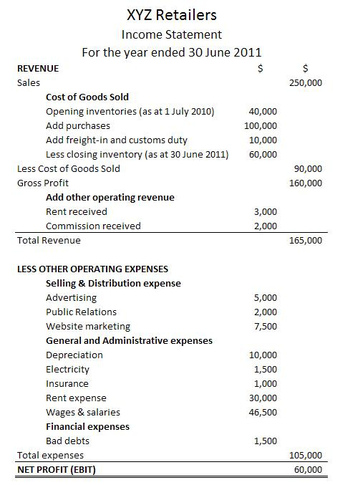
A Sample Income Statement
Expenses are listed on a company’s income statement.
Return on Total Assets
Return on total assets equals the total net income the business earns in a given accounting period divided by the average value of the business’s total assets for the same period. You calculate the average value of the total assets by adding the value of the business’s total assets at the beginning of the period and the value of the business’s total assets at the end of the period. You then divide the sum by two.
Return on Total Fixed Assets
Return on Total Fixed Assets equals the business’s net income divided by the average value of the business’s total fixed assets for the accounting period. You calculate the average value of the business’s fixed assets by adding the value of the business’s total fixed assets at the beginning of the accounting period to the value of the total fixed assets at the end of the period. You then divide the sum by two.
Using Return on Assets to Assess Company Performance
The greater the value of the ratio, the better a company is performing. However, merely determining a business’s return on asset ratio is insufficient to get a good understanding on how a business is doing. To accurately gauge a company’s performance, you need to put the value in context. This is generally done by comparing the current return on assets ratio to the company’s past performance or to a competitor’s ratio.
6.9.3: Asset Turnover Ratio
The asset turnover ratio is a measure of how well a business is using all of its assets to generate sales.
Learning Objective
State the formula to calculate the asset turnover ratio
Key Points
- Asset\quad Turnover\quad =\frac { Net\quad Sales\quad Revenue }{ Average\quad Total\quad Assets }.
- \quad \frac { Net\quad Sales }{ Average\quad Net\quad Fixed\quad Assets } = Fixed Asset Turnover Ratio.
- All Asset Turnover Ratios must be judged in context. This is generally done by comparing the ratio’s value to the business’s ratios in prior accounting periods or to its competitors’ asset turnover ratios.
Key Term
- fixed asset
-
Asset or property which cannot easily be converted into cash, such as land, buildings, and machinery.
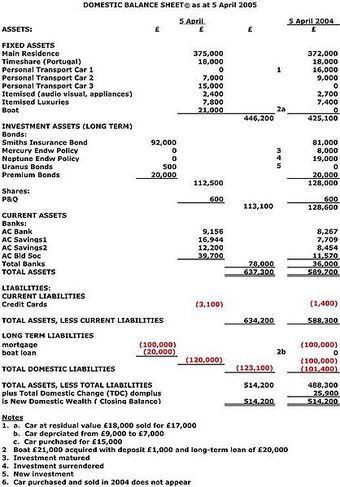
Balance Sheet
The balance sheet is where you will find information regarding the value of the business’s assets, which is necessary to calculate the business’s asset turnover ratio.
It can be difficult to review a company’s balance sheet and get much meaning out of it with just a glance. While it may be impressive that a business has millions of dollars worth of equipment, it is hard to determine what that means from a business perspective.
One way of putting those values into context is to use them to generate ratios. One ratio that analysts use to evaluate a company’s strength is the asset turnover ratio.
Asset Turnover Ratio
The asset turnover ratio is a measure of how well a business is using all of its assets to generate sales. The ratio is calculated by dividing the total sales for the accounting period by the average value of the assets the business owned during the year. The average value is calculated by adding the value of assets the business owned at the beginning of the period to the value of the assets owned at the end of the period, and then dividing by two.
Fixed-Asset Turnover Ratio
The fixed-asset turnover ratio is calculated in a similar manner, except instead of focusing all of the business’s assets, the ratio is calculated using the business’s fixed assets. This ratio measures how well a business is using its fixed assets to generate sales. To calculate the fixed asset turnover ratio, divide the total sales for the accounting period by the average fixed asset balance for the accounting period. The average fixed asset balance equals the beginning balance of fixed assets for the period plus the ending balance of fixed assets for the period, then dividing by two.
How to Use These Ratios
The higher the ratio, the better the business is performing in terms of sales. However, these ratios generally need context to better understand them. While a ratio may appear low by itself, it may actually be doing well overall. Generally, an analyst will compare a business’s asset turnover ratio to the business’s ratios from prior accounting periods or to the business’s competitor’s asset turnover ratio for the same period.
Chapter 5: Controlling and Reporting of Inventories
5.1: Understanding Inventory
5.1.1: Nature of Inventory
Inventory represents finished and unfinished goods which have not yet been sold by a company.
Learning Objective
Explain the purpose of inventory and how a company controls and reports it
Key Points
- Inventories are maintained because time lags in moving goods to customers could put sales at risk.
- Inventories are maintained as buffers to meet uncertainties in demand, supply and movements of goods.
- There are four stages of inventory: raw material, work in progress, finished goods, and goods for resale.
- Raw materials – materials and components scheduled for use in making a product. Work in process, WIP – materials and components that have began their transformation to finished goods. Finished goods – goods ready for sale to customers. Goods for resale – returned goods that are salable.
- When a merchant buys goods from inventory, the value of the inventory account is reduced by the cost of goods sold. For commodity items that one cannot track individually, accountants must choose a method that fits the nature of the sale.
- FIFO (first in-first out) regards the first unit that arrived in inventory as the first sold. LIFO (last in-first out) considers the last unit arriving in inventory as the first sold. Using LIFO accounting for inventory a company reports lower net income and book value, resulting in lower taxation.
Key Terms
- raw material
-
A material in its unprocessed, natural state considered usable for manufacture.
- inventory
-
A detailed list of all of the items on hand.
- supply chain
-
A system of organizations, people, technology, activities, information and resources involved in moving a product or service from supplier to customer.
Example
- A canned food manufacturer’s materials inventory includes the ingredients to form the foods to be canned, empty cans and their lids (or coils of steel or aluminum for constructing those components), labels, and anything else (solder, glue, etc.) that will form part of a finished can. The firm’s work in process includes those materials from the time of release to the work floor until they become complete and ready for sale to wholesale or retail customers. This may be vats of prepared food, filled cans not yet labeled or sub-assemblies of food components. It may also include finished cans that are not yet packaged into cartons or pallets. Its finished good inventory consists of all the filled and labeled cans of food in its warehouse that it has manufactured and wishes to sell to food distributors (wholesalers), to grocery stores (retailers), and even perhaps to consumers through arrangements like factory stores and outlet centers.
Definition of Inventory
Inventory represents finished and unfinished goods which have not yet been sold by a company. . Inventories are maintained as buffers to meet uncertainties in demand, supply, and movements of goods. These holdings are recorded in an accounting system .
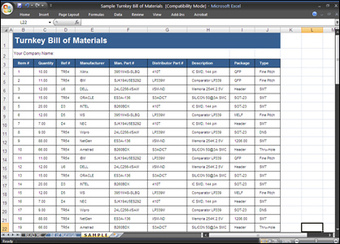
Inventory Template
Example of inventory template.
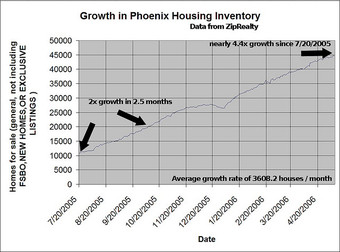
Housing inventory growth in Phoenix
There was an interesting comment on the housing bubble blog listing “available inventory”, otherwise known as the number of houses currently for sale, in Phoenix. It listed the available inventory on a daily basis from 7/20/2006 to 5/9/2006 (up to the day it was posted! )Phoenix is one of the “hot” markets of the housing bubble, but certainly isn’t the top of the list. Inventory run ups like this are being seen nation wide, and are leading to price reductions (if the seller is smart) and long waits to sell as bubble flippers all try to cash out at once.
Basic Inventory Accounting
An organization’s inventory counts as a current asset on an organization’s balance sheet because the organization can, in principle, turn it into cash by selling it. However, it ties up money that could serve for other purposes and requires additional expense for its protection. Inventory may also cause significant tax expenses, depending on particular countries’ laws regarding depreciation of inventory, as in the case of Thor Power Tool Company v. Commissioner.
Inventory Systems
There are two principal systems for determining inventory quantities on hand: periodic and perpetual system.
The Periodic System
This system requires a physical count of goods on hand at the end of a period. A cost basis (i.e., FIFO, LIFO) is then applied to derive an inventory value. Because it is simple and requires records and adjustments mostly at the end of a period, it is widely used. It does lack some of the planning and control benefits of the perpetual system.
The Perpetual System
The perpetual system requires continuous recording of receipt and disbursement for every item of inventory. Most large manufacturing and merchandising companies use this system to ensure adequate supplies are on hand for production or sale, and to minimize costly machine shut-downs and customer complaints.
Inventory Costing
Inventory cost includes all expenditures relating to inventory acquisition, preparation, and readiness for sale, minus purchase discounts.
Rationale for Keeping Inventory:
- Time – The time lags present in the supply chain, from supplier to user at every stage, requires that you maintain certain amounts of inventory to use in this lead time. However, in practice, inventory is to be maintained for consumption during ‘variations in lead time’. Lead time itself can be addressed by ordering that many days in advance.
- Uncertainty – Inventories are maintained as buffers to meet uncertainties in demand, supply and movements of goods.
- Economies of scale – Ideal condition of “one unit at a time at a place where a user needs it, when he needs it” principle tends to incur lots of costs in terms of logistics. So bulk buying, movement and storing brings in economies of scale, thus inventory.
Stages of Inventory:
- Raw materials – materials and components scheduled for use in making a product.
- Work in process, WIP – materials and components that have began their transformation to finished goods.
- Finished goods – goods ready for sale to customers.
- Goods for resale – returned goods that are salable.
5.1.2: Categories of Goods Included in Inventory
Most manufacturing organizations usually divide their “goods for sale” inventory into raw materials, work in process, and finished goods.
Learning Objective
Distinguish between the raw materials, work in process, finished goods and goods for resale
Key Points
- Raw materials – Materials and components scheduled for use in making a product.
- Work in process/progress (WIP) – Materials and components that have began their transformation to finished goods.
- Finished goods – Goods ready for sale to customers.
- Goods for resale – Returned goods that are salable.
- Distressed inventory is inventory for which the potential to be sold at a normal cost has passed or will soon pass.
- Inventory credit refers to the use of stock, or inventory, as collateral to raise finance.
Key Terms
- raw materials
-
A raw material is the basic material from which a product is manufactured or made.
- finished goods inventory
-
the amount of completed products not yet sold or distributed to the end-user
- Finished goods
-
Goods that are completed, from a manufacturing standpoint, but not yet sold or distributed to the end-user.
- work in progress
-
A portion of inventory that represents goods which are no longer salable as raw materials, but not yet salable as finished goods.
- Work in process
-
a company’s partially finished goods waiting for completion and eventual sale or the value of these items
Example
- A canned food manufacturer’s materials inventory includes the ingredients to form the foods to be canned, empty cans and their lids (or coils of steel or aluminum for constructing those components), labels, and anything else (solder, glue, etc.) that will form part of a finished can. The firm’s work in process includes those materials from the time of release to the work floor until they become complete and ready for sale to wholesale or retail customers. This may be vats of prepared food, filled cans not yet labeled or sub-assemblies of food components. It may also include finished cans that are not yet packaged into cartons or pallets. Its finished good inventory consists of all the filled and labeled cans of food in its warehouse that it has manufactured and wishes to sell to food distributors (wholesalers), to grocery stores (retailers), and even perhaps to consumers through arrangements like factory stores and outlet centers.
Categories of Goods
While the reasons for holding stock were covered earlier, most manufacturing organizations usually divide their “goods for sale” inventory into several categories:
- Raw materials – Materials and components scheduled for use in making a product.
- Work in process or work in progress (WIP) – Materials and components that have began their transformation to finished goods.
- Finished goods – Goods ready for sale to customers.
- Goods for resale – Returned goods that are salable .
Raw Materials
A raw material is the basic material from which a product is manufactured or made. For example, the term is used to denote material that came from nature and is in an unprocessed or minimally processed state. Latex, iron ore, logs, crude oil, and salt water are examples of raw materials.
Work in Process (WIP)
WIP, or in-process inventory, includes unfinished items for products in a production process. These items are not yet completed, and are just being fabricated, waiting in a queue for further processing, or in a buffer storage. The term is used in production and supply chain management.
Optimal production management aims to minimize work in process. Work in process requires storage space, represents bound capital not available for investment, and carries an inherent risk of earlier expiration of the shelf life of the products. A queue leading to a production step shows that the step is well buffered for shortage in supplies from preceding steps, but may also indicate insufficient capacity to process the output from these preceding steps.
Finished Goods
Goods that are completed (manufactured) but not yet sold or distributed to the end-user.
Goods for resale
Returned goods that are salable. This is not always included in the “goods for sale” inventory; that depends on the preference of the company.
Example
A canned food manufacturer’s materials inventory includes the ingredients needed to form the foods to be canned, empty cans and their lids (or coils of steel or aluminum for constructing those components), labels, and anything else (solder, glue, etc.) that will form part of a finished can. The firm’s work in process includes those materials from the time of release to the work floor until they become complete and ready for sale to wholesale or retail customers. This may be vats of prepared food, filled cans not yet labeled, or sub-assemblies of food components. It may also include finished cans that are not yet packaged into cartons or pallets. The manufacturer’s finished good inventory consists of all the filled and labeled cans of food in its warehouse that it has manufactured and wishes to sell to food distributors (wholesalers), to grocery stores (retailers), and even perhaps to consumers through arrangements like factory stores and outlet centers.
5.1.3: Components of Inventory Cost
The cost of goods produced in the business should include all costs of production: parts, labor, and overhead.
Learning Objective
Identify the components used to calculate the cost of goods sold
Key Points
- Labor costs include direct labor and indirect labor. Direct labor costs are the wages paid to those employees who spend all their time working directly on the product being manufactured. Indirect labor costs are the wages paid to other factory employees involved in production.
- Overhead costs (costs incurred at the plant or organization level) are often allocated to sets of produced goods based on the ratio of labor hours or costs or the ratio of materials used for producing the set of goods.
- Most businesses make more than one of a particular item. Thus, costs are incurred for multiple items rather than a particular item sold. Parts and raw materials are often tracked to particular sets (e.g., batches or production runs) of goods, then allocated to each item.
Key Terms
- raw materials
-
A raw material is the basic material from which a product is manufactured or made.
- labor
-
Effort expended on a particular task; toil, work.
- overhead
-
Any cost or expenditure (monetary, time, effort or otherwise) incurred in a project or activity, that does not directly contribute to the progress or outcome of the project or activity.
Cost of Goods
The cost of goods produced in the business should include all costs of production. The key components of cost generally include:
- Parts, raw materials and supplies used,
- Labor, including associated costs such as payroll taxes and benefits, and
- Overhead of the business allocable to production.
Most businesses make more than one of a particular item. Thus, costs are incurred for multiple items rather than a particular item sold. Determining how much of each of these components to allocate to particular goods requires either tracking the particular costs or making some allocations of costs.
Parts and Raw Materials
Parts and raw materials are often tracked to particular sets (e.g., batches or production runs) of goods, then allocated to each item.
Labor
Labor costs include direct labor and indirect labor. Direct labor costs are the wages paid to those employees who spend all their time working directly on the product being manufactured. Indirect labor costs are the wages paid to other factory employees involved in production. Costs of payroll taxes and fringe benefits are generally included in labor costs, but may be treated as overhead costs. Labor costs may be allocated to an item or set of items based on timekeeping records.
Overhead Costs
Determining overhead costs often involves making assumptions about what costs should be associated with production activities and what costs should be associated with other activities. Traditional cost accounting methods attempt to make these assumptions based on past experience and management judgment as to factual relationships. Activity based costing attempts to allocate costs based on those factors that drive the business to incur the costs.
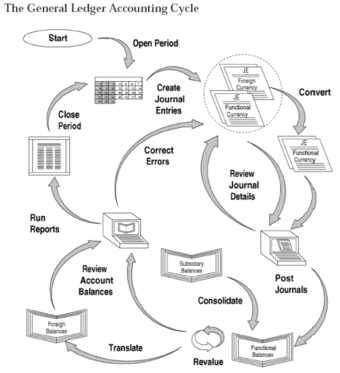
Accounting cycle
Image of the accounting cycle
Overhead costs are often allocated to sets of produced goods based on the ratio of labor hours or costs or the ratio of materials used for producing the set of goods. Overhead costs may be referred to as factory overhead or factory burden for those costs incurred at the plant level or overall burden for those costs incurred at the organization level. Where labor hours are used, a burden rate or overhead cost per hour of labor may be added along with labor costs. Other methods may be used to associate overhead costs with particular goods produced. Overhead rates may be standard rates, in which case there may be variances, or may be adjusted for each set of goods produced.
Variable Production Overheads
Variable production overheads are allocated to units produced based on actual use of production facilities. Fixed production overheads are often allocated based on normal capacities or expected production. More or fewer goods may be produced than expected when developing cost assumptions (like burden rates). These differences in production levels often result in too much or too little cost being assigned to the goods produced. This also gives rise to variances.
Example
Jane owns a business that resells machines. At the start of 2009, she has no machines or parts on hand. She buys machines
and
for $10 each, and later buys machines
and
for $12 each. All the machines are the same, but they have serial numbers. Jane sells machines
and
for $20 each. Her cost of goods sold depends on her inventory method. Under specific identification, the cost of goods sold is:
which is the particular costs of machines
and
. If she uses FIFO, her costs are:
If she uses average cost, her costs are:
If she uses LIFO, her costs are:
Thus, her profit for accounting and tax purposes may be $20, $18, or $16, depending on her inventory method.
5.1.4: Flow of Inventory Costs
Accounting techniques are used to manage assumptions of cost flows related to inventory and stock repurchases.
Learning Objective
Discuss how a company uses LIFO or FIFO to calculate the cost of inventory
Key Points
- Accounting techniques are used to manage inventory and financial matters – how much money a company has tied up within inventory of produced goods, raw materials, parts, components, etc. These techniques manage assumptions of cost flows related to inventory and stock repurchases .
- FIFO stands for first-in, first-out, meaning that the oldest inventory items are recorded as sold first, but do not necessarily mean that the exact oldest physical object has been tracked and sold.
- LIFO stands for last-in first-out. The most recently produced items are recorded as sold first. Since the 1970’s, companies shifted towards the use of LIFO, which reduces their income taxes. The International Financial Reporting Standards banned using LIFO, so companies returned to FIFO.
Key Terms
- accounting
-
The development and use of a system for recording and analyzing the financial transactions and financial status of a business or other organization.
- FIFO
-
First in, first out (accounting).
- LIFO
-
Last-in, first-out (accounting).
Example
- A canned food manufacturer’s materials inventory includes the ingredients to form the foods to be canned, empty cans and their lids (or coils of steel or aluminum for constructing those components), labels, and anything else (solder, glue, etc.) that will form part of a finished can. The firm’s work in process includes those materials from the time of release to the work floor until they become complete and ready for sale to wholesale or retail customers. This may be vats of prepared food, filled cans not yet labeled or sub-assemblies of food components. It may also include finished cans that are not yet packaged into cartons or pallets. Its finished goods inventory consists of all the filled and labeled cans of food in its warehouse that it has manufactured and wishes to sell to food distributors (wholesalers), to grocery stores (retailers), and even perhaps to consumers through arrangements like factory stores and outlet centers.
FIFO and LIFO methods are accounting techniques used in managing inventory and financial matters involving the amount of money a company has tied up within inventory of produced goods, raw materials, parts, components, or feed stocks. These methods are used to manage assumptions of cost flows related to inventory, stock repurchases (if purchased at different prices), and various other accounting purposes.
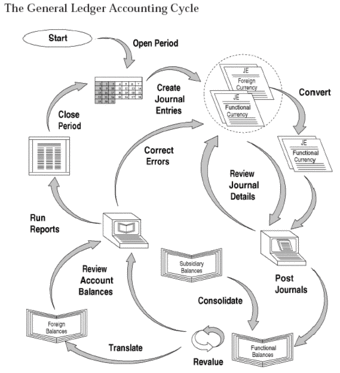
Accounting Cycle
The accounting cycle (flows).
FIFO stands for first-in, first-out, meaning that the oldest inventory items recorded first are sold first, but does not necessarily mean that the exact oldest physical object has been tracked and sold.
- An example of how to calculate the ending inventory balance of the period using FIFO — assume the following inventory is on hand and purchased on the following dates:
- Inventory of Product X –
- Purchase date: 10/1/12 — 10 units at a cost of USD 5
- Purchase date: 10/5/12 — 5 units at a cost of USD 6
- On 12/30/12, a sale of Product X is made for 11 units
- When the sale is made, it is assumed that the 10 units purchased on 10/1/12 (the sale eliminates this inventory layer) and 1 unit purchased on 10/5/12 were sold
- The ending inventory balance on 12/31/12, is 4 units at a cost of USD 6
LIFO stands for last-in, first-out, meaning that the most recently produced items are recorded as sold first. Since the 1970’s, some U.S. companies shifted towards the use of LIFO, which reduces their income taxes in times of inflation. However, with International Financial Reporting Standards banning the use of LIFO, more companies have gone back to FIFO. LIFO is only used in Japan and the United States.
- An example of how to calculate the ending inventory balance of the period using LIFO — assume the following inventory is on hand and purchased on the following dates:
- Inventory of Product X –
- Purchase date: 10/1/12 — 10 units at a cost of USD 5
- Purchase date: 10/5/12 — 5 units at a cost of USD 6
- On 12/30/12, a sale of Product X is made for 11 units
- When the sale is made, it is assumed that the 5 units purchased on 10/5/12 (the sale eliminates this inventory layer) and 6 units purchased on 10/1/12 were sold
- The ending inventory balance on 12/31/12, is 4 units at a cost of USD 5
Differences between Inventory Costing Methods
The difference between the cost of an inventory calculated under the FIFO and LIFO methods is called the LIFO reserve. This reserve is essentially the amount by which an entity’s taxable income has been deferred by using the LIFO method.
Differences in Periods of Rising Prices (Inflation)
- FIFO (+) Higher value of inventory (-) Lower cost of goods sold
- LIFO (-) Lower value of inventory (+) Higher cost of goods sold
Differences in Periods of Falling Prices (Deflation)
- FIFO (-) Lower value of inventory (+) Higher cost of goods sold
- LIFO (+) Higher value on inventory (-) Lower cost on goods sold
Methods of Preparing Cash Flow Statements
- The direct method of preparing a cash flow statement results in report that is easier to understand. It creates a cash flow statement report using major classes of gross cash receipts and payments.
- The indirect method is almost universally used because FAS 95 requires a supplementary report similar to the indirect method if a company chooses to use the direct method. It uses net-income as a starting point, makes adjustments for all transactions for non-cash items, then adjusts from all cash-based transactions. An increase in an asset account is subtracted from net income. An increase in a liability account is added back to net income. This method converts accrual-basis net income (or loss) into cash flow by using a series of additions and deductions.
5.2: Controlling Inventory
5.2.1: Internal Controls
Inventory internal controls ensure that a company has sufficient resources to meet its customers’ needs without having too much goods.
Learning Objective
Explain how a company would use storage, inventory management systems and inventory counts to control inventory
Key Points
- Companies should store inventory in secure spacious warehouses so that inventory is not stolen or damaged. Goods and resources of the same or similar type should be kept in the same general area of the warehouse to minimize confusion and to ensure accurate counts.
- An inventory management system is a series of procedures, often aided by computer software, that tracks assets progression through inventory. A properly used and maintained inventory management system allows management to be able to know how much inventory it has at any given time.
- Detailed physical inventory counts are a way of ensuring that a company’s inventory management system is accurate and as a check to make sure goods are not being lost or stolen. A physical count of a company’s entire inventory is generally taken prior to the issuance of a company’s balance sheet.
- To conduct a cycle count, an auditor will select a small subset of inventory, in a specific location, and count it on a specified day. The auditor will then compare the count to the related information in the inventory management system to ensure the information in the system is correct.
Key Terms
- internal auditor
-
one who conducts an independent, objective assurance and consulting activity designed to add value and improve an organization’s operations
- physical inventory count
-
Physical inventory is a process where a business physically counts its entire inventory. A physical inventory may be mandated by financial accounting rules or the tax regulations to place an accurate value on the inventory, or the business may need to count inventory so component parts or raw materials can be restocked. Businesses may use several different tactics to minimize the disruption caused by physical inventory.
- cycle counts
-
Process by which an auditor selects a small subset of inventory and counts it to ensure that it matches the information in the company’s inventory management system. Meant to test the accuracy of inventory system.
Internal controls over a company’s inventory are meant to ensure that management has an accurate count of what materials and goods it has available for sale and to protect those goods from being spoiled, stolen or otherwise made unavailable for sale. In short, inventory internal controls are meant to ensure that a company always has sufficient resources to produce and sell goods to meet its customers’ needs without having oversupply.
This process is affected by the company’s structure, its employees, and its informational systems. Since a company’s inventory is directly tied to the business’s ability to generate profit, the internal controls must be comprehensive and require significant thought when being designed.
Storage
Companies should store inventory in secure, spacious warehouses so that inventory is not stolen or damaged. Goods and resources of the same or similar type should be kept in the same general area of the warehouse to minimize confusion and to ensure accurate counts.
Inventory Management Systems
An inventory management system is a series of procedures, often aided by computer software, that tracks assets progression through inventory. For example, assume a set amount of raw material is acquired by the company. When the company receives that material, the amount should be noted in the inventory management system. As the material is processed into the goods for resale, the amount of raw material used should be deducted from the “raw material inventory” and the amount of goods that result from the process should be added to the “finished goods inventory. ” As each finished item is sold, the “finished goods inventory” should be decreased by that amount.
The benefit of a properly used and maintained inventory management system is that it allows management to be able to know how much inventory it has at any given time.
Physical Inventory Count
Physical inventory counts are a way of ensuring that a company’s inventory management system is accurate and as a check to make sure goods are not being lost or stolen. A detailed physical count of a company’s entire inventory is generally taken prior to the issuance of a company’s balance sheet, to ensure that the company accurately report its inventory levels.

Keeping track of Inventory
Clerk conducting physical inventory count using a handheld computer in a Tesco Lotus supermarket in Sakon Nakhon, Thailand
Cycle Counts
Companies usually conduct cycle counts periodically throughout an accounting period as a means to ensure that the information in its inventory management system is correct. To conduct a cycle count, an auditor will select a small subset of inventory, in a specific location, and count it on a specified day. The auditor will then compare the count to the related information in the inventory management system. If the counts match, no further action is taken. If the numbers differ, the auditor will take additional steps to determine why the counts do not match.
Cycle counts contrast with traditional physical inventory in that a full physical inventory may stop operation at a facility while all items are counted at one time. Cycle counts are less disruptive to daily operations, provide an ongoing measure of inventory accuracy and procedure execution, and can be tailored to focus on items with higher value, higher movement volume, or that are critical to business processes. Cycle counting should only be performed in facilities with a high degree of inventory accuracy.
5.2.2: Perpetual vs. Periodic Counting
Perpetual inventory updates the quantities continuously and periodic inventory updates the amount only at specific times, such as year end.
Learning Objective
Explain the differences between perpetual inventory and periodic inventory
Key Points
- Perpetual inventory, also called continuous inventory, is when information about amount and availability of the product is updated continuously, usually via computer.
- Periodic inventory is a system of inventory in which updates are made on a periodic basis.
- Theft, breakage, or untracked movement can cause the perpetual inventory to be inaccurate.
Key Terms
- periodic inventory system
-
accounting for goods and materials held for eventual sale that is not continually updated
- perpetual
-
Continuing uninterrupted
- breakage
-
Something that has been broken.
Perpetual Inventory
Perpetual inventory, also called continuous inventory, is when information about amount and availability of a product is updated continuously. Generally, this is accomplished by connecting the inventory system either with the order entry system or for a retail establishment the point of sale system.
A company using the perpetual inventory system would have a book inventory that is exactly (within a small margin of error) the same as the physical (real) inventory.
Periodic Inventory
Periodic inventory is when information about amount and availability of a product is updated only periodically. Physical inventories are conducted at set time intervals; both cost of goods sold and the inventory are adjusted at the time of the physical inventory. Most companies who use periodic inventory perform this at year-end.
Periodic vs. Perpetual
In earlier periods, non-continuous or periodic inventory systems were more prevalent. Many small businesses still only have a periodic system of inventory.
Perpetual inventory systems can still be vulnerable to errors due to overstatements (phantom inventory) or understatements (missing inventory) that occurs as a result of theft, breakage, scanning errors, or untracked inventory movements. These errors lead to systematic errors in replenishment.

Periodic inventory is performed once a year.
Physically counting inventory ensures that book value and physical value are the same.
While the perpetual inventory method provides a close picture of the true inventory information, it is a good idea for companies using a perpetual inventory system to do a physical inventory periodically.
5.2.3: Conducting a Physical Inventory
There are three phases of a physical inventory: planning and preparation, execution, and analysis of results.
Learning Objective
Identify the three phases of a physical inventory
Key Points
- Physical inventory is a process where a business physically counts its entire inventory.
- In the planning and preparation period, a list of stocks which is supposed to be counted are set up. Different teams are then assigned to count the stock.
- Each team counts a specific inventory. The results are recorded on the inventory listing sheet.
- The physicial count is compared to the computer count. The company must note any discrepancies between the actual number and the computer system, recount these inventory items to determine the correct quantity, and adjust the computer inventory quantity if needed.
- Any discrepancies between the actual number and the computer system must be fixed.
Key Terms
- perpetual inventory system
-
Perpetual inventory or continuous inventory updates information on inventory quantity and availability on a continuous basis as a function of doing business. Generally this is accomplished by connecting the inventory system with order entry and in retail the point of sale system.
- cycle counting
-
A cycle count is an inventory auditing procedure, which falls under inventory management, where a small subset of inventory, in a specific location, is counted on a specified day. Cycle counts contrast with traditional physical inventory in that a full physical inventory may stop operation at a facility while all items are counted at one time. Cycle counts are less disruptive to daily operations, provide an ongoing measure of inventory accuracy and procedure execution, and can be tailored to focus on items with higher value, higher movement volume, or that are critical to business processes.
Conducting a Physical Inventory
Physical inventory is a process where a business physically counts its entire inventory. Companies perform a physical inventory for several reasons including to satisfy financial accounting rules or tax regulations, or to compile a list of items for restocking.
Most companies choose to do a physical inventory at year-end.
Businesses may use several different tactics to minimize the disruption caused by physical inventory. For instance, inventory services provide labor and automation to quickly count inventory and minimize shutdown time.
In addition, inventory control system software can speed the physical inventory process . A perpetual inventory system tracks the receipt and use of inventory, and calculates the quantity on hand. Cycle counting, an alternative to physical inventory, may be less disruptive.

A company’s inventory is a valuable asset.
An inventory control system ensures that the company’s books reflect the actual inventory on hand.
The Phases Of Physical Inventory
There are three phases of a physical inventory:
- Planning and preparation
- Execution
- Analysis of results
Planning and Preparation
In the planning and preparation period, a list of stocks that need to be counted is set up. Teams are then assigned and sent to count the stock.
Execution
The teams count the inventory items and record the results on an inventory-listing sheet.
Analysis Of Results
When analyzing the results, a company must compare the inventory counts submitted by each team with the inventory count from the computer system. If any discrepancies occur between the actual number and the computer system, it may be necessary to recount the disputed inventory items to determine the correct quantity. After the final amounts are determined, the company must make an adjusting entry to the computer inventory.
5.2.4: Impact of Measurement Error
Measurement error leads to systematic errors in replenishment and inaccurate financial statements.
Learning Objective
Explain how a measurement error affects a company’s inventory value
Key Points
- In inventory controlling, measurement error is the difference between the actual number of stocks and the value obtained by measurement.
- Inventory systems can be vulnerable to errors due to overstatements (phantom inventory) or understatements (missing inventory). Overstatements and understatements can occur as a result of theft, breakage, scanning errors or untracked inventory movements.
- Based on inaccurate measurement data, the company will make either excessive orders or late orders which then may cause production disruption. In sum, systematic measurement error can lead to errors in replenishment.
- An incorrect inventory balance causes an error in the calculation of cost of goods sold and, therefore, an error in the calculation of gross profit and net income.
Key Term
- phantom inventory
-
Phantom inventory is a common expression for goods that an inventory accounting system considers to be on-hand at a storage location, but are not actually available. This could be due to the items being moved without recording the change in the inventory accounting system, breakage, theft data entry errors or deliberate fraud. The resulting discrepancy between the online inventory balance and physical availability can delay automated reordering and lead to out-of-stock incidents. If not addressed, phantom inventory can also result in broader accounting issues and restatements.
Measurement Error Impacts
Measurement error is the difference between the true value of a quantity and the value obtained by measurement. The two main types of error are random errors and systematic errors. In inventory controlling, measurement error is the difference between the actual number of stocks and the value obtained by measurement.
Inventory systems can be vulnerable to errors due to overstatements (phantom inventory) when the actual inventory is lower than the measurement or understatements (missing inventory) when the actual stocks are higher than the measurement. Overstatements and understatements can occur as a result of theft, breakage, scanning errors or untracked inventory movements. It is quite easy to overlook goods on hand, count goods twice, or simply make mathematical mistakes.

Physical inventory
Female clerk doing inventory work using a handheld computer in a Tesco Lotus supermarket in Sakon Nakhon, Thailand
Based on inaccurate measurement data, the company will make either excessive orders or late orders which then may cause production disruption. In sum, systematic measurement error can lead to errors in replenishment.
Inventory controlling helps revenue and expenses be recognized. As a result, an incorrect inventory balance causes an error in the calculation of cost of goods sold and, therefore, an error in the calculation of gross profit and net income. A general rule is that overstatements of ending inventory cause overstatements of income, while understatements of ending inventory cause understatements of income. Since financial statement users depend upon accurate statements, care must be taken to ensure that the inventory balance at the end of each accounting period is correct. It is also vital that accountants and business owners fully understand the effects of inventory errors and grasp the need to be careful to get these numbers as correct as possible.
5.3: Valuing Inventory
5.3.1: Costing Methods Overview
There are four accepted methods of costing items: specific identification; first-in, first-out; last-in, first-out; and weighted-average.
Learning Objective
Review the differences between the four cost accounting methods and demonstrate how to calculate the cost of goods sold
Key Points
- Cost accounting is regarded as the process of collecting, analyzing, summarizing, and evaluating various alternative courses of action involving costs and advising the management on the most appropriate course of action based on the cost efficiency and capability of the management.
- The specific identification method of inventory costing attaches the actual cost to an identifiable unit of product. Firms find this method easy to apply when purchasing and selling large inventory items such as cars.
- The FIFO (first-in, first-out) method of inventory costing assumes that the costs of the first goods purchased are those charged to cost of goods sold when the company actually sells goods.
- The LIFO (last-in, first-out) method of inventory costing assumes that the costs of the most recent purchases are the first costs charged to cost of goods sold when the company actually sells the goods.
- The weighted-average method of inventory costing is a means of costing ending inventory using a weighted-average unit cost. Companies most often use the weighted-average method to determine a cost for units that are basically the same.
- Beginning Inventory + Purchases = Available for Sale – Ending Inventory = Cost of Good Sold.
Key Terms
- inventory
-
A detailed list of all of the items on hand.
- costing
-
The estimation of the cost of a process or product.
- raw materials
-
A raw material is the basic material from which a product is manufactured or made.
Costing Methods Overview
Cost accounting information is designed for managers. Since managers are making decisions only for their own organization, there is no need for the information to be comparable to similar information from other organizations. Instead, the important criterion is that the information must be relevant for decisions that managers, operating in a particular environment of business including strategy, make. Cost accounting information is commonly used in financial accounting information, but first we are concentrating on its use by managers to take decisions. The accountants who handle the cost accounting information add value by providing good information to managers who are making decisions. Among the better decisions, is the better performance of one’s organization, regardless if it is a manufacturing company, a bank, a non-profit organization, a government agency, a school club or even a business school. The cost-accounting system is the result of decisions made by managers of an organization and the environment in which they make them .

Efficient use of inventory is critical for businesses.
Inventory at a business.
Cost accounting is regarded as the process of collecting, analyzing, summarizing, and evaluating various alternative courses of action involving costs and advising the management on the most appropriate course of action based on the cost efficiency and capability of the management.
The following are different cost accounting approaches:
- standardized or standard cost accounting
- lean accounting
- activity-based costing
- resource consumption accounting
- throughput accounting
- marginal costing/cost-volume-profit analysis
Classical cost elements for a manufacturing business are:
-
Raw materials
- Labor
- Indirect expenses/overhead
Accepted Financial Costing Methods
There are four accepted methods of costing inventory items:
- specific identification;
- first-in, first-out (FIFO);
- last-in, first-out (LIFO); and
- weighted-average.
Each method has advantages and disadvantages. Note that a manufacturing business’s inventory will consist of work in process, or unfinished goods, and finished inventory; the costs of unfinished and finished inventory contain a combination of costs related to raw materials, labor, and overhead. On the other hand, a retailer’s inventory consists of all finished products purchased from a wholesaler or manufacturer; the costs of their units are based on their acquisition cost rather than the costs associated with manufacturing units.
Specific Identification
The specific identification method of inventory costing attaches the actual cost to an identifiable unit of product. Firms find this method easy to apply when purchasing and selling large inventory items such as cars. Under the specific identification method, the firm must identify each unit in inventory, unless it is unique, with a serial number or identification tag.
FIFO (first-in, first-out)
The FIFO (first-in, first-out) method of inventory costing assumes that the costs of the first goods purchased are those charged to cost of goods sold when the company actually sells goods. This method assumes the first goods purchased are the first goods sold. In some companies, the first units in (bought) must be the first units out (sold) to avoid large losses from spoilage. Such items as fresh dairy products, fruits, and vegetables should be sold on a FIFO basis. In these cases, an assumed first-in, first-out flow corresponds with the actual physical flow of goods.
LIFO (last-in, first-out)
The LIFO (last-in, first-out) method of inventory costing assumes that the costs of the most recent purchases are the first costs charged to cost of goods sold when the company actually sells the goods.
Weighted-average
The weighted-average method of inventory costing is a means of costing ending inventory using a weighted-average unit cost. Companies most often use the weighted-average method to determine a cost for units that are basically the same, such as identical games in a toy store or identical electrical tools in a hardware store. Since the units are alike, firms can assign the same unit cost to them.
Calculating Cost of Goods Sold (periodic method)
Beginning Inventory + Purchases = Available for Sale
Available – Ending Inventory = Cost of Good Sold
5.3.2: Specific Identification Method
Specific identification is a method of finding out ending inventory cost that requires a detailed physical count.
Learning Objective
Describe how a company would use the specific identification method to value inventory
Key Points
- Specific identification is a method of finding out ending inventory cost. It requires a detailed physical count, so that the company knows exactly how many of each goods brought on specific dates remained at year end inventory.
- In theory, this method is the best method, since it relates the ending inventory goods directly to the specific price they were bought for. However, management can easily manipulate ending inventory cost, since they can choose to report that cheaper goods were sold first, ultimately raising income.
- Alternatively, management can choose to report lower income, to reduce the taxes they needed to pay.
Key Terms
- serial number
-
A unique number, assigned to a particular unit of some product, to identify it.
- inventory
-
A detailed list of all of the items on hand.
- accounting
-
The development and use of a system for recording and analyzing the financial transactions and financial status of a business or other organization.
- specific identification method
-
inventory measurement based on the exact number of goods in inventory and their purchase price
Example
- Assume that the company in can identify the 20 units on hand at year-end as 10 units from the August 12 purchase and 10 units from the December 21 purchase. The company computes the ending inventory as shown in. It subtracts the USD 181 ending inventory cost from the USD 690 cost of goods available for sale to obtain the USD 509 cost of goods sold. Note that you can also determine the cost of goods sold for the year by recording the cost of each unit sold. The USD 509 cost of goods sold is an expense on the income statement, and the USD 181 ending inventory is a current asset on the balance sheet. The specific identification costing method attaches cost to an identifiable unit of inventory. The method does not involve any assumptions about the flow of the costs as in the other inventory costing methods. Conceptually, the method matches the cost to the physical flow of the inventory and eliminates the emphasis on the timing of the cost determination. Therefore, periodic and perpetual inventory procedures produce the same results for the specific identification method.
Types of Accounting Methods
The merchandise inventory figure used by accountants depends on the quantity of inventory items and the cost of the items. There are four accepted methods of costing the items: (1) specific identification; (2) first-in, first-out (FIFO); (3) last-in, first-out (LIFO); and (4) weighted-average. Each method has advantages and disadvantages.
General Information
Specific identification is a method of finding out ending inventory cost. It requires a detailed physical count, so that the company knows exactly how many of each goods brought on specific dates remained at year-end inventory. When this information is found, the amount of goods is multiplied by their purchase cost at their purchase date, to get a number for the ending inventory cost.
In theory, this method is the best method because it relates the ending inventory goods directly to the specific price they were bought for. However, this method allows management to easily manipulate ending inventory cost, since they can choose to report that the cheaper goods were sold first, therefore increasing ending inventory cost and lowering cost of goods sold. This will increase the income.
Alternatively, management can choose to report lower income, to reduce the taxes they needed to pay. This method is also a very hard to use on interchangeable goods. For example, it is hard to relate shipping and storage costs to a specific inventory item. These numbers will need to be estimated and reducing the specific identification’s benefit of being extremely specific.
Using Specific Identification
The specific identification method of inventory costing attaches the actual cost to an identifiable unit of product. Firms find this method easy to apply when purchasing and selling large inventory items such as cars. Under the specific identification method, the firm must identify each unit in inventory, unless it is unique, with a serial number or identification tag.
To illustrate, assume that the company in can identify the 20 units on hand at year-end as 10 units from the August 12 purchase and 10 units from the December 21 purchase. The company computes the ending inventory as shown in ; it subtracts the USD 181 ending inventory cost from the USD 690 cost of goods available for sale to obtain the USD 509 cost of goods sold. Note that you can also determine the cost of goods sold for the year by recording the cost of each unit sold. The USD 509 cost of goods sold is an expense on the income statement, and the USD 181 ending inventory is a current asset on the balance sheet. The specific identification costing method attaches cost to an identifiable unit of inventory. The method does not involve any assumptions about the flow of the costs as in the other inventory costing methods. Conceptually, the method matches the cost to the physical flow of the inventory and eliminates the emphasis on the timing of the cost determination. Therefore, periodic and perpetual inventory procedures produce the same results for the specific identification method.
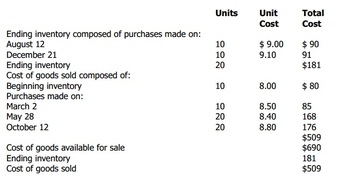
Specific Identification
Determining ending inventory under specific identification
5.3.3: Cost Flow Assumptions
Inventory cost flow assumptions (e.g., FIFO) are necessary to determine the cost of goods sold and ending inventory.
Learning Objective
Explain how a company’s inventory cost flow assumptions dictate which method it will use for inventory valuation
Key Points
- Companies make certain assumptions about which goods are sold and which goods remain in inventory (resulting in different accounting methodologies).
- The only requirement, regardless of method is that: The total cost of goods sold plus the cost of the goods remaining in ending inventory for financial and tax purposes is equal to the actual cost of goods available.
- Cost flow assumptions are for financial reporting and tax purposes only and do not have to agree with the actual movement of goods.
Key Terms
- inventory
-
A detailed list of all of the items on hand.
- assumption
-
The thing supposed; a postulate, or proposition assumed; a supposition.
- COGS
-
COGS (cost of goods sold) is the inventory costs of those goods a business has sold during a particular period.
Example
- FIFO assigns first costs incurred to COGS (cost of goods sold) on the income statement. This disallows manipulation by management and cost flow agrees with ideal, physical flow of goods. Some may argue that the agreement of cost flow and ideal, physical flow of goods is not important. FIFO also uses the least relevant cost for the income statement and underestimates or overestimates the cost of goods sold if prices are rising or falling, respectively.
Cost Flow Assumptions
Inventory cost flow assumptions are necessary to determine the cost of goods sold and ending inventory. Companies make certain assumptions about which goods are sold and which goods remain in inventory (resulting in different accounting methodologies). This is for financial reporting and tax purposes only and does not have to agree with the actual movement of goods (companies typically choose a method because of its particular benefits, such as lower taxes) .

Efficient use of inventory is critical for businesses.
Picture of inventory at a business.
The only requirement, regardless of method is that: The total cost of goods sold plus the cost of the goods remaining in the ending inventory for financial and tax purposes is equal to the actual cost of goods available.
Specific Identification
Characteristics of the specific identification method include:
- Keeps track of the cost of each, specific good sold
- Perfect matching of costs of goods to goods sold
- Often impossible or too costly and allows manipulation by management
FIFO
Characteristics of the FIFO method include:
- Assigns first costs incurred to COGS (cost of goods sold) on the income statement
- Disallows manipulation by management and cost flow agrees with ideal, physical flow of goods, though the agreement of cost flow and ideal, physical flow of goods is arguably not important
- Uses the least relevant cost for the income statement and underestimates or overestimates the cost of goods sold if prices are rising or falling, respectively
LIFO
Characteristics of the LIFO method include:
- Assigns last costs incurred to COGS on the income statement
- Disallows manipulation by management and uses the most relevant cost for the income statement
- Underestimates or overestimates cost of goods sold if prices are falling or rising, respectively and cost flow disagrees with ideal, physical flow of goods, though the agreement of cost flow and ideal, physical flow of goods is arguably not important
Weighted Average
Characteristics of the weighted average method include:
- Assigns average cost incurred to COGS on the income statement
- Disallows manipulation by management and better estimation of the cost of goods sold than FIFO or LIFO if prices are rising or falling
- Tends to ignore extreme costs of inventory and there is no theoretical reasoning for using this method
Additional Notes
LIFO and weighted average cost flow assumptions may yield different end inventories and COGS in a perpetual inventory system than in a periodic inventory system due to the timing of the calculations. In the perpetual system, some of the oldest units calculated in the periodic units-on-hand ending inventory may get expended during a near inventory exhausting individual sale. In the LIFO system, the weighted average system, and the perpetual system, each sale moves the weighted average, so it is a moving weighted average for each sale. In contrast, in the periodic system, it is only the weighted average of the cost of the beginning inventory, the sum cost of all the purchases, less than the cost of the inventory, divided by the sum of the beginning units and the total units purchased.
5.3.4: Average Cost Method
Under the Average Cost Method, It is assumed that the cost of inventory is based on the average cost of the goods available for sale during the period.
Learning Objective
Explain how a company uses the average cost method to value their inventory
Key Points
- Under the average cost method, it is assumed that the cost of inventory is based on the average cost of the goods available for sale during the period.The average cost is computed by dividing the total cost of goods available for sale by the total units available for sale.
- The weighted-average method of inventory costing is a means of costing ending inventory using a weighted-average unit cost. Companies most often use the weighted-average method to determine a cost for units that are basically the same, such as identical games in a toy store.
- Moving-Average (Unit) Cost is a method of calculating Ending Inventory cost. Assume that both Beginning Inventory and beginning inventory cost are known. From them the Cost per Unit of Beginning Inventory can be calculated.
Key Terms
- COGS
-
COGS (cost of goods sold) is the inventory costs of those goods a business has sold during a particular period.
- weighted average
-
An arithmetic mean of values biased according to agreed weightings.
- average collection period
-
365 divided by the receivables turnover ratio
- inventory
-
A detailed list of all of the items on hand.
- depreciable cost
-
original cost minus salvage value
Example
- To see how a company uses the weighted-average method to determine inventory costs using periodic inventory procedure, look at. Note that we compute weighted average cost per unit by dividing the cost of units available for sale, $690, by the total number of units available for sale, 80. Thus, the weighted-average cost per unit is $8.625, meaning that each unit sold or remaining in inventory is valued at $8.625.
Average Cost Method
Under the average cost method, it is assumed that the cost of inventory is based on the average cost of the goods available for sale during the period. The average cost is computed by dividing the total cost of goods available for sale by the total units available for sale. This gives a weighted-average unit cost that is applied to the units in the ending inventory. There are two commonly used average cost methods: Simple Weighted Average Cost method and Moving-Average Cost method.
The following is an example of the weighted average cost method:
- On 12/31/12, Furniture Palace has cost of goods available for sale (beginning inventory and purchases) of USD 5,000; 200 units available for sale; sales of 50 units; and an ending inventory of 150 units.
- The per unit cost of inventory is USD 25 (5,000 / 200 units). The value of the ending inventory on the balance sheet is USD 3,750 (150 units * USD 25). The cost of goods sold on the income statement is USD 1,250 (50 units * USD 25).
Moving Average Cost
Moving-Average (Unit) Cost is a method of calculating Ending Inventory cost. Assume that both Beginning Inventory and Beginning Inventory Cost are known. From them, the Cost per Unit of Beginning Inventory can be calculated. During the year, multiple purchases are made. Each time, purchase costs are added to Beginning Inventory Cost to get Cost of Current Inventory. Similarly, the number of units bought is added to Beginning Inventory to get Current Goods Available for Sale. After each purchase, Cost of Current Inventory is divided by Current Goods Available for Sale to get Current Cost per Unit on Goods.
Also during the year, multiple sales happen. The Current Goods Available for Sale is deducted by the amount of goods sold (COGS), and the Cost of Current Inventory is deducted by the amount of goods sold times the latest (before this sale) Current Cost per Unit on Goods. This deducted amount is added to Cost of Goods Sold. At the end of the year, the last Cost per Unit on Goods, along with a physical count, is used to determine ending inventory cost.
The following is an example of the moving-average cost method:
On 12/29/12, Furniture Palace has beginning inventory of $5,000 and 200 units available for sale. The current cost per unit is
.
On 12/30/12, a purchase of 50 units is made for $250. The new cost per unit after the purchase is
.
On 12/31/12, sales for the period were 50 units and ending inventory is 150 units. The value of the ending inventory on the balance sheet is
. The cost of goods sold on the income statement is
.
Weighted-Average under Periodic Inventory Procedure
The Weighted-Average Method of inventory costing is a means of costing ending inventory using a weighted-average unit cost. Companies most often use the Weighted-Average Method to determine a cost for units that are basically the same, such as identical games in a toy store or identical electrical tools in a hardware store. Since the units are alike, firms can assign the same unit cost to them. Under periodic inventory procedure, a company determines the average cost at the end of the accounting period by dividing the total units purchased plus those in beginning inventory into total cost of goods available for sale. The ending inventory is carried at this per unit cost.
Advantages and Disadvantages of Weighted-Average Method
When a company uses the Weighted-Average Method and prices are rising, its cost of goods sold is less than that obtained under LIFO, but more than that obtained under FIFO. Inventory is also not as badly understated as under LIFO, but it is not as up-to-date as under FIFO. Weighted-average costing takes a middle-of-the-road approach. A company can manipulate income under the weighted-average costing method by buying or failing to buy goods near year-end. However, the averaging process reduces the effects of buying or not buying.
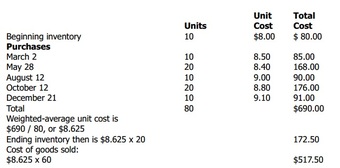
Determining ending inventory
Determining ending inventory under weighted-average method using periodic inventory procedure
5.3.5: FIFO Method
FIFO stands for “first-in, first-out,” and assumes that the costs of the first goods purchased are charged to cost of goods sold.
Learning Objective
Describe how a company would value inventory under the FIFO method
Key Points
- This method assumes the first goods purchased are the first goods sold. In some companies, the first units in (bought) must be the first units out (sold) to avoid large losses from spoilage.
- In periods of rising prices (Inflation) FIFO has higher value of inventory and lower cost of goods sold; in periods of falling prices (deflation) it has lower value of inventory and higher cost of goods sold.
- Because a company using FIFO assumes the older units are sold first and the newer units are still on hand, the ending inventory consists of the most recent purchases.
Key Terms
- accounting
-
The development and use of a system for recording and analyzing the financial transactions and financial status of a business or other organization.
- inflation
-
An increase in the quantity of money, leading to a devaluation of existing money.
- FIFO
-
First in, first out (accounting).
Example
- An example of how to calculate the ending inventory balance and cost of goods sold of the period using FIFO — assume the following inventory is on hand and purchased on the following dates: Inventory of Product X -Purchase date: 10/1/12 — 10 units at a cost of USD 5 Purchase date: 10/5/12 — 5 units at a cost of USD 6 On 12/30/12, a sale is made of Product X for 11 units. Under FIFO, it is assumed that 10 units purchased on 10/1/12 (the sale also eliminates this inventory layer) and 1 unit purchased on 10/5/12 were sold The ending inventory balance on the 12/31/12 balance sheet is 4 units at a cost of USD 6, or USD 24 and cost of goods sold on the income statement is USD 56 (10 units * USD 5 + 1 unit * USD 6)
What Is FIFO
FIFO stands for “first-in, first-out”, and is a method of inventory costing which assumes that the costs of the first goods purchased are those charged to cost of goods sold when the company actually sells goods.
FIFO and LIFO methods are accounting techniques used in managing inventory and financial matters involving the amount of money a company has tied up within inventory of produced goods, raw materials, parts, components, or feed stocks. These methods are used to manage assumptions of cost flows related to inventory, stock repurchases (if purchased at different prices), and various other accounting purposes .

Inventory
Inventory in a warehouse
Assumptions of FIFO
This method assumes the first goods purchased are the first goods sold. In some companies, the first units in (bought) must be the first units out (sold) to avoid large losses from spoilage. Such items as fresh dairy products, fruits, and vegetables should be sold on a FIFO basis. In these cases, an assumed first-in, first-out flow corresponds with the actual physical flow of goods.
Because a company using FIFO assumes the older units are sold first and the newer units are still on hand, the ending inventory consists of the most recent purchases. When using periodic inventory procedure to determine the cost of the ending inventory at the end of the period under FIFO, you would begin by listing the cost of the most recent purchase. If the ending inventory contains more units than acquired in the most recent purchase, it also includes units from the next-to-the-latest purchase at the unit cost incurred, and so on. You would list these units from the latest purchases until that number agrees with the units in the ending inventory.
How is it different?
Different accounting methods produce different results, because their flow of costs are based upon different assumptions. The FIFO method bases its cost flow on the chronological order purchases are made, while the LIFO method bases it cost flow in a reverse chronological order. The average cost method produces a cost flow based on a weighted average of unit costs.
The difference between the cost of an inventory calculated under the FIFO and LIFO methods is called the “LIFO reserve. ” This reserve is essentially the amount by which an entity’s taxable income has been deferred by using the LIFO method.
How to Calculate Ending Inventory Using FIFO
Ending inventory = beginning inventory + net purchases – cost of goods sold
Keep in mind the FIFO assumption: Costs of the first goods purchased are those charged to cost of goods sold when the company actually sells goods.
When Using FIFO
- Periods of Rising Prices (Inflation)FIFO (+) Higher value of inventory (-) Lower cost of goods sold
- Periods of Falling Prices (Deflation)FIFO (-) Lower value of inventory (+) Higher cost of goods sold
5.3.6: LIFO Method
LIFO stands for last-in, first-out, meaning that the most recently produced items are recorded as sold first.
Learning Objective
Summarize how using the LIFO method affects a company’s financial statements
Key Points
- FIFO and LIFO Methods are accounting techniques used in managing inventory and financial matters involving the amount of money a company has tied up within inventory of produced goods, raw materials, parts, components, or feed stocks.
- LIFO stands for last-in, first-out, meaning that the most recently produced items are recorded as sold first.
- The difference between the cost of an inventory calculated under the FIFO and LIFO methods is called the “LIFO reserve. ” This reserve is essentially the amount by which an entity’s taxable income has been deferred by using the LIFO method.
Key Terms
- inventory
-
A detailed list of all of the items on hand.
- income statement
-
A calculation which shows the profit or loss of an accounting unit (company, municipality, foundation, etc.) during a specific period of time, providing a summary of how the profit or loss is calculated from gross revenue and expenses.
- LIFO
-
Last-in, first-out (accounting).
Example
- LIFO under perpetual inventory procedure: Under this procedure, the inventory composition and balance are updated with each purchase and sale. Each time a sale occurs, the items sold are assumed to be the most recent ones acquired. Despite numerous purchases and sales during the year, the ending inventory still includes the units from beginning inventory. Applying LIFO on a perpetual basis during the accounting period, results in different ending inventory and cost of goods sold figures than applying LIFO only at year-end using periodic inventory procedure. For this reason, if LIFO is applied on a perpetual basis during the period, special inventory adjustments are sometimes necessary at year-end to take full advantage of using LIFO for tax purposes.
Accounting Methods
A merchandising company can prepare an accurate income statement, statements of retained earnings, and balance sheets only if its inventory is correctly valued. On the income statement, a company using periodic inventory procedure takes a physical inventory to determine the cost of goods sold. Since the cost of goods sold figure affects the company’s net income, it also affects the balance of retained earnings on the statement of retained earnings. On the balance sheet, incorrect inventory amounts affect both the reported ending inventory and retained earnings. Inventories appear on the balance sheet under the heading “Current Assets,” which reports current assets in a descending order of liquidity. Because inventories are consumed or converted into cash within a year or one operating cycle, whichever is longer, inventories usually follow cash and receivables on the balance sheet.
FIFO and LIFO methods are accounting techniques used in managing inventory and financial matters involving the amount of money a company has tied up within inventory of produced goods, raw materials, parts, components, or feed stocks. These methods are used to manage assumptions of cost flows related to inventory, stock repurchases (if purchased at different prices), and various other accounting purposes.
LIFO
LIFO stands for last-in, first-out, meaning that the most recently produced items are recorded as sold first. Since the 1970s, some U.S. companies shifted towards the use of LIFO, which reduces their income taxes in times of inflation, but with International Financial Reporting Standards banning the use of LIFO, more companies have gone back to FIFO. LIFO is only used in Japan and the United States. The difference between the cost of an inventory calculated under the FIFO and LIFO methods is called the “LIFO reserve. ” This reserve is essentially the amount by which an entity’s taxable income has been deferred by using the LIFO method.
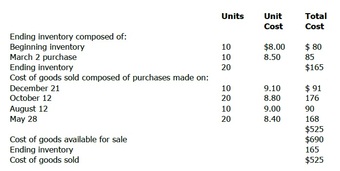
LIFO inventory method
Determining LIFO cost of ending inventory under periodic inventory procedure.
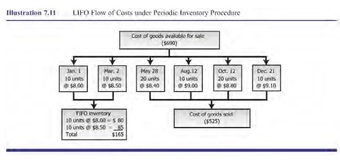
LIFO Flowchart
LIFO flow of costs under periodic inventory procedure
The following is an example of the LIFO inventory costing method (assume the following inventory of Product
is on hand and purchased on the following dates).
- Purchase date 10/1/12: 10 units at a cost of USD 5
- Purchase date 10/5/12: 5 units at a cost of USD 6
- On 12/30/12, 11 units of Product
are sold. When the sale is made, it is assumed that the 5 units purchased on 10/5/12 (the sale eliminates this inventory layer) and 6 units purchased on 10/1/12 were sold.
The ending inventory balance on 12/31/12 balance sheet is
, and the cost of goods sold on the income statement is
.
LIFO Under Perpetual Inventory Procedure
Under this procedure, the inventory composition and balance are updated with each purchase and sale. Each time a sale occurs, the items sold are assumed to be the most recent ones acquired. Despite numerous purchases and sales during the year, the ending inventory still includes the units from beginning inventory.
Applying LIFO on a perpetual basis during the accounting period, results in different ending inventory and cost of goods sold figures than applying LIFO only at year-end using periodic inventory procedure. For this reason, if LIFO is applied on a perpetual basis during the period, special inventory adjustments are sometimes necessary at year-end to take full advantage of using LIFO for tax purposes.
5.3.7: Gross Profit Method
The gross profit method uses the previous year’s average gross profit margin to calculate the value of the inventory.
Learning Objective
Explain how a company would use the Gross Profit Method to value inventory
Key Points
- There a two methods to estimate inventory cost the retail inventory method and the gross profit method.
- If taking a physical inventory is impossible or impractical, it is necessary to estimate the inventory cost.
- Keep in mind the gross profit method assumes that gross profit ratio remains stable during the period.
Key Terms
- monetary
-
Of, pertaining to, or consisting of money.
- gross profit
-
The difference between net sales and the cost of goods sold.
Valuing Inventory
An inventory valuation allows a company to provide a monetary value for items that make up their inventory. Inventories are usually the largest current asset of a business, and proper measurement of them is necessary to assure accurate financial statements. If inventory is not properly measured, expenses and revenues cannot be properly matched and a company could make poor business decisions.
A company will chose an inventory accounting system, either perpetual or periodic. In perpetual inventory the accounting records must show the amount of inventory on hand at all times. Periodic inventory is not updated on a regular basis.
Methods Used to Estimate Inventory Cost
While the best way to value inventory is to perform a physical inventory, in certain business operations, taking a physical inventory is impossible or impractical. In such a situation, it is necessary to estimate the inventory cost. There are two methods to estimate inventory cost, the retail inventory method and the gross profit method.
Both methods can be used to calculate the inventory amount for the monthly financial statements, or estimate the amount of missing inventory due to theft, fire or other disaster. Either of these methods should never be used as a substitute for performing an annual physical inventory.
Gross Profit Method
The gross profit (or gross margin) method uses the previous year’s average gross profit margin (i.e. sales minus cost of goods sold divided by sales) to calculate the value of the inventory. Keep in mind the gross profit method assumes that gross profit ratio remains stable during the period.

Inventory.
The gross profit (or gross margin) method uses the previous year’s average gross profit margin (i.e. sales minus cost of goods sold divided by sales) to calculate the value of the inventory.
To prepare the inventory value via the gross profit method:
- Calculate the cost of goods available for sale as the sum of the cost of beginning inventory and cost of net purchases.
- Determine the gross profit ratio. Gross profit ratio equals gross profit divided by sales. Use projected gross profit ratio or historical gross profit ratio whichever is more accurate and reliable.
- Multiply sales made during the period by gross profit ratio to obtain estimated cost of goods sold.
- Calculate the cost of ending inventory as the difference of cost of goods available for sale and estimated cost of goods sold.
Example
The following is an example on how to calculate ending inventory using the gross profit method.
Furniture Palace has cost of goods available for sale of $5000. Sales were $1000.
The company has projected a gross profit ratio of 25%.
The estimated cost of goods sold on the income statement for the period is
.
The ending inventory on the balance sheet is
.
5.3.8: Selecting an Inventory Method
When selecting an inventory method, managers should look at the advantages and disadvantages of each.
Learning Objective
Summarize the differences between LIFO, FIFO and Specific Identification and explain how a company would use that information to select an inventory method
Key Points
- Specific identification provides the most precise matching of costs and revenues and is, therefore, the most theoretically sound method.
- The FIFO method has four major advantages: (1) it is easy to apply, (2) the assumed flow of costs corresponds with the normal physical flow of goods, (3) no manipulation of income is possible, and (4) the balance sheet amount for inventory is likely to approximate the current market value.
- During periods of inflation, LIFO shows the largest cost of goods sold (COGS) of any of the costing methods because the newest costs charged to cost of goods sold are also the highest costs.
- When a company uses the weighted-average method and prices are rising, its cost of goods sold is less than that obtained under LIFO, but more than that obtained under FIFO.
Key Terms
- inventory
-
A detailed list of all of the items on hand.
- balance sheet
-
A summary of a person’s or organization’s assets, liabilities. and equity as of a specific date.
Example
- Specific Identification: Assume that a company bought three identical units of a given product at different prices. One unit cost USD 2,000, the second cost USD 2,100, and the third cost USD 2,200. The company sold one unit for USD 2,800. The units are alike, so the customer does not care which of the identical units the company ships. However, the gross margin on the sale could be either USD 800, USD 700, or USD 600, depending on which unit the company ships.
Advantages and Disadvantages of Specific Identification
Companies that use the specific identification method of ‘inventory costing’ state their cost of goods sold and ending inventory as the actual cost of specific units sold and on hand. Some accountants argue that this method provides the most precise matching of costs and revenues and is therefore the most theoretically sound method. This statement is true for some one-of-a-kind items, such as autos or real estate. For these items, use of any other method would seem illogical. However, one disadvantage of the specific identification method is that it permits the manipulation of income.
Advantages and Disadvantages of FIFO
The FIFO method has four major advantages:
- It is easy to apply.
- The assumed flow of costs corresponds with the normal physical flow of goods.
- No manipulation of income is possible.
- The balance sheet amount for inventory is likely to approximate the current market value.
All the advantages of FIFO occur because when a company sells goods, the first cost it removes from inventory are the oldest unit costs. The cost attached to the unit sold is always the oldest cost. Under FIFO, purchases at the end of the period have no effect on cost of goods sold or net income ([fig:11053]]). The disadvantages of FIFO include the recognition of paper profits and a heavier tax burden if used for tax purposes in periods of inflation.
An example of how to calculate the ending inventory balance of the period using FIFO — assume the following inventory is on hand and purchased on the following dates:
- Inventory of Product X –
- Purchase date: 10/1/12 — 10 units at a cost of USD 5
- Purchase date: 10/5/12 — 5 units at a cost of USD 6
- On 12/30/12, a sale of Product X is made for 11 units
- When the sale is made, it is assumed that the 10 units purchased on 10/1/12 and 1 unit purchased on 10/5/12 were sold
- The ending inventory balance on 12/31/12 balance sheet is 4 units at a cost of USD 6, or USD 24. The cost of goods sold on the income statement is USD 56 (10 units * USD 5 + 1 unit * USD 6).
Advantages and disadvantages of LIFO
During periods of inflation, LIFO shows the largest cost of goods sold of any of the costing methods because the newest costs charged to cost of goods sold are also the highest costs. The larger the cost of goods sold, the smaller the net income. Those who favor LIFO argue that its use leads to a better matching of costs and revenues than the other methods. When a company uses LIFO, the income statement reports both sales revenue and cost of goods sold in current dollars. The resulting gross margin is a better indicator of management’s ability to generate income than gross margin computed using FIFO, which may include substantial inventory (paper) profits.
An example of how to calculate the ending inventory balance of the period using LIFO — assume the following inventory is on hand and purchases are made on the following dates:
- Inventory of Product X –
- Purchase date: 10/1/12 — 10 units at a cost of USD 5
- Purchase date: 10/5/12 — 5 units at a cost of USD 6
- On 12/30/12, a sale of Product X is made for 11 units. When the sale is made, it is assumed that the 5 units purchased on 10/5/12 and 6 units purchased on 10/1/12 were sold.
- The ending inventory balance on 12/31/12, is 4 units at a cost of USD 5, or USD 20. The cost of good sold on the income statement is USD 60 (5 units * USD 6 + 6 units * USD 5).
Advantages and Disadvantages of Weighted-Average
When a company uses the weighted-average method and prices are rising, its cost of goods sold is less than that obtained under LIFO, but more than that obtained under FIFO. Inventory is not as understated as under LIFO, but it is not as up-to-date as under FIFO. A company can manipulate income under the weighted-average costing method by buying or failing to buy goods near year-end. However, the averaging process reduces the effects of buying or not buying.
The following is an example of the weighted average cost method:
- On 12/31/12, Furniture Palace has cost of goods available for sale of USD 5,000; 200 units available for sale; sales of 50 units; and an ending inventory of 150 units.
- The per unit cost of inventory is USD 25 (5,000 / 200 units). The value of the ending inventory on the balance sheet is USD 3,750 (150 units * USD 25). The cost of goods sold on the income statement is USD 1,250 (50 units * USD 25).
5.3.9: Impacts of Costing Methods on Financial Statements
The method a company uses to determine it cost of inventory (inventory valuation) directly impacts the financial statements.
Learning Objective
Differentiate between the FIFO, LIFO and Average Cost inventory valuation methods
Key Points
- Without inflation all three inventory valuation methods would produce the same results. However, prices do tend to rise over the years, and the company’s method costing method affects the valuation ratios.
- The FIFO method assumes that the first unit in inventory is the first until sold. FIFO gives a more accurate value for ending inventory on the balance sheet. On the other hand, FIFO increases net income and increased net income can increase taxes owed.
- The LIFO method assumes the last item entering inventory is the first sold. During periods of inflation LIFO shows ending inventory on the balance sheet much lower than what the inventory is truly worth at current prices, this means lower net income due to a higher cost of goods sold.
- The average cost method takes a weighted average of all units available for sale during the accounting period and then uses that average cost to determine the value of COGS and ending inventory.
Key Terms
- ending inventory
-
Ending inventory is the amount of inventory a company have in stock at the end of this fiscal year.
- net income
-
Gross profit minus operating expenses and taxes.
Inventory Valuation
The method a company uses to determine it cost of inventory (inventory valuation) directly impacts the financial statements. The three main methods for inventory costing are First-in, First-Out (FIFO), Last-in, Last-Out (LIFO) and Average cost.

Inventory valuation method.
The inventory valuation method a company chooses directly effects its financial statements.
First-in, First-Out
The FIFO method assumes that the first unit in inventory is the first until sold. For example, during the week a factory produces items. On Monday the items cost is $5 per unit to make, on Tuesday it is a $5.50 per unit. When the item is sold on Wednesday FIFO records the cost of goods sold for those items as $5. So, the balance sheet has the cost of goods sold at $1 and the balance sheet retains the remaining inventory at $5.50.
Last-in, First-out
The LIFO method assumes the opposite, that the last item entering inventory is the first sold. That means the factory would record the Wednesday cost of goods sold as $5.50 and the remaining inventory at $5.
Average Cost
This method is the most easy to calculate; it takes a weighted average of all units available for sale during the accounting period and then uses that average cost to determine the value of COGS and ending inventory. Assuming the factory made a total of 100 units the price per unit would be
.
Impact on the Financial Statements
Without inflation, all three inventory valuation methods would produce the same results. Unfortunately, prices do tend to rise over the years, and the company’s method costing method affects the valuation ratios.
During periods of inflation, the FIFO gives a more accurate value for ending inventory on the balance sheet. On the other hand, FIFO increases net income (due to the age of the inventory being used in cost of goods sold) and Increased net income can increase taxes owed.
Using LIFO during periods of inflation tend to show and ending inventory amount on the balance sheet that is much lower than what the inventory is truly worth at current prices, this means lower net income due to a higher cost of goods sold.
With average cost, the results fall in between FIFO and LIFO. Keep in mind deflation (falling prices) have an opposite effect on each method.
5.4: Detail on Using LIFO
5.4.1: The LIFO Reserve
The difference between the cost of an inventory calculated under the FIFO and LIFO methods is called the LIFO reserve.
Learning Objective
Summarize the purpose of a LIFO Reserve
Key Points
- The difference between the cost of an inventory calculated under the FIFO and LIFO methods is called the LIFO reserve. This reserve is essentially the amount by which an entity’s taxable income has been deferred by using the LIFO method.
- During times of increasing costs, the balance in the LIFO reserve account will have a credit balance, meaning that less cost reported in inventory. Remember, under LIFO the latest (higher) costs are expensed to the cost of goods sold, while the older (lower) costs remain in inventory.
- The credit balance in the LIFO reserve reports the difference in the inventory costs under LIFO versus FIFO since the time that LIFO was adopted. The change in the balance during the current year represents the current year’s inflation in costs.
- LIFO reserve = FIFO inventory – LIFO inventory.
Key Terms
- LIFO
-
Last-in, first-out (accounting).
- inventory
-
A detailed list of all of the items on hand.
- inflation
-
An increase in the quantity of money, leading to a devaluation of existing money.
The LIFO Reserve
Last-In First-Out (LIFO) is the opposite of First-In First-Out (FIFO). Some systems permit determining the costs of goods at the time acquired or made, but assigning costs to goods sold under the assumption that the goods made or acquired last are sold first. Costs of specific goods acquired or made are added to a pool of costs for the type of goods. Under this system, the business may maintain costs under FIFO but track an offset in the form of a LIFO reserve. Such a reserve (an asset or a contra-asset) represents the difference in cost of inventory under the FIFO and LIFO assumptions.

Seasonal Inventory
Valuing inventory using the LIFO method.
The difference between the cost of an inventory calculated under the FIFO and LIFO methods is called the LIFO reserve. This reserve is essentially the amount by which an entity’s taxable income has been deferred by using the LIFO method.
LIFO Reserve in Action
Suppose a company uses FIFO for its internal accounting system, but wants to use LIFO for financial and income tax reporting (due to continuous inflation of its costs). In this instance, the LIFO reserve is a contra inventory account that will reflect the difference between the FIFO cost and LIFO cost of its inventory.
During times of increasing costs, the balance in the LIFO reserve account will have a credit balance, meaning that less cost is reported in inventory. Remember, under LIFO the latest (higher) costs are expensed to the cost of goods sold, while the older (lower) costs remain in inventory.
The credit balance in the LIFO reserve reports the difference in the inventory costs under LIFO versus FIFO since the time that LIFO was adopted. The change in the balance during the current year represents the current year’s inflation in costs.
Benefits
- The change in the balance in the LIFO reserve will also increase the current year’s cost of goods sold. This in turn reduces the company’s profits and therefore, taxable income.
- The change in the balance of the LIFO reserve during the current year times the income tax rate results in the difference in the income tax for the year. Changing this formula slightly, one can find the difference in income tax since LIFO was adopted (the balance in the LIFO reserve times the income tax rate).
- The disclosure of the LIFO reserve is better for comparing the profits and ratios of a company using LIFO with the profits and ratios of a company using FIFO.
Additional Information
The accounting profession has discouraged the use of the word reserve in financial reporting, so LIFO reserve may sometimes be called: Revaluation to LIFO, Excess of FIFO over LIFO cost, or LIFO allowance.
LIFO reserve = FIFO inventory – LIFO inventory
FIFO inventory = LIFO inventory + LIFO reserve
5.4.2: Comparability
If a company uses LIFO, the recorded amount of inventory is not an accurate reflection of cost, reducing comparability to companies using FIFO.
Learning Objective
Explain why comparability is important for valuing a company
Key Points
- The LIFO method results in lower ending (and beginning) inventory on a company’s balance sheet because the oldest (and therefore usually less expensive due to inflation) items remain in the inventory.
- If a company uses LIFO, recorded inventory is not an accurate reflection of cost of the current period. This low valuation affects the computation and evaluation of current assets and any financial ratios that include inventory, reducing comparability between companies using different methods.
- The most common normalization adjustments fall into the following four categories: Comparability Adjustments, Non-operating Adjustments, Non-recurring Adjustments, and Discretionary Adjustments.
Key Terms
- valuation
-
The process of estimating the market value of a financial asset or liability.
- adjustment
-
a small change; a minor correction; a modification
- comparability
-
Comparison or equivalence.
Why Comparability is Important
Business valuation is a process and a set of procedures used to estimate the economic value of an owner’s interest in a business. Valuation is used by financial market participants to determine the price they are willing to pay or receive to perfect a sale of a business. In addition to estimating the selling price of a business, the same valuation tools are often used by business appraisers to resolve disputes related to:
- estate and gift taxation,
- divorce litigation,
- allocating business purchase price among business assets,
- establishing a formula for estimating the value of partners’ ownership interest for buy-sell agreements,
- and many other business and legal purposes.

Seasonal Inventory
Valuing inventory using the LIFO method.
Inventory Valuation with LIFO
The LIFO method results in lower ending (and beginning) inventory on a company’s balance sheet because the oldest (and therefore usually less expensive due to inflation) items remain in the inventory. Based off of this information, one can assume that if a company uses LIFO, the recorded amount of inventory is not an accurate reflection of cost of the current period. This low valuation affects the computation and evaluation of current assets and any financial ratios that include inventory, resulting in reduced comparability between companies using LIFO and others using FIFO.
Normalization (adjustment) methods
Comparability Adjustments
The valuer may adjust the subject company’s financial statements to facilitate a comparison between the subject company and other businesses in the same industry or geographic location. These adjustments are intended to eliminate differences between the way that published industry data is presented and the way that the subject company’s data is presented in its financial statements.
Non-operating Adjustments
It is reasonable to assume that if a business were sold in a hypothetical sales transaction (which is the underlying premise of the fair market value standard), the seller would retain any assets which were not related to the production of earnings or price those non-operating assets separately. For this reason, non-operating assets (such as excess cash) are usually eliminated from the balance sheet.
Non-recurring Adjustments
The subject company’s financial statements may be affected by events that are not expected to recur, such as the purchase or sale of assets, a lawsuit, or an unusually large revenue or expense. These non-recurring items are adjusted so that the financial statements will better reflect the management’s expectations of future performance.
Discretionary Adjustments
The owners of private companies may be paid at variance from the market level of compensation that similar executives in the industry might command. In order to determine fair market value, the owner’s compensation, benefits, perquisites and distributions must be adjusted to industry standards. Similarly, the rent paid by the subject business for the use of property owned by the company’s owners individually may be scrutinized.
5.4.3: Liquidation
In law, liquidation is the process by which a company is brought to an end, and the assets and property of the company redistributed.
Learning Objective
Explain the process of liquidating a company
Key Points
- Liquidation may either be compulsory (sometimes referred to as a creditors’ liquidation) or voluntary (sometimes referred to as a shareholders’ liquidation, although some voluntary liquidations are controlled by the creditors).
- After the removal of all assets which are subject to retention of title arrangements, fixed security, or are otherwise subject to proprietary claims of others, the liquidator will pay the claims against the company’s assets.
- LIFO liquidation refers to when a company using LIFO accounting methods liquidates their older LIFO inventory. This occurs if current sales are higher than current purchases, and consequently inventory not sold in previous periods must be liquidated.
- Due to inflation, the amount of money companies pay for inventory will usually increase over time. If a company decides to undergo LIFO liquidation, the old costs of inventory will be matched with the current, higher sales prices resulting in a higher tax liability.
Key Terms
- liquidation
-
The selling of the assets of a business as part of the process of dissolving it.
- LIFO
-
Last-in, first-out (accounting).
- creditor
-
A person to whom a debt is owed.
What is Liquidation?
In law, liquidation is the process by which a company (or part of a company) is brought to an end, and the assets and property of the company are redistributed. Liquidation is sometimes referred to as ‘winding-up’ or ‘dissolution’, although dissolution technically refers to the last stage of liquidation. The process of liquidation arises when customs, or an authority or agency in a country responsible for collecting and safeguarding customs duties, determines the final computation, ascertainment of the duties, or drawback accruing on an entry.
Liquidation may either be compulsory (sometimes referred to as a ‘creditors’ liquidation’) or voluntary (sometimes referred to as a ‘shareholders’ liquidation’, although some voluntary liquidations are controlled by the creditors) .

Plane liquidation
Alitalia — Compagnia Aerea Italiana S.p.A. (Italian for Alitalia – Italian Air Company), is an Italian airline, which bought some assets from the liquidation process of the old Alitalia-Linee Aeree Italiane and the entire Air One.
Parties Entitled to Liquidation
The parties who are entitled by law to petition for the compulsory liquidation of a company vary from jurisdiction to jurisdiction, but generally, a petition may be lodged with the court for the compulsory liquidation of a company by:
- The company itself
- Any creditor who establishes a prima facie case
- Contributories
- The Secretary of State
- The Official Receiver
Priority of Claims
After the removal of all assets which are subject to retention of title arrangements, fixed security, or are otherwise subject to proprietary claims of others, the liquidator will pay the claims against the company’s assets. Generally, the priority of claims on the company’s assets will be determined in the following order:
- Liquidators costs
- Creditors with fixed charge over assets
- Costs incurred by an administrator
- Amounts owing to employees for wages/superannuation (director limit: $2000)
- Payments owing in respect of workers’s injuries
- Amounts owing to employees for leave (director limit: $1500)
- Retrenchment payments owing to employees
- Creditors with floating charge over assets
- Creditors without security over assets
- Shareholders
Grounds for Liquidation
The grounds upon which one can apply for a compulsory liquidation also vary between jurisdictions, but the normal grounds to enable an application to the court for an order to compulsorily wind-up the company are:
- The company has so resolved
- The company was incorporated as a corporation, and has not been issued with a trading certificate (or equivalent) within 12 months of registration
- It is an “old public company” (i.e. one that has not re-registered as a public company or become a private company under more recent companies legislation requiring this)
- It has not commenced business within the statutorily prescribed time (normally one year) of its incorporation, or has not carried on business for a statutorily prescribed amount of time
- The number of members has fallen below the minimum prescribed by statute
- The company is unable to pay its debts as they fall due
- It is just and equitable to wind up the company
LIFO Liquidation
LIFO liquidation refers to when a company using LIFO accounting methods liquidates their older LIFO inventory. This occurs if current sales are higher than current purchases, and consequently inventory not sold in previous periods must be liquidated.
Due to inflation and general price increases, the amount of money companies pay for inventory will usually increase over time. If a company decides to undergo LIFO liquidation, the old costs of inventory will be matched with the current, higher sales prices. As a result, this cost has a higher tax liability if prices have risen since the LIFO method was adopted.
5.4.4: Dollar-Value LIFO
Dollar value LIFO (last-in, first-out) is calculated with all figures in dollar amounts, rather than inventory units.
Learning Objective
Summarize the advantages to using dollar-value LIFO inventory valuation
Key Points
- Dollar value LIFO uses this approach with all figures in dollar amounts, rather than inventory units. As a result, companies have a different view of their balance sheets than under other methods (such as FIFO).
- If inflation did not affect the statements of companies, dollar-value and non-dollar-value accounting methods would have the same results.
- However, because inflation does occur and thus, costs change over time, the dollar-value method presents data that show an increased cost of goods sold (COGS) when prices are rising, and a lower net income.
- This can, in turn, reduce a company’s taxes but make shareholders unhappy due to a lower net income on reports.
Key Terms
- shareholder
-
One who owns shares of stock.
- inflation
-
An increase in the quantity of money, leading to a devaluation of existing money.
- LIFO
-
Last-in, first-out (accounting).
Dollar-value LIFO
This inventory method follows LIFO (last-in, first-out). Dollar value LIFO uses this approach with all figures in dollar amounts, rather than inventory units. As a result, companies have a different view of their balance sheets than under other methods, such as FIFO (first-in, first-out).
If inflation did not affect the statements of companies, dollar-value and non-dollar-value accounting methods would have the same results. However, because it does occur and thus costs change over time, the dollar-value method presents data that show an increased cost of goods sold (COGS) when prices are rising, and a lower net income. This can, in turn, reduce a company’s taxes, but can make shareholders unhappy due to a lower net income on reports.
Dollar-value in the Decision-making Process
Managers apply the concepts of interest, future value, and present value in making business decisions. Therefore, accountants need to understand these concepts to properly record certain business transactions.
The time value of money
The concept of the time value of money stems from the logical reference for a dollar today rather than a dollar at any future date. Most individuals prefer having a dollar today rather than at some future date because:
- the risk exists that the future dollar will never be received; and
- if the dollar is on hand now, it can be invested, resulting in an increase in total dollars possessed at that future date.
Most business decisions involve a comparison of cash flows in and out of the company. To be useful in decision making, such comparisons must be in dollars of the same point in time. That is, the dollars held now must be accumulated or rolled forward, or future dollars must be discounted or brought back to the present dollar value, before comparisons are valid. Such comparisons involve future value and present value concepts.
Future value
The future value or worth of any investment is the amount to which a sum of money invested today grows during a stated period of time at a specified interest rate. The interest involved may be simple or compound.
Simple interest is interest on principal only. For example, $1000 invested today for two years at 12% simple interest grows to $1240 since interest is $120 per year. The principal of $1,000, plus
, is equal to $1240.
Compound interest is interest on principal and on interest of prior periods. For example, $1000 invested for two years at 12% compounded annually grows to $1254.40 as follows:
Principal or present value:
Value at end of year 1:
Value at end of year 2 (future value):
5.4.5: Advantages of LIFO
Using LIFO accounting for inventory, a company generally pays lower taxes in periods of inflation.
Learning Objective
Describe how using the LIFO method of valuing inventory would benefit a company
Key Points
- LIFO recovers cost from production because actual cost of material is charged to production.
- Production is charged at the recent prices because materials are issued from the latest consignment. Therefore, the effect of current market prices of materials is reflected in the cost of sales if the materials are recently purchased.
- In times of rising prices (inflation), LIFO is suitable because materials are issued at current market prices (which are high). This method helps in showing a lower profit because of increased charge to production during periods of rising prices and reduces income tax.
- LIFO is simple to operate and is useful when there are not too many transactions with fairly steady prices.
Key Terms
- inventory
-
A detailed list of all of the items on hand.
- market price
-
The price at which a product, financial instrument, service or other tradable item can be bought and sold at an open market; the going price.
- LIFO
-
Last-in, first-out (accounting).
Example
- LIFO stands for last-in, first-out, meaning that the most recently produced items are recorded as sold first. Since the 1970s, some U.S. companies shifted towards the use of LIFO, which reduces their income taxes in times of inflation, but with International Financial Reporting Standards banning the use of LIFO, more companies have gone back to FIFO. LIFO is only used in Japan and the U.S.
Accounting Methods
FIFO and LIFO Methods are accounting techniques used in managing inventory and financial matters involving the amount of money a company has tied up within inventory of produced goods, raw materials, parts, components, or feed stocks. These methods are used to manage assumptions of cost flows related to inventory , stock repurchases (if purchased at different prices), and various other accounting purposes.
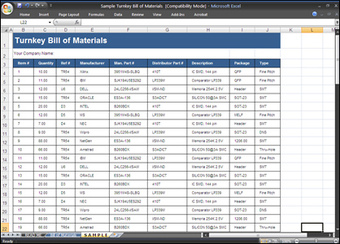
Inventory Template
Example of inventory template.
- FIFO stands for first-in, first-out, meaning that the oldest inventory items are recorded as sold first but do not necessarily mean that the exact oldest physical object has been tracked and sold.
- LIFO stands for last-in, first-out, meaning that the most recently produced items are recorded as sold first. Since the 1970s, some U.S. companies shifted towards the use of LIFO, which reduces their income taxes in times of inflation, but with International Financial Reporting Standards banning the use of LIFO, more companies have gone back to FIFO. LIFO is only used in Japan and the U.S.
In Periods of Rising Prices (Inflation)
- FIFO: (+) Higher value of inventory (-) Lower cost of goods sold
- LIFO: (-) Lower value of inventory (+) Higher cost of goods sold
In Periods of Falling Prices (Deflation)
- FIFO: (-) Lower value of inventory (+) Higher cost of goods sold
- LIFO: (+) Higher value on inventory (-) Lower cost on goods sold
Benefits of LIFO
LIFO considers the last unit arriving in inventory as the first one sold. Which method an accountant selects can have a significant effect on net income and book value and, in turn, on taxation. Using LIFO accounting for inventory, a company generally reports lower net income and lower book value, due to the effects of inflation. This generally results in lower taxation. Due to LIFO’s potential to skew inventory value, UK GAAP and IAS have effectively banned LIFO inventory accounting.
5.4.6: Disadvantages of LIFO
LIFO is facing pressures from international standards boards that may result in its possible complete elimination.
Learning Objective
Summarize the disadvantages of using LIFO
Key Points
- LIFO is facing pressures from international standards boards that may result in its possible complete elimination.
- Most of the developed countries, such as Australia, New Zealand, Canada and the European Community Union, have adapted IFRS by the year 2011.Under IFRS rules, LIFO is not a permitted acceptable accounting method.
- The use of LIFO disrupts the theoretical foundation of the IFRS and if plans proceed as expected, complete phase-out of LIFO will occur in the near future.
Key Term
- LIFO
-
Last-in, first-out (accounting).
LIFO is facing pressures from both the International Reporting Standards Board in cooperation with the SEC and the U.S. Congress for its possible complete elimination. On November 15, 2007, the Securities and Exchange Commission (SEC) exempted foreign firms from including reconciliation from International Financial Reporting Standards (IFRS) to U.S. Generally Accepted Accounting Principles (U.S. GAAP) when filing on U.S. Stock exchanges. Foreign public firms are now permitted to file using the International Financial Reporting Standards (IFRS) without reconciliation to U.S. GAAP as previously required. This move has created a mandate to converge IFRS and U.S. GAAP and financial statement requirements (SEC, 2007).

Inventory
Inventory in a warehouse.
On June, 18, 2008, the SEC issued a press release stating that the world’s securities regulators are uniting to increase their oversight of international accounting standards. Most of the developed countries, such as Australia, New Zealand, Canada and the European Community Union, have adapted IFRS by the year 2011.Under IFRS rules, LIFO is not a permitted acceptable accounting method. IFRS is balance sheet oriented and, on this basis, disallows LIFO as an inventory method. The use of LIFO disrupts the theoretical foundation of the IFRS and if plans proceed as expected, complete phase-out of LIFO will occur in the near future. More importantly is the current tax position on LIFO. In prior budgets, the Obama Administration has proposed to repeal LIFO altogether in an attempt to generate greater tax revenues.
5.5: Additional Topics in Inventory Valuation
5.5.1: Lower of Cost or Market
In lower of cost or market (LCM), inventory items are written down to market value when the market value is less than the cost of the items.
Learning Objective
Explain how a would use the Lower of Cost or Market to value inventory
Key Points
- The basic assumption of the LCM method is that if the purchase price of an item has fallen, its selling price also has fallen or will fall.
- Ending inventory is normally stated at historical cost (what was paid to obtain it), but there are times when the original cost of the ending inventory is greater than the cost of replacement. Thus, the inventory has lost value.
- Any loss resulting from the decline in the value of inventory is charged to cost of goods sold (COGS) if non-material, or loss on the reduction of inventory to LCM if material.
Key Terms
- market value
-
The price which a seller or insurer might reasonably expect to fetch for goods, services or securities on the open market.
- historical cost
-
The original monetary value of an economic item and based on the stable measuring unit assumption. Improvements may be added to an asset’s cost.
- stated value
-
par value
- purchase price
-
The price at which something is actually purchased, especially from the point of view of the purchaser.
Example
- For example, assume that the market value of the inventory is USD 39,600 and its cost is USD 40,000. The company would then record a USD 400 loss because the inventory has lost some of its revenue-generating ability.
Lower Of Cost or Market
Lower of cost or market (LCM) is an approach to valuing and reporting inventory. Ending inventory is normally stated at historical cost (what was paid to obtain it), but there are times when the original cost of the ending inventory is greater than the cost of replacement. Thus, the inventory has lost value. If the inventory has decreased in value below historical cost, then its carrying value is reduced and reported on the balance sheet. The criterion for reporting this is the current market value. Any loss resulting from the decline in the value of inventory is charged to cost of goods sold (COGS) if non-material, or loss on the reduction of inventory to LCM if material.
The basic assumption of the LCM method is that if the purchase price of an item has fallen, its selling price also has fallen or will fall.
LCM In Practice
Under LCM, inventory items are written down to market value when the market value is less than the cost of the items. For example, assume that the market value of the inventory is USD 39,600 and its cost is USD 40,000. The company would then record a USD 400 loss because the inventory has lost some of its revenue-generating ability. Employees should check the stock of certain items to maintain an accurate record for dollars of inventory in stock .

Friedrich Von Hayek
Austrian economist Friedrich von Hayek, along with University of Chicago economist Milton Friedman are two classic liberal economists attributed with the return of laissez-faire economics and deregulation.
The company must recognize the loss in the period the loss occurred. On the other hand, if ending inventory has a market value of USD 45,000 and a cost of USD 40,000, the company would not recognize this increase in value. To do so would recognize revenue before the time of sale. A company may apply LCM to each inventory item (such as Monopoly), each inventory class (such as games), or total inventory.
Under the class method, a company applies LCM to the total cost and total market for each class of items compared. One class might be games, while another might be toys. The company then values each class at lower its cost or market amount.
Business Insight
Procter & Gamble markets a broad range of laundry, cleaning, paper, beauty care, health care, food, and beverage products around the world. Procter & Gamble’s footnote in its Notes to Consolidated Financial Statements in its annual report illustrates that companies often disclose LCM in their notes to financial statements.
Inventories are valued at cost, which is not in excess of current market price. Cost is primarily determined by either the average cost or the first-in, first-out method. The replacement cost of last-in, first-out inventories exceeds carrying value by approximately USD 169 million.

Businesses need to manage their inventories.
Here a woman is checking stock of certain items to maintain an accurate record for dollars of inventory in stock.
5.5.2: Methods in Retail Inventory
For some companies, taking a physical inventory is impossible or impractical so the Retail Inventory Method is used to estimate.
Learning Objective
Explain how to calculate inventory using the retail inventory method
Key Points
- In certain business operations, taking a physical inventory is impossible or impractical. In such a situation, it is necessary to estimate the inventory cost through methods such as RMA.
- The advantage of the RMA method is that companies can estimate ending inventory (at cost) without taking a physical inventory. Thus, the use of this estimate permits the preparation of interim financial statements (monthly or quarterly) without taking a physical inventory.
- Because RIM/RMA only provides an approximation of inventory value, physical inventory must also be performed periodically to ensure the accuracy of inventory estimates due to issues such as shoplifting.
Key Terms
- inventory
-
A detailed list of all of the items on hand.
- gross profit
-
The difference between net sales and the cost of goods sold.
- shortage
-
a lack or deficiency
Retail Inventory Method (RIM or RMA)
In certain business operations, taking a physical inventory is impossible or impractical. In such a situation, it is necessary to estimate the inventory cost. Two very popular methods are:
- Retail inventory method, and
- Gross profit (or gross margin) method.

Businesses need to manage their inventories.
Here a woman is checking stock of certain items to maintain an accurate record for dollars of inventory in stock.
The retail inventory method uses a cost to retail price ratio. The physical inventory is valued at retail, and it is multiplied by the cost ratio (or percentage) to determine the estimated cost of the ending inventory. Note that both the gross margin and the retail inventory methods can help you detect inventory shortages.
Advantages
The advantage of this method is that companies can estimate ending inventory (at cost) without taking a physical inventory. Thus, the use of this estimate permits the preparation of interim financial statements (monthly or quarterly) without taking a physical inventory.
Disadvantages
Because RIM only provides an approximation of inventory value, physical inventory must also be performed periodically to ensure the accuracy of inventory estimates due to issues such as shoplifting.
How to find the ending inventory with RMA
The steps for finding the ending inventory by the retail inventory method are:
- Total the beginning inventory and the net amount of goods purchased during the period at both cost and retail prices.
- Divide the cost of goods available for sale by the retail price of the goods available for sale to find the cost/retail price ratio.
- Deduct the retail sales from the retail price of the goods available for sale to determine ending inventory at retail.
- Multiply the cost/retail price ratio or percentage by the ending inventory at retail prices to reduce it to the ending inventory at cost.
Example
To illustrate how you can determine inventory shortages using the retail method, assume that a physical inventory taken at year end, showed only $62,000 of retail-priced goods in the store. Assume that use of the retail method for the fourth quarter showed that $66,000 of goods should be on hand, thus indicating a $4000 inventory shortage at retail. After converting the $4000 to $2400 of cost (
) you would report this as a “Loss from inventory shortage” in the income statement. Knowledge of such shortages may lead management to reduce or prevent them, by increasing security or improving the training of employees.
5.6: Assessing Inventory Management
5.6.1: Efficiency Metrics
Efficiency ratios for inventory measure how effectively a business uses its inventory resources.
Learning Objective
Describe how a company uses efficiency metrics to monitor inventory
Key Points
- An efficiency metric or ratio, sometimes referred to as an activity ratio, is a type of financial ratio. The inventory turnover rate is a type of efficiency metric.
- Financial ratios evaluate the overall financial condition of a corporation or other organization in comparison to its industry and competitors.
- A low inventory turnover rate may point to overstocking, obsolescence, or deficiencies in the product line or marketing effort.
- A high turnover rate may indicate inadequate inventory levels, which may lead to a loss in business as the inventory is too low.
Key Terms
- Cost of Goods Sold
-
refers to the inventory costs of the goods a business has sold during a particular period (sometimes abbreviated as COGS).
- obsolescence
-
The process of becoming obsolete, outmoded, or out of date.
Efficiency Metrics (Ratios)
An efficiency metric or ratio, sometimes referred to as an activity ratio, is a type of financial ratio. Management, financial analysts, and the investment community evaluate financial ratios when trying to evaluate the overall financial condition of a corporation or other organization. Ratios can be expressed as a decimal value, such as 0.10, or given as an equivalent percent value, such as 10%. Some ratios are usually quoted as percentages, especially ratios that are usually or always less than 1, while others are usually quoted as decimal numbers, especially ratios that are usually more than 1. Efficiency ratios for inventory are used to measure how effectively a business uses its inventory resources in comparison to its industry or competitors.

Efficient use of inventory is critical for businesses.
Picture of inventory at a business.
Inventory Efficiency
It’s important for organizations to strike the right balance on their inventory levels. If inventory levels are too low, the company runs the risk of losing out on sales and not meeting customer demand. This can lead customers to give their business to the company’s competitors. When there is excess inventory, a company can have higher operating costs due to greater inventory storage requirements, which will decrease profits. In addition, excess inventory increases the risk of losses due to price declines or inventory obsolescence.
Types of Efficiency Metrics (Ratios)
Inventory Turnover Ratio = Cost of Goods Sold / Average Inventory (to calculate average inventory, add the balances of beginning and ending inventory and divide by 2)
The inventory turnover ratio is a measure of the number of times inventory is sold or used in a time period, such as a year. A low turnover rate may point to overstocking, obsolescence, or deficiencies in the product line or marketing effort. A high turnover rate may indicate inadequate inventory levels, which may lead to a loss in business as the inventory is too low.
Inventory Conversion Ratio = 365 Days / Inventory Turnover Ratio
The inventory conversion ratio is a measure of the number of days in a year it takes to sell inventory or convert it into cash.
5.6.2: Impact of Inventory Method on Financial Statement Analysis
The inventory method chosen will affect the amount of current assets and gross profit income statement, especially when prices are changing.
Learning Objective
Explain how a company’s choice of inventory method affects their financial statements
Key Points
- There are five types of inventory methods — FIFO, LIFO, Dollar Value LIFO, Retail Inventory, and Average Cost.
- The choice of inventory method should reflect a company’s economic circumstances in order to create accurate financial statements.
- When prices are falling, FIFO will result in lower current assets and lower gross profit. LIFO will result in higher current assets and higher gross profit.
- When prices are rising, FIFO will result in higher current assets and higher gross profit. LIFO will result in lower current assets and lower gross profit.
Key Terms
- balance sheet
-
A balance sheet is often described as a “snapshot of a company’s financial condition. ” A standard company balance sheet has three parts: assets, liabilities, and ownership equity.
- income statement
-
Displays the revenues recognized for a specific period and the cost and expenses charged against these revenues, including write-offs (e.g., depreciation and amortization of various assets) and taxes. The purpose of the income statement is to show managers and investors whether the company made or lost money during the reporting period.
Types of Inventory Methods
Inventories are valued in the “Current Assets” section of the balance sheet using one of the following five methods. It’s important to note that these methods will be affected by the system used to update inventory – “perpetual” or “periodic”. A perpetual system updates inventory every time a change in inventory occurs, and a periodic system updates inventory at the end of the accounting period.

Businesses need to manage their inventories.
Here a woman is checking stock of certain items to maintain an accurate record for dollars of inventory in stock.
First-In First-Out (FIFO) assumes that the items purchased or produced first are sold first. Costs of inventory per unit or item are determined at the time made or acquired. The oldest cost (i.e., the first in) is then matched against revenue and assigned to cost of goods sold. The ending inventory balance reflects recent inventory costs.
Last-In First-Out (LIFO) is the reverse of FIFO; the latest cost (i.e., the last in) is assigned to cost of goods sold and matched against revenue. Some systems permit determining the costs of goods at the time acquired or made but assigning costs to goods sold under the assumption that the goods made or acquired last are sold first. Costs of specific goods acquired or made are added to a pool of costs for the type of goods. Under this system, the business may maintain costs under FIFO but track an offset in the form of a LIFO reserve. The LIFO reserve (an asset or contra-asset) represents the difference in cost of inventory under the FIFO and LIFO assumptions. Such amount may be different for financial reporting and tax purposes in the United States.
Dollar Value LIFO is a variation of LIFO. Any increases or decreases in the LIFO reserve are determined based on dollar values rather than quantities.
The Retail Inventory method is typically used by resellers of goods to simplify record keeping. The calculated cost of goods on hand at the end of a period is the ratio of cost of goods acquired to the retail value of the goods times the retail value of goods on hand. Cost of goods acquired includes beginning inventory as previously valued plus purchases. Cost of goods sold is then beginning inventory plus purchases less the calculated cost of goods on hand at the end of the period.
The Average Cost method relies on average unit cost to calculate cost of goods sold and ending inventory. Several variations on the calculation may be used, including weighted average and moving average.
Impact on Financial Statements
The choice of inventory method should reflect a company’s economic circumstances in order to create accurate financial statements. In addition to the inventory method chosen, use of a perpetual or periodic inventory system will affect the amount of current assets in the balance sheet and gross profit in the income statement, especially when prices are changing.
Period of Rising Prices
Under FIFO: Ending Inventory is higher, and Total Current Assets are higher; cost of goods sold is lower, and gross profit is higher.
Under LIFO: Ending Inventory is lower, and total current assets are lower; cost of goods sold is higher, and gross profit is lower.
Period of Falling Prices
Under FIFO: Ending Inventory is lower, and total current assets are lower; cost of goods sold is higher, and gross profit is lower.
Under LIFO: Ending Inventory is higher, and total current assets are higher; cost of goods sold is lower, and gross profit is higher.
5.7: Reporting and Analyzing Inventories
5.7.1: Reporting Inventories
Inventory is an asset and its ending balance should be reported as a current asset on the balance sheet.
Learning Objective
Describe how a company reports inventory on the financial statements
Key Points
- In a business accounting context, the word inventory is used to describe the goods and materials that a business holds for the ultimate purpose of resale.
- Companies must choose a method to track inventory.
- The change in inventory is a component of in the calculation of cost of goods sold, which is reported on the income statement.
Key Term
- inventory
-
Inventory includes goods ready for sale, as well as raw material and partially completed products that will be for sale when they are completed.
Inventory
In a business accounting context, the word inventory is used to describe the goods and materials that a business holds for the ultimate purpose of resale.
Inventory Accounting Systems
Companies must choose a method to track inventory. There are ways to account for inventory, periodic and perpetual. The perpetual inventory system requires accounting records to show the amount of inventory on hand at all times. It maintains a separate account in the subsidiary ledger for each good in stock, and the account is updated each time a quantity is added or taken out.
In the periodic inventory system, sales are recorded as they occur but the inventory is not updated. A physical inventory must be taken at the end of the year to determine the cost of goods.
Regardless of what inventory accounting system is used, it is good practice to perform a physical inventory at least once a year.
Reporting Inventory
Inventory itself is not an income statement account. Inventory is an asset and its ending balance should be reported as a current asset on the balance sheet. However, the change in inventory is a component of in the calculation of cost of goods sold, which is reported on the income statement.

Inventory
Inventory appears as an asset on the balance sheet.
Depending on the format of the income statement it may show the calculation of Cost of Goods Sold as Beginning Inventory + Net Purchases = Goods Available – Ending Inventory. In that situation the beginning and ending inventory does appear on the income statement.
5.7.2: Inventory Turnover Ratio
Inventory turnover is the measure of the number of times inventory is sold or used in a time period such as a year.
Learning Objective
Explain how a company would calculate their inventory turnover ratio
Key Points
- The equation for inventory turnover is the cost of goods sold (COGS) divided by the average inventory.
- A low turnover rate may point to overstocking, obsolescence, or deficiencies in the product line or marketing effort.
- A high turnover rate may indicate inadequate inventory levels, which may lead to a loss in business as the inventory is too low.
Key Terms
- COGS
-
COGS (cost of goods sold) is the inventory costs of those goods a business has sold during a particular period.
- liquidity
-
An asset’s property of being able to be sold without affecting its value; the degree to which it can be easily converted into cash.
- turnover
-
The number of times a stock is replaced after being used or sold, a worker is replaced after leaving, or a property changes hands
Inventory Turnover Defined
In accounting, the inventory turnover is a measure of the number of times inventory is sold or used in a time period such as a year. This ratio tests whether a company is generating a sufficient volume of business based on its inventory. The equation forinventory turnover is the cost of goods sold (COGS) divided by the average inventory. Inventory turnover is also known as inventory turns, stockturn, stock turns, turns, and stock turnover.

Businesses need to manage their inventories.
Here a woman is checking stock of certain items to maintain an accurate record for dollars of inventory in stock.
Significance Of Turnover Rates
The turnover rate has several significant implications:
- Inventory turnover measures the efficiency of the firm in managing and selling inventory: thus, it gauges the liquidity of the firm’s inventory.
- A low turnover rate may point to overstocking, obsolescence, or deficiencies in the product line or marketing effort. However, in some instances a low rate may be appropriate, such as where higher inventory levels occur in anticipation of rapidly rising prices or expected market shortages.
- A high turnover rate may conversely indicate inadequate inventory levels, which may lead to a loss in business as the inventory is too low. This often can result in stock shortages.
In assessing inventory turnover, analysts also consider the type of industry. When making comparisons among firms, they check the cost-flow assumption used to value inventory and the cost of products sold.
Differences In Calculations
Some compilers of industry data (e.g., Dun & Bradstreet) use sales as the numerator instead of the cost of sales. The cost of sales yields a more realistic turnover ratio, but it is often necessary to use sales for purposes of comparative analysis. The cost of sales is considered to be more realistic because of the difference in which sales and the cost of sales are recorded.
Sales are generally recorded at market value, which is the value at which the marketplace paid for the good or service provided by the firm. In the event that the firm had an exceptional year and the market paid a premium for the firm’s goods and services, the numerator may be an inaccurate measure. However, the cost of sales is recorded by the firm at what the firm actually paid for the materials available for sale. Additionally, firms may reduce prices to generate sales in an effort to cycle inventory. In this article, the terms “cost of sales” and “cost of goods sold” are synonymous.
Example Of Calculating Inventory Turnover
Abercrombie & Fitch reported the following financial data for 2000 (in thousands):
- Cost of goods sold: $728,229
- Beginning inventory: $75,262
- Ending inventory: $120,997
Their inventory turnover is:
5.7.3: Adjusting for LIFO Reserve
The difference between the cost of an inventory calculated under the FIFO and LIFO methods is called the LIFO reserve.
Learning Objective
Explain how the LIFO reserve is calculated and how to report it on the financial statements
Key Points
- The difference between the cost of an inventory calculated under the FIFO and LIFO methods is called the LIFO reserve. This reserve is essentially the amount by which an entity’s taxable income has been deferred by using the LIFO method.
- When dealing with valuing a company using ratios, one must also convert all numbers to FIFO method for easy comparison. This means that, for example, when calculating the current ratio, the LIFO reserve should be added back into the numerator of the equation, resulting in a FIFO inventory.
- The SEC requires that all registered companies that use LIFO report their LIFO reserves for the start and end of the year. A company can always convert from LIFO to FIFO, which is important if you are trying to compare companies when they use different accounting methods.
Key Terms
- LIFO
-
Last-in, first-out (accounting).
- LIFO reserve
-
The amount by which an entity’s taxable income has been deferred by using the LIFO method.LIFO Reserve = FIFO Valuation – LIFO Valuation
- FIFO
-
First in, first out (accounting).
What is the LIFO Reserve?
The difference between the cost of an inventory calculated under the FIFO and LIFO methods is called the LIFO reserve. This reserve is essentially the amount by which an entity’s taxable income has been deferred by using the LIFO method.
LIFO Reserve = FIFO Valuation – LIFO Valuation
SEC Requirements
The SEC requires that all registered companies that use LIFO report their LIFO reserves for the start and end of the year. A company can always convert from LIFO to FIFO, which is important if you are trying to compare companies when they use different accounting methods.
Making Adjustments
When dealing with valuing a company using ratios, one must also convert all numbers to FIFO method for easy comparison. This means that, for example, when calculating the current ratio, the LIFO reserve should be added back into the numerator of the equation.
Chapter 4: Controlling and Reporting of Cash and Receivables
4.1: Overview of Cash
4.1.1: What Is Cash?
Cash and cash equivalents are the most liquid type of company assets used by businesses to settle debts and purchase goods.
Learning Objective
Define the role cash or cash equivalents play within a business
Key Points
- Cash is generally any currency a business owns, whether it is at the place of business or in its bank accounts.
- Cash equivalents are securities that can easily and quickly be converted into cash. These securities mature within three months of being reported on a financial statement. There is a minimal risk that these securities could lose value.
- Cash can also be used as a reserve against unforeseen business problems, such as momentary decrease in revenues or a downturn in financial markets.
Key Terms
- cash
-
money in the form of notes/bills and coins, as opposed to cheques/checks or electronic transactions
- Cash equivalent
-
Cash equivalents are assets that are readily convertible into cash, such as money market holdings, short-term government bonds or Treasury bills, marketable securities, and commercial paper.
- Mature
-
The final payment date of a loan or other financial instrument, at which point the principal (and all remaining interest) is due to be paid.
Cash is the most liquid of all company assets. It is what a business generally uses to settle debts and acquire goods. Cash is generally any currency a business owns. Any currency the business has at its headquarters, branches, or in its bank accounts is included as part of its cash account on its financial statements .

Cash
A business’s cash account is how much currency it has on hand at a given time.
Cash equivalents are also generally included with cash on a business’s financial statements. They are securities that can easily and quickly be converted into cash. For an investment to be considered a “cash equivalent,” it must mature within three months. A financial instrument’s maturity occurs on a specific date. At that time, the person who owns the instrument receives whatever amount of money the instrument promised to pay in addition to any remaining interest payments.
For an instrument to be considered a cash equivalent, the risk of the investment losing its value must also be insignificant. While publicly traded stock could be easily sold and converted into cash, it would not be considered a cash equivalent because there is a risk that its value could decrease.
Cash can also be used as a reserve against unforeseen business problems, such as a momentary decrease in revenues or a downturn in financial markets. Many transactions involve cash, so it is arguably one of the most important factors in business. Since cash can also easily be stolen or mishandled, it is important to maintain a strict series of internal controls to ensure that these assets are not lost.
4.1.2: Types of Cash
Types of cash include currency, funds in bank accounts, and non-risky financial instruments that are readily convertible to cash.
Learning Objective
Differentiate between negotiable instruments, CDs and other cash equivalents
Key Points
- A financial instrument is only a cash equivalent if it has a low risk of losing its value and will mature within three months from when the financial statements are prepared.
- Cash equivalents include all undeposited negotiable instruments (such as checks), bank drafts, money orders and certain certificates of deposit.
- IOUs and notes receivable are not included in cash.
Key Terms
- Certificate of Deposit
-
A common financial product, where consumers deposit money with a bank for a period of time in exchange for higher interest rates.
- bank drafts
-
A check guaranteed by a bank.
Cash
Cash and cash equivalents are not just the amount of currency that a business has in its cash registers and bank accounts; they also include several different types of financial instruments. Cash equivalents include all undeposited negotiable instruments (such as checks), bank drafts, money orders and certain certificates of deposit.
A certificate of deposit, or CD, is a financial product offered by banks to their customers. CDs are similar to savings accounts in that both types of accounts are insured by the FDIC up to a value of $250,000. However, unlike with a savings account, whatever funds a consumer puts into a CD generally cannot be withdrawn prior to a certain date without incurring significant penalties. Demand CDs allow a customer to withdraw funds from the CD whenever the customer wants without incurring a penalty. As a result, demand CDs generally have lower interest rates than CDs that allow the bank to hold onto the money for an agreed upon term. Generally only demand CDs or CDs that will mature within three months of when the financial statements are prepared are cash equivalents.
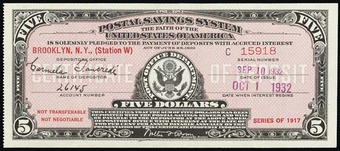
Certificate of Deposit
An example of an early Certificate of Deposit. A CD may be a “cash equivalent” if it meets certain criteria.
Cash equivalents can also include government and corporate bonds, marketable securities and commercial paper. However, these types of instruments are only included in cash if they mature within three months from when the the financial statements are prepared and there is a minimal risk of these investments losing their value. So if a corporate bond matures within three months, but the company that issued it may not be able to settle the debt, one would not be able to include that as a cash equivalent.
Other investments and securities that are not cash equivalents include postage stamps, IOUs, and notes receivable because these are not readily converted to cash.
4.1.3: Reporting Cash
Cash and cash equivalents are reported in the current asset section of a business’s balance sheet.
Key Points
- While a company may have several cash accounts in its general ledger, cash is usually reported on one line of a business’s balance sheet.
- A business can provide further detail about its cash balance in the footnotes on the financial statements.
- The cash value on the balance sheet will only be accurate as of the end of the business on the date listed on the statement.
Key Terms
- Current Asset
-
In accounting, a current asset is an asset on the balance sheet which can either be converted to cash or used to pay current liabilities within 12 months.
- Notes to the Financial Statements
-
Notes to financial statements (notes) are additional information added to the end of financial statements and help explain specific items in the financial statements as well as provide a more comprehensive assessment of a company’s financial condition.
Cash is an asset, which means it is included in a business’s balance sheet . Since cash is highly liquid and can be used immediately to settle a business’s debts, it is included in the current asset section of the balance sheet. Cash is reported on the balance sheet at its current monetary, or fair, value to accurately reflect the entity’s value on the statement. .
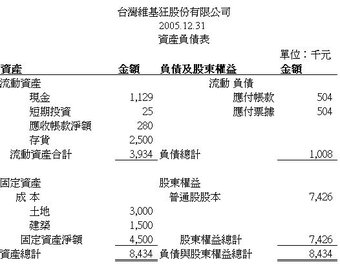
Sample Balance Sheet in Chinese
A sample balance sheet in Chinese. Cash and cash equivalents are reported on the balance sheet.

Balance Sheet
Cash is reported on a company’s balance sheet.
General Ledger
A company’s general ledger may have several accounts detailing how much cash it has. For example, it might have one account for petty cash, another for how much cash it has in one bank account, and another detailing how much money it has invested in a CD that will mature in less than three months. When the company’s cash balance is reported on its balance sheet, all of those accounts are combined into one “cash” line item.
Footnotes in Financial Statements
While the balance sheet may combine all cash and cash equivalents into one number, a business can provide further detail about its cash balance in the footnotes to the financial statements. These disclosures come after the financial reports are presented and can be used to explain specific items of financial activity. With regards to cash, the footnotes can explain how much of the cash balance was composed of actual currency and how much was cash equivalents.
Balance Sheet
A balance sheet is different from other financial statements because it describes a specific moment in time while the other statements describe activity over a period of time. As a result, the cash value on the balance sheet will only be accurate as of the end of the business on the date listed on the statement. When you receive a balance sheet, the current balance of cash might be very different from what is reported on the statement.
4.2: Managing Cash
4.2.1: Cash Controls
Cash internal controls is a system used to promote accuracy, prevent theft, and ensure a business has enough cash to pay its debts.
Learning Objective
Explain how internal cash controls benefit a company
Key Points
- Internal controls assure achievement of an organization’s objectives in operational effectiveness and efficiency, reliable financial reporting, and compliance with laws, regulations, and policies.
- According to the Committee of Sponsoring Organizations of the Treadway Commission (COSO), internal control has five components: the control environment, risk assessment, information and communication, control activities, and monitoring processes.
- Businesses will generally be required to perform an audit at least once a year on all of its financial reports and internal controls, including those controls associated with cash.
- Three common types of internal controls for cash include bank reconciliations, voucher systems, and electronic funds transfers (EFT).
Key Terms
- internal control
-
a process affected by an organization’s structure, work and authority flows, people and management information systems, designed to help the organization accomplish specific goals or objectives
- internal controls
-
In accounting and auditing, internal control is defined as a process affected by an organization’s structure, work and authority flows, people and management information systems, designed to help the organization accomplish specific goals or objectives [1]. It is a means by which an organization’s resources are directed, monitored, and measured. It plays an important role in preventing and detecting fraud and protecting the organization’s resources, both physical (e.g., machinery and property) and intangible (e.g., reputation or intellectual property such as trademarks).
- electronic funds transfer
-
the transfer of money from one account to another, either within a single financial institution or across multiple institutions, through computer-based systems
Every business should have internal controls regarding its financial activities. If designed well, internal controls can prevent theft and fraud. They also ensure that a business’s financial statements are accurate .

Balance Sheet
Internal controls are vital to ensure that financial statements, such as balance sheets, are accurate.
While internal control should be designed for every aspect of a business’s operation, the controls for cash are arguably among the most important. Since cash is the most liquid asset and the easiest for people to convert for their own needs, it is often the easiest thing to steal or misreport. Therefore, the internal controls associated with cash must be more stringent.
Goals for Internal Cash Controls
- Check that the business’s actual cash balances equal what is recorded in its financial records.
- Ensure that there is enough cash available to pay a business’s debts on time.
- Prevent the business from having “idle funds”—more cash than is necessary to function. These funds can instead by invested for higher return.
- Prevent theft or fraud.
Five Elements of Internal Controls
According to the Committee of Sponsoring Organizations of the Treadway Commission (COSO), internal control has five components:
- The Control Environment. Every business is different. A business comprised of five people will demand different controls than a company with 500 people. Prior to establishing any set of internal controls, you should consider the business’s management philosophy, the integrity of the employees, and the legal requirements established by the state and federal government.
- Risk Assessment. Next, you should consider how a business’s cash is at risk. Are large amounts of cash kept where employees have access to it? Who is responsible for receiving and depositing cash? Who is responsible for giving cash to settle debts? These are the types of questions that address what possible risks a business may face when it comes to cash.
- Control activities. Control activities are steps that a business takes to minimize risks. Examples of control activities include having different employees being responsible for different parts of the transaction. An example of a control activity would be having one person selling the product, another person receiving the money from the sale, and a third person checking to make sure that the agreed sales price equals what was deposited.
- Information and communication. Control activities must be designed and then executed by relying on information to be communicated between the people who control different aspects of the transaction. To minimize errors and fraud, the correct information must flow to the right people in a timely manner.
- Monitoring. The entire process must be reviewed by upper level management to ensure that every person is complying with their responsibilities. It is also generally required that the business audits its books and review its internal controls at least annually.
Common Cash Controls
- Bank Reconciliations: A process where the cash accounts on a business’s books are regularly checked against bank statements.
- Voucher System: A system focused on documenting every aspect of every transaction to ensure that all required payments are made and are only made once.
- Electronic Funds Transfer (EFT): By using services that transfer funds automatically, such as through PayPal, a business can minimize the number of people who have access to its funds. These types of transfers also tend to generate documentation showing when the transaction was made and with whom.
4.2.2: Using a Bank for Control
A bank is a good cash control because it limits employees’ access to company assets and provides documentation on withdrawals and deposits.
Learning Objective
Describe why a bank is one of the best internal controls a business can use
Key Points
- Internal controls are meant to ensure that a business’s assets are protected, that its financial data is accurate, and to ensure efficiency.
- Most banks keep “signature cards” on hand for business accounts so its tellers are aware of who can sign checks to withdraw funds. All other individuals are prevented from withdrawing cash from the business’s account.
- The bank generally sends the business a monthly statement summarizing the activity related to cash. The statement will generally also include the documentation related to each transaction.
Key Term
- control
-
A security mechanism, policy, or procedure that can counter system attack, reduce risks, and resolve vulnerabilities, synonymous with safeguard and counter-measure.
Money Control through a Bank
Using a bank is one of the best internal controls on a business’s cash. Internal controls are meant to ensure that a business’s assets are protected, that its financial data is accurate, and to ensure efficiency . For cash, this generally requires that the people with the ability to obtain a business’s cash are limited to a few select individuals and that each transaction is recorded in detail. The documents regarding each transaction should list when each deposit or withdrawal took place, who initiated the transaction, and how much cash was involved.

Deutsche Bank
Keeping money in a financial institution, such as Deutsche Bank, can provide a critical control over a business’s cash.
As an independent third party, a bank is less susceptible to schemes by a business’s employees to steal funds. Since a bank holds a business’s funds, it provides a physical barrier preventing employees from accessing the cash. Most banks keep “signature cards” on hand for business accounts so its tellers are aware who can sign checks to withdraw funds. All other individuals are prevented from withdrawing cash from the business’s account.
Banks generally require that every deposit is accompanied by a signed and dated deposit slip. Every withdrawal must be paired with a signed and dated check. These documents are kept by the bank to resolve any disputes that may arise regarding a transaction.
The bank generally also sends the business a monthly statement that summarizes the activity associated with the account. This statement will list all deposits and withdrawals. It will also include a copy of each transaction’s documentation. Generally, the person in charge of the business’s books will receive this documentation and compare it to the business’s own records. If there are any differences between the business records and the bank’s, the company can use the documentation enclosed with the statement to determine where the discrepancy is and contact the peopled involved with the questionable transactions.
4.2.3: Reconciling Cash Accounts and Bank Statements
A bank reconciliation is an internal control that ensures that the cash in its accounts equals what it has recorded in its books.
Learning Objective
Describe how a company uses a bank reconciliation as an internal control
Key Points
- Bank reconciliations are necessary because legitimate transactions that a business has recorded in its books might not be listed on its bank statements and vice versa.
- A bank reconciliation consists of a book balance column and a bank balance column. One column is adjusted by adding all of the legitimate transactions that either the bank statement or books do not show. The reconciliation is complete when the two columns equal each other.
- When a legitimate transaction that was not recorded in the books is discovered, it must be added by recording a journal entry.
Key Terms
- bank statement
-
a communication from a bank to a person holding an account in that bank, usually issued monthly, detailing the value of the holdings in that account and the effects of all transactions occurring with respect to that account
- journal entry
-
A journal entry, in accounting, is a logging of transactions into accounting journal items. The journal entry can consist of several items, each of which is either a debit or a credit. The total of the debits must equal the total of the credits or the journal entry is said to be “unbalanced. ” Journal entries can record unique items or recurring items, such as depreciation or bond amortization.
- Bank Reconciliation
-
A process that explains the difference between the bank balance shown in an organization’s bank statement, as supplied by the bank, and the corresponding amount shown in the organization’s own accounting records at a particular point in time.
A bank statement only reflects a specific period of time, such as one month . However, it takes the banks time to prepare the statement and send it out. Therefore, while a bank may prepare a statement for the month of October, a business might not receive it until a week later.
As a result, a bank statement will generally not reflect the amounts that a company has on its own books. This can be due to a few reasons. The company could have issued several checks prior to the end of the period, but the check holders had not cashed the check. The business could have also received some cash amounts prior to the end of the period covered by the statement, but was unable to deposit those amounts until after the period ended. The differences could also be due to mistakes, either by the bank or in the company’s books. The differences could also be due to something more troublesome, such as theft.
A bank reconciliation is a process that explains the difference between the bank statement on the amount shown in the organization’s own financial records. This process is important because it ensures that any differences are due to the timing of payments and not because of a mistake or theft.
Reconciliation Process
A bank reconciliation consists of two columns; one for the book balance, the other for the bank balance. The person reconciling the accounts then adjusts one column by adding deposits that had not yet been recorded and subtracting checks and other outlays that had not yet been cashed when the statement had been prepared. The reconciliation is not complete until the adjusted column equals the unadjusted column.
There may be some cases where the process reveals a legitimate transaction that was not recorded in the books. When that occurs, the person responsible for the business’s books must record the transaction using a journal entry.

Cash
Due to the amount of time between when a bank statement is prepared and when it is received by a business, the document may not accurately reveal what the business actually has in terms of cash. This is why reconciling the bank statement is necessary.
4.2.4: Basics of Cash Management
A company manages its cash primarily through the use of a voucher system and bank reconciliations.
Learning Objective
Explain how a voucher system helps a company manage their cash
Key Points
- A voucher system is used for monitoring cash payments.
- A voucher system consists of vouchers, an unpaid voucher file, a paid voucher file, a voucher register, and a check register.
- Before marking a voucher as paid, the person in charge of the system should check the transaction’s corresponding documentation, which generally includes a purchase order, invoice, and receiving report.
- Deposits are generally monitored through bank reconciliations.
Key Terms
- voucher
-
A receipt.
- purchase invoice
-
the buyer’s name for a commercial document issued by a seller to a buyer, indicating the products, quantities, and agreed prices for products or services the seller has provided the buyer
Managing cash is about monitoring how it comes in and goes out . To meet this goal, a business must come up with a system that not only documents all of these transactions, but organizes those documents in such a way so that any issues are immediately noticed by management.
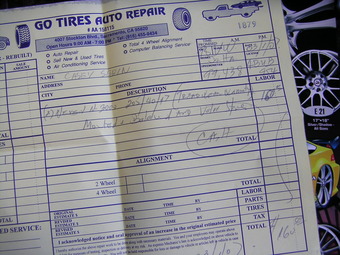
A current liability, such as a credit purchase, can be documented with an invoice.
Current liabilities are debt owed and payable no later than the current accounting period.
Voucher System
A voucher system is used primarily for monitoring and documenting payments made by a company to a third party. A voucher is composed of five parts.
- Individual vouchers: A voucher is a document that proves a payment was authorized and eventually made. Each voucher should be assigned a number to identify it. A voucher should be prepared for every transaction.
- Voucher register: Is a book or spreadsheet that lists every voucher.
- Unpaid voucher file: Where all vouchers that have been authorized, but not yet been paid are kept.
- Paid voucher file: Where all paid vouchers are kept. The paid vouchers should be filed in numerical order.
- Check register: A book or spreadsheet that records when all vouchers were paid and how it was paid. If the voucher was paid using a check, the check register will pair the voucher identification numbers with the check identification numbers.
When an obligation is about to be settled, the person in charge of the vouchers should review the other documents associated with the transaction prior to transferring the related voucher from the unpaid to paid file. The related documents generally include purchase orders, receiving reports, and invoices. These documents demonstrate that the payment was authorized, all goods and services that the business was supposed to get were received, and that the amount paid equaled the amount due.
Bank Reconciliations
Bank reconciliations, or the process of checking to make sure that a business’s financial records on cash equals how much is in the business’s bank accounts, are especially useful as a control over deposits. This type of control will be discussed in a later section.
4.3: Overview of Receivables
4.3.1: What Is a Receivable?
A receivable is money owed to a business by its clients and shown on its balance sheet as an asset.
Learning Objective
Identify a receivable
Key Points
- Accounts receivable is typically executed by generating an invoice and either mailing or electronically delivering it to the customer.
- A receivable represents money owed to the firm on the sale of products or services on credit.
- Receivables must be paid within an established time frame, called credit terms or payment terms.
Key Terms
- revenue
-
Income that a company receives from its normal business activities, usually from the sale of goods and services to customers.
- asset
-
Items of ownership convertible into cash; total resources of a person or business, as cash, notes and accounts receivable; securities and accounts receivable, securities, inventories, goodwill, fixtures, machinery, or real estate (as opposed to liabilities).
- receivable
-
Represents money owed to a business for the sale of products or services on credit.
What is a Receivable?
A receivable is money owed to a business by its clients and shown on its balance sheet as an asset. It is one of a series of accounting transactions dealing with the billing of a customer for goods and services that the customer has ordered. Accounts receivable is an asset which is the result of accrual accounting. In this case, the firm has delivered products or rendered services (hence, revenue has been recognized), but no cash has been received, as the firm is allowing the customer to pay at a later point in time.
Sales on Credit
Receivables represent money owed by entities to the firm on the sale of products or services on credit. In most business entities, accounts receivable is typically executed by generating an invoice and either mailing or electronically delivering it to the customer; who, in turn, must pay it within an established time frame. This is called credit terms or payment terms.
Use of Ledger
The accounts receivable departments use the sales ledger. This is because a sales ledger normally records:
- The sales a business has made.
- The amount of money received for goods or services.-
- The amount of money owed at the end of each month varies (debtors).
Accounts Receivable Department
The accounts receivable team is in charge of receiving funds on behalf of a company and applying it towards their current pending balances. Collections and cashiering teams are part of the accounts receivable department. While the collection’s department seeks the debtor, the cashiering team applies the monies received.

Money
Factoring makes it possible for a business to readily convert a substantial portion of its accounts receivable into cash.
4.3.2: Types of Receivables
Receivables can generally be classified as accounts receivables or notes receivable, though there are other types of receivables as well.
Learning Objective
Differentiate between accounts receivable, notes receivable and other receivables
Key Points
- Accounts receivable are amounts that customers owe the company for normal credit purchases.
- Notes receivable are amounts owed to the company by customers or others who have signed formal promissory notes in acknowledgment of their debts.
- Accounts receivable and notes receivable that result from company sales are called trade receivables, but there are other types of receivables as well.
Key Terms
- accounts receivable
-
Amounts that customers owe the company for normal credit purchases.
- Notes Receivable
-
Amounts owed to the company by customers or others who have signed formal promissory notes in acknowledgment of their debts.
Receivables can be classified as accounts receivables, notes receivable and other receivables ( loans, settlement amounts due for non-current asset sales, rent receivable, term deposits). Other receivables can be divided according to whether they are expected to be received within the current accounting period or 12 months (current receivables), or received greater than 12 months ( non-current receivables).
Accounts Receivable
Accounts receivable are amounts that customers owe the company for normal credit purchases . Since accounts receivable are generally collected within two months of the sale, they are considered a current asset. Accounts receivable usually appear on balance sheets below short-term investments and above inventory.

Types of Receivables
Classifying receivables…
Notes Receivable
Notes receivable are amounts owed to the company by customers or others who have signed formal promissory notes in acknowledgment of their debts. Promissory notes strengthen a company’s legal claim against those who fail to pay as promised. The maturity date of a note determines whether it is placed with current assets or long-term assets on the balance sheet. Notes that are due in one year or less are considered current assets, while notes that are due in more than one year are considered long-term assets.
Other Receivables
Accounts receivable and notes receivable that result from company sales are called trade receivables, but there are other types of receivables as well. For example, interest revenue from notes or other interest-bearing assets is accrued at the end of each accounting period and placed in an account named interest receivable. Wage advances, formal loans to employees, or loans to other companies create other types of receivables. If significant, these nontrade receivables are usually listed in separate categories on the balance sheet because each type of nontrade receivable has distinct risk factors and liquidity characteristics.
4.3.3: Recognizing Accounts Receivable
If you are operating under the accrual basis, you record account receivable transactions irrespective of any changes in cash.
Learning Objective
Describe the journal entry to record an accounts receivable transaction
Key Points
- Since not all customer debts will be collected, businesses typically estimate the amount of debts to be paid and then record an allowance for doubtful accounts.
- An example of a common payment term is Net 30, which means that payment is due at the end of 30 days from the date of invoice.
- Account receivables are classified as current assets assuming that they are due within one year.
Key Terms
- Allowance for Doubtful Accounts
-
An estimated amount of bad debts to be subtracted from a balance sheet’s accounts.
- Payment Terms
-
Forms of trade credit which specify that the net amount (the total outstanding on the invoice) is expected to be payment received in full 10, 15, 30, or 60 days after the goods are dispatched by the seller, or 10, 15, 30 or 60 days after the service is completed. Net 30 or Net 60 terms are often coupled with a credit for early payment.
- payment date
-
the day when the dividend checks will actually be mailed to the shareholders of a company or credited to brokerage accounts
Example
- The following example shows how accounts receivable is recognized — assume company Furniture Palace sells a sofa to Customer Jane on credit for $1,000. Assuming Furniture Palace uses the accrual method of accounting, a journal entry is recorded for the sale of the item and the extension of credit to the customer. The journal entry debits Accounts Receivable for $1,000 and credits Furniture Sales for $1,000.
Recognition of Accounts Receivables
If you are operating under the accrual basis, you record transactions irrespective of any changes in cash. This is the system under which you record an account receivable. In addition, there is a risk that the customer will not pay you. If so, you can either charge these losses to expense when they occur, known as the direct write-off method, or you can anticipate the amount of such losses and charge an estimated amount to expense, known as the allowance method .
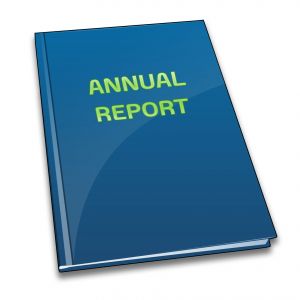
Using the Balance Sheet
The balance sheet is one of the financial reports included in a company’s annual report.
Booking a receivable is accomplished by a simple accounting transaction. However, the process of maintaining and collecting payments on the accounts receivable is more complex. Depending on the industry in practice, accounts receivable payments can be received up to 10 – 15 days after the due date has been reached. These types of payment practices are sometimes developed by industry standards, corporate policy, or because of the financial condition of the client.
Account receivables are classified as current assets assuming that they are due within one year. To record a journal entry for a sale on account, one must debit a receivable and credit a revenue account. When the customer pays off their accounts, one debits cash and credits the receivable in the journal entry. The ending balance on the trial balance sheet for accounts receivable is always debit.
Payment Terms
An example of a common payment term is Net 30, which means that payment is due at the end of 30 days from the date of invoice. The debtor is free to pay before the due date; businesses can offer a discount for early payment. Other common payment terms include Net 45, Net 60, and 30 days end of month.
Allowance for Doubtful Accounts
Since not all customer debts will be collected, businesses typically estimate the amount of and then record an allowance for doubtful accounts which appears on the balance sheet as a contra account that offsets total accounts receivable. Two methods are available to calculate the amount of bad debt expense and allowance of doubtful accounts at the end of an accounting period — percentage of accounts receivable or percentage of sales. When accounts receivables are not paid, some companies turn them over to third party collection agencies or collection attorneys who will attempt to recover the debt via negotiating payment plans, settlement offers or pursuing other legal action.
Examples of Allowance Calculation
An example of how to calculate the allowance for doubtful accounts using the percentage of receivables method — Assume Furniture Palace has an ending accounts receivable balance of USD 10,000 and estimates that 5% of receivables are doubtful. To adjust the allowance account for the new estimate, debit Bad Debt Expense for USD 500 (10,000 *0.05) and credit Allowance for Doubtful Accounts for USD 500.
To calculate the allowance for doubtful accounts using the percentage of total sales, estimate the percentage of sales that will be uncollectible. Furniture Palace estimates that 10% of the period’s USD 20,000 total sales may not be collected. To adjust the allowance account for the new period’s estimate, debit Bad Debt Expense for USD 2,000 (20,000 *0.10) and credit Allowance for Doubtful Accounts for USD 2,000.
4.3.4: Valuing Accounts Receivable
Receivables of all types are normally reported at their net realizable value, which is the amount the company expects to receive in cash.
Learning Objective
Differentiate between the direct write-off method and the allowance method of accounts receivable valuation
Key Points
- Uncollectible accounts are called bad debts.
- Companies use two methods to account for bad debts: the direct write-off method and the allowance method.
- Business owners know that some customers who receive credit will never pay their account balances.
- GAAP requires companies to use the Allowance Method.
Key Terms
- direct write-off method
-
a way of reducing accounts receivable to its net realizable value through a single entry
- Direct Write-Off
-
Bad debts are recognized only after the company is certain the debt will not be paid.
- Allowance Method
-
An adjustment is made at the end of each accounting period to estimate bad debts based on the business activity from that accounting period.
- direct method
-
a way to construct the cash flow statement by reporting major classes of gross cash receipts and payments
Valuation
Receivables of all types are normally reported on the balance sheet at their net realizable value, which is the amount the company expects to receive in cash .

Valuing Receivables
Receivables are recorded at net realizable value.
Business owners know that some customers who receive credit will never pay their account balances. These uncollectible accounts are called bad debts. Companies use two methods to account for bad debts: the direct write-off method and the allowance method.
Direct Write-Off Method
For tax purposes, companies must use the direct write-off method, under which bad debts are recognized only after the company is certain the debt will not be paid. Before determining that an account balance is not collectible, a company generally makes several attempts to collect the debt from the customer.
Recognizing the bad debt requires a journal entry that increases a bad debts expense account and decreases accounts receivable. If a customer named J. Smith fails to pay a $100 balance, for example, the company records the write-off by debiting bad debts expense and crediting accounts receivable from J. Smith.
Allowance Method
Under the allowance method, an adjustment is made at the end of each accounting period to estimate bad debts based on the business activity from that accounting period. Established companies rely on past experience to estimate unrealized bad debts, but new companies must rely on published industry averages until they have sufficient experience to make their own estimates.
The adjusting entry to estimate the expected value of bad debts does not reduce accounts receivable directly. Accounts receivable is a control account that must have the same balance as the combined balance of every individual account in the accounts receivable subsidiary ledger.
Since the specific customer accounts that will become uncollectible are not yet known when the adjusting entry is made, a contra-asset account named allowance for bad debts, which is sometimes called allowance for doubtful accounts, is subtracted from accounts receivable to show the net realizable value of accounts receivable on the balance sheet.
4.4: Notes Receivable
4.4.1: Components of a Note
Notes Receivable represents claims for which formal instruments of credit are issued as evidence of debt, such as a promissory note.
Learning Objective
Explain the purpose of a note receivable and its format
Key Points
- A notes receivable normally requires the debtor to pay interest and extends for time periods of 30 days or longer.
- Often a business will allow a customer to convert their overdue accounts into a notes receivable. Doing so gives the debtor more time to pay.
- The principle is the face value of the note. The principle equals the initial amount of credit provided.
- The maker of a note is the party who receives the credit and promises to pay the note’s holder.
- Notes generally specify an interest rate, which is used to determine how much interest the maker of the note must pay in addition to the principal.
Key Terms
- debtor
-
One who owes another anything, or is under obligation, arising from express agreement, implication of law, or principles of natural justice, to pay money or to fulfill some other obligation; in bankruptcy or similar proceedings, the person who is the subject of the proceeding.
- promissory
-
Stipulating the future actions required of the parties to an insurance policy or other business agreement.
- promissory note
-
a document saying that someone owes a specific amount of money to someone else, often with the deadline and interest fees
- maker
-
the party issuing a promisory note
- payee
-
the party receiving the promisory note
Notes Receivable
Notes Receivable represents claims for which formal instruments of credit are issued as evidence of debt, such as a promissory note. Often a business will allow a customer to convert their overdue accounts into a notes receivable. Doing so gives the debtor more time to pay. Occasionally, the notes receivable will include a personal guarantee by the owner of the debtor.
A notes receivable normally requires the debtor to pay interest and extends for time periods of 30 days or longer. Notes receivable are considered current assets if they are to be paid within 1 year and non-current if they are expected to be paid after one year.

Confederate Note Receivable
A One Hundred Dollar Confederate States of America banknote dated December 22, 1862. Issued during the American Civil War (1861–1865).
Components of a Note Receivable
Principle-the principle is the face value of the note. The principle equals the initial amount of credit provided.
Maker-the maker of a note is the party who receives the credit and promises to pay the note’s holder. The maker classifies the note as a note payable.
Payee-the payee is the party that holds the note and receives payment from the maker when the note is due. The payee classifies the note as a note receivable.
Interest-notes generally specify an interest rate, which is used to determine how much interest the maker of the note must pay in addition to the principal.
Calculating interest-interest on short-term notes is calculated according to the following formula:
principle x annual interest rate x time period in years = interest
Example: interest on a four-month, 9%, $1,000 note equals $30
4.4.2: Recognizing Notes Receivable
In accounting, notes receivables are accounts to keep track of accrued assets that have been earned but not yet received.
Learning Objective
Describe the difference between using the allowance method vs. the write off method when recording a note receivable
Key Points
- To record a journal entry for a sale on account, one must debit a receivable and credit a revenue account.
- When the receivable is payed off, debit the cash account and credit the receivable account.
- To estimate the net value of accounts receivable, subtract the balance of an allowance account from the accounts receivable account.
- Account for bad debts by either the allowance method or the direct write-off method.
Key Terms
- journal entry
-
A journal entry, in accounting, is a logging of transactions into accounting journal items. The journal entry can consist of several items, each of which is either a debit or a credit. The total of the debits must equal the total of the credits or the journal entry is said to be “unbalanced. ” Journal entries can record unique items or recurring items, such as depreciation or bond amortization.
- bad debt
-
A debt which cannot be recovered from the debtor, either because the debtor doesn’t have the money to pay or because the debtor cannot be found and/or forced to pay.
- balance sheet
-
A summary of a person’s or organization’s assets, liabilities. and equity as of a specific date.
In accounting, notes receivables are accounts to keep track of accrued assets that have been earned but not yet received.
Accrued Assets
Accrued assets are assets, such as interest receivable or accounts receivable, that have not been recorded by the end of an accounting period. These assets represent rights to receive future payments that are not due at the balance sheet date. To present an accurate picture of the affairs of the business on the balance sheet, firms recognize these rights at the end of an accounting period by preparing an adjusting entry to correct the account balances. To indicate the dual nature of these adjustments, they record a related revenue in addition to the asset. We also call these adjustments ‘accrued revenues’ because the revenues must be recorded.
Recognizing and Reporting Notes Receivable
To record a journal entry for a sale on account, one must debit a receivable and credit a revenue account. When the customer pays off their accounts, one debits cash and credits the receivable in the journal entry. For example, a sale on account would be recorded similarly to the following interest receivable journal entry:

Notes Receivable Example
Recording an interest receivable journal entry
The ending balance on the trial balance sheet for accounts receivable is usually a debit. Business organizations which have become too large to perform such tasks by hand (or small ones that could but prefer not to) will generally use accounting software on a computer to perform this task. Companies have two methods available to them for measuring the net value of accounts receivable, which is generally computed by subtracting the balance of an allowance account from the accounts receivable account.
Allowance method
The first method is the allowance method, which establishes a contra-asset account, allowance for doubtful accounts, or bad debt provision, that has the effect of reducing the balance for accounts receivable.
The amount of the bad debt provision can be computed in two ways, either (1) by reviewing each individual debt and deciding whether it is doubtful (a specific provision); or (2) by providing for a fixed percentage (e.g. 2%) of total debtors (a general provision). The change in the bad debt provision from year to year is posted to the bad debt expense account in the income statement.
Direct write-off method
This second method is simpler than the allowance method in that it allows for one simple entry to reduce accounts receivable to its net realizable value. The entry would consist of debiting a bad debt expense account and crediting the respective accounts receivable in the sales ledger.
The two methods are not mutually exclusive, and some businesses will have a provision for doubtful debts, writing off specific debts that they know to be bad (for example, if the debtor has gone into liquidation. )
4.4.3: Valuing Notes Receivable
Companies have two methods available to them for measuring the net value of accounts receivable: the allowance method and the direct write-off method.
Learning Objective
Differentiate between the allowance method and the write off method for valuing notes receivable
Key Points
- Notes Receivable represents claims for which formal instruments of credit are issued as evidence of debt, such as a promissory note.
- The direct write-off method is simpler than the allowance method in that it allows for one simple entry to reduce accounts receivable to its net realizable value.
- The allowance method, which establishes a contra-asset account, allowance for doubtful accounts, or bad debt provision, that has the effect of reducing the balance for accounts receivable.
- The two methods are not mutually exclusive, and some businesses will have a provision for doubtful debts, writing off specific debts that they know to be bad.
Key Terms
- write-off
-
To remove a portion of a debt or an amount of an account owed to you counting it as a loss (as a gesture of goodwill for example)
- revenue
-
Income that a company receives from its normal business activities, usually from the sale of goods and services to customers.
Notes Receivable
Notes Receivable represents claims for which formal instruments of credit are issued as evidence of debt, such as a promissory note. The credit instrument normally requires the debtor to pay interest and extends for time periods of 30 days or longer. Notes receivable are considered current assets if they are to be paid within 1 year and non-current if they are expected to be paid after one year.
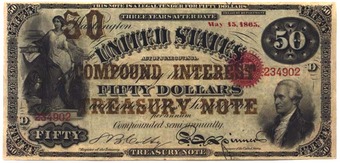
Compound Interest Treasury Note
Notes are short-term investment vehicles.
Reporting of Cash and Receivables
Accrued revenue (or accrued assets) is an asset such as proceeds from a delivery of goods or services, at which such income item is earned and the related revenue item is recognized, while cash for them is to be received in a latter accounting period. At that point its amount is deducted from accrued revenues.
Valuing Notes/Accounts Receivable
Companies have two methods available to them for measuring the net value of accounts receivable–the allowance method and the direct write-off method.
The Allowance Method
The first method is the allowance method, which establishes a contra-asset account, allowance for doubtful accounts, or bad debt provision, that has the effect of reducing the balance for accounts receivable. The amount of the bad debt provision can be computed in two ways:
- by reviewing each individual debt and deciding whether it is doubtful (a specific provision)
- by providing for a fixed percentage (e.g. 2%) of total debtors (a general provision)
The Direct Write Off Method
The second method is the direct write off method. It is simpler than the allowance method in that it allows for one simple entry to reduce accounts receivable to its net realizable value. The entry would consist of debiting a bad debt expense account and crediting the respective accounts receivable in the sales ledger.
4.4.4: Write-Offs
Companies use two methods for handling uncollectible accounts: the allowance method and the direct write-off method.
Learning Objective
Explain how to write off an uncollectible account using both the direct write-off and the allowance method.
Key Points
- The direct write-off method is simpler than the allowance method in that it allows for one simple entry to reduce accounts receivable to its net realizable value.
- When using the allowance method, an estimate is made at the end of each fiscal year of the amount of bad debt.
- The portion of the account receivable that is estimated to be not collectible is set aside in a contra-asset account called Allowance for Doubtful Accounts.
- At the end of each accounting cycle, adjusting entries are made to charge uncollectible receivable as expense.
- The actual amount of uncollectible receivables is written off as an expense from Allowance for Doubtful Accounts.
Key Terms
- write-off
-
The cancellation of an item; the amount cancelled or lost.
- uncollectible
-
Receivables that cannot be collected.
Write-offs
Because customers do not always keep their promises to pay, companies must provide for these uncollectible accounts in their records. This phenomenon is known, in the realm of accounting, as bad debt.
Companies use two methods for handling uncollectible accounts: the direct write-off method and the allowance method. The direct write-off method is simpler than the allowance method in that it allows for one simple entry to reduce accounts receivable to its net realizable value. The entry would consist of debiting a bad debt expense account and crediting the respective accounts receivable in the sales ledger. The bad debt is recognized as an expense at the point when judged to be uncollectible.
When using the allowance method, an estimate is made at the end of each fiscal year of the amount of bad debt. This amount is accumulated in a provision, which is then used to reduce specific receivable accounts when necessary. Note that the allowance method is the required method for federal income tax purposes (GAAP).

Uncollectibles
Interesting Facts About Collection Agencies.
Because of the matching principle of accounting, revenues and expenses should be recorded in the period in which they are incurred. When a sale is made on account, revenue is recorded along with account receivable. Because there is an inherent risk that clients might default on payment, accounts receivable have to be recorded at net realizable value. The portion of the account receivable that is estimated to be not collectible is set aside in a contra-asset account called Allowance for Doubtful Accounts. At the end of each accounting cycle, adjusting entries are made to charge uncollectible receivable as expense. The actual amount of uncollectible receivables is written off as an expense from Allowance for Doubtful Accounts.
Allowance Method Example
As time passes and a firm considers a specific customer’s account to be uncollectible, it writes that account off. It debits the Allowance for Doubtful Accounts. The credit is to the Accounts Receivable control account in the general ledger and to the customer’s account in the accounts receivable subsidiary ledger. For example, assume Smith’s USD 750 account has been determined to be uncollectible. The entry to write off this account is:
Allowance for Uncollectible Accounts (-SE) 750
Accounts Receivable—Smith (-A) 750
The credit balance in Allowance for Doubtful Accounts before making this entry represented potential uncollectible accounts not yet specifically identified. Debiting the allowance account and crediting Accounts Receivable shows that the firm has identified Smith’s account as uncollectible. Notice that the debit in the entry to write off an account receivable does not involve recording an expense. The company recognized the uncollectible accounts expense in the same accounting period as the sale. If Smith’s USD 750 uncollectible account were recorded in Uncollectible Accounts Expense again, it would be counted as an expense twice.
A write-off does not affect the net realizable value of accounts receivable. For example, suppose that Amos Company has total accounts receivable of USD 50,000 and an allowance of USD 3,000 before the previous entry; the net realizable value of the accounts receivable is USD 47,000. After posting that entry, accounts receivable are USD 49,250, and the allowance is USD 2,250; net realizable value is still USD 47,000, as shown here:
Before Write-Off // Entry for After Write-Off // Write-Off
Accounts receivable 50,000 Dr. // 750 Cr. // $ 49,250 Dr.
Allowance for uncollectible accounts 3,000 Cr. // 750 Dr. // 2,250 Cr.
Net realizable value 47,000 Dr. // $47,000
You might wonder how the allowance account can develop a debit balance before adjustment. To explain this, assume that Jenkins Company began business on January 1, 2009, and decided to use the allowance method and make the adjusting entry for uncollectible accounts only at year-end. Thus, the allowance account would not have any balance at the beginning of 2009. If the company wrote off any uncollectible accounts during 2009, it would debit Allowance for Uncollectible Accounts and cause a debit balance in that account. At the end of 2009, the company would debit Uncollectible Accounts Expense and credit Allowance for Uncollectible Accounts. This adjusting entry would cause the allowance account to have a credit balance.
During 2010, the company would again begin debiting the allowance account for any write-offs of uncollectible accounts. Even if the adjustment at the end of 2009 was adequate to cover all accounts receivable existing at that time that would later become uncollectible, some accounts receivable from 2010 sales may be written off before the end of 2010. If so, the allowance account would again develop a debit balance before the end-of-year 2010 adjustment.
4.5: Basics of Receivables Management
4.5.1: Activities to Manage Receivables
Accounts receivable represents money owed by entities to the firm on the sale of products or services on credit.
Learning Objective
Summarize how a company manages its accounts receivable
Key Points
- Collections and cashiering teams are part of the accounts receivable department. While the collection’s department seeks the debtor, the cashiering team applies the monies received.
- An example of a common payment term is Net 30, which means that payment is due at the end of 30 days from the date of invoice.
- The first method of bookkeeping is the allowance method. It establishes a contra-asset account, allowance for doubtful accounts, or bad debt provision, that has the effect of reducing the balance for accounts receivable.
- The second method of bookkeeping is the direct write-off method. It is simpler than the allowance method in that it allows for one simple entry to reduce accounts receivable to its net realizable value (debiting a bad debt expense account and crediting the respective accounts receivable).
Key Terms
- debtor
-
One who owes another anything, or is under obligation, arising from express agreement, implication of law, or principles of natural justice, to pay money or to fulfill some other obligation; in bankruptcy or similar proceedings, the person who is the subject of the proceeding.
- receivable
-
A debt owed, usually to a business, from the perspective of that business.
Basics of Accounts Receivables
Accounts receivable (or debtors) represent money owed to a business by its clients (customers). It is shown on its balance sheet as an asset. It is one of a series of accounts dealing with the billing of a customer for goods and services that the customer has ordered.
Accounts receivable represents money owed by entities to the firm on the sale of products or services on credit. In most business entities, accounts receivable is typically executed by generating an invoice and either mailing or electronically delivering it to the customer, who, in turn, must pay it within an established time-frame, called credit terms or payment terms.
The accounts receivable departments use the sales ledger. This is because a sales ledger normally records:
- The sales a business has made.
- The amount of money received for goods or services.
- The amount of money owed at the end of each month varies (debtors).
The accounts receivable team is in charge of receiving funds on behalf of a company and applying it towards their current pending balances.
Collections and cashiering teams are part of the accounts receivable department. While the collection’s department seeks the debtor, the cashiering team applies the monies received.
Payment Terms
An example of a common payment term is Net 30, which means that payment is due at the end of 30 days from the date of invoice. The debtor is free to pay before the due date. Businesses can offer a discount for early payment. Other common payment terms include Net 45, Net 60, and 30 days end of month.
Bookkeeping
Account receivables are classified as current assets assuming that they are due within one year. To record a journal entry for a sale on account, one must debit a receivable and credit a revenue account. When the customer pays off their accounts, one debits cash and credits the receivable in the journal entry. The ending balance on the trial balance sheet for accounts receivable is usually a debit .
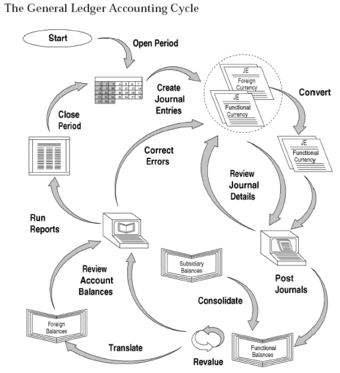
General Accounting Cycle
Figure shows the accounting cycle.
Two Methods
The first method is the allowance method, which establishes a contra-asset account, allowance for doubtful accounts, or bad debt provision, that has the effect of reducing the balance for accounts receivable. The amount of the bad debt provision can be computed in two ways, either (1) by reviewing each individual debt and deciding whether it is doubtful (a specific provision) or (2) by providing for a fixed percentage (e.g. 2%) of total debtors (a general provision). The change in the bad debt provision from year to year is posted to the bad debt expense account in the income statement.
The second method is the direct write-off method. It is simpler than the allowance method in that it allows for one simple entry to reduce accounts receivable to its net realizable value. The entry would consist of debiting a bad debt expense account and crediting the respective accounts receivable in the sales ledger.
4.5.2: Managing to Prevent Fraud
To help prevent fraudulent activities, management must implement internal controls/structure and know what situations to look for.
Learning Objective
Explain how a company can prevent fraud by establishing internal controls
Key Points
- Employees are more likely to commit fraud when under situational or financial pressure, and when the opportunity to commit fraud is present.
- One of the main factors of an effective internal control system is segregation of duties. To segregate duties, a company can involve more than one person in the financial statement preparation process. For fraud to occur in this situation, two employees must collude to perpetrate the crime.
- A strong control environment (top management control) involves enlisting management to demonstrate ethical behavior.
- Outside parties performing annual examinations of financial statements can prevent management from committing fraud.
Key Terms
- accounting
-
The development and use of a system for recording and analyzing the financial transactions and financial status of a business or other organization.
- fraud
-
Any act of deception carried out for the purpose of unfair, undeserved, and/or unlawful gain.
- control
-
A security mechanism, policy, or procedure that can counter system attack, reduce risks, and resolve vulnerabilities, synonymous with safeguard and counter-measure.
Example
- To meet financial goals for the company managers may be tempted to “cook the books. ” To help prevent management from adjusting financial statements, an independent auditor should examine financial statements on an annual basis.
Failure to Prevent Fraud
Failure to implement adequate internal controls can result in financial statement fraud (purposely misstated financial statements) or embezzlement (theft). This is when the services of a forensic accountant may be necessary. Forensic accounting is the application of accounting methodology to legal issues. It is frequently associated with the investigation of civil or criminal white-collar crime such as fraud, embezzlement, and general abuse of funds issues. Typical tools used in forensic accounting are bank records, personal financial statements, interviews, and credit reports. The forensic accountant’s responsibility is to gather and analyze the evidence and deliver clear, accurate, and unbiased reports reflecting the results of the investigation.
Ways to Prevent Fraud
Educate Management
Financial statement fraud involves the intentional publishing of false information in any portion of a financial statement.
To help prevent fraudulent activities, management must implement internal controls/structure, and know what situations to look for. Employees are more likely to commit fraud when under situational or financial pressure, and when the opportunity to commit fraud is present .

Occupy Wall Street – Fraud
Occupy Wall Street protester with a sign defining fraud.
Separate Accounting Functions
One of the main factors of an effective internal control system is segregation of duties. Management helps to prevent fraud by reducing the incentives of fraud.
One incentive, the opportunity to commit fraud, can be reduced when accounting functions are separated. The act of segregating duties separates the record-keeping, authorization, and review functions in the accounting process. To segregate duties, a company can involve more than one person in the financial statement preparation process. For fraud to occur in this situation, two employees must collude to perpetrate the crime.
Control Environment
A strong control environment (top management control) involves enlisting management to demonstrate ethical behavior. Whatever tone management sets will have a trickle-down effect to the employees. A strong tone is developed by establishing and complying with a written set of policies which are concise and include consequences when procedures are disobeyed. In addition, one of the easiest ways to establish a strong moral tone for an organization is to hire employees with strong ethics/morals.
External Controls
Outside parties performing annual examinations of financial statements can prevent management from committing fraud. To meet financial goals for the company managers may be tempted to “cook the books. ” To help prevent management from adjusting financial statements, an independent auditor should examine financial statements on an annual basis.
4.6: Reporting and Analyzing Receivables
4.6.1: Classifying Receivables
Receivables can be classified as accounts receivables, trade debtors, bills receivable, and other receivables.
Learning Objective
Distinguish between accounts receivable, trade debtors, bills receivables and other receivables
Key Points
- Accounts receivable is the money owed to that company by entities outside of the company. Trade debtors are the receivables owed by the company’s customers.
- Other receivables can be divided according to whether they are expected to be received within the current accounting period or 12 months (current receivables), or received greater than 12 months (non-current receivables).
- Not all accounts receivables will be paid, and an allowance has to be made for bad debts. The allowance for bad debts can be calculated either as the percentage of net credit sales or by the ageing method of estimating bad debts.
Key Term
- allowance for bad debts
-
Since not all customer debts will be collected, businesses typically estimate the amount of and then record an allowance for doubtful accounts which appears on the balance sheet as a contra accounts that offsets total accounts receivable. When accounts receivable are not paid, some companies turn them over to third party collection agencies or collection attorneys who will attempt to recover the debt via negotiating payment plans, settlement offers or pursuing other legal action.
Accounts receivable represents money owed by entities to the firm on the sale of products or services on credit. In most business entities, accounts receivable is typically executed by generating an invoice and either mailing or electronically delivering it to the customer. In turn, the customer must pay it within an established time frame, which is called the credit terms or payment terms.
An example of a common payment term is Net 30, which means that payment is due at the end of 30 days from the date of invoice. The debtor is free to pay before the due date. To encourage this, businesses can offer a discount for early payment. Other common payment terms include Net 45, Net 60, and 30 days end of month.
On a company’s balance sheet, receivables can be classified as accounts receivables or trade debtors, bills receivable, and other receivables (loans, settlement amounts due for non-current asset sales, rent receivables, term deposits). Accounts receivable is the money owed to that company by entities outside of the company. Trade receivables are the receivables owed by the company’s customers. Other receivables can be divided according to whether they are expected to be received within the current accounting period or 12 months (current receivables), or received greater than 12 months (non-current receivables) .
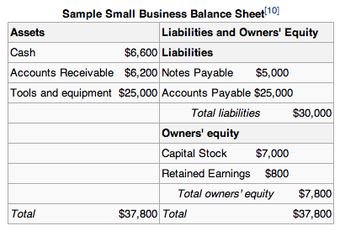
Balance sheet
Sample balance sheet
Not all accounts receivables will be paid, and an allowance has to be made for bad debts. The allowance for bad debts can be calculated either as the percentage of net credit sales or by the ageing method of estimating bad debts. These are determined by historical accounting information. Accounts receivable therefore can be classified according to their age. The Accounts Receivable Age Analysis Printout, also known as the Debtors Book is divided in categories for current, 30 days, 60 days, 90 days, 120 days, 150 days,180 days, and overdue.
4.6.2: Dealing with Foreign Currency and Bad Debts
To deal with foreign currency and bad debts, we have a “gain or loss” account and methods to measure the net value of accounts receivable.
Learning Objective
Explain how the “gain or loss” account is used for foreign currency transactions and bad debts
Key Points
- On a company’s balance sheet, accounts receivable is the money owed to that company by entities outside of the company.
- To deal with foreign currency, companies have a “foreign currency transaction gain or loss” that typically is included in arriving at earnings in the income statement for the period in which the exchange rate is changed.
- To deal with bad debts, companies have two methods available to them for measuring the net value of accounts receivable, which is generally computed by subtracting the balance of an allowance account from the accounts receivable account, namely the allowance method and the write-off method.
Key Term
- functional currency
-
Functional currency refers to the main currency used by a business or unit of a business. It is the monetary unit of account of the principal economic environment in which an economic entity operates.
On a company’s balance sheet, accounts receivable is the money owed to that company by entities outside of the company. The receivables owed by the company’s customers are called trade receivables. Account receivables are classified as current assets, assuming that they are due within one calendar year or fiscal year.
A foreign currency transaction requires settlement in a currency other than the functional currency. A change in exchange rates between the functional currency and the currency in which a transaction is denominated increases or decreases the expected amount of functional currency cash flows upon settlement of the transaction. This change in expected functional currency cash flows is a “foreign currency transaction gain or loss” that typically is included in arriving at earnings in the income statement for the period in which the exchange rate is changed.
To deal with bad debts, companies have two methods available to them for measuring the net value of accounts receivable, which is generally computed by subtracting the balance of an allowance account from the accounts receivable account.
The first method is the allowance method, which establishes a contra-asset account, allowance for doubtful accounts, or bad debt provision, that has the effect of reducing the balance for accounts receivable. The allowance for bad debt/doubtful accounts is a permanent account. While the corresponding bad debt expense account is a temporary account that is zeroed out annually.
The amount of the bad debt provision can be computed in two ways: either by reviewing each individual debt and deciding whether it is doubtful (a specific provision), or by providing for a fixed percentage (e.g. 2%) of total debtors (a general provision). The change in the bad debt provision from year to year is posted to the bad debt expense account in the income statement .
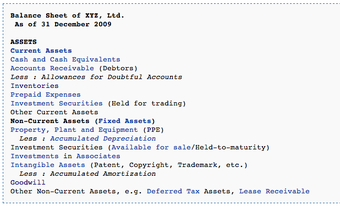
Allowance for Doubtful Accounts
Allowance for Doubtful Accounts (the allowance method)
The second method is the direct write-off method. It is simpler than the allowance method in that it allows for one simple entry to reduce accounts receivable to its net realizable value. The entry would consist of debiting a bad debt expense account and crediting the respective accounts receivable in the sales ledger.
4.6.3: Reporting Receivables
Accounts receivable are reported as a line item on the balance sheet and in a more detailed again report.
Learning Objective
Review the purpose of the accounts receivable aging report
Key Points
- An accounts receivable aging report summarizes receivables based on their age—that is, how long they have been outstanding.
- The accounts receivable age analysis, also known as the Debtors Book, is divided in categories—current, 30 days, 60 days, 90 days, 120 days, 150 days, 180 days, and overdue—that are produced in modern accounting systems.
- The aging report can help a business identify issues soon after they arise and prevent larger problems from occurring later on.
Key Terms
- aging the accounts receivable
-
dividing the account receivable according the days until due ranging from current to overdue
- General Ledger
-
General Ledger is the final repository of the accounting records and data. In modern accounting softwares, the general ledger works as a central repository for accounting data transferred from all sub-ledgers or modules like accounts payable, accounts recievable, cash management, fixed assets, purchasing and projects. General ledger is the backbone of any accounting system which holds financial and non-financial data for an organization.
Accounts receivable are reported as a line item on the balance sheet. Supplementary reports, such as the accounts receivable aging report, provide further detail.
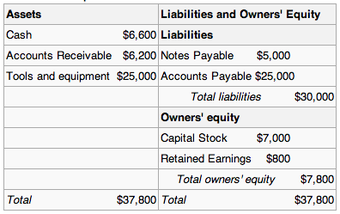
Balance sheet
Accounts receivable are a line item in a balance sheet.
The aging report, for example, shows how long invoices from each customer have been outstanding. Generally the accounts in an aging report are subdivided into categories based on how overdue the invoices are.
An accounts receivable aging report summarizes receivables based on their age—how long they have been outstanding. The accounts receivable age analysis, also known as the Debtors Book, is divided into categories for current, 30 days, 60 days, 90 days, 120 days, 150 days, 180 days, and overdue that are produced in modern accounting systems. For example, all the unpaid invoices posted in the past month are current, all the unpaid invoices from the prior month are over 30 days, the unpaid invoices from two months ago are over 60 days, etc. The aging report can help a business identify issues soon after they arise and prevent larger problems from occurring later on.
4.6.4: Using the Receivables Turnover Ratio
The receivables turnover ratio measures how efficiently a firm uses its assets.
Learning Objective
Summarize the importance of the receivables turnover ratio
Key Points
- The receivables turnover ratio measures how efficiently a firm gives credit and collects debts.
- The receivables turnover ratio is also used in calculating the days’ sales in receivables, the average collection period, the average debtor collection period, and the average payment period in days.
Receivables Turnover Ratio
The receivables turnover ratio, also called the debtor’s turnover ratio, is an accounting measure used to measure how effective a company is in extending credit as well as collecting debts. The receivables turnover ratio is an activity ratio, measuring how efficiently a firm uses its assets.
The formula of the receivables turnover ratio is:
A high ratio implies either that a company operates on a cash basis or that its extension of credit and collection of accounts receivable is efficient; in contrast, a low ratio implies the company is not making the timely collection of credit.
Other Uses
Sometimes the receivables turnover ratio is expressed as the “days’ sales in receivables”:
The average collection period can be calculated as follows:
The average debtor collection period can be calculated as follows:
Finally, the average creditor payment period can be calculated as follows:
Chapter 3: Overview of Financial Statements
3.1: The Income Statement
3.1.1: Defining the Income Statement
Income statement is a company’s financial statement that indicates how the revenue is transformed into the net income.
Learning Objective
Indicate the purpose of the income statement
Key Points
- Income statement displays the revenues recognized for a specific period, and the cost and expenses charged against these revenues, including write-offs and taxes.
- The income statement can be prepared in two methods. The Single Step income statement takes a simpler approach, totaling revenues and subtracting expenses to find the bottom line. The Multi-Step income statement takes several steps to find the bottom line, starting with the gross profit.
- Income statements should help investors and creditors determine the past financial performance of the enterprise, predict future performance, and assess the capability of generating future cash flows through report of the income and expenses.
Key Term
- FIFO
-
FIFO is an acronym for First In, First Out, which is an abstraction related to ways of organizing and manipulation of data relative to time and prioritization. This expression describes the principle of a queue processing technique or servicing conflicting demands by ordering process by first-come first-served (FCFS) behaviour: where the persons leave the queue in the order they arrive, or waiting one’s turn at a traffic control signal.
Income statement, also referred to as profit and loss statement (P&L), revenue statement, statement of financial performance, earnings statement, operating statement or statement of operations, is a company’s financial statement that indicates how the revenue (cash or credit sales of products and services before expenses are taken out) is transformed into the net income (the result after all revenues and expenses have been accounted for, also known as Net Profit or “bottom line”). It displays the revenues recognized for a specific period, and the cost and expenses charged against these revenues, including write-offs (e.g., depreciation and amortization of various assets) and taxes.
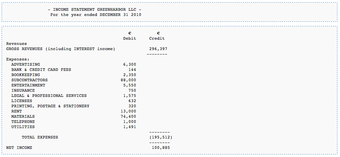
Example Income Statement
Income statement Green Harbor LLC
The purpose of the income statement is to show managers and investors whether the company made or lost money during the period being reported. The important thing to remember about an income statement is that it represents a period of time. This contrasts with the balance sheet, which represents a single moment in time.
The income statement can be prepared in one of two methods. The Single Step income statement takes a simpler approach, totaling revenues and subtracting expenses to find the bottom line. The more complex Multi-Step income statement (as the name implies) takes several steps to find the bottom line, starting with the gross profit. It then calculates operating expenses and, when deducted from the gross profit, yields income from operations. Adding to income from operations is the difference of other revenues and other expenses. When combined with income from operations, this yields income before taxes. The final step is to deduct taxes, which finally produces the net income for the period measured.
In addition to the Single and Multi-step methods, the income statement can be reported on a cash or accrual basis. An income statement reported on a cash basis is typically used by smaller businesses that record transactions based on the exchange of cash; the revenues and expenses reported reflects cash received on sales and cash paid for expenses for the accounting period. Larger entities use the accrual basis, which is also the recommended method by the FASB. An income statement under accrual accounting reflects revenues “earned”, where an exchange in value among the parties has taken place, regardless of whether cash was received. Expenses on the statement have been “incurred”, where the business has received a benefit and has paid for it or has recorded a liability to pay it at a future date. As with revenues, the exchange of cash does not dictate the amount reported for the expense.
Income statements should help investors and creditors determine the past financial performance of the enterprise, predict future performance, and assess the capability of the business to generate future revenue streams through the reporting of income and expenses.
However, information of an income statement has several limitations: items that might be relevant but cannot be reliably measured are not reported (e.g. brand recognition and loyalty). Some numbers vary based on the accounting methods used (e.g. using FIFO or LIFO accounting to measure inventory level). Some numbers depend on judgments and estimates (e.g. depreciation expense depends on estimated useful life and salvage value).
Guidelines for statements of comprehensive income and income statements of business entities are formulated by the International Accounting Standards Board and numerous country-specific organizations, for example the FASB in the U.S.
3.1.2: Elements of the Income Statement
The income statement, or profit and loss statement (P&L), reports a company’s revenue, expenses, and net income over a period of time.
Learning Objective
Construct a complete income statement
Key Points
- The income statement consists of revenues and expenses along with the resulting net income or loss over a period of time due to earning activities. The income statement shows investors and management if the firm made money during the period reported.
- The operating section of an income statement includes revenue and expenses. Revenue consists of cash inflows or other enhancements of assets of an entity, and expenses consist of cash outflows or other using-up of assets or incurring of liabilities.
- The non-operating section includes revenues and gains from non-primary business activities, items that are either unusual or infrequent, finance costs like interest expense, and income tax expense.
- The “bottom line” of an income statement is the net income that is calculated after subtracting the expenses from revenue. It is important to investors – also on a per share basis (as earnings per share, EPS) – as it represents the profit for the accounting period attributable to the shareholders.
Key Terms
- net income
-
Gross profit minus operating expenses and taxes.
- gross profit
-
The difference between net sales and the cost of goods sold.
- income statement
-
a calculation which shows the profit or loss of an accounting unit during a specific period of time, providing a summary of how the profit or loss is calculated from gross revenue and expenses
- income bond
-
a debt instrument where coupon payments are only made if the issuer can afford it
- statement of cash flows
-
a financial document that shows how changes in balance sheet accounts and income affect cash and cash equivalents, and breaks the analysis down to operating, investing, and financing activities
Elements of the Income Statement
The income statement is a financial statement that is used to help determine the past financial performance of the enterprise, predict future performance, and assess the capability of generating future cash flows . It is also known as the profit and loss statement (P&L), statement of operations, or statement of earnings.
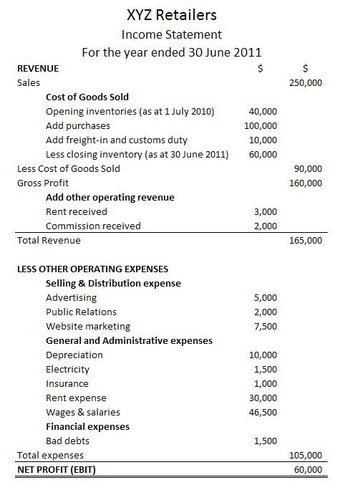
A Sample Income Statement
Expenses are listed on a company’s income statement.
The income statement consists of revenues (money received from the sale of products and services, before expenses are taken out, also known as the “top line”) and expenses, along with the resulting net income or loss over a period of time due to earning activities. Net income (the “bottom line”) is the result after all revenues and expenses have been accounted for. The income statement reflects a company’s performance over a period of time. This is in contrast to the balance sheet, which represents a single moment in time.
Methods for Constructing the Income Statement
The income statement can be prepared in one of two methods: single or multi-step.
The Single Step income statement totals revenues, then subtracts all expenses to find the bottom line.
The more complex Multi-Step income statement (as the name implies) takes several steps to find the bottom line. First, operating expenses are subtracted from gross profit. This yields income from operations. Then other revenues are added and other expenses are subtracted. This yields income before taxes. The final step is to deduct taxes, which finally produces the net income for the period measured.
Operating Revenues and Expenses
The operating section includes revenue and expenses. Revenue consists of cash inflows or other enhancements of the assets of an entity. It is often referred to as gross revenue or sales revenue. Expenses consist of cash outflows or other using-up of assets or incurrence of liabilities.
Elements of expenses include:
- Cost of Goods Sold (COGS): the direct costs attributable to goods produced and sold by a business. It includes items such as material costs and direct labor.
- Selling, General and Administrative Expenses (SG&A): combined payroll costs, except for what has been included as direct labor.
- Depreciation and amortization: charges with respect to fixed assets (depreciation) and intangible assets (amortization) that have been capitalized on the balance sheet for a specific accounting period.
- Research & Development (R&D): expenses included in research and development of products.
Non-operating Revenues and Expenses
The non-operating section includes revenues and gains from non- primary business activities (such as rent or patent income); expenses or losses not related to primary business operations (such as foreign exchange losses); gains that are either unusual or infrequent, but not both; finance costs (costs of borrowing, such as interest expense); and income tax expense.
In essence, if an activity is not a part of making or selling the products or services, but still affects the income of the business, it is a non-operating revenue or expense.
Reading the Income Statement
Certain items must be disclosed separately in the notes if it is material (significant). This could include items such as restructurings, discontinued operations, and disposals of investments or of property, plant and equipment. Irregular items are reported separately so that users can better predict future cash flows.
The “bottom line” of an income statement—often, literally the last line of the statement—is the net income that is calculated after subtracting the expenses from revenue. It is important to investors as it represents the profit for the year attributable to the shareholders. For companies with shareholders, earnings per share (EPS) are also an important metric and are required to be disclosed on the income statement.
3.1.3: Noncash Items
Noncash items, such as depreciation and amortization, will affect differences between the income statement and cash flow statement.
Learning Objective
Identify noncash items that can affect the income statement
Key Points
- Noncash items should be added back in when analyzing income statements to determine cash flow because they do not contribute to the inflow or outflow of cash like other gains and expenses eventually do.
- Depreciation refers to the decrease in value of assets and the allocation of the cost of assets to periods in which the assets are used–for tangible assets, such as machinery.
- Amortization is a similar process to deprecation when applied to intangible assets, such as patents and trademarks.
Key Terms
- obsolescence
-
The state of being obsolete—no longer in use; gone into disuse; disused or neglected.
- amortization
-
The distribution of the cost of an intangible asset, such as an intellectual property right, over the projected useful life of the asset.
- depreciation
-
The measurement of the decline in value of assets. Not to be confused with impairment, which is the measurement of the unplanned, extraordinary decline in value of assets.
Noncash Items
Noncash items that are reported on an income statement will cause differences between the income statement and cash flow statement. Common noncash items are related to the investing and financing of assets and liabilities, and depreciation and amortization. When analyzing income statements to determine the true cash flow of a business, these items should be added back in because they do not contribute to inflow or outflow of cash like other gains and expenses.
Fixed assets, also known as a non-current asset or as property, plant, and equipment (PP&E), is an accounting term for assets and property. Unlike current assets such as cash accounts receivable, PP&E are not very liquid. PP&E are often considered fixed assets: they are expected to have relatively long life, and are not easily changed into another asset . These often receive a more favorable tax treatment than short-term assets in the form of depreciation allowances.

Machinery
Machinery is an example of a noncash asset.
Broadly speaking, depreciation is a way of accounting for the decreasing value of long-term assets over time. A machine bought in 2012, for example, will not be worth the same amount in 2022 because of things like wear-and-tear and obsolescence.
On a more detailed level, depreciation refers to two very different but related concepts: the decrease in the value of tangible assets (fair value depreciation) and the allocation of the cost of tangible assets to periods in which they are used (depreciation with the matching principle). The former affects values of businesses and entities. The latter affects net income.
In each period, long-term noncash assets accrue a depreciation expense that appears on the income statement. Depreciation expense does not require a current outlay of cash, but the cost of acquiring assets does. For example, an asset worth $100,000 in year 1 may have a depreciation expense of $10,000, so it appears as an asset worth $90,000 in year 2.
Amortization is a similar process to deprecation but is the term used when applied to intangible assets. Examples of intangible assets include copyrights, patents, and trademarks.
3.1.4: Uses of the Income Statement
The primary purpose of the income statement is to assess efficiency as revenues transform into profits/losses.
Learning Objective
Utilize income statements to understand organizational efficiency
Key Points
- Revenues are exposed to a number of expense types, and understanding the relationship between costs and revenues is the primary function of the income sheet.
- When looking at profitability, dividing net profit by overall revenues provides insights as to the profitability of revenue from start to finish.
- Another useful metric is the gross margin, which underlines the variable costs attached to adding new units of sales.
- Operating margin provides insights as to how financing impacts overall profitability.
Key Term
- gross margin
-
A measurement of how the cost of goods sold per unit impact overall profitability.
Using the Income Statement
The primary purpose of the income statement is to demonstrate the profitability of an organization’s operations over a fixed period of time by illustrating how proceeds from operations (i.e. revenues) are transformed into net income (profits and losses).
Compared to the balance sheet and the cash flow statement, the income statement is primarily focused on the actual operational efficiency of the organization. The balance sheet discusses leverage, assets, funding, and other aspects of the organization’s existing infrastructure. The cash flow statement is primarily a description of liquidity. The income statement, however, is ultimately about how a given revenue input can be converted to profitability through assessing what is required to attain that revenue.
Assessing Efficiency
The income statement is relatively straight-forward. As an investor or a manager, the simplest way to view each section is by focusing on efficiency. An optimally efficient organization will have higher margins in the following areas:
Profit margin: A higher net profit as a proportion of sales indicates an overall higher capacity to capture returns on revenue. Profit margin is one of the first aspects of an organization a prospective investor will look at when considering the overall validity of a company as an investment. This is calculated as:
Operating Margin: Another useful indicator of profitability is operating income over net sales. Operating income subtracts the cost of goods sold (COGS) alongside selling, general, and administrative expenses (SG&A), leaving the overall profit before taxes and interest on financial debt. Comparing this to the overall profit margin can give useful indications of reliance on debt. It’s calculated as:
Another useful indicator is the gross margin. This essentially demonstrates the added value of each unit of sales, as it focuses exclusively on the impact of the cost of goods sold (COGS). COGS represents the costs incurred (directly) from materials, labor, and production of each individual unit. This can be a great indicator of how scalable an operation is, and the relative return an organization will see as they achieve growth.
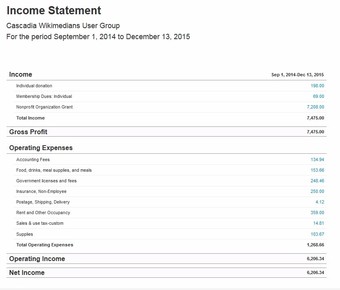
Income Statement Example
This is a simple example of the typical line items on an income statement.
3.1.5: Limitations of the Income Statement
Income statements have several limitations stemming from estimation difficulties, reporting error, and fraud.
Learning Objective
Demonstrate how the limitations of the income statement can influence valuation
Key Points
- Income statements include judgments and estimates, which mean that items that might be relevant but cannot be reliably measured are not reported and that some reported figures have a subjective component.
- With respect to accounting methods, one of the limitations of the income statement is that income is reported based on accounting rules and often does not reflect cash changing hands.
- Income statements can also be limited by fraud, such as earnings management, which occurs when managers use judgment in financial reporting to intentionally alter financial reports to show an artificial increase (or decrease) of revenues, profits, or earnings per share figures.
Key Terms
- LIFO
-
Method for accounting for inventory. LIFO stands for last-in, first-out, and assumes that the most recently produced items are recorded as sold first.
- FIFO
-
Method for for accounting for inventories. FIFO stands for first-in, first-out, and assumes that the oldest inventory items are recorded as sold first.
- matching principle
-
According to the principle, expenses are recognized when obligations are (1) incurred (usually when goods are transferred or services rendered, e.g. sold), and (2) offset against recognized revenues, which were generated from those expenses, no matter when cash is paid out. In cash accounting—in contrast—expenses are recognized when cash is paid out.
Income statements are a key component to valuation but have several limitations: items that might be relevant but cannot be reliably measured are not reported (such as brand loyalty); some figures depend on accounting methods used (for example, use of FIFO or LIFO accounting); and some numbers depend on judgments and estimates. In addition to these limitations, there are limitations stemming from the intentional manipulation of finances.
One of the limitations of the income statement is that income is reported based on accounting rules and often does not reflect cash changing hands. This could be due to the matching principle, which is the accounting principle that requires expenses to be matched to revenues and reported at the same time. Expenses incurred to produce a product are not reported in the income statement until that product is sold. Another common difference across income statements is the method used to calculate inventory, either FIFO or LIFO.
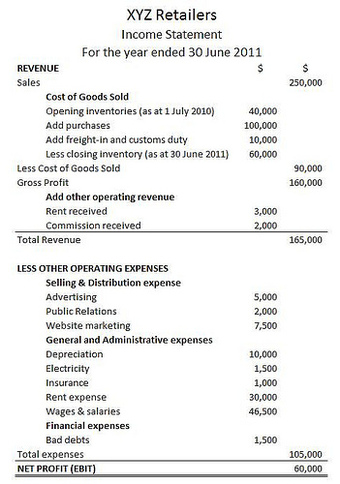
Income statement
Accounting for inventory can be done in different ways, leading to differences in statements.
In addition to good faith differences in interpretations and reporting of financial data in income statements, these financial statements can be limited by intentional misrepresentation. One example of this is earnings management, which occurs when managers use judgment in financial reporting and in structuring transactions to alter financial reports in a way that usually involves the artificial increase (or decrease) of revenues, profits, or earnings per share figures.
The goal with earnings management is to influence views about the finances of the firm. Aggressive earnings management is a form of fraud and differs from reporting error. Managers could seek to manage earnings for a number of reasons. For example, if a manager earns his or her bonus based on revenue levels at the end of December, there is an incentive to try to represent more revenues in December so as to increase the size of the bonus.
While it is relatively easy for an auditor to detect error, part of the difficulty in determining whether an error was intentional or accidental lies in the accepted recognition that calculations are estimates. It is therefore possible for legitimate business practices to develop into unacceptable financial reporting.
3.1.6: Effects of GAAP on the Income Statement
GAAP’s assumptions, principles, and constraints can affect income statements through temporary (timing) and permanent differences.
Learning Objective
Apply the four basic GAAP principles when preparing financial statements
Key Points
- Items that create temporary differences due to the recording requirements of GAAP include rent or other revenue collected in advance, estimated expenses, and deferred tax liabilities and assets.
- Also there are events, usually one-time events, which create “permanent differences,” such as GAAP recognizing as an expense an item that the IRS will not allow to be deducted.
- The four basic principles of GAAP can affect items on the income statement. These principles include the historical cost principle, revenue recognition principle, matching principle, and full disclosure principle.
Key Terms
- fair market value
-
An estimate of the market value of a property, based on what a knowledgeable, willing, and unpressured buyer would probably pay to a knowledgeable, willing, and unpressured seller in the market. An estimate of fair market value may be founded either on precedent or extrapolation but is subjective. Fair market value differs from other ways of determining value, such as intrinsic and imposed value.
- deferred
-
Of or pertaining to a value that is not realized until a future date, e.g. annuities, charges, taxes, income, either as an asset or liability.
Although most of the information on a company’s income tax return comes from the income statement, there often is a difference between pretax income and taxable income. These differences are due to the recording requirements of GAAP for financial accounting (usually following the matching principle and allowing for accruals of revenue and expenses) and the requirements of the IRS’s tax regulations for tax accounting (which are more oriented to cash).
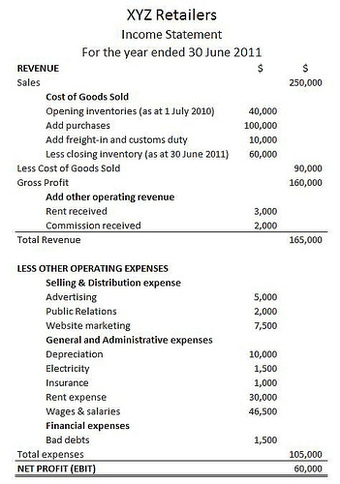
Income statement
GAAP and IRS accounting can differ.
Such timing differences between financial accounting and tax accounting create temporary differences. For example, rent or other revenue collected in advance, estimated expenses, and deferred tax liabilities and assets may create timing differences. Also, there are events, usually one time, which create “permanent differences,” such as GAAP, which recognizes as an expense an item that the IRS will not allow to be deducted.
To achieve basic objectives and implement fundamental qualities, GAAP has four basic principles:
- The historical cost principle: It requires companies to account and report based on acquisition costs rather than fair market value for most assets and liabilities.
- The revenue recognition principle. It requires companies to record when revenue is (1) realized or realizable and (2) earned, not when cash is received.
- The matching principle. This governs the matching of expenses and revenues, where expenses are recognized, not when the work is performed or when a product is produced, but when the work or the product actually makes its contribution to revenue.
- The full disclosure principle. This suggests that the amount and kinds of information disclosed should be decided based on a trade-off analysis, since a larger amount of information costs more to prepare and use. GAAP reporting also suggests that income statements should present financial figures that are objective, material, consistent, and conservative.
3.2: The Balance Sheet
3.2.1: Defining the Balance Sheet
A balance sheet reports a company’s financial position on a specific date.
Learning Objective
State the purpose of the balance sheet and recognize what accounts appear on the balance sheet
Key Points
- The balance sheet summarizes a business’s assets, liabilities, and shareholders’ equity.
- A balance sheet is like a photograph; it captures the financial position of a company at a particular point in time.
- The balance sheet is sometimes called the statement of financial position.
- The balance sheet shows the accounting equation in balance. A company’s assets must equal their liabilities plus shareholders’ equity.
Key Terms
- balance sheet
-
A balance sheet is often described as a “snapshot of a company’s financial condition. ” A standard company balance sheet has three parts: assets, liabilities, and ownership equity.
- asset
-
Items of ownership convertible into cash; total resources of a person or business, as cash, notes and accounts receivable; securities and accounts receivable, securities, inventories, goodwill, fixtures, machinery, or real estate (as opposed to liabilities).
- liability
-
An obligation, debt, or responsibility owed to someone.
Balance Sheet
The balance sheet, sometimes called the statement of financial position, lists the company’s assets, liabilities,and stockholders’ equity (including dollar amounts) as of a specific moment in time. That specific moment is the close of business on the date of the balance sheet. A balance sheet is like a photograph; it captures the financial position of a company at a particular point in time. The other two statements are for a period of time. As you study about the assets, liabilities, and stockholders’ equity contained in a balance sheet, you will understand why this financial statement provides information about the solvency of the business.
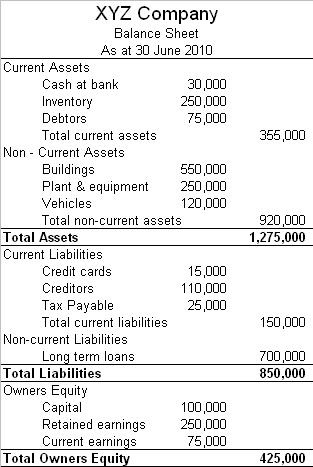
The Balance Sheet
If an error is found on a previous year’s financial statement, a correction must be made and the financials reissued.
The balance sheet is a formal document that follows a standard accounting format showing the same categories of assets and liabilities regardless of the size or nature of the business. Accounting is considered the language of business because its concepts are time-tested and standardized. Even if you do not utilize the services of a certified public accountant, you or your bookkeeper can adopt certain generally accepted accounting principles (GAAP) to develop financial statements. The strength of GAAP is the reliability of company data from one accounting period to another and the ability to compare the financial statements of different companies.
Balance Sheet Formats
Standard accounting conventions present the balance sheet in one of two formats: the account form (horizontal presentation) and the report form (vertical presentation). Most companies favor the vertical report form, which doesn’t conform to the typical explanation in investment literature of the balance sheet as having “two sides” that balance out.
Whether the format is up-down or side-by-side, all balance sheets conform to a presentation that positions the various account entries into five sections:
Assets = Liabilities + Equity
1. Current assets (short-term): items that are convertible into cash within one year
2. Non-current assets (long-term): items of a more permanent nature
3. Current liabilities (short-term): obligations due within one year
4. Non-current liabilities (long-term): obligations due beyond one year
5. Shareholders’ equity (permanent): shareholders’ investment and retained earnings
Account Presentation
In the asset sections mentioned above, the accounts are listed in the descending order of their liquidity (how quickly and easily they can be converted to cash). Similarly, liabilities are listed in the order of their priority for payment. In financial reporting, the terms “current” and “non-current” are synonymous with the terms “short-term” and “long-term,” respectively, so they are used interchangeably.
Each of the three segments on the balance sheet will have many accounts within it that document the value of each. Accounts such as cash, inventory, and property are on the asset side of the balance sheet, while on the liability side there are accounts such as accounts payable or long-term debt. The exact accounts on a balance sheet will differ by company and by industry.
3.2.2: Components of the Balance Sheet
The balance sheet relationship is expressed as; Assets = Liabilities + Equity.
Learning Objective
Differentiate between the three balance sheet accounts of asset, liability and shareholder’s equity
Key Points
- Assets have value because a business can use or exchange them to produce the services or products of the business.
- Liabilities are the debts owed by a business, often incurred to fund its operation.
- A company’s equity represents retained earnings and funds contributed by its shareholders.
Key Terms
- Assets
-
A resource with economic value that an individual, corporation, or country owns or controls with the expectation that it will provide future benefit.
- liabilities
-
Probable future sacrifices of economic benefits arising from present obligations to transfer assets or providing services as a result of past transactions or events.
- equity
-
Ownership interest in a company, as determined by subtracting liabilities from assets.
Components of the Balance Sheet
The balance sheet contains statements of assets, liabilities, and shareholders’ equity.
Assets represent things of value that a company owns and has in its possession, or something that will be received and can be measured objectively. They are also called the resources of the business, some examples of assets include receivables, equipment, property and inventory. Assets have value because a business can use or exchange them to produce the services or products of the business.
Liabilities are the debts owed by a business to others–creditors, suppliers, tax authorities, employees, etc. They are obligations that must be paid under certain conditions and time frames. A business incurs many of its liabilities by purchasing items on credit to fund the business operations.
A company’s equity represents retained earnings and funds contributed by its owners or shareholders (capital), who accept the uncertainty that comes with ownership risk in exchange for what they hope will be a good return on their investment.
Fundamental Relationship
The relationship of these items is expressed in the fundamental balance sheet equation:
Assets = Liabilities + Equity
The meaning of this equation is important. Generally, sales growth, whether rapid or slow, dictates a larger asset base – higher levels of inventory, receivables, and fixed assets (plant, property, and equipment). As a company’s assets grow, its liabilities and/or equity also tends to grow in order for its financial position to stay in balance. How assets are supported, or financed, by a corresponding growth in payables, debt liabilities, and equity reveals a lot about a company’s financial health.
3.2.3: Uses of the Balance Sheet
The balance sheet of a business provides a snapshot of its financial status at a particular point in time.
Learning Objective
Give examples of how the balance sheet is used by internal and external users
Key Points
- The Balance Sheet is used for financial reporting and analysis as part of the suite of financial statements.
- Financial statement analysis consists of applying analytical tools and techniques to financial statements and other relevant data to obtain useful information.
- Investors, creditors, and regulatory agencies generally focus their analysis of financial statements on the company as a whole. Since they cannot request special-purpose reports, external users must rely on the general purpose financial statements that companies publish.
Key Term
- liquidity
-
A company’s ability to meet its payment obligations, in terms of possessing sufficient liquid assets.
Uses Of the Balance Sheet
The Balance Sheet is used for financial reporting and analysis as part of the suite of financial statements .

Using the Balance Sheet
The balance sheet is one of the financial reports included in a company’s annual report.
Management’s analysis of financial statements primarily relates to parts of the company. Using this approach, management can plan, evaluate, and control operations within the company. Management obtains any information it wants about the company’s operations by requesting special-purpose reports. It uses this information to make difficult decisions, such as which employees to lay off and when to expand operations.
Investors, creditors, and regulatory agencies generally focus their analysis of financial statements on the company as a whole. Since they cannot request special-purpose reports, external users must rely on the general purpose financial statements that companies publish. These statements include the balance sheet, an income statement, a statement of stockholders’ equity, a statement of cash flows, and the explanatory notes that accompany the financial statements.
Users of financial statements need to pay particular attention to the explanatory notes, or the financial review, provided by management in annual reports. This integral part of the annual report provides insight into the scope of the business, the results of operations, liquidity and capital resources, new accounting standards, and geographic area data.
Financial statement analysis consists of applying analytical tools and techniques to financial statements and other relevant data to obtain useful information. This information reveals significant relationships between data and trends in those data that assess the company’s past performance and current financial position. The information shows the results or consequences of prior management decisions. In addition, analysts use the information to make predictions that may have a direct effect on decisions made by users of financial statements.
Balance Sheet Substantiation
The balance sheet is an especially useful tool when it comes to the substantiation of various accounts. Balance sheet substantiation is the accounting process conducted by businesses on a regular basis to confirm that the balances held in the primary accounting system of record are reconciled (in balance with) with the balance and transaction records held in the same or supporting sub-systems. It includes multiple processes including reconciliation (at a transactional or at a balance level) of the account, a process of review of the reconciliation and any pertinent supporting documentation, and a formal certification (sign-off) of the account in a predetermined form driven by corporate policy
Balance sheet substantiation is an important process that is typically carried out on a monthly, quarterly and year-end basis. The results help to drive the regulatory balance sheet reporting obligations of the organization. Historically, substantiation has been a wholly manual process, driven by spreadsheets, email and manual monitoring and reporting. In recent years software solutions have been developed to bring a level of process automation, standardization and enhanced control to the substantiation or account certification process. These solutions are suitable for organizations with a high volume of accounts and/or personnel involved in the substantiation process and can be used to drive efficiencies, improve transparency and help to reduce risk.
3.2.4: Preparation of the Balance Sheet
Balance sheets are prepared with either one or two columns, with assets first, followed by liabilities and net worth.
Learning Objective
Identify the elements of a properly formatted balance sheet
Key Points
- Balance sheets are usually prepared at the close of an accounting period, such as month-end, quarter-end, or year-end.
- Current assets most commonly used by small businesses are cash, accounts receivable, inventory and prepaid expenses.
- There are two types of liabilities: current liabilities and long-term liabilities. Liabilities are arranged on the balance sheet in order of how soon they must be repaid.
Key Terms
- Fixed assets
-
Assets that produce revenues. They are distinguished from current assets by their longevity. They are not for resale.
- depreciation
-
Depreciation subtracts a specified amount from the original purchase price to account for the wear and tear on the asset.
- inventory
-
Inventory includes goods ready for sale, as well as raw material and partially completed products that will be for sale when they are completed.
How to Prepare a Balance Sheet

Balance Sheet Preparation
How to prepare a balance sheet.
All balance sheets follow the same format: when two columns are used, assets are on the left, liabilities are on the right, and net worth is beneath liabilities. When one column is used, assets are listed first, followed by liabilities and net worth. Balance sheets are usually prepared at the close of an accounting period.
Current Assets
To start, focus on the current assets most commonly used by small businesses: cash, accounts receivable, inventory and prepaid expenses. Cash includes cash on hand, in the bank, and in petty cash. Accounts receivable is what you are owed by customers. To make this number more realistic, an amount should be deducted from accounts receivable as an allowance for bad debts.
Inventory may be the largest current asset. On a balance sheet, the value of inventory is the cost required to replace it if the inventory were destroyed, lost, or damaged. Inventory includes goods ready for sale, as well as raw material and partially completed products that will be for sale when they are completed.
Prepaid expenses are listed as a current asset because they represent an item or service that has been paid for but has not been used or consumed. An example of a prepaid expense is the last month of rent on a lease that may have been prepaid as a security deposit. The prepaid expense will be carried as an asset until it is used. Prepaid insurance premiums are another example of prepaid expenses. Sometimes, prepaid expenses are also referred to as unexpired expenses. On a balance sheet, current assets are totaled and this total is shown as the line item called “total current assets. “
Fixed Assets
Fixed assets are the assets that produce revenues. They are distinguished from current assets by their longevity. They are not for resale. Many small businesses may not own a large amount of fixed assets, because most small businesses are started with a minimum of capital. Of course, fixed assets will vary considerably and depend on the business type (such as service or manufacturing), size, and market.
Fixed assets include furniture and fixtures, motor vehicles, buildings, land, building improvements (or leasehold improvements), production machinery, equipment and any other items with an expected business life that can be measured in years. All fixed assets (except land) are shown on the balance sheet at original (or historic) cost, minus any depreciation. Subtracting depreciation is a conservative accounting practice to reduce the possibility of over valuation. Depreciation subtracts a specified amount from the original purchase price for the wear and tear on the asset.
It is important to remember that original cost may be more than the asset’s invoice price. It can include shipping, installation, and any associated expenses necessary for readying the asset for service. Assets are arranged in order of how quickly they can be turned into cash. Like the other fixed assets on the balance sheet, machineryand equipment will be valued at the original cost minus depreciation. “Other assets” is a category of fixed assets. Other assets are generally intangible assets such as patents, royalty arrangements, and copyrights.
Liabilities
Liabilities are claims of creditors against the assets of the business. These are debts owed by the business.There are two types of liabilities: current liabilities and long-term liabilities. Liabilities are arranged on the balance sheet in order of how soon they must be repaid. For example, accounts payable will appear first as they are generally paid within 30 days. Notes payable are generally due within 90 days and are the second liability to appear on the balance sheet.
Current liabilities include the following:
- Accounts payable
- Notes payable to banks (or others)
- Accrued expenses (such as wages and salaries)
- Taxes payable
- The current amount due within a one year portion of long-term debt
- Any other obligations to creditors due within one year of the date of the balance sheet
The current liabilities of most small businesses include accounts payable, notes payable to banks, and accrued payroll taxes. Accounts payable is the amount you may owe any suppliers or other creditors for services or goods that you have received but not yet paid for. Notes payable refers to any money due on a loan during the next 12 months. Accrued payroll taxes would be any compensation to employees who have worked, but have not been paid at the time the balance sheet is created.
Liabilities are arranged on the balance sheet in order of how soon they must be repaid.
Long-term liabilities are any debts that must be repaid by your business more than one year from the date of the balance sheet. This may include start up financing from relatives, banks, finance companies, or others.
3.2.5: Temporal Classification
Cash, receivables, and liabilities on the Balance Sheet are re-measured into U.S. dollars using the current exchange rate.
Learning Objective
Identify when it would be necessary to use the temporal method on the balance sheet
Key Points
- Inventory, property, equipment, patents, and contributed capital accounts are re-measured at historical rates resulting in differences in total assets and liabilities plus equity which must be reconciled resulting in a re-measurement gain or loss.
- If a company’s functional currency is the U.S. dollar, then any balances denominated in the local or foreign currency, must be re-measured.
- The re-measurement gain or loss appears on the income statement.
Key Terms
- Temporal Method
-
Cash, receivables, and liabilities are re-measured into U.S. dollars using the current exchange rate.
- translation
-
Uses exchange rates based on the time assets. Liabilities acquired or incurred are required.
A Classified Balance Sheet
“Classified” means that the balance sheet accounts are presented in distinct groupings, categories, or classifications. Most accounting balance sheets classify a company’s assets and liabilities into distinct groups such as current assets property, plant, equipment, current liabilities, etc. These classifications make the balance sheet more useful
The Temporal Method
Cash, receivables, and liabilities are re-measured into U.S. dollars using the current exchange rate. Inventory, property, equipment, patents, and contributed capital accounts are re-measured at historical rates resulting in differences in total assets and liabilities plus equity which must be reconciled resulting in a re-measurement gain or loss.
If a company’s functional currency is the U.S. dollars, then any balances denominated in the local or foreign currency, must be re-measured. Re-measurement requires the application of the temporal method. The re-measurement gain or loss appears on the income statement .

Temporal Classification
Re-measurement to U.S. dollars.
Translation
A method of foreign currency translation that uses exchange rates based on the time assetsand liabilities are acquired or incurred, is required. The exchange rate used also depends on the method of valuation that is used. Assets and liabilities valued at current costs use the current exchange rate and those that use historical exchange rates are valued at historical costs.
By using the temporal method, any income-generating assets like inventory, property, plant, and equipment are regularly updated to reflect their market values. The gains and losses that result from translation are placed directly into the current consolidated income. This causes the consolidated earnings to be volatile.
3.2.6: Assets
Assets on a balance sheet are classified into current assets and non-current assets. Assets are on the left side of a balance sheet.
Learning Objective
Sketch the asset section of a balance sheet
Key Points
- The main categories of assets are usually listed first, and normally, in order of liquidity. On a balance sheet, assets will typically be classified into current assets and non-current (long-term) assets.
- Current assets are those assets which can either be converted to cash or used to pay current liabilities within 12 months. Current assets include cash and cash equivalents, short-term investments, accounts receivable, inventories and the portion of prepaid liabilities paid within a year.
- A non-current asset cannot easily be converted into cash. Non-current assets include property, plant and equipment (PPE), investment property, intangible assets, long-term financial assets, investments accounted for using the equity method, and biological assets.
Key Term
- liquidity
-
Availability of cash over short term: ability to service short-term debt.
The Balance Sheet
A standard company balance sheet has three parts: assets, liabilities and ownership equity. The main categories of assets are usually listed first, and normally, in order of liquidity. On the left side of a balance sheet, assets will typically be classified into current assets and non-current (long-term) assets.
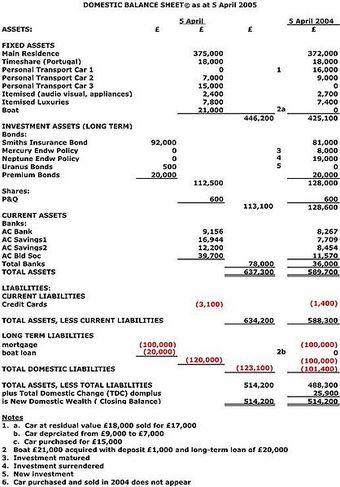
Balance Sheet
Sample Domestic Balance Sheet (DBS) to be referenced by Domestic Well-Being Accounting (DWBA)
Current Assets
A current asset on the balance sheet is an asset which can either be converted to cash or used to pay current liabilities within 12 months. Typical current assets include cash and cash equivalents, short-term investments, accounts receivable, inventories and the portion of prepaid liabilities which will be paid within a year.
Cash and cash equivalents are the most liquid assets found within the asset portion of a company’s balance sheet. Cash equivalents are assets that are readily convertible into cash, such as money market holdings, short-term government bonds or treasury bills, marketable securities and commercial papers. Cash equivalents are distinguished from other investments through their short-term existence; they mature within 3 months whereas short-term investments are 12 months or less, and long-term investments are any investments that mature in excess of 12 months.
Accounts receivable represents money owed by entities to the firm on the sale of products or services on credit. In most business entities, accounts receivable is typically executed by generating an invoice and either mailing or electronically delivering it to the customer, who, in turn, must pay it within an established timeframe, called credit terms or payment terms.
Most manufacturing organizations usually divide their inventory into:
- raw materials – materials and components scheduled for use in making a product,
- work in process (WIP) – materials and components that have began their transformation to finished goods,
- finished goods – goods ready for sale to customers, and
- goods for resale – returned goods that are salable.
A deferred expense or prepayment, prepaid expense (plural often prepaids), is an asset representing cash paid out to a counterpart for goods or services to be received in a later accounting period. For example, if a service contract is paid quarterly in advance, at the end of the first month of the period two months remain as a deferred expense. In the deferred expense, the early payment is accompanied by a related, recognized expense in the subsequent accounting period, and the same amount is deducted from the prepayment.
Non-current Assets
A non-current asset is a term used in accounting for assets and property which cannot easily be converted into cash. This can be compared with current assets such as cash or bank accounts, which are described as liquid assets. Non-current assets include property, plant and equipment (PPE), investment property (such as real estate held for investment purposes), intangible assets, long-term financial assets, investments accounted for by using the equity method, and biological assets, which are living plants or animals.
Property, plant, and equipment normally include items such as land and buildings, motor vehicles, furniture, office equipment, computers, fixtures and fittings, and plant and machinery. These often receive favorable tax treatment (depreciation allowance) over short-term assets.
Intangible assets are defined as identifiable, non-monetary assets that cannot be seen, touched or physically measured. They are created through time and effort, and are identifiable as a separate asset. There are two primary forms of intangibles – legal intangibles (such as trade secrets (e. g., customer lists), copyrights, patents, and trademarks) and competitive intangibles (such as knowledge activities (know-how, knowledge), collaboration activities, leverage activities, and structural activities). The intangible asset “goodwill” reflects the difference between the firm’s net assets and its market value; the amount is first recorded at time of acquisition. The additional value of the firm in excess of its net assets usually reflects the company’s reputation, talent pool, and other attributes that separate it from the competition. Goodwill must be tested for impairment on an annual basis and adjusted if the firm’s market value has changed.
Investments accounted for by using the equity method are 20-50% stake investments in other companies. The investor keeps such equities as an asset on the balance sheet. The investor’s proportional share of the associate company’s net income increases the investment (and a net loss decreases the investment), and proportional payment of dividends decreases it. In the investor’s income statement, the proportional share of the investee’s net income or net loss is reported as a single-line item.
3.2.7: Liabilities and Equity
The balance sheet contains details on company liabilities and owner’s equity.
Learning Objective
Apply the accounting equation to create a balance sheet
Key Points
- In financial accounting, a liability is defined as an obligation of an entity arising from past transactions or events, the settlement of which may result in the transfer or use of assets, provision of services or other yielding of economic benefits in the future.
- Equity is the residual claim or interest of the most junior class of investors in assets, after all liabilities are paid.
- The types of accounts and their description that comprise the owner’s equity depend on the nature of the entity and may include: Common stock, preferred stock, capital surplus, retained earnings, treasury stock, stock options and reserve.
Key Term
- Preferred Stock
-
Stock with a dividend, usually fixed, that is paid out of profits before any dividend can be paid on common stock. It also has priority to common stock in liquidation.
In financial accounting, a liability is defined as an obligation of an entity arising from past transactions or events, the settlement of which may result in the transfer or use of assets, provision of services or other yielding of economic benefits in the future. A liability is defined by the following characteristics:
- Any type of borrowing from persons or banks for improving a business or personal income that is payable during short or long time;
- A duty or responsibility to others that entails settlement by future transfer or use of assets, provision of services, or other transaction yielding an economic benefit, at a specified or determinable date, on occurrence of a specified event, or on demand;
- A duty or responsibility that obligates the entity to another, leaving it little or no discretion to avoid settlement; and,
- A transaction or event obligating the entity that has already occurred.
The accounting equation relates assets, liabilities, and owner’s equity: “” The accounting equation is the mathematical structure of the balance sheet.

Accounting equation
Assets = Liabilities + Owner’s Equity
In accounting and finance, equity is the residual claim or interest of the most junior class of investors in assets, after all liabilities are paid. If liability exceeds assets, negative equity exists. In an accounting context, shareholders’ equity (or stockholders’ equity, shareholders’ funds, shareholders’ capital, or similar terms) represents the remaining interest in assets of a company, spread among individual shareholders of common or preferred stock.
At the start of a business, owners put some funding into the business to finance operations. This creates a liability on the business in the shape of capital, as the business is a separate entity from its owners. Businesses can be considered, for accounting purposes, sums of liabilities and assets: this is the accounting equation. After liabilities have been accounted for, the positive remainder is deemed the owner’s interest in the business.
In financial accounting, owner’s equity consists of the net assets of an entity. Net assets is the difference between the total assets of the entity and all its liabilities. Equity appears on the balance sheet, one of the four primary financial statements.
The assets of an entity includes both tangible and intangible items, such as brand names and reputation or goodwill. The types of accounts and their description that comprise the owner’s equity depend on the nature of the entity and may include: Common stock, preferred stock, capital surplus, retained earnings, treasury stock, stock options and reserve.
The total changes to equity is calculated as follows:
Equity (end of year balance) = Equity (beginning of year balance) +/- changes to common or preferred stock and capital surplus +/- net income/loss (net profit/loss earned during the period) − dividends. Dividends are typically cash distributions of earnings to stockholders on hand and they are recorded as a reduction to the retained earnings account reported in the equity section.
3.2.8: Liquidity
Liquidity, a business’s ability to pay obligations, can be assessed using various ratios: current ratio, quick ratio, etc.
Learning Objective
Calculate a company’s liquidity using a variety of methods.
Key Points
- Liquidity refers to a business’s ability to meet its payment obligations, in terms of possessing sufficient liquid assets, and to such assets themselves. For assets, liquidity is an asset’s ability to be sold without causing a significant movement in the price and with minimum loss of value.
- A standard company balance sheet has three parts: assets, liabilities and ownership equity. The main categories of assets are usually listed first, typically in order of liquidity.
- For a corporation with a published balance sheet there are various ratios used to calculate a measure of liquidity, namely the current ratio, the quick ratio, the operating cash flow ratio, and the liquidity ratio (acid test).
Key Terms
- liquidity ratio
-
measurement of the availability of cash to pay debt
- cash equivalents
-
A deferred expense or prepayment, prepaid expense, plural often prepaids, is an asset representing cash paid out to a counterpart for goods or services to be received in a later accounting period.
In accounting, liquidity (or accounting liquidity) is a measure of the ability of a debtor to pay his debts when they fall due. A standard company balance sheet has three parts: assets, liabilities and ownership equity. The main categories of assets are usually listed first, and typically in order of liquidity. Money, or cash, is the most liquid asset, and can be used immediately to perform economic actions like buying, selling, or paying debt, meeting immediate wants and needs. Next are cash equivalents, short-term investments, inventories, and prepaid expenses.
Liquidity also refers both to a business’s ability to meet its payment obligations, in terms of possessing sufficient liquid assets, and to such assets themselves. For assets themselves, liquidity is an asset’s ability to be sold without causing a significant movement in the price and with minimum loss of value.
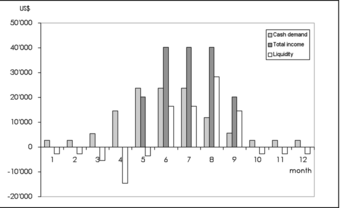
Liquidity
Monthly liquidity of an organic vegetable business
For a corporation with a published balance sheet, there are various ratios used to calculate a measure of liquidity. These include the following:
- The current ratio, which is the simplest measure and is calculated by dividing the total current assets by the total current liabilities. A value of over 100% is normal in a non-banking corporation. However, some current assets are more difficult to sell at full value in a hurry.
- The quick ratio, which is calculated by deducting inventories and prepayments from current assets and then dividing by current liabilities–this gives a measure of the ability to meet current liabilities from assets that can be readily sold.
- The operating cash flow ratio can be calculated by dividing the operating cash flow by current liabilities. This indicates the ability to service current debt from current income, rather than through asset sales.
- The liquidity ratio (acid test) is a ratio used to determine the liquidity of a business entity. Liquidity ratio expresses a company’s ability to repay short-term creditors out of its total cash. The liquidity ratio is the result of dividing the total cash by short-term borrowings. It shows the number of times short-term liabilities are covered by cash. If the value is greater than 1.00, it means fully covered. The formula is the following: LR = liquid assets / short-term liabilities.
3.2.9: Working Capital
Working capital is a financial metric which represents operating liquidity available to a business, organization and other entity.
Learning Objective
Discuss why working capital is an important metric for businesses.
Key Points
- Net working capital is calculated as current assets minus current liabilities.
- Current assets and current liabilities include three accounts which are of special importance: accounts receivable, accounts payable and inventories.
- The goal of working capital management is to ensure that the firm is able to continue its operations and that it has sufficient cash flow. The management of working capital involves managing inventories, accounts receivable and payable, and cash.
Key Terms
- deficit
-
the amount by which spending exceeds revenue
- operating liquidity
-
The ability of a company or individual to quickly convert assets to cash for the purpose of paying operating expenses.
Working capital (abbreviated WC) is a financial metric which represents operating liquidity available to a business, organization or other entity, including a governmental entity. Along with fixed assets, such as plant and equipment, working capital is considered a part of operating capital.
Net working capital is calculated as current assets minus current liabilities. It is a derivation of working capital, that is commonly used in valuation techniques such as discounted cash flows (DCFs). If current assets are less than current liabilities, an entity has a working capital deficiency, also called a working capital deficit. An increase in working capital indicates that the business has either increased current assets (that it has increased its receivables, or other current assets) or has decreased current liabilities – for example has paid off some short-term creditors.
Current assets and current liabilities include three accounts which are of special importance. These accounts represent the areas of the business where managers have the most direct impact: accounts receivable (current asset), inventories (current assets), and accounts payable (current liability). The current portion of debt (payable within 12 months) is critical, because it represents a short-term claim to current assets and is often secured by long-term assets. Common types of short-term debt are bank loans and lines of credit.
A company can be endowed with assets and profitability but short of liquidity if its assets cannot readily be converted into cash. Decisions relating to working capital and short-term financing are referred to as working capital management. These involve managing the relationship between a firm’s short-term assets and its short-term liabilities. The goal of working capital management is to ensure that the firm is able to continue its operations and that it has sufficient cash flow to satisfy both maturing short-term debt and upcoming operational expenses. The management of working capital involves managing inventories, accounts receivable and payable, and cash.
Inventory management is to identify the level of inventory which allows for uninterrupted production but reduces the investment in raw materials – and minimizes reordering costs – and hence, increases cash flow.
Debtors’ management involves identifying the appropriate credit policies, i.e. credit terms which will attract customers, such that any impact on cash flows and the cash conversion cycle will be offset by increased revenue and hence, return on capital.
Short-term financing requires identifying the appropriate source of financing, given the cash conversion cycle: the inventory is ideally financed by credit granted by the supplier; however, it may be necessary to utilize a bank loan (or overdraft).
Cash management involves identifying the cash balance which allows for the business to meet day-to-day expenses, but reduces cash holding costs.
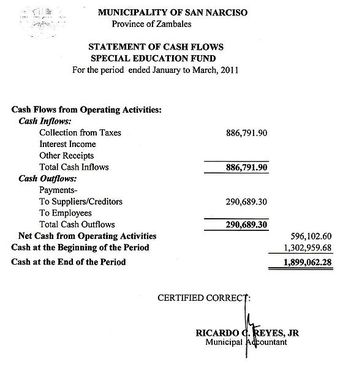
Statement of cash flows
The management of working capital involves managing inventories, accounts receivable and payable, and cash.
3.2.10: Debt to Equity
The debt-to-equity ratio (D/E) indicates the relative proportion of shareholder’s equity and debt used to finance a company’s assets.
Learning Objective
Identify the different methods of calculating the debt to equity ratio.
Key Points
- The debt-to-equity ratio (D/E) is a financial ratio indicating the relative proportion of shareholders’ equity and debt used to finance a company’s assets. Closely related to leveraging, the ratio is also known as risk, gearing or leverage.
- Preferred stocks can be considered part of debt or equity. Attributing preferred shares to one or the other is partially a subjective decision.
- The formula of debt/ equity ratio: D/E = Debt (liabilities) / equity = Debt / (Assets – Debt) = (Assets – Equity) / Equity.
Key Term
- leverage
-
The use of borrowed funds with a contractually determined return to increase the ability of a business to invest and earn an expected higher return (usually at high risk).
Debt to Equity
The debt-to-equity ratio (D/E) is a financial ratio indicating the relative proportion of shareholders’ equity and debt used to finance a company’s assets. Closely related to leveraging, the ratio is also known as risk, gearing or leverage. The two components are often taken from the firm’s balance sheet or statement of financial position. However, the ratio may also be calculated using market values for both if the company’s debt and equity are publicly traded, or using a combination of book value for debt and market value for equity financially. “”
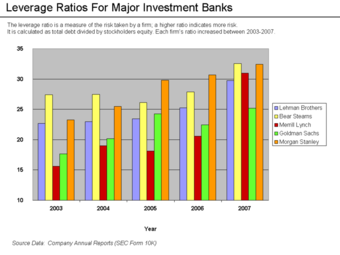
Leverage Ratios of Investment Banks
Each of the five largest investment banks took on greater risk leading up to the subprime crisis. This is summarized by their leverage ratio, which is the ratio of total debt to total equity. A higher ratio indicates more risk.
Preferred stocks can be considered part of debt or equity. Attributing preferred shares to one or the other is partially a subjective decision, but will also take into account the specific features of the preferred shares. When used to calculate a company’s financial leverage, the debt usually includes only the long term debt (LTD). Quoted ratios can even exclude the current portion of the LTD.
Financial analysts and stock market quotes will generally not include other types of liabilities, such as accounts payable, although some will make adjustments to include or exclude certain items from the formal financial statements. Adjustments are sometimes also made, for example, to exclude intangible assets, and this will affect the formal equity; debt to equity (dequity) will therefore also be affected.
The formula of debt/equity ratio: D/E = Debt (liabilities) / equity. Sometimes only interest-bearing long-term debt is used instead of total liabilities in the calculation.
A similar ratio is the ratio of debt-to-capital (D/C), where capital is the sum of debt and equity:D/C = total liabilities / total capital = debt / (debt + equity)
The relationship between D/E and D/C is: D/C = D/(D+E) = D/E / (1 + D/E)
The debt-to-total assets (D/A) is defined asD/A = total liabilities / total assets = debt / (debt + equity + non-financial liabilities)
On a balance sheet, the formal definition is that debt (liabilities) plus equity equals assets, or any equivalent reformulation. Both the formulas below are therefore identical: A = D + EE = A – D or D = A – E
Debt to equity can also be reformulated in terms of assets or debt: D/E = D /(A – D) = (A – E) / E
3.2.11: Market Value vs. Book Value
Book value is the price paid for a particular asset, while market value is the price at which you could presently sell the same asset.
Learning Objective
Distinguish between market value and book value.
Key Points
- Market value is the price at which an asset would trade in a competitive auction setting.
- Book value or carrying value is the value of an asset according to its balance sheet account balance. For assets, the value is based on the original cost of the asset less any depreciation, amortization or impairment costs made against the asset.
- In many cases, the carrying value of an asset and its market value will differ greatly. However, they are interrelated.
Key Term
- amortization
-
The distribution of the cost of an intangible asset, such as an intellectual property right, over the projected useful life of the asset.
Market value is the price at which an asset would trade in a competitive auction setting. Market value is often used interchangeably with open market value, fair value, or fair market value. International Valuation Standards defines market value as “the estimated amount for which a property should exchange on the date of valuation between a willing buyer and a willing seller in an arm’s-length transaction after proper marketing wherein the parties had each acted knowledgeably, prudently, and without compulsion. “
In accounting, book value or carrying value is the value of an asset according to its balance sheet account balance. For assets, the value is based on the original cost of the asset less any depreciation, amortization, or impairment costs made against the asset. An asset’s initial book value is its its acquisition cost or the sum of allowable costs expended to put it into use. Assets such as buildings, land, and equipment are valued based on their acquisition cost, which includes the actual cash price of the asset plus certain costs tied to the purchase of the asset, such as broker fees. The book value is different from market value, as it can be higher or lower depending on the asset in question and the accounting practices that affect book value, such as depreciation, amortization and impairment. In many cases, the carrying value of an asset and its market value will differ greatly. If the asset is valued on the balance at market value, then its book value is equal to the market value.

Depreciation methods which are essential in calculating book value
4 Depreciation methods (1. Straight-Line method, (2. Double-Declining Balance method, (3. Sum-of-the-Years’ Digits method, (4.Productive output method)
Ways of measuring the value of assets on the balance sheet include: historical cost, market value or lower of cost or market. Historical cost is typically the purchase price of the asset or the sum of certain costs expended to put the asset into use. Market value is the asset’s worth if it were to be exchanged in the open market in an arm’s length transaction; it can also be derived based on the asset’s present value of the expected cash flows it will generate. Certain assets are disclosed at lower of cost or market in order to conform to accounting’s conservatism principle, which stresses that assets should never be overstated.
3.2.12: Limitations of the Balance Sheet
The three limitations to balance sheets are assets being recorded at historical cost, use of estimates, and the omission of valuable non-monetary assets.
Learning Objective
Critique the balance sheet
Key Points
- Balance sheets do not show true value of assets. Historical cost is criticized for its inaccuracy since it may not reflect current market valuation.
- Some of the current assets are valued on an estimated basis, so the balance sheet is not in a position to reflect the true financial position of the business.
- The balance sheet can not reflect those assets which cannot be expressed in monetary terms, such as skill, intelligence, honesty, and loyalty of workers.
Key Terms
- carrying value
-
In accounting, book value or carrying value is the value of an asset according to its balance sheet account balance. For assets, the value is based on the original cost of the asset less any depreciation, amortization or Impairment costs made against the asset.
- Fixed assets
-
Fixed assets, also known as non-current assets or property, plant, and equipment (PP&E), is a term used in accounting for assets and property that cannot easily be converted into cash. This can be compared with current assets, such as cash or bank accounts, which are described as liquid assets. In most cases, only tangible assets are referred to as fixed.
Limitations of the Balance Sheet
In financial accounting, a balance sheet or statement of financial position is a summary of the financial balances of a sole proprietorship, business partnership, corporation, or other business organization, such as an LLC or an LLP. Assets, liabilities and ownership equity are listed as of a specific date, such as the end of its financial year. A balance sheet is often described as a “snapshot of a company’s financial condition. ” Of the four basic financial statements, the balance sheet is the only statement which applies to a single point in time of a business’ calendar year. There are three primary limitations to balance sheets, including the fact that they are recorded at historical cost, the use of estimates, and the omission of valuable things, such as intelligence.
Fixed assets are shown in the balance sheet at historical cost less depreciation up to date. Depreciation affects the carrying value of an asset on the balance sheet. The historical cost will equal the carrying value only if there has been no change recorded in the value of the asset since acquisition. Therefore, the balance sheet does not show true value of assets. Historical cost is criticized for its inaccuracy since it may not reflect current market valuation.

Four depreciation methods
Different methods of depreciation affect the carrying value of an asset on balance sheets.
Some of the current assets are valued on estimated basis, so the balance sheet is not in a position to reflect the true financial position of the business. Intangible assets like goodwill are shown in the balance sheet at imaginary figures, which may bear no relationship to the market value. The International Accounting Standards Board (IASB) offers some guidance (IAS 38) as to how intangible assets should be accounted for in financial statements. In general, legal intangibles that are developed internally are not recognized, and legal intangibles that are purchased from third parties are recognized. Therefore, there is a disconnect–goodwill from acquisitions can be booked, since it is derived from a market or purchase valuation. However, similar internal spending cannot be booked, although it will be recognized by investors who compare a company’s market value with its book value.
Finally, the balance sheet can not reflect those assets which cannot be expressed in monetary terms, such as skill, intelligence, honesty, and loyalty of workers.
3.3: The Statement of Cash Flows
3.3.1: Defining the Statement of Cash Flows
A statement of cash flows is a financial statement showing how changes in balance sheet accounts and income affect cash & cash equivalents.
Learning Objective
Indicate the purpose of the statement of cash flows and what items affect the balance reported on the statement
Key Points
- In financial accounting, a cash flow statement is a financial statement that shows how changes in balance sheet accounts and income affect cash and cash equivalents and breaks the analysis down to operating, investing, and financing activities.
- People and groups interested in cash flow statements include: (1) Accounting personne, (2) potential lenders or creditors, (3) potential investors, (4) potential employees or contractors, and (5) shareholders of the business.
- The cash flow statement is intended to provide information on a firm’s liquidity and solvency, improve the comparability of different firms’ operating performance, and to indicate the amount, timing, and probability of future cash flows.
Key Terms
- solvency
-
The state of having enough funds or liquid assets to pay all of one’s debts; the state of being solvent.
- liquidity
-
An asset’s property of being able to be sold without affecting its value; the degree to which it can be easily converted into cash.
In financial accounting, a cash flow statement, also known as statement of cash flows or funds flow statement, is a financial statement that shows how changes in balance sheet accounts and income affect cash and cash equivalents, and breaks the analysis down to operating, investing, and financing activities. Essentially, the cash flow statement is concerned with the flow of cash in and out of the business.
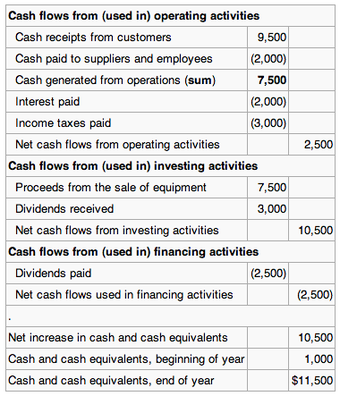
Statement of cash flows
Sample statement of cash flows.
The statement captures both the current operating results and the accompanying changes in the balance sheet. As an analytical tool, the statement of cash flows is useful in determining the short-term viability of a company, particularly its ability to pay bills. International Accounting Standard 7 (IAS 7), is the International Accounting Standard that deals with cash flow statements.
People and groups interested in cash flow statements include: (1) Accounting personnel who need to know whether the organization will be able to cover payroll and other immediate expenses, (2) potential lenders or creditors who want a clear picture of a company’s ability to repay, (3) potential investors who need to judge whether the company is financially sound, (4) potential employees or contractors who need to know whether the company will be able to afford compensation, and (5) shareholders of the business.
The cash flow statement is intended to:
- Provide information on a firm’s liquidity and solvency and its ability to change cash flows in future circumstances provide additional information for evaluating changes in assets, liabilities, and equity;
- Improve the comparability of different firms’ operating performance by eliminating the effects of different accounting methods; and
- Indicate the amount, timing, and probability of future cash flows.
The cash flow statement has been adopted as a standard financial statement, because it eliminates allocations, which might be derived from different accounting methods, such as various timeframes for depreciating fixed assets.
3.3.2: Components of the Statement of Cash Flows
The cash flow statement has 3 parts: operating, investing, and financing activities. There can also be a disclosure of non-cash activities.
Learning Objective
Recognize how operating, investing and financing activities influence the statement of cash flows
Key Points
- Operating activities include the production, sales, and delivery of the company’s product as well as collecting payments from its customers.
- Investing activities are purchases or sales of assets (land, building, equipment, marketable securities, etc. ), loans made to suppliers or received from customers, and payments related to mergers and acquisitions.
- Financing activities include the inflow of cash from investors, such as banks and shareholders, and the outflow of cash to shareholders as dividends as the company generates income.
- Non-cash investing and financing activities are disclosed in footnotes in the financial statements.
Key Term
- non-cash financing activities
-
Non-cash financing activities may include leasing to purchase an asset, converting debt to equity, exchanging non-cash assets or liabilities for other non-cash assets or liabilities, and issuing shares in exchange for assets.
Components of the Cash Flow Statement
In financial accounting, a cash flow statement, also known as statement of cash flows or funds flow statement, is a financial statement that shows how changes in balance sheet accounts and income affect cash and cash equivalents, and breaks the analysis down to operating, investing, and financing activities. Essentially, the cash flow statement is concerned with the flow of cash in and out of the business. The statement captures both the current operating results and the accompanying changes in the balance sheet and income statement. For businesses that use cash basis accounting, the cash flow statement and income statement provide the same information, since cash inflows are considered income and cash outflows consist of expense payments or other types of payments (i.e. asset purchases).
The cash flow statement is partitioned into three segments, namely:
- Cash flow resulting from operating activities
- Cash flow resulting from investing activities
- Cash flow resulting from financing activities.
- It also may include a disclosure of non-cash financing activities.
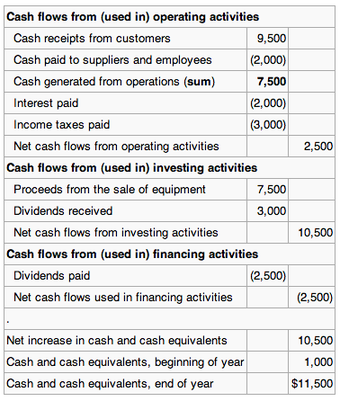
Statement of cash flows
Statement of cash flows includes cash flows from operating, financing and investing activities.
Operating activities include the production, sales, and delivery of the company’s product as well as collecting payments from its customers. This could include purchasing raw materials, building inventory, advertising, and shipping the product.
Investing activities are purchases or sales of assets (land, building, equipment, marketable securities, etc.), loans made to suppliers or received from customers, and payments related to mergers and acquisitions.
Financing activities include the inflow of cash from investors, such as banks and shareholders and the outflow of cash to shareholders as dividends as the company generates income. Other activities that impact the long-term liabilities and equity of the company are also listed in the financing activities section of the cash flow statement.
Non-cash investing and financing activities are disclosed in footnotes to the financial statements. Under the U.S. General Accepted Accounting Principles (GAAP), non-cash activities may be disclosed in a footnote or within the cash flow statement itself. Non-cash financing activities may include leasing to purchase an asset, converting debt to equity, exchanging non-cash assets or liabilities for other non-cash assets or liabilities, and issuing shares in exchange for assets.
3.3.3: Cash Flow from Financing
Cash flows from financing activities arise from the borrowing, repaying, or raising of money.
Learning Objective
Distinguish financing activities that affect a company’s cash flow statement from all of the business’s other transactions
Key Points
- Financing activities can be seen in changes in non-current liabilities and in changes in equity in the change-in-equity statement.
- A positive financing cash flow could be really great for a company (it just went issued stock at a great price) or could be due to the company having to take out loans to stay out of bankruptcy.
- Issuing credit is not a financing activity though taking on credit is. Like all cash flows, such activities only appear on the cash flow statement when the exchange of money actually takes place.
Key Terms
- financing activities
-
actions where money is flowing between the company and investors in the company, such as banks and shareholders
- financing
-
A transaction that provides funds for a business.
Financing Activities
One of the three main components of the cash flow statement is cash flow from financing. In this context, financing concerns the borrowing, repaying, or raising of money. This could be from the issuance of shares , buying back shares, paying dividends, or borrowing cash. Financing activities can be seen in changes in non-current liabilities and in changes in equity in the change-in-equity statement.

NYSE
The cash from issuing stocks in a market such as the New York Stock Exchange is positive financing cash flow.
On the liability side, a company may take out a loan. Everything concerning the loan is a financing activity. Receiving the money is a positive cash flow because cash is flowing into the company, while each individual payment is a negative cash flow.
However, when a company makes a loan (by extending credit to a customer, for example), it is not partaking in a financing activity. Extending credit is an investing activity, so all cash flows related to that loan fall under cash flows from investing activities, not financing activities.
As is the case with operating and investing activities, not all financing activities impact the cash flow statement — only those that involve the exchange of cash do. For example, a company may issue a discount which is a financing expense. However, because no cash changes hands, the discount does not appear on the cash flow statement.
Overall, positive cash flow could mean a company has just raised cash via a stock issuance or the company borrowed money to pay its obligations, therefore avoiding late payments or even bankruptcy. Regardless, the cash flow statement is an important part of analyzing a company’s financial health, but is not the whole story.
3.3.4: Cash Flow from Investing
Cash flow from investing results from activities related to the purchase or sale of assets or investments made by the company.
Learning Objective
Distinguish investing activities that affect a company’s cash flow statement from the business’s other transactions
Key Points
- Assets included in investment activity include land, buildings, and equipment.
- Receiving dividends from another company’s stock is an investing activity, although paying dividends on a company’s own stock is not.
- An investing activity only appears on the cash flow statement if there is an immediate exchange of cash.
Key Terms
- investing activities
-
actions where money is put into something with the expectation of gain, usually over a longer term
- purchase return
-
merchandise given back to the seller from the buyer after the sale in return for a refund
- investing activity
-
An activity that causes changes in non-current assets or involves a return on investment.
- merger
-
The legal union of two or more corporations into a single entity, typically assets and liabilities being assumed by the buying party.
One of the components of the cash flow statement is the cash flow from investing . An investing activity is anything that has to do with changes in non-current assets — including property and equipment, and investment of cash into shares of stock, foreign currency, or government bonds — and return on investment — including dividends from investment in other entities and gains from sale of non-current assets. These activities are represented in the investing income part of the income statement.
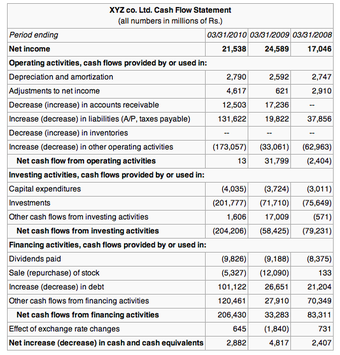
Cash Flow Statement
Example of cash flow statement (indirect method)
It is important to note that investing activity does not concern cash from outside investors, such as bondholders or shareholders. For example, a company may decide to pay out a dividend. A dividend is often thought of as a payment to those who invested in the company by buying its stock. However, this cash flow is not representative of an investing activity on the part of the company. The investing activity was undertaken by the shareholder. Therefore, paying out a dividend is a financing activity.
Some examples of investment activity from the company’s perspective would include:
- Cash outflow from the purchase of an asset (land, building, equipment, etc.).
- Cash inflow from the sale of an asset.
- Cash outflow from the acquisition of another company.
- Cash inflow resulting from a merger.
- Cash inflow resulting dividends paid on stock owned in another company.
It is important to remember that, as with all cash flows, an investing activity only appears on the cash flow statement if there is an immediate exchange of cash. Therefore, extending credit to a customer (accounts receivable) is an investing activity, but it only appears on the cash flow statement when the customer pays off their debt.
3.3.5: Cash Flow from Operations
The operating cash flows refers to all cash flows that have to do with the actual operations of the business, such as selling products.
Learning Objective
Distinguish events that would affect the operating section of the cash flow statement from all of the business’s other transaction
Key Points
- Operating cash flows refers to the cash a company generates from the revenues it brings in, excluding costs associated with long-term investment on capital items or investment in securities (these are investing or financing activities).
- GAAP and IFRS vary in their categorization of many cash flows, such as paying dividends. Some activities that are operating cash flows under one system are financing or investing in another.
- Major operating activities such as manufacturing products or selling a product may appear on the income statement but not on the cash flow statement, because cash has not yet changed hands.
Key Terms
- GAAP
-
Generally Accepted Accounting Principles refer to the standard framework of guidelines, conventions, and rules accountants are expected to follow in recording, summarizing, and preparing financial statements in any given jurisdiction.
- IFRS
-
International Financial Reporting Standards. The major accounting standards system used outside of the United States.
The operating cash flows component of the cash flow statement refers to all cash flows that have to do with the actual operations of the business. It refers to the amount of cash a company generates from the revenues it brings in, excluding costs associated with long-term investment on capital items or investment in securities (these are investing or financing activities). Essentially, it is the difference between the cash generated from customers and the cash paid to suppliers.
Cash flows from operating activities can be calculated and disclosed on the cash flow statement using the direct or indirect method. The direct method shows the cash inflows and outflows affecting all current asset and liability accounts, which largely make up most of the current operations of the entity. Those preparers that use the direct method must also provide operating cash flows under the indirect method. The indirect method is a reconciliation of the period’s net income to arrive at cash flows from operations; changes in current asset and liability accounts are added or subtracted from net income based on whether the change increased or decreased cash. The indirect method must be disclosed in the cash flow statement to comply with U.S. accounting standards, or GAAP.

US GAAP vs. IFRS Cash Flow Classification
Some transactions may be classified as different types of cash flows under GAAP and IFRS accounting standards.
One major difference between GAAP and IFRS is how interest paid is categorized. Under GAAP, a loan payment would have to be broken down into two parts: the payment on principal (financing) and the payment of interest (operating). Under IFRS, it is possible to categorize both as financing cash flows.
All of the major operating cash flows, however, are classified the same way under GAAP and IFRS. The most noticeable cash inflow is cash paid by customers. Cash from customers is not necessarily the same as revenue, though. For example, if a company makes all of its sales by extending credit to customers, it will have generated revenues but not cash flows from customers. It is only when the company collects cash from customers that it has a cash flow.
Significant cash outflows are salaries paid to employees and purchases of supplies. Just as with sales, salaries, and the purchase of supplies may appear on the income statement before appearing on the cash flow statement. Operating cash flows, like financing and investing cash flows, are only accrued when cash actually changes hands, not when the deal is made.
3.3.6: Interpreting Overall Cash Flow
Having positive and large cash flow is a good sign for any business, though does not by itself mean the business will be successful.
Learning Objective
Explain the significance of each component of the Cash Flow Statement
Key Points
- The three types of cash flow are cash from from operations, investing, and financing.
- Having positive cash flows is important because it means that the company has at least some liquidity and may be solvent.
- A positive cash flow does not guarantee that the company can pay all of its bills, just as a negative cash flow does not mean that it will miss its payments.
- When preparing the statement of cash flows, analysts must focus on changes in account balances on the balance sheet.
- Cash flows from operating activities are essential to helping analysts assess the company’s ability to meet ongoing funding requirements, contribute to long-term projects and pay a dividend.
- Analysis of cash flow from investing activities focuses on ratios when assessing a company’s ability to meet future expansion requirements.
- The free cash flow is useful when analysts want to see how much cash can be extracted from a company without causing issues to its day to day operations.
Key Terms
- cash flow
-
The sum of cash revenues and expenditures over a period of time.
- free cash flow
-
net income plus depreciation and amortization, less changes in working capital, less capital expenditure
What is a Cash Flow Statement?
In financial accounting, a cash flow statement (also known as statement of cash flows or funds flow statement) is a financial statement that shows how changes in balance sheet accounts and income affect cash and cash equivalents. The cash flow statement, as the name suggests, provides a picture of how much cash is flowing in and out of the business during the fiscal year.
The cash flow is widely believed to be the most important of the three financial statements because it is useful in determining whether a company will be able to pay its bills and make the necessary investments. A company may look really great based on the balance sheet and income statement, but if it doesn’t have enough cash to pay its suppliers, creditors, and employees, it will go out of business. A positive cash flow means that more cash is coming into the company than going out, and a negative cash flow means the opposite.
Relationship to Other Financial Statements
When preparing the cash flow statement, one must analyze the balance sheet and income statement for the coinciding period. If the accrual basis of accounting is being utilized, accounts must be examined for their cash components. Analysts must focus on changes in account balances on the balance sheet. General rules for this process are as follows.
- Transactions that result in an increase in assets will always result in a decrease in cash flow.
- Transactions that result in a decrease in assets will always result in an increase in cash flow.
- Transactions that result in an increase in liabilities will always result in an increase in cash flow.
- Transactions that result in a decrease in liabilities will always result in a decrease in cash flow
Interpretation
An analyst looking at the cash flow statement will first care about whether the company has a net positive cash flow. Having a positive cash flow is important because it means that the company has at least some liquidity and may be solvent.
Regardless of whether the net cash flow is positive or negative, an analyst will want to know where the cash is coming from or going to . The three types of cash flows (operating, investing, and financing) will all be broken down into their various components and then summed. The company may have a positive cash flow from operations, but a negative cash flow from investing and financing. This sheds important insight into how the company is making or losing money.
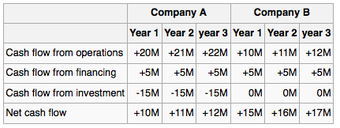
Cash Flow Comparison
Company B has a higher yearly cash flow. However, Company A is actually earning more cash by its core activities and has already spent 45 million dollars in long-term investments, of which revenues will show up after three years.
The analyst will continue breaking down the cash flow statement in this manner, diving deeper and deeper into the specific factors that affect the cash flow. For example, cash flows from operating activities provide feedback on a company’s ability to generate income from internal sources. Thus, these cash flows are essential to helping analysts assess the company’s ability to meet ongoing funding requirements, contribute to long-term projects and pay a dividend.
Analysis of cash flow from investing activities focuses on ratios when assessing a company’s ability to meet future expansion requirements. One such ratio is that for capital acquisitions:
Capital Acquisitions Ratio = cash flow from operating activities / cash paid for property, plant and equipment
This sphere of cash flows also can be used to assess how much cash is available after meeting direct shareholder obligations and capital expenditures necessary to maintain existing capacity.
Free Cash Flows
Free cash flow is a way of looking at a business’s cash flow to see what is available for distribution among all the securities holders of a corporate entity. This may be useful when analysts want to see how much cash can be extracted from a company without causing issues to its day to day operations.
The free cash flow can be calculated in a number of different ways depending on audience and what accounting information is available. A common definition is to take the earnings before interest and taxes, add any depreciation and amortization, then subtract any changes in working capital and capital expenditure.
The free cash flow takes into account the consumption of capital goods and the increases required in working capital. For example in a growing company with a 30 day collection period for receivables, a 30 day payment period for purchases, and a weekly payroll, it will require more and more working capital to finance its operations because of the time lag for receivables even though the total profits has increased.
Free cash flow measures the ease with which businesses can grow and pay dividends to shareholders. Even profitable businesses may have negative cash flows. Their requirement for increased financing will result in increased financing cost reducing future income.
3.3.7: Limitations of the Statement of Cash Flows
The statement of cash flows is a useful tool in identifying organizational liquidity, but has limitations when it comes to non-cash reporting.
Learning Objective
Understand how the statement of cash flows should be used, and what information it doesn’t provide as well
Key Points
- Like all financial statements, the statement of cash flows is useful in viewing the organization from a given perspective. This perspective is useful in some ways and limited in others.
- The statement of cash flows primarily focuses on the change in overall available cash and cash equivalents from one time period to the next (liquidity).
- The statement of cash flows therefore has some limitations when assessing non-cash operating items, and can therefore be misleading.
- The International Accounting Standards 7 (IAS 7) and Generally Acceptable Accounting Principles (GAAP) proposed a variety of expectations to ensure cash flows aren’t misinterpreted by investors.
Purpose of Cash Flow Statements
Cash flow statements are useful in determining liquidity and identifying the amount of capital that is free to capture existing market opportunities. As one of the core financial statements publicly traded organizations release to the public, it is also useful as a benchmark for investors when considering the capacity for different organizations within an industry to adapt and capture new opportunities.
In short, we can summarize what cash flows are used for as:
- Measure liquidity and the capacity to change cash flows in future circumstances
- Provide additional information for evaluating changes in assets, liabilities, and equity
- Compare between different firms’ operating performance
- Predict the amount, timing, and probability of future cash flows
Limitations
However, there can be a number of issues with utilizing the statement of cash flows as an investor speculating about different organizations. The simplest drawback to a cash flow statement is the fact that cash flows can (but not always) omit certain types of non-cash transactions. As the name implies, the statement of cash flows is focused exclusively on tangible changes in cash and cash equivalents.
Regulation
However, to offset some of this, governments have enacted various requirements on the statement of cash flows to limit any information that may be misleading. The primary pieces of legislation are the Generally Accepted Accounting Principles (GAAP) cash flow requirements (1973) and, later on (1992), the International Accounting Standards 7 (IAS 7). A few key points include:
- Under IAS 7, cash flow statement must include changes in both cash and cash equivalents. US GAAP permits using cash alone or cash and cash equivalents.
- Bank borrowings (overdraft) in certain countries can be included in cash equivalents under the IAS 7.
- Interest paid can be included in operating activities or financing activities under the IAS 7. US GAAP requires that interest paid be included in operating activities.
- When the direct method is used, US GAAP (FAS 95) ensures organizations present a supplemental schedule using the indirect method. The IASC strongly recommends the direct method but allows either method. The IASC considers the indirect method less clear to users of financial statements.
- Non-cash investing and financing activities are disclosed in footnotes under IAS 7. Under GAAP, non-cash activities may be disclosed in a footnote or within the cash flow statement itself.
Like all financial statements, the statement of cash flow is only designed to highlight one aspect of operational output. As a result, it is not an indication of an organization’s health from an holistic point of view, but instead a snapshot of operational success from one specific perspective.

IAS 7
This chart illustrates the various important enactments of the International Accounting Standards, including the IAS 7.
3.4: Special Considerations for Merchandising Companies
3.4.1: Overview of Merchandising Operations
Merchandising is any practice which contributes to the sale of products to a retail consumer.
Learning Objective
Recognize what items make the financial statements for a merchandiser different from a manufacterer
Key Points
- In Retail commerce, visual display merchandising means maximizing merchandise sales using product design, selection, packaging, pricing, and display that stimulates consumers to spend more.
- In the supply chain, merchandising is the practice of making products in retail outlets available to consumers, primarily by stocking shelves and displays.
- Merchandising has its own specific income statement other than general income statements in other industries.
Key Term
- supply chain
-
A system of organizations, people, technology, activities, information and resources involved in moving a product or service from supplier to customer.
In the broadest sense, merchandising is any practice which contributes to the sale of products to a retail consumer. At a retail in-store level, merchandising refers to the variety of products available for sale and how the products are displayed to stimulate interest and entice customers to make a purchase.

Retail store
Merchandising is any practice which contributes to the sale of products to a retail consumer.
Promotional merchandising
In Retail commerce, visual display merchandising refers to the process of maximizing merchandise sales using product design, selection, packaging, pricing, and display that stimulates consumers to spend more. This includes disciplines and discounting, physical presentation of products and displays, and decisions about which products should be presented to which customers at what time.This annual cycle of merchandising differs between countries and some times within them. The cycles may relate to cultural customs like holidays, and seasonal issues like climate and local sporting and recreation. In the United States for example, the basic retail cycle begins in early January – with merchandise for Valentine’s Day – and ends around mid-February. Presidents’ Day sales are held shortly thereafter.
Retail supply chain
In the supply chain, merchandising is the practice of making products in retail outlets available to consumers, primarily by stocking shelves and displays. While this used to be done exclusively by the stores’ employees, many retailers have made substantial savings by requiring it to be done by the manufacturer, vendor, or wholesaler that provides the products to the retail store. In the United Kingdom, for example, there are a number of organizations that supply merchandising services to support retail outlets with general stock replenishment and merchandising support for new stores. Through this approach, retail stores have been able to substantially reduce the number of employees needed to run the store.
Specific income statement of merchandising operations:
Sales
– Sales Return & Allowances
– Sales Distcount
= Net sales
– Cost of goods sold
= Gross margin
– Operating expenses
= Income before taxes
– tax
= Net income
3.4.2: Recording Purchases
In merchandising accounting, purchases are the amount of goods a company buys in the course of a year, including the kind, quality, quantity, and cost.
Learning Objective
Define a purchase and describe how to record it
Key Points
- Purchases are offset by Purchase Discounts, and also by Purchase Returns and Allowances.
- Purchase discounts are an offer, from the supplier to the purchaser, to reduce the selling price if the payment is made within a certain period of time.
- FOB specifies which party (buyer or seller) pays for which shipment and loading costs, and where responsibility for the goods is transferred, with the last distinction important for determining liability for goods lost or damaged in transit.
Key Terms
- FOB shipping point
-
the buyer pays shipping cost and takes responsibility for the goods when the goods leave the seller’s premises
- purchase discount
-
a reduced payment from the customer based on invoice payment terms
- FOB destination
-
the seller will pay shipping costs and remain responsible for the goods until the buyer takes possession
- deposits in transit
-
money sent from a company to its bank that does not yet appear in the bank account
- Incoterm
-
Any of a series of international sales terms that divide transaction costs and responsibilities between buyer and seller.
Example
- For an example of a purchase discount, a purchaser who buys a 100 dollar item with a purchase discount term 3/10, net 30 only needs to pay 97 dollars as long as he or she pays within 10 days.
Purchases
In accounting, purchases are the amount of goods a company buys over the course of the year. It also refers to information that should be recorded about the kind, quality, quantity, and cost of goods that are purchased and added to inventory. Purchases are offset by Purchase Discounts, and also Purchase Returns and Allowances. When purchases should be added to inventory depends on the Free On Board (FOB) policy of the trade. For the purchaser, this new inventory is added on shipment (and the seller removes the item from inventory when it is shipped by the seller) if the policy was FOB shipping point. On the other hand, the purchaser adds the inventory on receipt (and the seller removes the item from inventory when it arrives with the purchaser) if the policy was FOB destination.
Purchase Discount
A purchase discount is an offer, from the supplier to the purchaser, to reduce the selling price if payment is made within a certain period of time. For example, a purchaser buying a 100 dollar item with a purchase discount term of 3/10, net 30, will only need to pay 97 dollars if they pay within ten days. Under the gross method, the total cost of purchases are credited to accounts payable first, and discounts realized later if the payments were made in time. Under the net method, purchase discounts are realized right away. And if the payments are not made in time, an anti-revenue account named Purchase Discounts Lost is debited to record the loss.
FOB

Shipping
The initials FOB represent ownership and responsibilities involving the shipping and receiving of goods.
FOB is an abbreviation which pertains to the shipping of goods. Depending on the specific usage, it may stand for Free On Board or Freight On Board. FOB specifies which party (buyer or seller) pays for which shipment and loading costs and where responsibility for the goods is transferred. The last distinction is important for determining liability for goods lost or damaged in transit from the seller to the buyer. Precise meaning and usage of “FOB” can vary significantly. International shipments typically use “FOB” as defined by the Incoterm standards, where it always stands for “Free On Board. ” Domestic shipments within the U. S. or Canada often use a different meaning, specific to North America, which is inconsistent with the Incoterm standards.
3.4.3: Recording Sales
Net sales are gross sales minus sales returns, sales allowances, and sales discounts.
Learning Objective
Differentiate between gross sales and net sales
Key Points
- Sales returns, allowances and discounts are contra-revenue accounts.
- In bookkeeping, accounting, and finance, net sales are operating revenues earned by a company for selling its products or rendering its services. Also referred to as revenue, they are reported directly on the income statement as sales or net sales.
- In financial ratios that use income statement sales values, “sales” refers to net sales, not gross sales.
Key Terms
- sales discount
-
reduced payment from the customer based on invoice payment terms
- sales returns and allowance
-
a refund to customers for returned merchandise / credit notes or reductions in sales price for merchandise with minor defects agreed upon after the purchase
- net sales
-
The value of sales generated by a company after deduction of returns, discounts, and the value of damaged or lost goods
- gross sales
-
The total invoice value of sales, before deducting customers’ discounts, returns, or allowances.
- sales invoice
-
the seller’s name for a commercial document issued by a seller to a buyer, indicating the products, quantities, and agreed prices for products or services the seller has provided the buyer
- double-entry bookkeeping
-
A double-entry bookkeeping system is a set of rules for recording financial information in a financial accounting system in which every transaction or event changes at least two different nominal ledger accounts.
Example
- 2/10, n/30 (2% discount if paid within 10 days, net invoice total due in 30 days).
In bookkeeping, accounting, and finance, net sales are operating revenues earned by a company for selling its products or rendering its services. Also referred to as revenue, they are reported directly on the income statement as sales or net sales.
In financial ratios that use income statement sales values, “sales” refers to net sales, not gross sales. Sales are the unique transactions that occur in professional selling or during marketing initiatives. The sales portion of an income statement for merchandising companies is figured as noted below:
Sales – Sales Return & Allowances – Sales Discount = Net sales

Sales
Net sales are operating revenues earned by a company for selling its products or rendering its services.
Revenue is earned when goods are delivered or services are rendered. In a marketing, advertising, or a general business context, the term “sales” often refers to a contract in which a buyer has agreed to purchase products at a set time in the future. From an accounting standpoint, sales do not occur until the product is delivered. “Outstanding orders” refers to sales orders that have not been filled.
A sale is a transfer of property for money or credit. In double-entry bookkeeping, a sale of merchandise is recorded in the general journal as a debit to cash or accounts receivable and a credit to the sales account. The amount recorded is the actual monetary value of the transaction, not the list price of the merchandise. A discount from list price might be noted if it applies to the sale.
Fees for services are recorded separately from sales of merchandise, but the bookkeeping transactions for recording sales of services are similar to those for recording sales of tangible goods.
Gross sales and net sales
Gross sales are the sum of all sales during a time period. Net sales are gross sales minus sales returns, sales allowances, and sales discounts. Gross sales do not normally appear on an income statement. The sales figures reported on an income statement are net sales.
Chapter 2: Accounting Information and the Accounting Cycle
2.1: The Basics of Accounting
2.1.1: Terminology of Accounting
Important terminology in accounting includes cash vs. accrual basis, assets, liabilities, and equity.
Learning Objective
Distinguish between the two primary accounting methods
Key Points
- The cash basis of accounting records revenue when cash is received and expenses when they are paid in cash.
- The accrual method records income items when they are earned and records deductions when expenses are incurred, regardless of the flow of cash.
- Assets are economic resources. Anything capable of being owned or controlled to produce value is considered an asset.
- A liability is an obligation of an entity arising from past transactions, the settlement of which may result in the transfer of assets, provision of services, or other yielding of economic benefits in the future.
- Equity is the residual claim or interest of the most junior class of investors in assets after all liabilities are paid.
Key Term
- intangible assets
-
non-monetary assets that cannot be seen, touched or physically measured, are created through time and effort, and are identifiable as a separate asset
There are two primary accounting methods – cash basis and accrual basis. The cash basis of accounting, or cash receipts and disbursements method, records revenue when cash is received and expenses when they are paid in cash. In contrast, the accrual method records income items when they are earned and records deductions when expenses are incurred, regardless of the flow of cash. Accrual accounts include, among others, accounts payable, accounts receivable, goodwill, deferred tax liability and future interest expense.
The term accrual is also often used as an abbreviation for the terms accrued expense and accrued revenue. Accrued revenue (or accrued assets) is an asset, such as unpaid proceeds from a delivery of goods or services, when such income is earned and a related revenue item is recognized, while cash is to be received in a later period, when the amount is deducted from accrued revenues. An example of an accrued expense is a pending obligation to pay for goods or services received from a counterpart, while cash is to be paid out in a latter accounting period when the amount is deducted from accrued expenses.
In financial accounting, assets are economic resources. Anything capable of being owned or controlled to produce value is considered an asset. Simply stated, assets represent value of ownership that can be converted into cash. Two major asset classes are intangible assets and tangible assets. Intangible assets are identifiable non-monetary assets that cannot be seen, touched or physically measured, are created through time and effort, and are identifiable as a separate asset. Tangible assets contain current assets and fixed assets. Current assets include inventory, while fixed assets include such items as buildings and equipment.
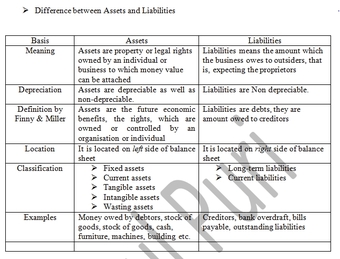
Assets and liabilities
Differences between assets and liabilities
A liability is an obligation of an entity arising from past transactions, the settlement of which may result in the transfer of assets, provision of services, or other yielding of economic benefits in the future. A liability is defined by the following characteristics:
- Any type of borrowing from persons or banks for improving a business or personal income,
- A responsibility to others that entails settlement by future transfer of assets, provision of services, or other transactions,
- A responsibility that obligates the entity to another, leaving it little or no discretion to avoid settlement, or
- A transaction or event obligating the entity that has already occurred.
In accounting and finance, equity is the residual claim or interest of the most junior class of investors in assets after all liabilities are paid. If liability exceeds assets, negative equity exists. In an accounting context, shareholders’ equity represents the remaining interest in assets of a company, spread among individual shareholders in common or preferred stock.
2.1.2: Debits and Credits
Credit and debit are the two fundamental aspects of every financial transaction in the double-entry bookkeeping system.
Learning Objective
Define how the terms debit and credit are used in accounting
Key Points
- The English words credit and debit come from the Latin words credre and debere, respectively. Credre means “to entrust,” and debere means “to owe”.
- In financial accounting or bookkeeping, “Dr” (Debit) indicates the left side of a ledger account and “Cr” (Credit) indicates the right.
- The rule that total debits equal total credits applies when all accounts are totaled.
- An increase (+) to an asset account is a debit. An increase (+) to a liability account is a credit.
- Conversely, a decrease (-) to an asset account is a credit. A decrease (-) to a liability account is a debit.
- It is important for us to consider perspective when attempting to understand the concepts of debits and credits.
Key Terms
- double-entry bookkeeping system
-
A double-entry bookkeeping system is a set of rules for recording financial information in a financial accounting system in which every transaction or event changes at least two different nominal ledger accounts.
- debit
-
an entry in the left hand column of an account to record a debt; debits increase asset and expense accounts and decrease liability, income, and equity accounts
- credit
-
an entry in the right hand column of an account; credits increase liability, income, and equity accounts and decrease asset and expense accounts
The difficulty with accounting has less to do with the math as it does with its concepts. There is no more difficult yet vital concept to understand than that of debits and credits. Debits and credits are at the heart of the double-entry bookkeeping system that has been the foundation stone on which the financial world’s accounting system has been built for well over 500 years. Given the length of time, is it any wonder that confusion has surrounded the concept of debits and credits? The English language and its laws have morphed to bring new definitions for two words that, in the accounting world, have their own significance and meaning.
For a better conceptual understanding of debits and credits, let us look at the meaning of the original Latin words. The English translators took theirs word credit and debit from the Latin words credre and debere, respectively. Credre means “to entrust,” and debere means “to owe. ” When we look closely into these two concepts we see that they are actually two sides of the same coin. In a closed financial system, money cannot just materialize. If money is received by someone it must have come from someone. That is, if someone entrusts an amount of money to someone else, then that person receiving the entrusted money would owe the same amount of money in return (i.e., the credre must equal the debere).
The Accounting Definition
Debits and credits serve as the two balancing aspects of every financial transaction in double-entry bookkeeping. Debits are entered on the left side of a ledger, and credits are entered on the right side of a ledger. Whether a debit increases or decreases an account depends on what kind of account it is. In the accounting equation Assets = Liabilities + Equity, if an asset account increases (by a debit), then one must also either decrease (credit) another asset account or increase (credit) a liability or equity account.
Another way to help remember debit and
credit rules, is to think of the accounting equation as a tee (T),
the vertical line of the tee (T) goes between assets and liabilities.
Everything on the left side (debit side) increases with a debit and
has a normal debit balance; everything on the right side (credit
side) increases with a credit and has a normal credit balance. (Note:
a normal balance does not always mean the accounts balance will be on
that side, it’s simply a way of remembering which side increases it).
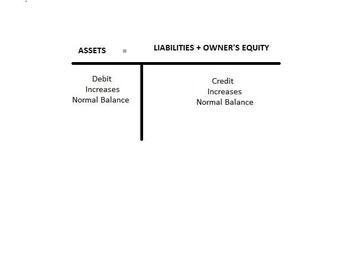
Accounting Equation
The extended accounting equation allows
for revenue and expenses as well.
Assets = Liabilities + Owner’s Equity +
Revenue – Expenses
As you already know the first part of
the equation, let’s focus on the new classifications, revenue and
expenses.
-
Revenue is treated like capital,
which is an owner’s equity account, and owner’s equity is increased
with a credit, and has a normal credit balance. -
Expenses reduce revenue, therefore they are just the opposite, increased
with a debit, and have a normal debit balance.
Each transaction (let’s say $100) is recorded by a debit entry of $100 in one account, and a credit entry of $100 in another account. When people say that “debits must equal credits” they do not mean that the two columns of any ledger account must be equal. If that were the case, every account would have a zero balance (no difference between the columns), which is often not the case. The rule that total debits equal the total credits applies when all accounts are totaled.
Perspective
It is important for us to consider perspective when attempting to understand the concepts of debits and credits. For example, one credit that confuses most newcomers to accounting is the one that appears on their own bank statement. We know that cash in the bank is an asset, and when we increase an asset we debit its account. Then how come the credit balance in our bank accounts goes up when we deposit money? The answer is one that is fundamental to the accounting system. Each firm records financial transactions from their own perspective.
Think about the bank’s perspective for a moment. How do they view the money we have just deposited? Whose money is it? It’s ours; therefore, from the bank’s perspective the deposit is viewed as a liability (money owed by the bank to others). When we deposit money into our accounts, the bank’s liability increases, which is why the bank credits our account.
In summary: An increase (+) to an asset account is a debit and an increase (+) to a liability account is a credit; conversely, a decrease (-) to an asset account is a credit and a decrease (-) to a liability account is a debit.
What is debited and credited is also a matter of transaction type. In accounting, these are divided into three types of accounts. The rule of debit and credit depends on the type of account you are talking about:
- Personal account: Debit the receiver and credit the giver
- Real account: Debit what comes in and credit what goes out
- Nominal account: Debit all expenses & losses and credit all incomes & gains
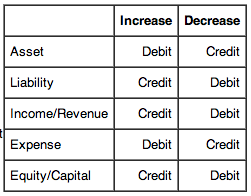
Debit and credit rules
Debit and credit rules
2.1.3: Fundamental Accounting Equation
To ensure that a company is “in balance,” its assets must always equal its liabilities plus its owners’ equity.
Learning Objective
State the fundamental accounting equation
Key Points
- The accounting equation displays that all assets are either financed by borrowing money or paying with the money of the company’s shareholders.
- The balance sheet is a complex display of this equation, showing that the total assets of a company are equal to the total of liabilities and shareholder equity. Any purchase or sale has an equal effect on both sides of the equation or offsetting effects on the same side of the equation.
- A mark in the credit column will increase a company’s liability, income, and capital accounts but decrease its asset and expense accounts. A mark in the debit column will increase a company’s asset and expense accounts, but decrease its liability, income, and capital account.
Key Terms
- debit
-
an entry in the left hand column of an account to record a debt; debits increase asset and expense accounts and decrease liability, income, and equity accounts
- credit
-
an entry in the right hand column of an account; credits increase liability, income, and equity accounts and decrease asset and expense accounts
- double-entry bookkeeping system
-
A double-entry bookkeeping system is a set of rules for recording financial information in a financial accounting system in which every transaction or event changes at least two different nominal ledger accounts.
The fundamental accounting equation can actually be expressed in two different ways. A double-entry bookkeeping system involves two different “columns;” debits on the left, credits on the right. Every transaction and all financial reports must have the total debits equal to the total credits. A mark in the credit column will increase a company’s liability, income and capital accounts, but decrease its asset and expense accounts. A mark in the debit column will increase a company’s asset and expense accounts, but decrease its liability, income and capital account.
For example, if a person buys a computer for $945. He borrows $500 from his best friend and pays for the rest using cash in his bank account. To record this transaction in his personal ledger, the person would make the following journal entry.
Computer (Increase in asset) $945
Cash (Decrease in an asset) $445
Loan from friend (Increase in debt) $500
As you can see, the total amount of the debits (the amount on the left) equal the credits (the total amount on the right). The transaction is in “balance. “
An extension of that basic rule involves the balance sheet. The total assets listed on a company’s balance sheet must equal the company’s total liabilities, plus its owners’ equity in the company. This identity reflects the assumption that all of a company’s assets are either financed through debt or through the contribution of funds by the company’s owners.
A simple balance sheet example:
Assets
Cash $100,000
PP&E $200,000
Liabilities & Equity
Mortgage $150,000
Equity $150,000
As you can see, the business’s total assets equal the company’s total liabilities and equity. This company is “balanced. “
2.1.4: An Expanded Equation
Preparing financial statements requires preparing an adjusted trial balance, translating that into financial reports, and having those reports audited.
Learning Objective
Demonstrate how to prepare the financial statements
Key Points
- The purpose of financial statements are to provide both business insiders and outsiders a concise, clear picture of the current financial status in the business. Therefore, the people who use the statements must be confident in its accuracy.
- Closing the books is simply a matter of ensuring that transactions that take place after the business’s financial period are not included in the financial statements.
- Adjusting entries are generally made in relation to prepaid expenses, prepayments, accruals, estimates and inventory.
- When an audit is completed, the auditor will issue a report regarding whether the statements are accurate. To ensure a positive reports, some companies try to participate in opinion shopping. This practice is generally prohibited..
Key Terms
- adjusting entry
-
Journal entries usually made at the end of an accounting period to allocate income and expenditure to the period in which they actually occurred.
- audit
-
An independent review and examination of records and activities to assess the adequacy of system controls, to ensure compliance with established policies and operational procedures, and to recommend necessary changes in controls, policies, or procedures
- opinion shopping
-
The process of contracting or rejecting auditors based on the type of opinion report they will issue on the auditee.
Example
- Financial statements for Highland Yoga for each period would appear as follows:
Preparing Financial Statements
When a business enterprise presents all the relevant financial information in a structured and easy to understand manner, it is called a financial statement. The purpose of financial statements are to provide both business insiders and outsiders a concise, clear picture of the current financial status in the business. Therefore, the people who use the statements must be confident in its accuracy.
Adjusted Trial Balance – Closing the Books
The process of preparing the financial statements begins with the adjusted trial balance. Preparing the adjusted trial balance requires “closing” the book and making the necessary adjusting entries to align the financial records with the true financial activity of the business.
Closing the books is simply a matter of ensuring that transactions that take place after the business’s financial period are not included in the financial statements. For example, assume a business is preparing its financial statements with a December 31st year end. It acquires some property on January 14th. If the books are properly closed, that property will not be included on the balance sheet that is being prepared for the period on December 31st.
Adjusted Trial Balance – Adjusting Entries
An adjusting entry is a journal entry made at the end of an accounting period that allocates income and expenditure to the appropriate years. Adjusting entries are generally made in relation to prepaid expenses, prepayments, accruals, estimates and inventory. Throughout the year, a business may spend funds or make assumptions that might not be accurate regarding the use of a good or service during the accounting period. Adjusting entries allow the company to go back and adjust those balances to reflect the actual financial activity during the accounting period.
For example, assume a company purchases 100 units of raw material that it expects to use up during the current accounting period. As a result, it immediately expenses the cost of the material. However, at the end of the year the company discovers it only used 50 units. The company must then make an adjusting entry to reflect that, and decrease the amount of the expense and increase the amount of inventory accordingly.
Translate the Adjusted Trial Balance to Financial Statements
Using the trial balance, the company then prepares the four financial statements. These statements are:
- The Balance Sheet: A summary of the company’s assets, liabilities and equity;
- The Income Statement: A summary of the business’s income, expenses, and profits
- The Statement of Cash Flows: A report on a company’s cash flow activities, particularly its operating, investing and financing activities; and
- The Statement of Changes in Equity: A report that explains the changes of the company’s equity throughout the reporting period
The company may also provide Notes to the Financial Statements, which are disclosures regarding key details about the company’s operations that may not be evident from the financial statements.

Financial statement
Financial statement from Wachovia National Bank, 1906.
Audit the Financial Statements
Once the company prepares its financial statements, it will contract an outside third party to audit it. An audit is an independent review and examination of records and activities to assess the adequacy of system controls, to ensure compliance with established policies and operational procedures, and to recommend necessary changes in controls, policies, or procedures. It is the audit that assures outside investors and interested parties that the content of the statements are correct.
When an audit is completed, the auditor will issue a report with the findings. The findings can state anything from the statements are accurate to statements are misleading. To ensure a positive reports, some companies try to participate in opinion shopping. This is the process that businesses use to ensure it gets a positive review. Since Enron and the accounting scandals of the early 2000s, this practice has been prohibited.
2.1.5: Types of Transactions
Transactions include sales, purchases, receipts, and payments made by an individual or organization.
Learning Objective
Distinguish between the four transactions that occur in the accounting cycle
Key Points
- Sales – A sale is a transfer of property for money or credit. Revenue is earned when goods are delivered or services are rendered. In double-entry bookkeeping, a sale of merchandise is recorded in the general journal as a debit to cash or accounts receivable and a credit to the sales account.
- Purchase transactions results in a decrease in the finances of the purchaser and an increase in the benefits of the sellers. Purchases can be made by cash or credit. As credit purchases are made, accounts payable will increase.
- Receipts refer to a business getting paid by another business for delivering goods or services. This transaction results in a decrease in accounts receivable and an increase in cash/ cash or equivalents.
- Payments refer to a business paying to another business for receiving goods or services. This transaction results in a decrease in accounts payable and an decrease in cash/ cash or equivalents.
Key Term
- double-entry bookkeeping
-
A double-entry bookkeeping system is a set of rules for recording financial information in a financial accounting system in which every transaction or event changes at least two different nominal ledger accounts.
Transactions include sales, purchases, receipts, and payments made by an individual or organizations.
Overview of Sales
A sale is a transfer of property for money or credit. Revenue is earned when goods are delivered or services are rendered. In double-entry bookkeeping, a sale of merchandise is recorded in the general journal as a debit to cash or accounts receivable and a credit to the sales account. The amount recorded is the actual monetary value of the transaction, not the list price of the merchandise. A discount from list price might be noted if it applies to the sale. Fees for services are recorded separately from sales of merchandise, but the bookkeeping transactions for recording sales of services are similar to those for recording sales of tangible goods .

Bookkeeping
Purchases and sales in an old ledger
Overview of Purchases
Purchasing refers to a business or organization acquiring goods or services to accomplish the goals of its enterprise. This transaction results in a decrease in the finances of the purchaser and an increase in the benefits of the sellers. Purchases can be made by cash or credit. As credit purchases are made, accounts payable will increase.
Overview of Receipts
Receipts refer to a business getting paid by another business for delivering goods or services. This transaction results in a decrease in accounts receivable and an increase in cash or equivalents.
Overview of Payments
Payments refer to a business paying another business for receiving goods or services. The business that makes the payment will decrease its accounts payable as well as its cash or equivalents. On the other hand, the business that receives the payment will see a decrease in accounts receivable but an increase in cash or equivalents.
2.2: The Accounting Cycle
2.2.1: What Is the Accounting Cycle?
The accounting cycle is performed during the accounting period, to analyze, record, classify, summarize, and report financial information.
Learning Objective
Identify and complete the 8 steps in the Accounting Cycle
Key Points
- The accounting cycle has 8 Steps.
- Each transaction must be analyzed to determine whether it qualifies as a business transaction.
- The accounting cycle runs within the accounting period.
- The goal of the accounting cycle is to produce financial statements for the company.
Key Terms
- source
-
The person, place or thing from which something (information, goods, etc. ) comes or is acquired.
- bookkeeping
-
The skill or practice of keeping books or systematic records of financial transactions, e.g., income and expenses.
- summarize
-
To give a recapitulation of the salient facts; to recapitulate or review
Example
- As we walk through the steps of the accounting cycle, consider the following example. After a number of years as a successful CPA at a national firm, you decide to quit the rat race and pursue your true love — yoga. You decide that Atlanta’s Virginia-Highland neighborhood would be the perfect place to open an Ashtanga Yoga studio. Even better, your friend Solomon, a certified instructor, has just moved to town and is willing to teach at the studio. You hurriedly prepare to open the studio, Highland Yoga, by July 1.Pre-opening (before July 1)Prior to opening the business, you make the following transactions:1. You contribute $4,000 in cash to start the business.2. You purchase $500 worth of mats and other equipment for use during classes.3. You purchase an additional $400 worth of mats, equipment, and clothing for sale at the studio.4. You purchase liability insurance at a total cost of $1,200. The policy covers July 1 through December31.JulyThe following transactions take place during July.1. You receive cash totaling $800 for classes.2. Your instructor teaches classes for the month. You agree to pay $600 for the classes; $300 is paid on July 15, and $300 will be paid on August 3.3. You pay rent for July of $1,000 on July 1.4. You use utilities (electricity and water) totaling $200. This amount is payable on August 15.AugustThe following transactions take place during August.1. You receive $1,500 in cash for classes. Of this amount, $1,000 was for classes in August. The remainder is for 2-month passes allowing unlimited classes in August and September.2. Your instructor again earns $600 teaching classes; $300 due on August 16 and $300 on September 1.3. Utilities total $150, payable September 15.4. You pay rent of $1,000 on August 1.5. You sell inventory costing $150 for a revenue of $225.6. You are worried about money, so your Uncle Rafael makes you an offer. He agrees to loan you $2,000 in cash. You will need to repay him sometime later, but he doesn’t say when.7. A client is extremely dissatisfied with their class, and demands their money back. Reluctantly, you agree. The class cost $15.8. After borrowing money, you decide to withdraw some of your investment in the studio to pursue other opportunities. You decide to withdraw $1,000.
The Accounting Cycle
The accounting cycle is a series of steps performed during the accounting period (some throughout the period and some at the end) to analyze, record, classify, summarize, and report useful financial information for the purpose of preparing financial statements. In bookkeeping, the accounting period is the period for which the books are balanced and the financial statements are prepared. Generally, the accounting period consists of 12 months. However, the beginning of the accounting period differs according to the company. For example, one company may use the regular calendar year, January to December, as the accounting year, while another entity may follow April to March as the accounting period.
Eight Steps in the Accounting Cycle
There are eight steps in the accounting cycle and they are as follows:
- Analyze transactions by examining source documents.
- Journalize transactions in the journal.
- Post journal entries to the accounts in the ledger.
- Prepare a trial balance of the accounts and complete the worksheet (includes adjusting entries).
- Prepare financial statements.
- Journalize and post adjusting entries.
- Journalize and post closing entries.
- Prepare a post-closing trial balance.
Source Documents
To begin the accounting cycle, it is necessary to understand what constitutes a business transaction. Business transactions are measurable events that affect the financial condition of a business. Business transactions can be the exchange of goods for cash between the business and an external party, such as the sale of a book, or they can involve paying salaries to employees. These events have one fundamental thing in common: they have caused a measurable change in the amounts in the accounting equation, assets = liabilities + stockholders’ equity. The evidence that a business event has occurred is a source document. Sales tickets, checks, and invoices are common source documents. Source documents are important because they are the ultimate proof that a business transaction has taken place.
After determining, via the source documents, that an event is a business transaction, it is then entered into the company books via a journal entry. After all the transactions for the period have been entered into the appropriate journals, the journals are posted to the general ledger . The trial balance proves that the books are in balance or that the debits equal the credits. From the trial balance, a company can prepare their financial statements. After the financials are prepared, the month end adjusting and closing entries are recorded (journalized) and posted to the appropriate accounts. After those entries are made, a post-closing trial balance is run. The post-closing trial balance verifies the debits equal the credits and that all beginning balances for permanent accounts are in place.
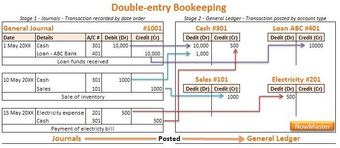
The General Ledger
The General Ledger contains all entries from both the General Journal and the Special Journals.
Highland Yoga
As we walk through the steps of the accounting cycle, consider the following example. After a number of years as a successful CPA at a national firm, you decide to quit the rat race and pursue your true love — yoga. You decide that Atlanta’s Virginia-Highland neighborhood would be the perfect place to open an Ashtanga Yoga studio. Even better, your friend Solomon, a certified instructor, has just moved to town and is willing to teach at the studio. You hurriedly prepare to open the studio, Highland Yoga, by July 1.
Pre-opening (before July 1)
Prior to opening the business, you make the following transactions:
1. You contribute $4,000 in cash to start the business.
2. You purchase $500 worth of mats and other equipment for use during classes.
3. You purchase an additional $400 worth of mats, equipment, and clothing for sale at the studio.
4. You purchase liability insurance at a total cost of $1,200. The policy covers July 1 through December31.
July
The following transactions take place during July.
1. You receive cash totaling $800 for classes.
2. Your instructor teaches classes for the month. You agree to pay $600 for the classes; $300 is paid on July 15, and $300 will be paid on August 3.
3. You pay rent for July of $1,000 on July 1.
4. You use utilities (electricity and water) totaling $200. This amount is payable on August 15.
August
The following transactions take place during August.
1. You receive $1,500 in cash for classes. Of this amount, $1,000 was for classes in August. The remainder is for 2-month passes allowing unlimited classes in August and September.
2. Your instructor again earns $600 teaching classes; $300 due on August 16 and $300 on September 1.
3. Utilities total $150, payable September 15.
4. You pay rent of $1,000 on August 1.
5. You sell inventory costing $150 for a revenue of $225.
6. You are worried about money, so your Uncle Rafael makes you an offer. He agrees to loan you $2,000 in cash. You will need to repay him sometime later, but he doesn’t say when.
7. A client is extremely dissatisfied with their class, and demands their money back. Reluctantly, you agree. The class cost $15.
8. After borrowing money, you decide to withdraw some of your investment in the studio to pursue other opportunities. You decide to withdraw $1,000.
2.2.2: Recording Transactions
All business transactions must be recorded to the proper journal by double-entry book keeping.
Learning Objective
Explain why the double entry system is used in accounting and the proper use of a T-account
Key Points
- Source documents are important because they are the ultimate proof a business transaction has occurred.
- An account is a part of the accounting system used to classify and summarize the increases, decreases, and balances of each asset, liability, stockholders’ equity item, dividend, revenue, and expense.
- The accounting requirement that each transaction be recorded by an entry that has equal debits and credits is called double-entry procedure.
- This double-entry procedure keeps the accounting equation in balance.
Key Terms
- debit
-
an entry in the left hand column of an account to record a debt; debits increase asset and expense accounts and decrease liability, income, and equity accounts
- account
-
A registry of pecuniary transactions; a written or printed statement of business dealings or debts and credits, and also of other things subjected to a reckoning or review
- credit
-
an entry in the right hand column of an account; credits increase liability, income, and equity accounts and decrease asset and expense accounts
Example
- Continuing our example, how would we recognize and record the transactions involved in running our yoga studio? Pre-openingPrior to opening the business, you make the following transactions:1. You contribute $4,000 in cash to start the business.Cash 4,000, Contributed Capital 4,000; Assets(+)=Equity(+)2. You purchase $500 worth of mats and other equipment for use during classes.Cash -500, PPE 500; Assets(+), Assets(-)=03. You purchase an additional $400 worth of mats, equipment, and clothing for sale at the studio.Cash -400, Inventory 400; Assets(+), Assets(-)=04. You purchase liability insurance at a total cost of $1,200. The policy covers July 1 through December31.Cash -1,200, Prepaid Insurance 1,200; Assets(+), Assets(-)JulyThe following transactions take place during July.1. You receive cash totaling $800 for classes.Cash 800, Service Revenue 800; Assets(+)= Equity(+)2. Your instructor teaches classes for the month. You agree to pay $600 for the classes; $300 is paid on July 15, and $300 will be paid on August 3.Cash -300, Wage Payable 300, Instructor Expense 600; Assets(-300)=Liabilities(+300)+Equity(-600)3. You pay rent for July of $1,000 on July 1. Cash -1,000, Rent Expense 1,000; Assets(-)=Equity(-)4. You use utilities (electricity and water) totaling $200. This amount is payable on August 15.Utility Payable 200, Utility Expense 200; Liability(+)+Equity(-)=0. AugustThe following transactions take place during August.1. You receive $1,500 in cash for classes. Of this amount, $1,000 was for classes in August. The remainder is for 2-month passes allowing unlimited classes in August and September.Cash 1,500, Unearned Revenue 250, Service Revenue 1,250 Assets(+1,500)=Liability(+250)+Equity(+1,250)2. Your instructor again earns $600 teaching classes; $300 due on August 16 and $300 on September 1.Cash -300, Wage Payable 300, Instructor Expense 600; Assets(-300)=Liabilities(+300)+Equity(-600)3. Utilities total $150, payable September 15.Utility Payable 150, Utility Expense 150; Liability(+)+Equity(-)=04. You pay rent of $1,000 on August 1.Cash -1,000, Rent Expense 1,000; Assets(-)=Equity(-)5. You sell inventory costing $150 for a revenue of $225.a. Cash 225, Sales Revenue 225; Assets(+)=Equity(+)b. Inventory -150, Cost of Goods Sold 150; Assets(-)=Equity(-)6. You are worried about money, so your Uncle Rafael makes you an offer. He agrees to loan you $2,000 in cash. You will need to repay him sometime later, but he doesn’t say when.Cash 2,000, Loan Payable 2,000; Assets(+)=Liabilities(+)7. A client is extremely dissatisfied with their class, and demands their money back. Reluctantly, youagree. The class cost $15.Cash -15, Service Revenue -15; Assets(-)=Equity(-)8. After borrowing money, you decide to withdraw some of your investment in the studio to pursue otheropportunities. You decide to withdraw $1,000.Cash -1,000, Contributed Capital -1,000; Assets(-)=Equity(-)
Journal entries are business transactions that cause a measurable change in the accounting equation.
(Assets = Liabilities + Stockholders’ Equity)
Since business transactions always generate documentation, it is the accountant or bookkeeper’s job to analyze the source document to determine whether a journal entry is necessary. Source documents are important because they are the ultimate proof of business transactions. Some examples of source documents include bills received from suppliers for goods or services received, bills sent to customers for goods sold or services performed, and cash register tapes. Each source document is analyzed to determine whether the event caused a measurable change in the accounting equation. If it has, then it is necessary to prepare and record a journal entry in the proper account.
An account is the part of the accounting system used to classify and summarize the increases, decreases, and balances of each asset, liability, stockholders’ equity item, dividend, revenue, and expense. Firms set up accounts for each different business element, such as cash, accounts receivable, and accounts payable. Individual companies may label their accounts differently.
All accounts have corresponding contra accounts depending on what transaction has taken place; i.e., when a vehicle is purchased using cash, the asset account “Vehicles” is debited as the vehicle account increases, and simultaneously the asset account “Bank” is credited due to the payment of the vehicle using cash. Some balance sheet items have corresponding contra accounts, with negative balances, that offset them. Examples are accumulated depreciation against equipment, and allowance for bad debts against long-term notes receivable.
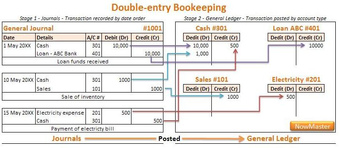
The General Ledger
The General Ledger contains all entries from both the General Journal and the Special Journals. Using a double entry system to record transactions keeps the accounts in balance.
The accounting requirement that each transaction be recorded by an entry that has equal debits and credits is called double-entry procedure. This double-entry procedure keeps the accounting equation in balance. For each business transaction recorded, the total dollar amount of debits must equal the total dollar amount of credits. If one account (or accounts) is debited for $100, then another account (or accounts) must be credited for the same amount.
T-accounts
The general ledger of all accounts is, simply, a comprehensive collection of T-accounts — so called because there is a vertical line in the middle of each ledger page and a horizontal line at the top of each ledger page, like a large letter T. The account title will appear above the horizontal line, and debits and credits will appear to the left and right of the vertical line, respectively.
Some typical accounts and their normal balances:
Assets Debit
Contra Asset Credit
Liability Credit
Contra Liability Debit
Owner’s Equity Credit
Stockholder’s Equity Credit
Revenue Credit
Contra Revenue Debit
Expenses Debit
Gains Credit
Losses Debit
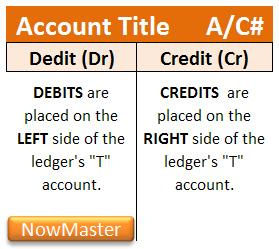
T-Account
T-accounts are so named because of their “T” shape, with the name of the account on top, and debits and credits on the left and right, respectively.
An account’s normal balance will be the side on which increases are recorded. For example, assets and expenses normally have debit balances, and liabilities and revenues normally have credit balances.
Continuing our example, how would we recognize and record the transactions involved in running our yoga studio?
Pre-opening
Prior to opening the business, you make the following transactions:
1. You contribute $4,000 in cash to start the business.
Cash 4,000, Contributed Capital 4,000; Assets(+)=Equity(+)
2. You purchase $500 worth of mats and other equipment for use during classes.
Cash -500, PPE 500; Assets(+), Assets(-)=0
3. You purchase an additional $400 worth of mats, equipment, and clothing for sale at the studio.
Cash -400, Inventory 400; Assets(+), Assets(-)=0
4. You purchase liability insurance at a total cost of $1,200. The policy covers July 1 through December31.
Cash -1,200, Prepaid Insurance 1,200; Assets(+), Assets(-)
July
The following transactions take place during July.
1. You receive cash totaling $800 for classes.
Cash 800, Service Revenue 800; Assets(+)= Equity(+)
2. Your instructor teaches classes for the month. You agree to pay $600 for the classes; $300 is paid on July 15, and $300 will be paid on August 3.
Cash -300, Wage Payable 300, Instructor Expense 600; Assets(-300)=Liabilities(+300)+Equity(-600)
3. You pay rent for July of $1,000 on July 1.
Cash -1,000, Rent Expense 1,000; Assets(-)=Equity(-)
4. You use utilities (electricity and water) totaling $200. This amount is payable on August 15.
Utility Payable 200, Utility Expense 200; Liability(+)+Equity(-)=0.
August
The following transactions take place during August.
1. You receive $1,500 in cash for classes on August 1. Of this amount, $1,000 is for an initiation fee. The remainder is for 2-month passes allowing unlimited classes in August and September.
Cash 1,500, Unearned Revenue 500, Service Revenue 1,000; Assets(+1,500)=Liability(+500)+Equity(+1,000)
2. Your instructor again earns $600 teaching classes; $300 due on August 16 and $300 on September 1.
Cash -300, Wage Payable 300, Instructor Expense 600; Assets(-300)=Liabilities(+300)+Equity(-600)
3. Utilities total $150, payable September 15.
Utility Payable 150, Utility Expense 150; Liability(+)+Equity(-)=0
4. You pay rent of $1,000 on August 1.
Cash -1,000, Rent Expense 1,000; Assets(-)=Equity(-)
5. You sell inventory costing $150 for a revenue of $225.
a. Cash 225, Sales Revenue 225; Assets(+)=Equity(+)
b. Inventory -150, Cost of Goods Sold 150; Assets(-)=Equity(-)
6. You are worried about money, so your Uncle Rafael makes you an offer. He agrees to loan you $2,000 in cash. You will need to repay him sometime later, but he doesn’t say when.
Cash 2,000, Loan Payable 2,000; Assets(+)=Liabilities(+)
7. A client is extremely dissatisfied with their class, and demands their money back. Reluctantly, you agree. The class cost $15.
Cash -15, Service Revenue -15; Assets(-)=Equity(-)
8. After borrowing money, you decide to withdraw some of your investment in the studio to pursue other opportunities. You decide to withdraw $1,000.
Cash -1,000, Contributed Capital -1,000; Assets(-)=Equity(-)
2.2.3: Journalizing
Items are entered into the general journal or the special journals via journal entries, also called journalizing.
Learning Objective
Explain the correct procedure for making a journal entry in the General or Special Journal.
Key Points
- Special journals are designed to facilitate the process of journalizing and posting transactions. They are used for the most frequent transactions in a business.
- Journal entries are prepared after examining the source document to see if a business transaction has taken place.
- The total amount debited and the total amount credited should always be equal, thereby ensuring the accounting equation is maintained.
Key Terms
- debit
-
an entry in the left hand column of an account to record a debt; debits increase asset and expense accounts and decrease liability, income, and equity accounts
- journalizing
-
the act of recording bookkeeping entries
- Facilitate
-
To make easy or easier.
- credit
-
an entry in the right hand column of an account; credits increase liability, income, and equity accounts and decrease asset and expense accounts
Example
- Consider our example for the yoga studio. How would we record journal entries for each transaction? Pre-openingPrior to opening the business, you make the following transactions:1. You contribute $4,000 in cash to start the business.Cash 4,000 Contributed capital 4,0002. You purchase $500 worth of mats and other equipment for use during classes.PPE 500 Cash 5003. You purchase an additional $400 worth of mats, equipment, and clothing for sale at the studio.Inventory 400 Cash 4004. You purchase liability insurance at a total cost of $1,200. The policy covers July 1 through December31.Prepaid insurance 1,200 Cash 1,200JulyThe following transactions take place during July.1. You receive cash totaling $800 for classes.Cash 800 Revenue 8002. Your instructor teaches classes for the month. You agree to pay $600 for the classes; $300 is paid on July 15, and $300 will be paid on August 3.Wage expense 600 Cash 300 Wage payable 3003. You pay rent for July of $1,000 on July 1.Rent expense 1,000 Cash 1,0004. You use utilities (electricity and water) totaling $200. This amount is payable on August 15.Utility expense 200 Utility payable 200AugustThe following transactions take place during August.1. You receive $1,500 in cash for classes. Of this amount, $1,000 was for classes in August. The remainder is for 2-month passes allowing unlimited classes in August and September.Cash 1,500 Revenue 1,250 Unearned revenue 2502. Your instructor again earns $600 teaching classes; $300 due on August 16 and $300 on September 1.Wage expense 600 Cash 300 Wage payable 3003. Utilities total $150, payable September 15.Utility expense 150 Utility payable 1504. You pay rent of $1,000 on August 1.Rent expense 1,000 Cash 1,0005. You sell inventory costing $150 for a $225.Cash 225 Revenue 225Cost of goods sold 150 Inventory 150(these can be combined into a single entry if you choose.)6. You are worried about money, so your Uncle Rafael makes you an offer. He agrees to loan you $2,000 in cash. You will need to repay him sometime later, but he doesn’t say when.Cash 2,000 Loan Payable 2,0007. A client is extremely dissatisfied with their class, and demands their money back. Reluctantly, you agree. The class cost $15.Revenue 15 Cash 15or Refund expense 15 Cash 158. After borrowing money, you decide to withdraw some of your investment in the studio to pursue other opportunities. You decide to withdraw $1,000.Contributed capital 1,000 Cash 1,000(this cannot be a dividend, because your balance of retained earnings is negative. )
The General Journal
The general journal is where double entry bookkeeping entries are recorded by debiting one or more accounts and crediting another one or more accounts with the same total amount. The total amount debited and the total amount credited should always be equal, thereby ensuring the accounting equation is maintained.
Depending on the business’s accounting information system, specialized journals may be used in conjunction with the general journal for record-keeping. In such case, use of the general journal may be limited to non-routine and adjusting entries
Special Journals
Special journals are designed to facilitate the process of journalizing and posting transactions. They are used for the most frequent transactions in a business. For example, in merchandising businesses, companies acquire merchandise from vendors and then in turn sell the merchandise to individuals or other businesses. Sales and purchases are the most common transactions for merchandising businesses. A business like a retail store will record the following transactions many times a day for sales on account and cash sales.
Journalizing
Items are entered the general journal or the special journals via journal entries, or journalizing. Journal entries are prepared after examining the source document to see if a business transaction has taken place. If a business transaction has taken place, that is a transaction that causes a measurable change in the accounting equation then a journal entry is necessary . Each journal entry must have a debit and a credit. Journal entries also include the date of the transaction, titles of the accounts debited and credited (credited account is indented several spaces), the amount of each debit and credit; and an explanation of the transaction also known as a Narration.
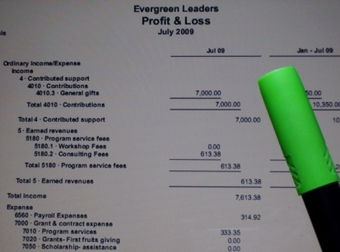
The company’s income statement
Closing the accounts prepares the ledger for the next accounting period.
Consider our example for the yoga studio. How would we record journal entries for each transaction?
Pre-opening
Prior to opening the business, you make the following transactions:
1. You contribute $4,000 in cash to start the business.
Cash 4,000
Contributed capital 4,000
2. You purchase $500 worth of mats and other equipment for use during classes.
PPE 500
Cash 500
3. You purchase an additional $400 worth of mats, equipment, and clothing for sale at the studio.
Inventory 400
Cash 400
4. You purchase liability insurance at a total cost of $1,200. The policy covers July 1 through December31.
Prepaid insurance 1,200
Cash 1,200
July
The following transactions take place during July.
1. You receive cash totaling $800 for classes.
Cash 800
Revenue 800
2. Your instructor teaches classes for the month. You agree to pay $600 for the classes; $300 is paid on July 15, and $300 will be paid on August 3.
Wage expense 600
Cash 300
Wage payable 300
3. You pay rent for July of $1,000 on July 1.
Rent expense 1,000
Cash 1,000
4. You use utilities (electricity and water) totaling $200. This amount is payable on August 15.
Utility expense 200
Utility payable 200
August
The following transactions take place during August.
1. You receive $1,500 in cash for classes. Of this amount, $1,000 was for classes in August. The remainder is for 2-month passes allowing unlimited classes in August and September.
Cash 1,500
Revenue 1,250
Unearned revenue 250
2. Your instructor again earns $600 teaching classes; $300 due on August 16 and $300 on September 1.
Wage expense 600
Cash 300
Wage payable 300
3. Utilities total $150, payable September 15.
Utility expense 150
Utility payable 150
4. You pay rent of $1,000 on August 1.
Rent expense 1,000
Cash 1,000
5. You sell inventory costing $150 for a $225.
Cash 225
Revenue 225
Cost of goods sold 150
Inventory 150
(these can be combined into a single entry if you choose. )
6. You are worried about money, so your Uncle Rafael makes you an offer. He agrees to loan you $2,000 in cash. You will need to repay him sometime later, but he doesn’t say when.
Cash 2,000
Loan Payable 2,000
7. A client is extremely dissatisfied with their class, and demands their money back. Reluctantly, you agree. The class cost $15.
Revenue 15
Cash 15
or
Refund expense 15
Cash 15
8. After borrowing money, you decide to withdraw some of your investment in the studio to pursue other opportunities. You decide to withdraw $1,000.
Contributed capital 1,000
Cash 1,000
(this cannot be a dividend, because your balance of retained earnings is negative. )
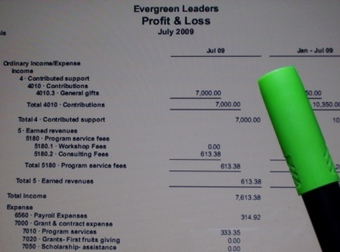
Journal Entry
Journal entries record business transactions so they may later be used to create financial statements.
2.2.4: Posting
Posting is recording in the ledger accounts the information contained in the journal.
Learning Objective
Describe how posting affects the General Journal, Special Journal and General Ledger
Key Points
- Posting is always from the journal to the ledger accounts.
- Postings can be made at the time the transaction is journalized; at the end of the day, week, or month; or as each journal page is filled.
- Cross-indexing is the placing of the account number of the ledger account in the general journal and the general journal page number in the ledger account.
Key Terms
- general journal
-
where double entry bookkeeping entries are recorded by debiting one or more accounts and crediting another one or more accounts with the same total amount
- posting
-
an item inserted into a register, ledger or diary
- ledger
-
A book for keeping notes, especially one for keeping accounting records. (accounting) A collection of accounting entries consisting of credits and debits.
Example
- Continuing with our yoga studio example, posting journalized entires into T-accounts would look something like this:
In accounting, each journal entry is like a set of instructions. Carrying out of these instructions is known as posting, a procedure that takes information recorded via journal entries (or journalizing) in the General or Special Journals and transfers it to the General Ledger. Each individual journal entry directs the input of a certain dollar amount as a debit in a specific ledger account, and directs the input of a certain dollar amount as a credit in a specific ledger account. Posting is always from the journal to the ledger accounts, and can be done two ways: the journal entries can be posted at the time the transaction is journalized; or the posting can be done at a set time like the end of the day, week, or month. Journal entries may also be posted as the journal page is filled if using a manual accounting system as a matter of personal taste. When posting the general journal, the date used in the ledger accounts is the date the transaction was recorded in the journal, not the date the journal entry was posted to the ledger accounts.
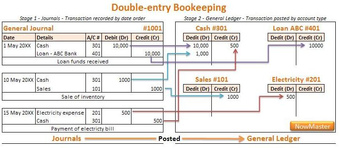
The General Ledger
All transactions made by the company in relation to the bond must be recorded in its general ledger. The general ledger contains all entries from both the General Journal and the Special Journals.
Since accountants and bookkeepers often need to trace the origin of a ledger entry, they use cross-indexing. In cross-indexing a notation is made for each entry that indicates which general or special journal account the general ledger entry came from. This practice makes it easy to trace an entry back to the original transaction. The account number appears in the Posting Reference column of the General Journal.
2.2.5: The Trial Balance
A trial balance is run during the accounting cycle to test whether the debits equal the credits.
Learning Objective
Identify when the trial balance is performed and its purpose
Key Points
- A trial balance is prepared after all the journal entries for the period have been recorded.
- The trial balance lists all of the ledger, both general journal and special, accounts and their debit or credit balances.
- A trial balance only checks the sum of debits against the sum of credits. If debits do not equal credits then the accountant or bookkeeper must determine why.
Key Terms
- equality
-
The fact of being equal; of having the same value.
- credit
-
an entry in the right hand column of an account; credits increase liability, income, and equity accounts and decrease asset and expense accounts
- debit
-
an entry in the left hand column of an account to record a debt; debits increase asset and expense accounts and decrease liability, income, and equity accounts
Example
- In the example of Highland Yoga, the pre-opening trial balance would be calculated as follows:1. You contribute $4,000 in cash to start the business.Cash 4,000, Contributed Capital 4,000; Assets(+)=Equity(+)2. You purchase $500 worth of mats and other equipment for use during classes.Cash -500, PPE 500; Assets(+), Assets(-)=03. You purchase an additional $400 worth of mats, equipment, and clothing for sale at the studio.Cash -400, Inventory 400; Assets(+), Assets(-)=04. You purchase liability insurance at a total cost of $1,200. The policy covers July 1 through December 31.Cash -1,200, Prepaid Insurance 1,200; Assets(+), Assets(-)The trial balance for debits will be:4,000 (cash) + 500 (PPE) + 400 (inventory) + 1,200 (prepaid insurance) = 6,100The trial balance for credits will be:4,000 (contributed capital) + 500 (cash) + 400 (cash) + 1,200 (cash) = 6,100The calculation will be the same for the next two periods in the example, including any necessary adjustments.
The Trial Balance
During the accounting cycle, a trial balance is prepared. It is usually prepared after all the journal entries for the period have been recorded.
The trial balance tests the equality of a company’s debits and credits. It lists all of the ledger, both general journal and special, accounts and their debit or credit balances to determine that debits equal credits in the recording process .
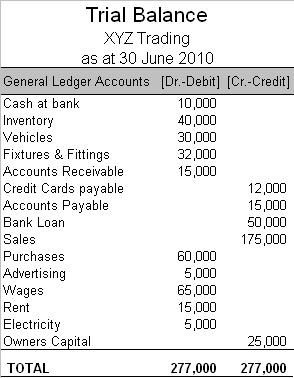
The Trial Balance
The post-closing trial balance proves debits still equal credits after the closing entries have been made.
The accounts appear in this order: assets, liabilities, stockholders’ equity, dividends, revenues, and expenses. Within the assets category, the most liquid (closest to becoming cash) asset appears first and the least liquid appears last. Within the liabilities, those liabilities with the shortest maturities appear first.
If the total of the debit column does not equal the total value of the credit column then this would show that there is an error in the nominal ledger accounts. This error must be found before a profit and loss statement and balance sheet can be produced.
Preparing the Trial Balance
The trial balance is usually prepared by a bookkeeper or accountant. The bookkeeper/accountant used journals to record business transactions. The journal entries were then posted to the general ledger. The trial balance is a part of the double-entry bookkeeping system and uses the classic ‘T’ account format for presenting values. A trial balance only checks the sum of debits against the sum of credits. If debits do not equal credits then the accountant or bookkeeper must determine why.
In the example of Highland Yoga, the pre-opening trial balance would be calculated as follows:
1. You contribute $4,000 in cash to start the business.
Cash 4,000, Contributed Capital 4,000; Assets(+)=Equity(+)
2. You purchase $500 worth of mats and other equipment for use during classes.
Cash -500, PPE 500; Assets(+), Assets(-)=0
3. You purchase an additional $400 worth of mats, equipment, and clothing for sale at the studio.
Cash -400, Inventory 400; Assets(+), Assets(-)=0
4. You purchase liability insurance at a total cost of $1,200. The policy covers July 1 through December 31.
Cash -1,200, Prepaid Insurance 1,200; Assets(+), Assets(-)
The trial balance for debits will be:
4,000 (cash) + 500 (PPE) + 400 (inventory) + 1,200 (prepaid insurance) = 6,100
The trial balance for credits will be:
4,000 (contributed capital) + 500 (cash) + 400 (cash) + 1,200 (cash) = 6,100
The calculation will be the same for the next two periods in the example, including any necessary adjustments.
Finding Errors in the Trial Balance
Some reasons why the general ledger may be out of balance:
- Failing to post part of a journal entry.
- Posting a debit as a credit, or vice versa.
- Incorrectly determining the balance of an account.
- Recording the balance of an account incorrectly in the trial balance.
- Omitting an account from the trial balance.
- Making a transposition or slide error in the accounts or the journal.
When the error is found, a correcting entry must be made. Then another trial balance is run.
2.2.6: Adjustments
Adjusting entries are journal entries made at the end of an accounting period that allocate income and expenses to their proper period.
Learning Objective
Identify the types of adjusting entries and when and why they are made
Key Points
- The matching principle of accrual accounting demands that revenues and associated costs are recognized in the same accounting period.
- The types of adjusting entries are prepayments, accrual, estimates, and inventory.
- Depreciation is an example of an estimated adjusting entry.
- In a periodic inventory system, an adjusting entry is used to determine the cost of goods sold expense. However, an adjusting entry is not necessary for a company using perpetual inventory.
- Adjusting entries for expenses such as interest, taxes, rent, and salaries are the most common accrual entries.
Key Terms
- revenue
-
Income that a company receives from its normal business activities, usually from the sale of goods and services to customers.
- accrue
-
(intransitive, accounting) To be incurred as a result of the passage of time.The monthly financial statements show all the actual but only some of the accrued expenses.
Example
- Consider our yoga studio example. Some of our previously recognized transactions need to be adjusted in later periods:Julya. Recognize insurance expensePrepaid Insurance -100, Insurance Expense 100; Assets(-)=Equity(-)b. Depreciation @ $20/monthAccumulated Depreciation 20, Depreciation Expense 20; Assets(-)=Equity(-)Augusta. Recognize insurance expensePrepaid Insurance -100, Insurance Expense 100; Assets(-)=Equity(-)b. Depreciation @ $20/monthAccumulated Depreciation 20, Depreciation Expense 20; Assets(-)=Equity(-)c. Pay wages from JulyCash -300, Wage Payable -300; Assets(-), Liabilities(-)d. Pay utilities from JulyCash -200, Utility Payable -200; Assets(-), Liabilities(-) The journal entries to record these transactions would be as follows:Julya. Expiration of insuranceInsurance expense 200 Prepaid insurance 200b. Depreciation on studio equipment (500 for 25 months = 20/month)Depreciation expense 20 Accumulated Depreciation 20Augusta. Expiration of insuranceInsurance expense 200 Prepaid insurance 200b. Depreciation on studio equipment (500 for 25 months = 20/month)Depreciation expense 20 Accumulated Depreciation 20c. Pay wage from JulyWage payable 300 Cash 300d. Pay utility bill from JulyUtility payable 200 Cash 200
What are Adjusting Entries
For accounting purposes, adjusting entries are journal entries made at the end of an accounting period. Adjusting entries allocate income and/or expenses to the period in which they actually occurred . The revenue recognition principle states that income and expenses must match. This is why adjusting entries need to be made under an accrual based accounting system. Based on this, revenues and associated costs are recognized in the same accounting period. However, the actual cash may be received or paid at a different time.
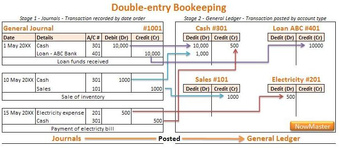
The General Ledger
The General Ledger contains all entries from both the General Journal and the Special Journals.
The Types of Adjusting Entries
There are several different types of adjusting entries. Each one accounts for a different situation.
- Prepayments – adjusting entries for prepayments are necessary to account for cash that has been paid prior to delivery of goods or completion of services. When this cash is paid, it is first recorded in a prepaid expense asset account; the account is to be expensed either with the passage of time (e.g. rent, insurance) or through use and consumption (e.g. supplies). The adjusting entry would credit the asset (e.g. supplies) account and debit a related expense account (e.g. supplies expense)
- Accruals – accrued revenues are revenues that have been recognized (that is, services have been performed or goods have been delivered), but their cash payment have not yet been recorded or received. When the revenue is recognized, it is recorded as a receivable. Accrued expenses have not yet been paid for, so they are recorded in a payable account. Expenses for interest, taxes, rent, and salaries are commonly accrued for reporting purposes.
- Estimates – An adjusting entry for an estimate occurs when the exact amount of an expense cannot easily be determined. For example, the depreciation of fixed assets is an expense that has to be estimated. The entry for bad debt expense can also be classified as an estimate.
- Inventory – in a periodic inventory system, an adjusting entry is used to determine the cost of goods sold expense. This entry is not necessary for a company using perpetual inventory.
Consider our yoga studio example. Some of our previously recognized transactions need to be adjusted in later periods:
July
a. Recognize insurance expense
Prepaid Insurance -100, Insurance Expense 100; Assets(-)=Equity(-)
b. Depreciation @ $20/month
Accumulated Depreciation 20, Depreciation Expense 20; Assets(-)=Equity(-)
August
a. Recognize insurance expense
Prepaid Insurance -100, Insurance Expense 100; Assets(-)=Equity(-)
b. Depreciation @ $20/month
Accumulated Depreciation 20, Depreciation Expense 20; Assets(-)=Equity(-)
c. Pay wages from July
Cash -300, Wage Payable -300; Assets(-), Liabilities(-)
d. Pay utilities from July
Cash -200, Utility Payable -200; Assets(-), Liabilities(-)
The journal entries to record these transactions would be as follows:
July
a. Expiration of insurance
Insurance expense……………………………….200
—–Prepaid insurance……………………………………200
b. Depreciation on studio equipment (500 for 25 months = 20/month)
Depreciation expense……………………………20
—–Accumulated Depreciation……………………………20
August
a. Expiration of insurance
Insurance expense……………………………200
—–Prepaid insurance ……………………………200
b. Depreciation on studio equipment (500 for 25 months = 20/month)
Depreciation expense……………………………20
—–Accumulated Depreciation……………………20
c. Pay wage from July
Wage payable……………………………300
—–Cash…………………………………………300
d. Pay utility bill from July
Utility payable……………………………200
—–Cash………………………………………….200
2.2.7: Preparing Financial Statements
Preparing financial statements requires preparing an adjusted trial balance, translating it into financial reports, and auditing them.
Learning Objective
Explain the necessary steps to take before preparing the financial statements and the purpose of the statements
Key Points
- The purpose of financial statements are to provide both business insiders and outsiders a concise, clear picture of the current financial status in the business. Therefore, the people who use the statements must be confident in its accuracy.
- Closing the books is simply a matter of ensuring that transactions that take place after the business’s financial period are not included in the financial statements.
- Adjusting entries are generally made in relation to prepaid expenses, prepayments, accruals, estimates and inventory.
- When an audit is completed, the auditor will issue a report regarding whether the statements are accurate. To ensure a positive reports, some companies try to participate in opinion shopping. This practice is generally prohibited..
Key Terms
- audit
-
An independent review and examination of records and activities to assess the adequacy of system controls, to ensure compliance with established policies and operational procedures, and to recommend necessary changes in controls, policies, or procedures
- adjusting entry
-
Journal entries usually made at the end of an accounting period to allocate income and expenditure to the period in which they actually occurred.
- opinion shopping
-
The process of contracting or rejecting auditors based on the type of opinion report they will issue on the auditee.
Example
- Financial statements for Highland Yoga for each period would appear as follows:
Preparing Financial Statements
When a business enterprise presents all the relevant financial information in a structured and easy to understand manner, it is called a financial statement. The purpose of financial statements are to provide both business insiders and outsiders a concise, clear picture of the current financial status in the business. Therefore, the people who use the statements must be confident in its accuracy.
Adjusted Trial Balance – Closing the Books
The process of preparing the financial statements begins with the adjusted trial balance. Preparing the adjusted trial balance requires “closing” the book and making the necessary adjusting entries to align the financial records with the true financial activity of the business.
Closing the books is simply a matter of ensuring that transactions that take place after the business’s financial period are not included in the financial statements. For example, assume a business is preparing its financial statements with a December 31st year end. It acquires some property on January 14th. If the books are properly closed, that property will not be included on the balance sheet that is being prepared for the period on December 31st.
Adjusted Trial Balance – Adjusting Entries
An adjusting entry is a journal entry made at the end of an accounting period that allocates income and expenditure to the appropriate years. Adjusting entries are generally made in relation to prepaid expenses, prepayments, accruals, estimates and inventory. Throughout the year, a business may spend funds or make assumptions that might not be accurate regarding the use of a good or service during the accounting period. Adjusting entries allow the company to go back and adjust those balances to reflect the actual financial activity during the accounting period. Failure to record the adjusting entries can result in understatement of expenses and overstatement of income, which ultimately can affect the amount of taxes paid.
For example, assume a company purchases 100 units of raw material that it expects to use up during the current accounting period. As a result, it immediately expenses the cost of the material. However, at the end of the year the company discovers it only used 50 units. The company must then make an adjusting entry to reflect that, and decrease the amount of the expense and increase the amount of inventory accordingly.
Translate the Adjusted Trial Balance to Financial Statements
Using the trial balance, the company then prepares the four financial statements. These statements are:
- The Balance Sheet: A summary of the company’s assets, liabilities and equity;
- The Income Statement: A summary of the business’s income, expenses, and profits
- The Statement of Cash Flows: A report on a company’s cash flow activities, particularly its operating, investing and financing activities; and
- The Statement of Changes in Equity: A report that explains the changes of the company’s equity throughout the reporting period
Information flows from the unadjusted trial balance to the trial balance then to the income statement.
The company may also provide Notes to the Financial Statements, which are disclosures regarding key details about the company’s operations that may not be evident from the financial statements.

Wachovia National Bank 1906 financial statement
Audit the Financial Statements
Once the company prepares its financial statements, it will contract an outside third party to audit it. An audit is an independent review and examination of records and activities to assess the adequacy of system controls, to ensure compliance with established policies and operational procedures, and to recommend necessary changes in controls, policies, or procedures. It is the audit that assures outside investors and interested parties that the content of the statements are correct.
When an audit is completed, the auditor will issue a report with the findings. The findings can state anything from the statements are accurate to statements are misleading. To ensure a positive reports, some companies try to participate in opinion shopping. This is the process that businesses use to ensure it gets a positive review. Since Enron and the accounting scandals of the early 2000s, this practice has been prohibited.
2.2.8: Closing the Cycle
Transferring information from temporary accounts to permanent accounts is referred to as closing the books.
Learning Objective
Identify the steps in the closing process
Key Points
- Closing may be performed monthly or annually.
- There are four basic steps to closing the books.
- Closing the revenue accounts—transferring the balances in the revenue accounts to a clearing account called Income Summary.
- Closing the expense accounts—transferring the balances in the expense accounts to a clearing account called Income Summary.
- Closing the Income Summary account—transferring the balance of the Income Summary account to the Retained Earnings account (also known as the capital account).
- Closing the Dividends account—transferring the balance of the Dividends account to the Retained Earnings Account.
Key Terms
- temporary account
-
an account that is closed at the end of the period to be made a permanent account
- revenue
-
Income that a company receives from its normal business activities, usually from the sale of goods and services to customers.
- account
-
A registry of pecuniary transactions; a written or printed statement of business dealings or debts and credits, and also of other things subjected to a reckoning or review
Example
- Closing entries for our yoga studio example would be:
Closing the Accounting Cycle
The process of closing the temporary accounts is often referred to as closing the books. Accountants may perform the closing process monthly or annually. Only revenue, expense, and dividend accounts are closed—not asset, liability, Capital Stock, or Retained Earnings accounts. If the accounts are not closed correctly the beginning balances for the next month may be incorrect.
The Steps to Close the Accounts
There are four basic steps in the closing process:
- Closing the revenue accounts—transferring the balances in the revenue accounts to a clearing account called Income Summary.
- Closing the expense accounts—transferring the balances in the expense accounts to a clearing account called Income Summary.
- Closing the Income Summary account—transferring the balance of the Income Summary account to the Retained Earnings account (also known as the capital account).
- Closing the Dividends account—transferring the balance of the Dividends account to the Retained Earnings Account
The Income Summary account is a clearing account only used at the end of an accounting period to summarize revenues and expenses for the period. After transferring all revenue and expense account balances to Income Summary, the balance in the Income Summary account represents the net income or net loss for the period. Closing or transferring the balance in the Income Summary account to the Retained Earnings account results in a zero balance in the Income Summary. The Dividends account is also closed at the end of the accounting period. It contains the dividends declared by the board of directors to the stockholders. The dividends account is closed directly to the Retained Earnings account. It is not closed to the Income Summary because dividends have no effect on income or loss for the period.
2.2.9: The Post-Closing Trial Balance
A post-closing trial balance is a trial balance taken after the closing entries have been posted.
Learning Objective
Explain the post-closing trial balance and why it is necessary
Key Points
- A post-closing trial balance checks the accuracy of the closing process.
- A post-closing trial balance proves that the books are in balance at the start of the new accounting period.
- The post-closing trial balance differs from the adjusted trial balance.
Key Terms
- adjusted trial balance
-
a list of all the General ledger accounts (both revenue and capital) contained in the ledger of a business after adjusting entries are made
- trial balance
-
a statement of the balances of all nominal accounts in a double-entry ledger, made to test their equality
- credit
-
an entry in the right hand column of an account; credits increase liability, income, and equity accounts and decrease asset and expense accounts
- closing entry
-
a journal entry made at the end of an accounting period to transfer temporary accounts to permanent accounts
- debit
-
an entry in the left hand column of an account to record a debt; debits increase asset and expense accounts and decrease liability, income, and equity accounts
- post-closing trial balance
-
a check that closing entries were done correctly
The Post-closing Trial Balance
The post-closing trial balance is the last step in the accounting cycle. It is prepared after all of that period’s business transactions have been posted to the General Ledger via journal entries. The post-closing trial balance can only be prepared after each closing entry has been posted to the General Ledger. The purpose of closing entries is to transfer the balances of the temporary accounts (expenses, revenues, gains, etc.) to the retained earnings account. After the closing entries are posted, these temporary accounts will have a zero balance. The permanent balance sheet accounts will appear on the post-closing trial balance with their balances. When the post-closing trial balance is run, the zero balance temporary accounts will not appear. However, all the other accounts having non-negative balances are listed, including the retained earnings account. As with the trial balance, the purpose of the post-closing trial balance is to ensure that debits equal credits.
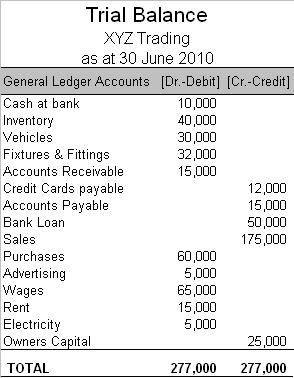
The Trial Balance
The post-closing trial balance proves debits still equal credits after the closing entries have been made.
Why the Post-Closing Trial Balance Is Necessary
While each accounting period has a beginning and an end, the periods do use information from the previous period. That is why it is necessary to run a post-closing trial balance. The preparation of a post-closing trial balance serves as a check on the accuracy of the closing process and ensures that the books are in balance at the start of the new accounting period. The post-closing trial balance differs from the adjusted trial balance in only two important respects: It excludes all temporary accounts since they have been closed, and it updates the retained earnings account to its proper ending balance.
2.2.10: Reversing Entries
Adjusting entries often disrupts routine transactions, so they are simply reversed on the first day of the new period.
Learning Objective
Describe why and how a reversing entry is made
Key Points
- Reversing entries are optional, and some firms do not perform them.
- A reversing entry reverses an adjusting entry exactly.
- Reversing entries are performed because they reduce errors and save time.
Key Terms
- debit
-
an entry in the left hand column of an account to record a debt; debits increase asset and expense accounts and decrease liability, income, and equity accounts
- credit
-
an entry in the right hand column of an account; credits increase liability, income, and equity accounts and decrease asset and expense accounts
Example
- In the example of Highland Yoga, adjusting entries are made at the end of July and August. One such entry, at the end of July, is as follows: Expiration of insurance Insurance expense 200 Prepaid insurance 200 At the beginning of August, if Highland Yoga chooses to adopt reversing entries, such an entry would be as follows: Reversing of insurance 200 Prepaid insurance 200
Reversing Entries
Reversing entries are journal entries made at the beginning of each accounting period. The sole purpose of a reversing entry is to cancel out a specific adjusting entry made at the end of the prior period, but they are optional and not every company uses them. Most often, the entries reverse accrued revenues or expenses for the previous period. Some examples of reversing entries are salary or wages payable and interest payable.
How Reversing Entries Are Used
Reversing entries help prevent accountants and bookkeepers from double recording revenues or expenses. Reversing entries are most often used with accrual-type adjusting entries.
How a Reversing Entry Works
The goal of the reversing entry is to ensure that an expense or revenue is recorded in the proper period. For example, when a company takes out a loan. If the loan is issued on the sixteenth of month A with interest payable on the fifteenth of the next month (month B), each month should reflect only a portion of the interest expense. To get the expense correct in the general ledger, an adjusting entry is made at the end of the month A for half of the interest expense. This adjusting entry records months A’s portion of the interest expense with a journal entry that debits interest expense and credits interest payable. At the beginning of the month B that expense is reversed via a reversing entry. The entry credits interest expense and debits interest payable. When the full amount of the interest is paid in month B, each month’s books will show the proper allocation of the interest expense.
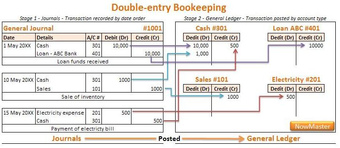
The General Ledger
Reversing entries prevent double recording expenses or revenues.
Chapter 1: Introduction to Accounting
1.1: What Is Accounting?
1.1.1: Defining Accounting
Accountancy is the process of communicating financial information about a business entity to users such as shareholders and managers.
Learning Objective
Explain the purpose of accounting
Key Points
- Accounting is thousands of years old; the earliest accounting records, which date back more than 7,000 years, were found in Mesopotamia (Assyrians).
- Luca Pacioli’s “Summa de Arithmetica, Geometria, Proportioni et Proportionalità” represents the first known printed treatise on bookkeeping; and it is widely believed to be the forerunner of modern bookkeeping practice.
- Double-entry bookkeeping is defined as any bookkeeping system in which there was a debit and credit entry for each transaction.
Key Terms
- ledger
-
A collection of accounting entries consisting of credits and debits.
- bookkeeping
-
The skill or practice of keeping books or systematic records of financial transactions, e.g., income and expenses.
Introduction
Accountancy is the process of communicating financial information about a business entity to users such as stakeholders and managers. The communication is generally in the form of financial statements that show in money terms the economic resources under the control of management; the art lies in selecting the information that is relevant to the user. The principles of accountancy are applied to business entities in three divisions of practical art: accounting, bookkeeping, and auditing.
Accounting Defined
The American Institute of Certified Public Accountants (AICPA) defines accountancy as “the art of recording, classifying, and summarizing, in a significant manner and in terms of money, transactions and events which are, in part at least, of financial character, and interpreting the results thereof. “
History
The earliest accounting records were found amongst the ruins of ancient Babylon, Assyria and Sumeria, which date back more than 7,000 years. The people of that time relied on primitive accounting methods to record the growth of crops and herds. Because there is a natural season to farming and herding, it is easy to count and determine if a surplus had been gained after the crops had been harvested or the young animals weaned.

Token Accounting in Mesopotamia
The invention of a form of bookkeeping using clay tokens represented a huge cognitive leap for mankind.
When medieval Europe moved to a monetary economy in the 13th century, sedentary merchants depended on bookkeeping to oversee multiple simultaneous transactions financed by bank loans. One important breakthrough took place around that time: the introduction of double-entry bookkeeping, which is defined as any bookkeeping system in which there was a debit and credit entry for each transaction, or for which the majority of transactions 1.were intended to be of this form. The historical origin of the use of the words ‘debit’ and ‘credit’ in accounting goes back to the days of single-entry bookkeeping in which the chief objective was to keep track of amounts owed by customers (debtors) and amounts owed to creditors. Thus, ‘Debit,’ from the Latin word debere means ‘he owes’ and ‘Credit’, from the Latin word credere, means ‘he trusts’.
The earliest extant evidence of full double-entry bookkeeping is the Farolfi ledger of 1299-1300. Giovanno Farolfi & Company were a firm of Florentine merchants whose head office was in Nîmes, and who also acted as moneylenders to the Archbishop of Arles, their most important customer. The oldest discovered record of a complete double-entry system is the Messari (Italian: “Treasurer’s”) accounts of the city of Genoa in 1340. The Messari accounts contain debits and credits journalized in a bilateral form, and contain balances carried forward from the preceding year. Therefore, they enjoy general recognition as a double-entry system.
Luca Pacioli’s “Summa de Arithmetica, Geometria, Proportioni et Proportionalità” (early Italian: “Review of Arithmetic, Geometry, Ratio and Proportion”) was first printed and published in Venice in 1494. It included a 27-page treatise on bookkeeping, “Particularis de Computis et Scripturis” (Latin: “Details of Calculation and Recording”). It was written primarily for, and sold mainly to, merchants who used the book as a reference text, as a source of pleasure from the mathematical puzzles it contained, and to aid the education of their sons. It represents the first known printed treatise on bookkeeping; and it is widely believed to be the forerunner of modern bookkeeping practice.

Father of Double-Entry Accounting
Portrait of Luca Pacioli, attributed to Jacopo de’ Barbari, 1495 (Museo di Capodimonte).
In “Summa Arithmetica,” Pacioli introduced symbols for plus and minus for the first time in a printed book, symbols that became standard notation in Italian Renaissance mathematics. “Summa Arithmetica” was also the first known book printed in Italy to contain algebra. Although Luca Pacioli did not invent double-entry bookkeeping, his 27-page treatise on bookkeeping contained the first known published work on that topic, and is said to have laid the foundation for double-entry bookkeeping as it is practiced today. Even though Pacioli’s treatise exhibits almost no originality, it is generally considered as an important work, mainly because it enjoyed a wide circulation, was written in the vernacular Italian language, and was a printed book.
Past
Early accounts served mainly to assist the memory of the businessperson, and the audience for the account was the proprietor or record keeper alone. Cruder forms of accounting were inadequate for the problems created by a business entity involving multiple investors, so double-entry bookkeeping first emerged in northern Italy in the 14th century, where trading ventures began to require more capital than a single individual was able to invest. The development of joint stock companies created wider audiences for accounts, as investors without firsthand knowledge of their operations relied on accounts to provide the requisite information. This development resulted in a split of accounting systems for internal (i.e., management accounting) and external (i.e., financial accounting) purposes, and subsequently also in accounting and disclosure regulations, following a growing need for independent attestation of external accounts by auditors.
Present
Today, accounting is called “the language of business” because it is the vehicle for reporting financial information about a business entity to many different groups of people. Accounting that concentrates on reporting to people inside the business entity is called management accounting and is used to provide information to employees, managers, owner-managers, and auditors. Management accounting is concerned primarily with providing a basis for making management or operating decisions. Accounting that provides information to people outside the business entity is called financial accounting and provides information to both current and potential shareholders, creditors such as banks or vendors, financial analysts, economists, and government agencies. Because these users have different needs, the presentation of financial accounts is very structured and subject to many more rules than management accounting. The body of rules that governs financial accounting in a given jurisdiction is called Generally Accepted Accounting Principles, or GAAP. Other rules include International Financial Reporting Standards (IFRS), U.S. GAAP, Canadian GAAP, and the GAAP in other specific countries.
1.1.2: Inputs to Accounting
Inputs into accounting include journal entries, the bookkeeping process, and the general ledger.
Learning Objective
Classify the inputs to accounting
Key Points
- In accounting, a journal entry is a logging of transactions into accounting journal items.
- The extraction of account balances is called a trial balance.
- The purpose of the trial balance is, at a preliminary stage of the financial statement preparation process, to ensure the equality of the total debits and credits.
Key Terms
- bookkeeper
-
A person responsible for keeping records or documents, such as of a business.
- journal entry
-
A journal entry, in accounting, is a logging of transactions into accounting journal items. The journal entry can consist of several items, each of which is either a debit or a credit. The total of the debits must equal the total of the credits or the journal entry is said to be “unbalanced. ” Journal entries can record unique items or recurring items, such as depreciation or bond amortization.
- journal
-
a book or computer file in which monetary transactions are entered the first time they are processed
Inputs to Accounting
Journal Entries
In accounting, a journal entry is a logging of transactions into accounting journal items. The journal entry can consist of several items, each of which is either a debit or a credit. The total of the debits must equal the total of the credits or the journal entry is said to be “unbalanced. ” Journal entries can record unique items or recurring items such as depreciation or bond amortization. Some data commonly included in journal entries are: journal entry number; batch number; type (recurring vs. nonrecurring); amount of money, name, auto-reversing; date; accounting period; and description.
The balance sheet is a statement showing net worth on a particular date. Journal entries are used to record injections and ejections to such net worth. After recording the transactions through journal entries the revised balance sheet can be prepared.
Journal entries are an easier means for perpetrating financial statement fraud than adjusting the subledgers. The former requires only a management override, while the latter requires collusion with other departments. False journal entries figured prominently in the frauds at WorldCom, Cendant, and Xerox.
Bookkeeping

Bookkeeping
Bookkeeping is the recording of financial transactions, includng sales, purchases, income, receipts and payments by an individual or organization.
In accounting, the two bookkeeping methods are the single-entry and double-entry bookkeeping systems. For modern day purposes, it is most important to know the double-entry bookkeeping system.
The ‘basic accounting equation’ is the foundation for the double-entry bookkeeping system. For each transaction, the total debits equal the total credits.
Bookkeeping is the recording of financial transactions. Transactions include sales, purchases, income, receipts and payments by an individual or organization. Bookkeeping is usually performed by a bookkeeper. Many individuals mistakenly consider bookkeeping and accounting to be the same thing. This confusion is understandable because the accounting process includes the bookkeeping function, but is just one part of the accounting process.
The accountant creates reports from the recorded financial transactions recorded by the bookkeeper and files forms with government agencies. There are some common methods of bookkeeping such as the single-entry bookkeeping system and the double-entry bookkeeping system. However, while these systems may be seen as “real” bookkeeping, any process that involves the recording of financial transactions is a bookkeeping process. A bookkeeper (or book-keeper), also known as an accounting clerk or accounting technician, is a person who records the day-to-day financial transactions of an organization.
A bookkeeper is usually responsible for writing the “daybooks. ” The daybooks consist of purchases, sales, receipts, and payments. The bookkeeper is responsible for ensuring all transactions are recorded in the correct day book, suppliers ledger, customer ledger, and general ledger. The bookkeeper brings the books to the trial balance stage. An accountant may prepare the income statement and balance sheet using the trial balance and ledgers prepared by the bookkeeper.
The General Ledger
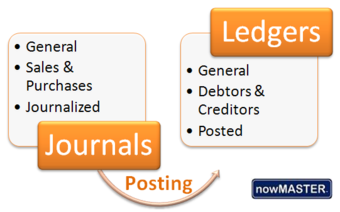
Journals to Ledgers
The general ledger works as a central repository for accounting data transferred from all sub-ledgers or modules like accounts payable, accounts receivable, cash management, fixed assets, purchasing, and projects.
General Ledger is the final repository of the accounting records and data. In modern accounting softwares or ERP, the general ledger works as a central repository for accounting data transferred from all sub-ledgers or modules like accounts payable, accounts receivable, cash management, fixed assets, purchasing, and projects. General ledger is the backbone of any accounting system which holds financial and non-financial data for an organization. The statement of financial position and the statement of income and comprehensive income are both derived from the general ledger.
Each account in the general ledger consists of one or more pages. The general ledger is where posting to the accounts occurs. Posting is the process of recording amounts as credits, (right side), and amounts as debits, (left side), in the pages of the general ledger. Additional columns to the right hold a running activity total (similar to a checkbook). The listing of the account names is called the chart of accounts. The extraction of account balances is called a trial balance. The purpose of the trial balance is, at a preliminary stage of the financial statement preparation process, to ensure the equality of the total debits and credits.
The general ledger should include the date, description, and balance or total amount for each account. It is usually divided into at least seven main categories. These categories generally include assets, liabilities, owner’s equity, revenue, expenses, gains, and losses. The main categories of the general ledger may be further subdivided into subledgers to include additional details of such accounts as cash, accounts receivable, accounts payable, etc.
1.1.3: Outputs of Accounting
Accounting outputs are financial statements that detail the financial activities of a business, person, or other entity.
Learning Objective
Describe the four basic financial statements
Key Points
- The balance sheet, reports on a company’s assets, liabilities, and ownership equity at a given point in time.
- The income statement is also referred to as profit and loss statement, or a “P&L. ” This statement reports on a company’s income, expenses, and profits over a period of time.
- A statement of changes in shareholder’s equity explains the changes of the company’s equity throughout the reporting period.
Key Term
- debenture
-
A certificate that certifies an amount of money owed to someone; a certificate of indebtedness.
Financial Statements
A financial statement, or financial report, is a formal record of the financial activities of a business, person, or other entity. For a business enterprise, relevant financial information presented in a structured manner is called a financial statement. Statements typically include four basic financial statements accompanied by a management discussion and analysis. These statements are as follows:
Balance Sheet
This statement reports on a company’s assets, liabilities, and ownership equity at a given point in time.
Income Statement
This statement, also referred to as profit and loss statement (or a “P&L”), reports on a company’s income, expenses, and profits over a period of time. A profit and loss statement provides information on the operation of the enterprise. These statements include sale and various expenses incurred during the processing state.
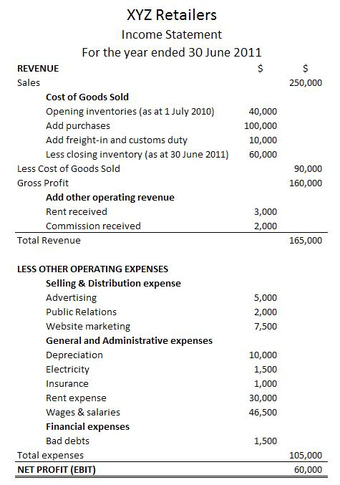
A Sample Income Statement
Expenses are listed on a company’s income statement.
Statement of Cash Flows
This statement reports on a company’s cash flow activities—particularly its operating, investing, and financing activities. For large corporations, these statements are often complex and may include extensive notes, an explanation of financial policies, and management analysis. The notes typically provide detail for items on the balance sheet, income statement, and cash flow statement. Notes to financial statements are considered an integral part of the financial statements.
Statement of Shareholder’s Equity
This statement explains changes in the company’s equity throughout the reporting period.
Purpose of Financial Statements
The objective of financial statements is to provide information about financial position, performance, and changes. Statements are useful to a wide range of users making economic decisions. Financial statements should be understandable, relevant, reliable, and comparable. Reported assets, liabilities, equity, income, and expenses are directly related to an organization’s financial position.
Financial statements are intended to be understandable by readers who have a reasonable knowledge of business and economic activities and accounting and who are willing to study the information diligently.
Owners and managers require financial statements to make business decisions that affect continued operations. Statements are analyzed to provide management with a more detailed understanding of the figures. These statements are also used as part of management’s annual report to the stockholders.
Employees need financial statements when making collective bargaining agreements (CBA) with the management and when discussing their compensation, promotion, and rankings.
Prospective investors hire analysts to prepare financial statements. This allows investors to assess the viability of a business.
Financial institutions (banks and other lending companies) use statements to decide whether to grant a company fresh working capital or extend debt securities (such as a long-term bank loan or debentures).
Government entities (tax authorities) need financial statements to ascertain the propriety and accuracy of taxes and other duties declared and paid by a company.
Vendors who extend credit to a business require financial statements to assess the creditworthiness of the business.
1.1.4: Uses of Financial Reports
Financial reporting is used by owners, managers, employees, investors, institutions, government, and others to make important decisions about a business.
Learning Objective
Give examples of who uses financials statements and why
Key Points
- Owners and managers require financial statements to make important business decisions that affect its continued operations.
- Employees also need these reports in making collective bargaining agreements with the management, in the case of labor unions or for individuals in discussing their compensation, promotion, and rankings.
- Although laws differ from country to country, an audit of the financial statements of a public company is usually required for investment, financing, and tax purposes.
Key Terms
- creditworthiness
-
The property of being creditworthy, when a person is deemed likely to repay debts and / or has an acceptable credit rating
- auditor
-
A person who audits (reviews and examines) bookkeeping accounts
Financial statements may be used by different stakeholders for a multitude of purposes
- Owners and managers require financial statements to make important business decisions affecting its continued operations. Financial analysis is then performed on these statements, providing management with a more detailed understanding of the figures. These statements also are used as part of management’s annual report to the stockholders.
- Employees need these reports in making collective bargaining agreements with the management, in the case of labor unions or for individuals in discussing their compensation, promotion, and rankings.
- Prospective investors make use of financial statements to assess the viability of investing in a business. Financial analyses are used by investors and prepared by professionals (financial analysts), thus providing them with the basis for making investment decisions.
- Financial institutions (banks and other lending companies) use them to decide whether to grant a company working capital or extend debt securities (such as long-term bank loans or debentures) to finance expansion and other significant expenditures.
- Government entities (tax authorities) need financial statements to ascertain the propriety and accuracy of taxes and other duties declared and paid by a company.
- Vendors who extend credit to a business require financial statements to assess the creditworthiness of the business.
- Media and the general public are interested in financial statements for a variety of reasons.
Government
Government also produces financial reports to stay accountable to the public and people. The rules for recording, measurement and presentation of government financial statements may be different from those required for business and even for non-profit organizations.
Not-for-profit Organizations
The requirements for non-profit financial statements differ from those of a for profit institution and therefore, will not be discussed.
Personal
Personal financial statements may be required from persons applying for a personal loan or financial aid. Typically, a personal financial statement consists of a single form for reporting personally held assets and liabilities (debts) or personal sources of income and expenses, or both. The form to be filled out is determined by the organization supplying the loan or aid.
Audit and Legal
Although laws differ from country to country, an audit of financial statements of a public company is usually required for investment, financing, and tax purposes. These are usually performed by independent accountants or auditing firms. Results are summarized in an audit report that either provides an unqualified opinion on the financial statements or qualifications as to its fairness and accuracy. The audit opinion on the financial statements is usually included in the annual report. There has been legal debate over who an auditor is liable to. Since audit reports tend to be addressed to the current shareholders, it is commonly thought that they owe a legal duty of care to them. This may not be the case, as determined by common law precedent. In Canada, auditors are liable only to investors using a prospectus to buy shares in the primary market. In the United Kingdom, they have been held liable to potential investors when the auditor was aware of the potential investor and how they would use the information in the financial statements. Nowadays, auditors tend to include in their report liability restricting language, discouraging anyone, other than the addressees of their report, from relying on it. Liability is an important issue: In the UK, for example, auditors have unlimited liability. In the United States, especially in the post-Enron era, there has been concern about the accuracy of financial statements. Corporate officers (the chief executive officer (CEO) and chief financial officer (CFO)) are personally liable for attesting that financial statements “do not contain any untrue statement of a material fact or omit to state a material fact necessary to make the statements made, in light of the circumstances under which such statements were made, not misleading with respect to the period covered by the report. ” Making or certifying misleading financial statements exposes the people involved to civil and criminal liability. For example Bernie Ebbers (former CEO of WorldCom) was sentenced to 25 years in federal prison for allowing WorldCom’s revenues to be overstated by billions over five years.

Auditing Firm
Auditing firm office building in San Francisco.
1.2: The Accounting Concept
1.2.1: Reasons for a Conceptual Framework
A conceptual framework is a system of ideas and objectives that lead to the creation of a consistent set standards.
Learning Objective
Explain the purpose of the conceptual framework in accounting
Key Points
- The main reasons for developing an agreed conceptual framework are that it provides a framework for setting accounting standards, a basis for resolving accounting disputes, fundamental principles which then do not have to be repeated in accounting standards.
- The Financial Accounting Standards Board (FASB) is a private, not-for-profit organization whose mission is “to establish and improve standards of financial accounting and reporting for the guidance and education of the public, including issuers, auditors, and users of financial information.
- Created in 1973, FASB replaced the Committee on Accounting Procedure (CAP) and the Accounting Principles Board (APB) of the American Institute of Certified Public Accountants (AICPA).
- FASB’s Conceptual Framework, a project begun in 1973 to develop a sound theoretical basis for the development of accounting standards in the United States. From 1978 to 2010 the FASB released eight concept statements.
Key Term
- FASB
-
The Financial Accounting Standards Board (FASB) is a private, not-for-profit organization whose primary purpose is to developgenerally accepted accounting principles (GAAP) within the United States in the public’s interest.
Conceptual Framework
A conceptual framework can be defined as a system of ideas and objectives that lead to the creation of a consistent set of rules and standards. Specifically in accounting, the rule and standards set the the nature, function and limits of financial accounting and financial statements.
The main reasons for developing an agreed conceptual framework are that it provides:
- a framework for setting accounting standards;
- a basis for resolving accounting disputes;
- fundamental principles which then do not have to be repeated in accounting standards.
History
Prior to 1929, no group—public or private—was responsible for accounting standards. After the 1929 stock market crash, the Securities and Exchange Act of 1934 was passed. This resulted in the U.S. Securities and Exchange Commission (SEC) supervising public companies. The Securities and Exchange Commission (SEC) designated the FASB as the organization responsible for setting accounting standards for public companies in the U.S.
The Financial Accounting Standards Board (FASB) is a private, not-for-profit organization whose mission is “to establish and improve standards of financial accounting and reporting for the guidance and education of the public, including issuers, auditors, and users of financial information. ” Created in 1973, FASB replaced the Committee on Accounting Procedure (CAP) and the Accounting Principles Board (APB) of the American Institute of Certified Public Accountants (AICPA).
FASB’s Conceptual Framework, a project begun in 1973 to develop a sound theoretical basis for the development of accounting standards in the United States. From 1978 to 2010 the FASB released eight concept statements.
- OBJECTIVES OF FINANCIAL REPORTING BY BUSINESS ENTERPRISES (SFAC No. 1) 1978
- QUALITATIVE CHARACTERISTICS OF ACCOUNTING INFORMATION (SFAC No. 2)1980
- ELEMENTS OF FINANCIAL STATEMENTS OF BUSINESS ENTERPRISES (SFAC No. 3)1980
- OBJECTIVES OF FINANCIAL REPORTING BY NONBUSINESS ORGANIZATIONS (SFAC No. 4) 1980
- RECOGNITION AND MEASUREMENT IN FINANCIAL STATEMENTS OF BUSINESS ENTERPRISES (SFAC No. 5)1984
- ELEMENTS OF FINANCIAL STATEMENTS; a replacement of FASB Concepts Statement N. 3, also incorporating an amendment of FASB Concepts Statement No. 2 (SFAC N. 6) 1985
- USING CASH FLOW INFORMATION AND PRESENT VALUE IN ACCOUNTING MEASUREMENTS (SFAC No. 7) 2000
- No. 8. CONCEPTUAL FRAMEWORK FOR FINANCIAL REPORTING, a replacement of SFAC No. 1 and No. 2 2010
Why is the Framework Necessary
With a sound conceptual framework in place the FASB is able to issue consistent and useful standards. In addition, without an existing set of standards, it isn’t possible to resolve any new problems that emerge.
The framework also increases financial statement users’ understanding of and confidence in financial reporting and makes it easier to compare different companies’ financial statements.

Laying a Foundation for Building
U.S. Navy Petty Officer 3rd Class Channing Connelly, right, uses a laser-guided level to check for proper frame elevation as other Seabees adjust a frame board while working on a building foundation at a patrol base in Mahawil, Iraq, Feb. 4, 2009.
1.2.2: Objectives of Accounting
The objective of business financial reporting is to provide information that is useful for making business and economic decisions.
Learning Objective
Describe the objectives of accounting, distinguishing between Generally Accepted Accounting Principles (GAAP) and International Financial Reporting Standards (IFRS)
Key Points
- Specifically, the information should be useful to investors and lenders, be helpful in determining a company’s cash flows, and report the company’s assets, liabilities, and owner’s equity and the changes in them.
- Financial accountants produce financial statements based on the accounting standards in a given jurisdiction.
- Generally Accepted Accounting Principles refer to the standard framework of guidelines for financial accounting used in any given jurisdiction.
- International Financial Reporting Standards (IFRS) are designed as a common global language for business affairs so that company accounts are understandable and comparable across international boundaries.
Key Terms
- Assets
-
Any property or object of value that one possesses, usually considered as applicable to the payment of one’s debts.
- International Accounting Standards Board
-
an independent, accounting standard-setting body
- liabilities
-
An amount of money in a company that is owed to someone and has to be paid in the future, such as tax, debt, interest, and mortgage payments.
Objectives of Accounting
The Financial Accounting Standards Boards Statements of Financial Accounting Concepts No. 1 states the objective of business financial reporting, which is to provide information that is useful for making business and economic decisions. Specifically, the information should be useful to investors and lenders, be helpful in determining a company’s cash flows, and report the company’s assets, liabilities, and owner’s equity and the changes in them.
With these objectives in mind, financial accountants produce financial statements based on the accounting standards in a given jurisdiction. These standards may be the generally accepted accounting principles of a respective country, which are typically issued by a national standard setter, or International Financial Reporting Standards, which are issued by the International Accounting Standards Board.
U.S GAAP
Generally Accepted Accounting Principles refer to the standard framework of guidelines for financial accounting used in any given jurisdiction; generally known as accounting standards or Standard accounting practice. These include the standards, conventions, and rules that accountants follow in recording and summarizing, and in the preparation of financial statements.
IFRS
International Financial Reporting Standards (IFRS) are designed as a common global language for business affairs so that company accounts are understandable and comparable across international boundaries. They are a consequence of growing international shareholding and trade and are particularly important for companies that have dealings in several countries. They are progressively replacing the many different national accounting standards.The rules to be followed by accountants to maintain books of accounts which is comparable, understandable, reliable and relevant as per the users internal or external.

Project Managers
Gary Roughead talks with project managers while touring Pacific Beacon.
1.2.3: Fundamental Concepts in Accounting
In order to prepare the financial statements, it is important to adhere to certain fundamental accounting concepts.
Learning Objective
State the fundamental concepts and objectives of financial reporting
Key Points
- Going Concern, unless there is evidence to the contrary, it is assumed that a business will continue to trade normally for the foreseeable future.
- Accruals and Matching, revenue earned must be matched against expenditure when it was incurred.
- The objectives of financial reporting is to provide information that is relevant and useful.
- Accounting concepts deal with the standards and laws required to satisfy the needs of investors, employees, and other stakeholders.
Key Terms
- going concern assumption
-
the business is going to be operated for non-predefined period
- entity
-
That which has a distinct existence as an individual unit. Often used for organisations which have no physical form.
- revenue
-
Income that a company receives from its normal business activities, usually from the sale of goods and services to customers.
Fundamental Concepts in Accounting
Financial statements are prepared according to agreed upon guidelines. In order to understand these guidelines, it helps to understand the objectives of financial reporting. The objectives of financial reporting, as discussed in the Financial Accounting standards Board (FASB) Statement of Financial Accounting Concepts No. 1, are to provide information that
- Is useful to existing and potential investors and creditors and other users in making rational investment, credit, and similar decisions;
- Helps existing and potential investors and creditors and other users to assess the amounts, timing, and uncertainty of prospective net cash inflows to the enterprise;
- Identifies the economic resources of an enterprise, the claims to those resources, and the effects that transactions, events, and circumstances have on those resources.
Preparing Financial Statements
In order to prepare the financial statements, it is important to adhere to certain fundamental accounting concepts.
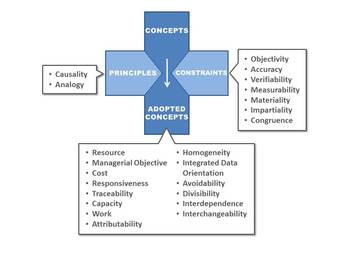
Accounting Concepts in a Diagram
This is a diagram of details for principles, concepts, and constraints within the field of Financial Accounting.
- Going Concern, unless there is evidence to the contrary, it is assumed that a business will continue to trade normally for the foreseeable future.
- Accruals and Matching, revenue earned must be matched against expenditure when it was incurred
- Prudence, if there are two acceptable accounting procedures choose the one gives the less optimistic view of profitability and asset values.
- Consistency, similar items should be accorded similar accounting treatments.
- Entity, a business is an entity distinct from its owners.
- Money Measurement, accounts only deal with items to which monetary values can be attributed.
- Separate Valuation each asset or liability must be valued separately.
- Materiality, only items material in amount or in their nature will affect the true and fair view given by a set of accounts.
- Historical Cost, tTransactions are recorded at the cost when they occurred.
- Realization, revenue and profits are recognized when realized.
- Duality, every transaction has two effects.
1.2.4: Importance of Recognition and Measurement
In accounting, recognition of revenues and expenses is based on the matching principle.
Learning Objective
Explain the difference between accruals and deferrals
Key Points
- Accrued revenue: Revenue is recognized before cash is received.
- Deferred revenue: Revenue is recognized after cash is received.
- Accrued expense: Expense is recognized before cash is paid out.
- Deferred expense: Expense is recognized after cash is paid out.
Key Terms
- disclosure
-
In accounting the transaction is not included on the financial statements but reported in the notes to the financial statement.
- mismatch
-
Something that does not match; something dissimilar, inappropriate or unsuitable.
- recognition
-
In accounting recognition is the act of including a transaction of a financial statement-either the income statement or the balance sheet.
Example
- Accrued expense allows matching future costs of products to the proceeds from their sales prior to paying out such costs. Deferred expense (prepaid expense) allows matching costs of products paid out to those not received yet. Depreciation matches the cost of purchasing fixed assets to revenues generated by them. Depreciation does this by spreading such costs over their expected life.
Revenue Recognition Principle
The revenue recognition principle and the matching principle are two cornerstones of accrual accounting. They both determine the accounting period, in which revenues and expenses are recognized. According to the revenue recognition principle, revenues are recognized when they are realized or realizable and earned—usually when goods are transferred or services rendered—regardless of when cash is received. In contrast, cash accounting revenues are recognized when cash is received regardless of when goods or services are sold. Cash can be received before or after obligations are met—when goods or services are delivered. Related revenues as two types of accounts:
- Accrued revenue: Revenue is recognized before cash is received.
- Deferred revenue: Revenue is recognized after cash is received.
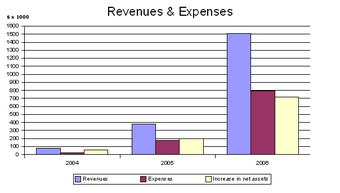
Revenues and Expenses
This graph shows the growth of the revenues, expenses, and net assets of the Wikimedia Foundation from june 2003 to june 2006.
Accruals and Deferrals: Timing of Recognition vs. Cash Flow
Two types of balancing accounts exist to avoid fictitious profits and losses. These might occur when cash is not paid out in the same accounting period in which expenses are recognized. According to the matching principle in accrual accounting, expenses are recognized when obligations are incurred—regardless of when cash is paid out. In contrast to recognition is disclosure. An item is disclosed when it is not included in the financial statements, but appears in the notes of the financial statements. Cash can be paid out in an earlier or later period than the period in which obligations are incurred. Related expenses result in the following two types of accounts:
- Accrued expense: Expense is recognized before cash is paid out.
- Deferred expense: Expense is recognized after cash is paid out.
Accrued expenses are a liability with an uncertain timing or amount; the uncertainty is not significant enough to qualify it as a provision. One example would be an obligation to pay for goods or services received from a counterpart, while the cash is paid out in a later accounting period—when its amount is deducted from accrued expenses. Accrued expenses shares characteristics with deferred revenue. One difference is that cash received from a counterpart is a liability to be covered later; goods or services are to be delivered later—when such income item is earned, the related revenue item is recognized, and the same amount is deducted from deferred revenues.
Deferred expenses, or prepaid expenses or prepayment, are an asset. These expenses include cash paid out to a counterpart for goods or services to be received in a later accounting period—when fulfilling the promise to pay is actually acknowledged, the related expense item is recognized, and the same amount is deducted from prepayments. Deferred expenses share characteristics with accrued revenue. One difference is that proceeds from a delivery of goods or services are an asset to be covered later, when the income item is earned and the related revenue item is recognized; cash for the items is received in a later period—when its amount is deducted from accrued revenues.
The Matching Principle
The matching principle is a culmination of accrual accounting and the revenue recognition principle. They both determine the accounting period, in which revenues and expenses are recognized. According to the principle, expenses are recognized when obligations are:
- Incurred (usually when goods are transferred or services rendered—e.g. sold)
- Offset against recognized revenues, which were generated from those expenses (related on the cause-and-effect basis), regardless of when cash is paid out. In cash accounting, on the other hand, expenses are recognized when cash is paid out, regardless of when obligations are incurred through transfer of goods or rendition of services.
If no cause-and-effect relationship exists (e.g., a sale is impossible), costs are recognized as expenses in the accounting period they expired—when have been used up or consumed. Prepaid expenses are not recognized as expenses, but as assets until one of the qualifying conditions is met resulting in a recognition as expenses. If no connection with revenues can be established, costs are recognized immediately as expenses (e.g., general administrative and research and development costs).
Prepaid expenses, such as employee wages or subcontractor fees paid out or promised, are not recognized as expenses (cost of goods sold), but as assets (deferred expenses), until the actual products are sold.
The matching principle allows better evaluation of actual profitability and performance. It reduces noise from the timing mismatch between when costs are incurred and when revenue is realized. Keep in mind that recent standards have moved away from matching expenses and revenues in favor of “balance sheet” model of reporting.
1.3: Overview of Key Elements of the Business
1.3.1: Business Stakeholders: Internal and External
A stakeholder is an individual or group that has a legitimate interest in a company.
Learning Objective
Discuss what a business stakeholder is and how they interact with the company
Key Points
- A corporate stakeholder is a person or group who can affect or be affected by the actions of a business.
- Internal stakeholders are entities within a business (e.g., employees, managers, the board of directors, investors).
- External stakeholders are entities not within a business itself but who care about or are affected by its performance (e.g., consumers, regulators, investors, suppliers).
Key Term
- corporate stakeholder
-
A corporate stakeholder is that which can affect or be affected by the actions of the business as a whole.
A corporate stakeholder is an individual or group who can affect or be affected by the actions of a business. The stakeholder concept was first used in a 1963 internal memorandum at the Stanford Research Institute. It defined stakeholders as “those groups without whose support the organization would cease to exist. “
In the last decades of the 20th century, the word “stakeholder” has become more commonly used to refer to a person or group that has a legitimate interest in a project or entity. In discussing the decision-making process for institutions—including large business corporations, government agencies, and non-profit organizations — the concept has been broadened to include everyone with an interest (or “stake”) in what the entity does.
Internal stakeholders are entities within a business (e.g., employees, managers, the board of directors, investors). Employees want to earn money and stay employed. Owners are interested in maximizing the profit the business makes. Investors are concerned about earning income from their investment.
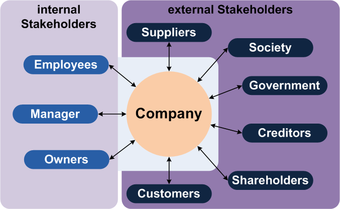
Stakeholders
The picture shows the typical stakeholders of a company. The stakeholders are divided in internal and external stakeholders.
External stakeholders are entities not within a business itself but who care about or are affected by its performance (e.g., consumers, regulators, investors, suppliers). The government wants the business to pay taxes, employ more people, follow laws, and truthfully report its financial conditions. Customers want the business to provide high-quality goods or services at low cost. Suppliers want the business to continue to purchase from them. Creditors want to be repaid on time and in full. The community wants the business to contribute positively to its local environment and population.
1.3.2: Activities of the Business: Financing, Investing, and Operating
Activities of the business include operating activities and non-operating activities such as investing activities, and financing activities.
Learning Objective
Identify the difference between the three types of business activities
Key Points
- Operating activities include the production, sales, and delivery of the company’s product as well as collecting payment from its customers. This could include purchasing raw materials, building inventory, advertising, and shipping the product.
- Investing activities include purchases or sales of an asset (assets can be land, building, equipment, marketable securities, etc.), loans made to suppliers or received from customers, payments related to mergers and acquisitions, and dividends received.
- Financing activities include the inflow of cash from investors, as well as the outflow of cash to shareholders as dividends as the company generates income. Other activities which impact the long-term liabilities and equity of the company are also listed in the financing activities.
Key Terms
- operating activities
-
the amount of cash a company generates from the revenues it brings in, excluding costs associated with long-term investment on capital items or investment in securities
- fundamental
-
A leading or primary principle, rule, law, or article, which serves as the groundwork of a system; essential part, as, the fundamentals of linear algebra.
Activities of the business include operating activities, investing activities, and financing activities .
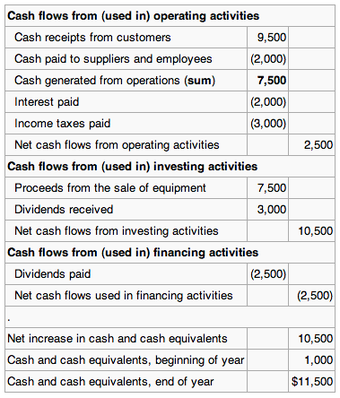
Business activities
Business activities include operating, investing and financing activities.
Operating activities, or the fundamental activities the business engages in can include the production, sales, and delivery of the company’s product as well as collecting payment from its customers. This could include purchasing raw materials, building inventory, advertising, and shipping the product. Under GAAP, operating cash flows include:
- Receipts from the sale of goods or services
- Receipts for the sale of loans
- Debt or equity instruments in a trading portfolio
- Interest received on loans
- Payments to suppliers for goods and services
- Payments to employees or on behalf of employees
- Interest payments (alternatively, this can be reported under financing activities in IAS 7 and US GAAP)
- Buying merchandise.
In addition to operating activities businesses engage in non-operating activities. Non-operating activities are not related to the day-to-day, ongoing operations of a business. Non-operating cash flows include borrowings, the issuance or purchase of stock, asset sales, dividend payments, and other investment activity.
Some examples of non-operating activities include:
Investing activities include purchases or sales of an asset (assets can be land, building, equipment, marketable securities, etc.), loans made to suppliers or received from customers, payments related to mergers and acquisitions, and dividends received.
Financing activities include the inflow of cash from investors such as banks and shareholders, as well as the outflow of cash to shareholders as dividends as the company generates income. Other activities which impact the long-term liabilities and equity of the company are also listed in the financing activities.
As with operating activities GAAP principles dictate how non-operating items are classified on the statement of cash flows.
1.3.3: The Role of Accounting in the Business
The role of accounting in business is to help internal and external stakeholders make better business decisions by providing them with financial information.
Learning Objective
Explain the importance of accounting for a business
Key Points
- Accounting communicates information that owners, managers, and investors need to evaluate a company’s financial performance.
- Accountants typically work in one of two major fields: management accounting, which helps you keep your business running, or financial accounting, which tells you how well you’re running it.
- The purpose of management accounting is to supply relevant, accurate, timely information to managers in a format that will aid them in making decisions.
- The purpose of financial accounting is to provide information that helps with the assessment of a firm’s financial history and current performance.
- Financial accounting includes income statements, balance sheets, and statements of cash flows.
Key Term
- financial accounting
-
Furnishes information to individuals and groups both inside and outside an organization to help them assess the firm’s financial history and performance.
Accounting is often called “the language of business.” Why? Because it communicates so much of the information that owners, managers, and investors need to evaluate a company’s financial performance. These people are all stakeholders in the business, which is to say they’re interested in its activities because they’re affected by them.
In fact, the purpose of accounting is to help stakeholders make better business decisions by providing them with financial information. Obviously, you wouldn’t try to run an organization or make investment decisions without accurate and timely financial information, and it’s the accountant who prepares this information.
More importantly, accountants make sure that stakeholders understand the meaning of financial information, and they work with both individuals and organizations to help them use financial information to deal with business problems.
Actually, collecting all the numbers is the easy part—today, all you have to do is start up your accounting software. The hard part is analyzing, interpreting, and communicating the information. Of course, you also have to present everything clearly while effectively interacting with people from every business discipline.
All this means that “accounting” can be defined as a system for measuring and summarizing business activities, interpreting financial information, and communicating the results to management and other decision makers.
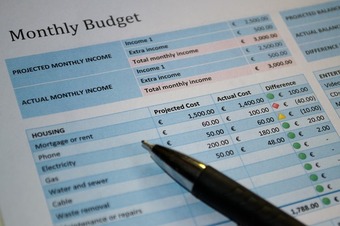
Role of accounting
Accounting helps direct and control operating activities.
Fields of Accounting
Accountants typically work in one of two major fields. Management accountants provide information and analysis to decision makers inside the organization in order to help them run it. Financial accountants furnish information to individuals and groups both inside and outside the organization in order to help them assess its financial performance.
In other words, management accounting helps you keep your business running while financial accounting tells you how well you’re running it.
Management Accounting
Management accounting plays a key role in helping managers carry out their responsibilities. Reports are tailored to the needs of individual managers, and the purpose of such reports is to supply relevant, accurate, timely information in a format that will aid managers in making decisions. In preparing, analyzing, and communicating such information, accountants work with individuals from all the functional areas of the organization—human resources, operations, marketing, and finance.
Financial Accounting
Financial accounting furnishes information to individuals and groups both inside and outside the organization to help them assess the firm’s financial performance. These financial reports—including the income statement, the balance sheet, and the statement of cash flows—summarize a company’s past performance and evaluate its financial health.
1.3.4: Ethical Considerations
Business ethics is a form of applied ethics that examines ethical principles, moral/ethical problems that arise in a business environment.
Learning Objective
Indicate the role ethics plays in business
Key Points
- Business ethics reflects the philosophy of business, one of whose aims is to determine the fundamental purposes of a company.
- Ethical issues include the rights and duties between a company and its employees, suppliers, customers and neighbors, its fiduciary responsibility to its shareholders. Issues concerning relations between different companies include hostile take-overs and industrial espionage.
- There are different area of business ethics, including finance, human resource management, production…
- The Securities Act of 1933 and 1934, were both put in place after the stock market crash in 1929. The acts are designed to prevent that type of situation from happening again.
- In response to a number of major corporate and accounting scandals including those affecting Enron, Tyco International, Adelphia, Peregrine Systems and WorldCom the Sarbanes-Oaxley Act was put into place.
Key Terms
- Sarbanes-Oxley Act (SOX)
-
An act passed by U.S. Congress in 2002 to protect investors from the possibility of fraudulent accounting activities by corporations. The Sarbanes-Oxley Act (SOX) mandated strict reforms to improve financial disclosures from corporations and prevent accounting fraud. SOX was enacted in response to the accounting scandals in the early 2000s. Scandals such as Enron, Tyco, and WorldCom shook investor confidence in financial statements and required an overhaul of regulatory standards.
- fiduciary responsibility
-
A fiduciary is a legal or ethical relationship of trust between two or more parties.
Business ethics (also known as corporate ethics) is a form of applied ethics or professional ethics that examines ethical principles and moral or ethical problems that arise in a business environment. It applies to all aspects of business conduct and is relevant to the conduct of individuals and entire organizations.

Standard Ethics Logo
Standard ethics
Business ethics reflects the philosophy of business, one of whose aims is to determine the fundamental purposes of a company. If a company’s purpose is to maximize shareholder returns, then sacrificing profits to other concerns is a violation of its fiduciary responsibility. Corporate entities are legally considered to be persons in the U.S. and in most nations. The “corporate persons” are legally entitled to the rights and liabilities due to citizens as persons.
Ethical issues include the rights and duties between a company and its employees, suppliers, customers and neighbors, and the company’s fiduciary responsibility to its shareholders. Issues concerning relations between different companies include hostile take-overs and industrial espionage. Related issues include corporate governance, corporate social entrepreneurship, political contributions, legal issues (such as the ethical debate over introducing a crime of corporate manslaughter) and the marketing of corporations’ ethics policies.
Business Ethics In Production
Business ethics in production usually deals with the duties of a company to ensure that products and production processes do not needlessly cause harm. In some cases consumers demand products that harm them, such as tobacco products. Production may have environmental impacts, including pollution, habitat destruction and urban sprawl. The downstream effects of nuclear technology, genetically modified food and mobile phones may not be well understood. While the precautionary principle may prohibit introducing new technology whose consequences are not fully understood, that principle would have prohibited most new technology introduced since the industrial revolution.
Labor Ethics
Human resource management occupies the sphere of activity of recruitment selection, orientation, performance appraisal, training and development, industrial relations and health and safety issues. Business ethicists differ in their orientation towards labor ethics. Some assess human resource policies according to whether they support an egalitarian workplace and the dignity of labor. Human resource management aims to deter discrimination by age (preferring the young or the old), gender/sexual harassment, race, religion, disability, weight and attractiveness.
Government Regulation
At times, the Federal government has been called upon to enact legislation meant to encourage more ethical business behavior. For example, in response to a number of major corporate and accounting scandals — including those affecting Enron, Tyco International, Adelphia, Peregrine Systems and WorldCom — the Sarbanes-Oxley Act (SOX) of 2002 was put into place. SOX — also known as the “Public Company Accounting Reform and Investor Protection Act” in the Senate and “Corporate and Auditing Accountability and Responsibility Act” in the House — is a United States Federal law that set new or enhanced standards for all U.S. public company boards, management and public accounting firms.
The act contains 11 titles, or sections, ranging from additional corporate board responsibilities to criminal penalties, and requires the Securities and Exchange Commission (SEC) to implement rulings on requirements to comply with the law. As a result of SOX, top management must now individually certify the accuracy of financial information. In addition, penalties for fraudulent financial activity are much more severe. Also, SOX increased the independence of the outside auditors who review the accuracy of corporate financial statements and increased the oversight role of boards of directors.
While it may seem scandals involving a lack of business ethics are a recent development, the Securities Acts of 1933 and 1934 were both put in place after the stock market crash in 1929. These are sweeping pieces of legislation that govern the secondary trading of securities (stocks, bonds, and debentures). The Acts and related statutes form the basis of regulation of the financial markets and their participants in the United States. The 1934 Act also established the SEC.
1.4: Conveying Accounting Information
1.4.1: Introduction to the Balance Sheet
The balance sheet is a summary of the financial balances of a company and reflects the company’s solvency and financial position.
Learning Objective
Name the two types of balance sheets and identify which accounts are listed on the balance sheet
Key Points
- The balance sheet captures the financial position of a company at a particular point in time.
- The balance sheet lists a company’s assets, liabilities, and stockholders’ equity (including dollar amounts) at a specific moment in time.
- There are two types of balance sheets, classified and unclassified.
- A balance sheet is used externally and internally.
Key Terms
- equity
-
Ownership interest in a company, as determined by subtracting liabilities from assets.
- liabilities
-
An amount of money in a company that is owed to someone and has to be paid in the future, such as tax, debt, interest, and mortgage payments.
- asset
-
Items of ownership convertible into cash; total resources of a person or business, as cash, notes and accounts receivable; securities and accounts receivable, securities, inventories, goodwill, fixtures, machinery, or real estate (as opposed to liabilities).
- classified balance sheet
-
a summary of a company’s assets, liabilities, and equity
Introduction to the Balance Sheet
The balance sheet is one of the four basic financial statements companies prepare each accounting cycle. The balance sheet is a summary of the financial balances of a sole proprietorship, a business partnership, a corporation, or other business organization, such as an LLC or an LLP. The balance sheet is also referred to as a statement of financial position because it reflects a company’s solvency and financial position. The International Accounting Standards Board, along with country specific organizations and companies set the guidelines for the appearance of the balance sheets.
What Period Does the Balance Sheet Cover
A balance sheet is like a photograph in that it captures the financial position of a company at a particular point in time. More specifically, it captures the financial position at the end of business on the day the balance sheet is run.
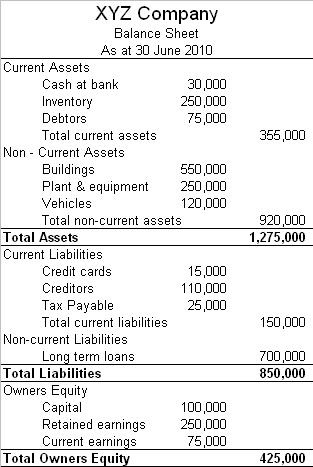
The Balance Sheet
If an error is found on a previous year’s financial statement, a correction must be made and the financials reissued.
What Items Appear On the Balance Sheet
The balance sheet lists a company’s assets, liabilities, and stockholders’ equity (including dollar amounts) as of a specific moment in time. Assets are the total resources of the business including cash, notes and accounts receivable, while liabilities are anything the company owes to someone, such as debt, mortgage or interest payments. The stockholder’s equity or just equity refers to the ownership interest in a company. The stockholder’s equity is determined by subtracting liabilities from assets.
There are two types of balance sheets, classified and unclassified.
Unclassified balance sheets have three major categories: assets, liabilities, and stockholder’s equity. The main categories of assets are usually listed first, and typically in order of liquidity (for example, cash on hand appears above accounts receivable). Liabilities are listed after assets. The difference between assets and liabilities is referred to as equity. According to the accounting equation, equity must equal assets minus liabilities. Equity is either calculated as proprietary or residual. For residual equity dividends to preferred shareholders are deducted from net income before calculating residual equity holders’ dividend per share.
A classified balance sheet has the same three major categories of assets, liabilities, and stockholder’s equity, but it breaks those categories down further to give a better idea of the profitability and strength of the company.
Who Uses a Balance Sheet
Both internal and external users use the balance sheet. The balance sheet is valuable because it shows the magnitude of the company’s financial obligations. If its debts are too high, for instance, a business may not be able to grow. The balance sheet also demonstrates how liquid the business is. An investor or business may want to ensure that the company’s resources are not overly invested in assets that cannot be easily converted into cash in case of an unexpected expense. Finally, the balance sheet shows the book value of the owners’ stake in the business. For an outside investor, this information can be especially useful in determining an appropriate price for an ownership share in the business.
1.4.2: Introduction to the Income Statement
The income statement shows revenues and expenses for a specific period.
Learning Objective
Name the two types of income statements and their purposes
Key Points
- The income statement is also referred to as a profit and loss statement (P&L), revenue statement, statement of financial performance, earnings statement, operating statement and statement of operations.
- The income statement reflects the operating performance of a business and the changes in its assets and obligations.
- The income statement represents a period of time, in contrast to the balance sheet which represents one moment in time.
- The purpose of the income statement is to show managers and investors whether the company made or lost money during the period being reported.
- The income statement is prepared on the accrual basis.
Key Terms
- revenue
-
Income that a company receives from its normal business activities, usually from the sale of goods and services to customers.
- expense
-
In accounting, an expense is money spent or costs incurred in an businesses efforts to generate revenue
- profit
-
Total income or cash flow minus expenditures. The money or other benefit a non-governmental organization or individual receives in exchange for products and services sold at an advertised price.
Overview of the Income Statement
The income statement is one of the four basic financial statements that a company prepares each accounting cycle. The income statement reflects a company’s operating performance. The income statement also shows changes in the company’s assets and obligations. The important thing to remember about an income statement is that it represents a period of time. This contrasts with the balance sheet, which represents a single moment in time. The income statement is prepared on an accrual basis.
The income statement displays the revenues recognized for a specific period, and the cost and expenses charged against these revenues, including write offs (e.g., depreciation and amortization of various assets) and taxes.
The income statement is also referred to as a “profit and loss statement” (P&L), revenue statement, statement of financial performance, earnings statement, operating statement and statement of operations.
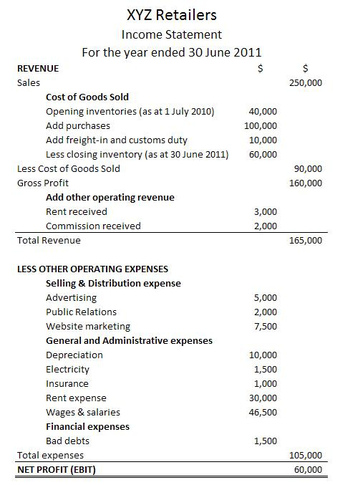
A Sample Income Statement
Expenses are listed on a company’s income statement.
Purpose of the Income Statement
The purpose of the income statement is to show managers and investors whether the company made or lost money during the period being reported.
The income statement explains how the revenue, which is money received from the sale of products and services before expenses are taken out, is transformed into the net income. Net income is what is left after all the revenues and expenses have been accounted for, it is also known as “Net Profit. “
Types of Income Statement
There are two types of income statement, a single-step income statement and a multi-step income statement. The single-step income statement takes a simpler approach, totaling revenues and subtracting expenses to find the bottom line.
The multi-step income statement is more complex. It takes several steps to find the bottom line, starting with the gross profit. It then calculates operating expenses and, when deducted from the gross profit, yields income from operations. Adding to income from operations is the difference of other revenues and other expenses. When combined with income from operations, this yields income before taxes. The final step is to deduct taxes, which finally produces the net income for the period measured.
Operating vs. Non-operating Activities
Operating income occurs from any activity that is a direct result of its primary business, such as sales of goods and services.
Non-operating income, in accounting and finance, is gains or losses from sources not related to the typical activities of the business or organization. Non-operating income can include gains or losses from investments, property or asset sales, currency exchange, and other atypical gains or losses. Non-operating income is generally not recurring and is therefore usually excluded or considered separately when evaluating performance over a period of time (e.g. a quarter or year).
1.4.3: Introduction to the Retained Earning Statement
The statement of retained earnings explains the changes in a company’s retained earnings over the reporting period.
Learning Objective
Review the items contained on the statement of shareholder’s equity
Key Points
- Retained earnings are the accumulated net income of the corporation (proprietorship or partnership) minus dividends distributed to stockholders.
- The U.S. Generally Accepted Accounting Principles require a statement of retained earnings to be prepared whenever comparative balance sheets and income statements are presented.
- The retained earnings statement may appear in the balance sheet, in a combined income statement and changes in retained earnings statement, or as a separate schedule.
- The statement of retained earnings uses information from the income statement and provides information to the balance sheet.
Key Terms
- retained earnings restrictions
-
limits on how a company may allocate net income not paid out as dividends
- retained earnings statement
-
a financial statement that breaks down changes in the owners’ interest in the organization, and in the application of retained profit or surplus from one accounting period to the next
- partnership
-
an association of two or more people to conduct a business
- equity
-
Ownership, especially in terms of net monetary value of some business.
- earnings
-
Business profits.
The Statement of Shareholder’s Equity
The Statement of Shareholder’s Equity is one of the four main financial statements prepared during a company’s accounting cycle. The Statement of Shareholder’s Equity is also known as the Equity Statement, Statement of Owner’s Equity (single proprietorship), Statement of Partner’s Equity (partnership), and Statement of Retained Earnings and Stockholders’ Equity (corporation). The U.S. Generally Accepted Accounting Principles (U.S. GAAP) requires a statement of retained earnings to be prepared whenever comparative balance sheets and income statements are presented.
What are Retained Earnings?
Generally, retained earnings are the accumulated net income of the corporation (proprietorship or partnership) minus dividends distributed to stockholders.
What Does a Statement of Shareholder’s Equity Show?
The retained earnings statement explains the changes in a company’s retained earnings over the reporting period. The statement breaks down changes in the owner’s interest in the organization, and in the application of retained profit or surplus from one accounting period to the next. Line items for the retained earnings statement typically include profits or losses from operations, dividends paid, issue or redemption of stock, and any other items charged or credited to retained earnings. . The Statement of Shareholder’s Equity shows the inflows and outflows of capital, including treasury stock purchases, employee stock options and secondary equity issuance.

The Statement of Retained Earnings and Stockholders’ Equity
The statement of retained earnings uses information from the income statement and provides information to the balance sheet.
The statement of retained earnings also shows any adjustments that were made to financial statements from prior financial periods in the current period. Adjustments are corrections or abnormal nonrecurring errors that may have been caused by an improper use of an accounting principle or by mathematical mistakes. Normal recurring corrections and adjustments that follow inevitably from the use of estimates in accounting practice, are not prior period adjustments and are not included in the retained earning statement.
Comprehensive income is the sum of net income and other items that must bypass the income statement because they have not been realized, including items like an unrealized holding gain or loss from available for sale securities and foreign currency translation gains or losses. These items are not part of net income, yet are important enough to be included in comprehensive income, giving the user a bigger, more comprehensive picture of the organization as a whole.Items included in comprehensive income, but not net income are reported under the accumulated other comprehensive income section of shareholder’s equity.
Where Does the Shareholder’s Equity Statement Appear?
The retained earnings statement may appear in the balance sheet, in a combined income statement and changes in retained earnings statement, or as a separate schedule. The statement of shareholder’s equity uses information from the income statement and provides information to the balance sheet. Retained earnings are part of the balance sheet under Stockholders Equity (Shareholders Equity) and are mostly affected by net income earned by the company during a specified period, less any dividends paid to the company’s owners/stockholders. The retained earnings account on the balance sheet represents an accumulation of earnings since net profits and losses are added/subtracted from the account from period to period. Retained Earnings are part of the Statement of Changes in Equity and are a component of shareholder’s equity.
The general equation can be expressed as follows:
Ending Retained Earnings = Beginning Retained Earnings − Dividends Paid + Net Income.
1.4.4: Introduction to the Statement of Cash Flows
The cash flow statement provides information on a firm’s liquidity and solvency.
Learning Objective
Describe the effect operating, investing and financing activities have on the statement of cash flows, and how that statement differs from the income statement
Key Points
- The cash flow statement is intended to provide information on a firm’s liquidity and solvency.
- The money coming into the business is called cash inflow, and money going out from the business is called cash outflow. To show the affects on the inflows and outflows on a company, a statement of cash flow is used.
- The cash flow statement includes only inflows and outflows of cash and cash equivalents.
- Potential lenders or creditors use the statement of cash flows to determine a company’s ability to repay the funds.
Key Terms
- solvency
-
The state of having enough funds or liquid assets to pay all of one’s debts; the state of being solvent.
- write-off
-
The cancellation of an item; the amount cancelled or lost.
- non-current asset
-
Another term for fixed asset; term used in accounting for assets and property which cannot easily be converted into cash.
- statement of cash flows
-
a financial document that shows how changes in balance sheet accounts and income affect cash and cash equivalents, and breaks the analysis down to operating, investing, and financing activities
- solvency ratio
-
the size of a company’s capital relative to net premium written
Overview of a Statement of Cash Flows
The money coming into the business is called cash inflow, and money going out from the business is called cash outflow. To show the affects on the inflows and outflows on a company, a statement of cash flow is used. The statement of cash flows is a cash basis report on three types of financial activities: operating activities, investing activities, and financing activities. Any non-cash activities are usually reported in footnotes.
Purpose of a Statement of Cash Flows
The cash flow statement is intended to provide information on a firm’s liquidity and solvency. The statement of cash flows show the company’s ability to change cash flows in future circumstances. The statement of cash flows also reconciles the cash balance from one balance sheet to the next. It provides additional information for evaluating changes in assets, liabilities and equity . The statement of cash flows makes it easier to compare different companies, because it eliminates allocations (such as depreciation). In essence, it helps assess how well the expected payments are being realized as cash.
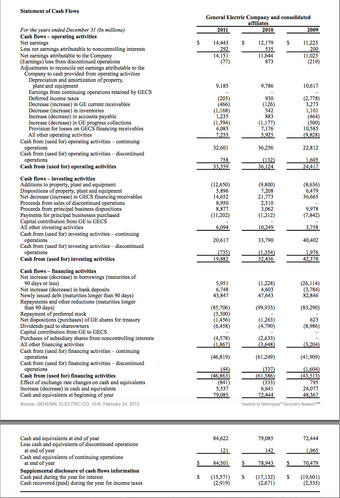
Statement of Cash Flows
The statement of cash flows shows the liquidity of a company.
Contrasting
Income
Statement to the Statement of Cash Flows
The income statement is accrual based. It shows net income, which is calculated as follows: revenues earned minus the expenses incurred in order to earn those revenues. For example, a company earns revenues in April, but allows customers 30 days to pay, so the cash from April sales will not be received until May.The same for expenses, while inventory bought in April might not sell until May, the inventory was bought and paid for in April.
The statement of cash flows is cash based and it shows the actual inflows and outflows of cash for the given month.
Items on the Statement of Cash Flows
The cash flow statement includes only inflows and outflows of cash and cash equivalents. The statement of cash flows excludes transactions that do not directly affect cash receipts and payments. These non-cash transactions include depreciation or write-offs on bad debts or credit losses. The Statement of Cash Flows is composed of three sections:
- Operating Activities. These include the cash inflows and outflows of all transactions related to core activities of the business.
- Investing Activities. Investing activities include all transactions related to the acquisition or disposal of non-current assets. Non-current assets is another term for fixed assets, which includes all property that cannot be easily converted to cash. It also can refer to investments in other companies.
- Financing Activities. Financing activities includes all transactions related to changes in the amount of a business’s equity available for sale or the amount of the business’s outstanding debt, with the exception of interest payments.
Users of a Statement of Cash Flows
- Accounting personnel, who need to know whether the organization will be able to cover payroll and other immediate expenses
- Potential investors, who need to judge whether the company is financially sound
- Potential employees or contractors, who need to know whether the company will be able to afford compensation
- Shareholder’s of the business
1.4.5: Relationships Between Statements
The four main financial statements provide relevant financial information for internal and external users.
Learning Objective
Recognize the difference between the four common financial statements and explain their relationship to one another
Key Points
- Each statement has a specific purpose. The balance sheet reflects a company’s solvency and financial position, and the statement of cash flows shows the cash inflows and outflows for a company over a period of time.
- The income statement reflects a company’s profitability and specifically, net income reconciles the beginning (prior ending period) balance sheet to the current balance sheet.
- The statement of shareholder’s equity shows the change in retained earnings between the beginning and end of a period (e.g., a month or a year) and it reconciles changes in the equity accounts (contributed capital, other capital, treasury stock) from the beginning to the ending balance sheet.
- The balance sheet reflects a company’s solvency and financial position.
- The statement of cash flows shows the cash inflows and outflows for a company over a period of time.
Key Terms
- earnings
-
Business profits.
- retained earnings
-
Retained earnings are the portion of net income that is retained by the corporation rather than distributed to its owners as dividends.
- profitability
-
The capacity to make a profit.
The Purpose of Financial Statements
At the end of each accounting cycle, a company prepares financial statements. The purpose is to provide relevant financial information for both internal and external users.
The four most common financial statements are the balance sheet, income statement, statement of cash flows and the statement of stockholder’s equity.
Each statement has a specific purpose; the income statement reflects a company’s profitability, while the statement of retained earnings shows the change in retained earnings between the beginning and end of a period (e.g., a month or a year). The balance sheet reflects a company’s solvency and financial position and the statement of cash flows shows the cash inflows and outflows for a company over a period of time.
Together these four statements show the profitability and strength of a company.

Financial Statements
The financials statements show a company’s profitability.
How the Statements Are Interconnected
The income statement reports the profitability of a business by comparing the revenues earned with the expenses incurred to produce these revenues. If revenue exceeds expenses for the period then a net income occurs. If expenses exceed revenue then a net loss is the result. The income statement, specifically, net income reconciles the beginning (prior ending period) balance sheet to the current balance sheet.
The statement of shareholder’s equity connects the income statement and the balance sheet. The statement of shareholder’s equity explains the changes in retained earnings between two balance sheet dates. These changes usually consist of the addition of net income (or deduction of net loss) and the deduction of dividends. The statement of shareholder’s equity reconciles changes in the equity accounts (contributed capital, other capital, treasury stock) from the beginning to the ending balance sheet.
The balance sheet, sometimes called the “statement of financial position,” lists the company’s assets, liabilities, and stockholders’ equity (including dollar amounts) as of a specific moment in time (usually the close of business on the date of the balance sheet).
The balance sheet is like a photograph; it captures the financial position of a company at a particular point in time, which is different from the other two statements, which show changes for a period of time.
Management is interested in the cash inflows to the company and cash outflows from the company, because these determine the cash the company has available to pay its bills when they are due.
The statement of cash flows shows the cash inflows and cash outflows from operating, investing, and financing activities. The statement of cash flows reconciles changes in the cash account from the beginning to the ending balance sheet. Operating activities generally include the cash effects of transactions and other events that enter into the determination of net income.
Clean Surplus vs. Dirty Surplus
A clean surplus occurs when all changes in the balance sheet are reconciled by the income statement. US GAAP doesn’t have a clean surplus because some items that affect balance sheet accounts don’t come through the income statement. Instead, there is said to be a dirty surplus. That is, the net change in the balance sheet accounts will not equal net income. The difference is comprehensive income. Comprehensive income is reported on the statement of changes in shareholder’s equity.
1.4.6: Financial Statement Notes
Financial statement notes explain specific items in the financial statements.
Learning Objective
Describe why a company would use financial statement notes
Key Points
- Notes to financial statements can include information on debt, going concern criteria, accounts, contingent liabilities, or contextual information explaining the financial numbers (for example, if the company is facing a lawsuit).
- These notes help explain specific items in the financial statements. They also provide a more comprehensive assessment of a company’s financial condition.
- The notes clarify individual statement line-items.
Key Terms
- contingent
-
An event which may or may not happen; that which is unforeseen, undetermined, or dependent on something future; a contingency.
- disclosure
-
The act of revealing something.
Financial Statement Notes
The goal of the financial statements is to convey the financial information about a company in an easy to understand format. While the Income Statement, Balance Sheet, Cash Flow Statement, and Statement of Retained Earning contain all numeric information about the company, these numbers often require a better explanation. So, additional supporting financial data is added in the Financial Statement Notes section. . Including notes to the financial statement is not optional, it is a reporting requirement.
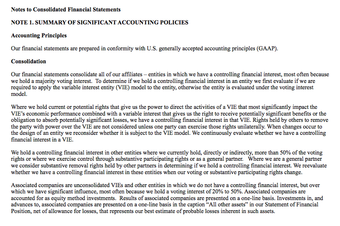
GE Financial Statement
Notes on the financial statements convey specific information about the line-items on the statement.
Where the Notes are Located
Notes to financial statements are added to the end of financial statements. These notes help explain specific items in the financial statements. They also provide a more comprehensive assessment of a company’s financial condition.
Items Included in the Financial Statement Notes
Notes to financial statements can include information and supporting data on debt, going concern criteria, accounts, contingent liabilities, or contextual information explaining the financial numbers (for example, if the company is facing a lawsuit).
The Purpose of Financial Statement Notes
The notes clarify individual line items on the various statements. For example, if a company lists a loss on a fixed asset impairment line in their income statement, notes could corroborate the reason for the impairment by describing how the asset became impaired. Notes can also explain the accounting methods used to prepare the statements. The notes support valuations for how particular accounts have been computed. In consolidated financial statements, all subsidiaries are listed as well as the amount of ownership (controlling interest) that the parent company has in the subsidiaries. Any items within the financial statements that are valuated by estimation are part of the notes if a substantial difference exists between the amount of the estimate previously reported and the actual result. Full disclosure of the effects of the differences between the estimate and actual results should be included.
1.4.7: Additional Items: Auditor and Management Reports
When an audit is performed on a company, the auditor issues a formal opinion in the form of an auditor report.
Learning Objective
State how qualified opinion, unqualified opinion, adverse and disclaimer opinion reports differ from one another
Key Points
- The auditor report helps readers make a more informed decision about the company based on its results.
- There are four types of auditor reports: qualified opinion reports, unqualified opinion reports, adverse opinion reports, and disclaimer of opinion reports.
- An adverse opinion is issued when the auditor determines that the financial statements of an auditee are materially misstated and, when considered as a whole, do not conform with GAAP.
- An opinion is unqualified when the auditor concludes that the financial statements give a true and fair view in accordance with the financial reporting framework used for their preparation and presentation.
- A qualified opinion report is issued when the auditor encounters one of two types of situations. While these specific situations do not comply with generally accepted accounting principles, the rest of the financial statements are fairly presented.
- A disclaimer of opinion, also referred to as a disclaimer, occurs when the auditor could not form, and consequently refuses to present, an opinion on the financial statements.
Key Terms
- unqualified
-
Not elaborated upon, undescribed.
- auditor
-
One who audits bookkeeping accounts.
Auditor Reports
If a company has an audit performed, whether by an internal auditor or an outside auditor, the auditor issues a formal opinion. This opinion takes the form on an auditor report . The auditor report is available for use by any individual, group, company, or government to review. The auditor report helps readers make a more informed decision about the company based on its results. Please note that the Securities and Exchange Commission requires an audit by an outside auditor. The notes to the financials statement must include a reference to this report.

Auditor and Management Reports
Auditor reports stem from an internal or external audit of the company’s financial statements.
The Purpose Of the Auditor Reports
In business, the auditor report is consider an essential component of the financial statements. Since many third-party users prefer, or even require financial information to be certified by an independent external auditor, many companies rely on auditor reports to certify their information to attract investors, obtain loans, and improve public appearance.
Types Of Auditor Reports
There are four types of auditor reports:
- Qualified opinion report
- Unqualified opinion report
- Adverse opinion report
- Disclaimer of opinion report
Qualified Opinion Report
A qualified opinion report is issued when the auditor encounters one of two types of situations. While these specific situations do not comply with generally accepted accounting principles, the rest of the financial statements are fairly presented. The two types of situations that result in a qualified opinion report are a single deviation from generally accepted accounting principles (GAAP) and limitation of scope.
A deviation from generally accepted accounting principles occurs when one or more areas of the financial statements do not conform to GAAP. These misstated items do not affect the rest of the financial statements from being fairly presented when taken as a whole. An example of GAAP is incorrectly calculating depreciation.
Limitation of scope occurs when the auditor could not audit one or more areas of the financial statements, and although they could not be verified, the rest of the financial statements were audited and they conform to GAAP. For example, if the auditor cannot observe and test the company’s inventory, but audited the rest of the statements and found them in accordance with GAAP, then the report is said to be limited in scope.
Unqualified Report
An opinion is unqualified when the auditor concludes that the financial statements give a true and fair view in accordance with the financial reporting framework used for their preparation and presentation. An auditor issues this report when the financial statements presented are free of material misstatements and are represented fairly in accordance with GAAP. An unqualified report is the best type of report a company can receive from an external auditor.
Adverse Opinion Report
An adverse opinion is issued when the auditor determines that the financial statements of an auditee are materially misstated and, when considered as a whole, do not conform to GAAP.
It is considered the opposite of an unqualified or clean opinion, essentially stating that the information contained is materially incorrect, unreliable, and inaccurate.
Disclaimer Of Opinion Report
A disclaimer of opinion, also referred to as a disclaimer, occurs when the auditor could not form, and consequently refuses to present, an opinion on the financial statements. This type of report is issued when the auditor tried to audit an entity but could not complete the work due to various reasons. Although this type of opinion is rarely used, they may be used when the auditee willfully hides or refuses to provide evidence and information to the auditor in significant areas of the financial statements.
1.5: Conventions and Standards
1.5.1: Standard-Setting Groups: SEC, AICPA, and FASB
The SEC enforces and regulates security laws, the AICPA dictates the professional conduct of accountants, and the FASB develops GAAP.
Learning Objective
Differentiate between the SEC, the AICPA and the FASB
Key Points
- The Financial Accounting Standards Board (FASB) is a private, not-for-profit organization whose primary purpose is to develop generally accepted accounting principles (GAAP) within the United States in the public’s interest.
- Founded in 1887, the AICPA is a professional organization of Certified Public Accountants (CPAs) in the United States. The AICPA has nearly 386,000 CPA members in 128 countries in business and industry, public practice, government, education, student affiliates and international associates.
- The US SEC is a federal agency which holds primary responsibility for enforcing the federal securities laws and regulating the securities industry, the nation’s stock and options exchanges, and other electronic securities markets in the United States.
Key Terms
- FASB
-
The Financial Accounting Standards Board (FASB) is a private, not-for-profit organization whose primary purpose is to developgenerally accepted accounting principles (GAAP) within the United States in the public’s interest.
- Securities and Exchange Commission
-
an agency responsible for enforcing the federal securities laws and regulating the securities industry, the nation’s stock and options exchanges, and other electronic securities markets in the United States.
The Financial Accounting Standards Board (FASB)
The Financial Accounting Standards Board (FASB) is a private, not-for-profit organization whose primary purpose is to develop generally accepted accounting principles (GAAP) within the United States in the public’s interest.
Under the direction of the SEC the Committee on Accounting Procedure was created by the AICPA in 1939. It was the first private sector organization that had the task of setting accounting standards in the United States. In 1959, the Accounting Principles Board (APB) was formed to meet the demand for more structured accounting standards. The APB issued pronouncements on accounting principles until 1973, when it was replaced by the Financial Accounting Standards Board (FASB). The APB was disbanded in the hopes that the smaller, fully independent FASB could more effectively create accounting standards. The APB and the related Securities Exchange Commission were unable to operate completely independently of the U.S. government
The FASB’s mission is “to establish and improve standards of financial accounting and reporting for the guidance and education of the public, including issuers, auditors, and users of financial information. “
To achieve this, FASB has five goals:
- Improve the usefulness of financial reporting by focusing on the primary characteristics of relevance, reliability, comparability, and consistency.
- Keep standards current to reflect changes in methods of doing business and in the economy.
- Consider promptly any significant areas of deficiency in financial reporting that might be improved through standard setting.
- Promote international convergence of accounting standards concurrent with improving the quality of financial reporting.
- Improve common understanding of the nature and purposes of information in financial reports.
The FASB sets standards based on their conceptual framework. In addition, they offer guidance on how to implement these standards, but they do not monitor companies for violations of the financial reporting standards. That is left to the Securities and Exchange Commission.
The US Securities and Exchange Commission (SEC)
The Seal of the SEC
Seal of the U.S. Securities and Exchange Commission.
The U.S. Securities and Exchange Commission (SEC) is a federal agency which holds primary responsibility for enforcing the federal securities laws and regulating the securities industry, the nation’s stock and options exchanges, and other electronic securities markets in the United States. The SEC was created by Section 4 of the Securities Exchange Act of 1934 (now codified as 15 U.S.C. § 78d and commonly referred to as the 1934 Act).
Overview
The SEC was established by United States President Franklin D. Roosevelt in 1934 as an independent, quasi-judicial regulatory agency during the Great Depression. The main reason for the creation of the SEC was to regulate the stock market and prevent corporate abuses relating to the offering and sale of securities and corporate reporting. The SEC was given the power to license and regulate stock exchanges, the companies whose securities were traded on exchanges, and the brokers and dealers who conducted the trading.
Currently, the SEC is
responsible for administering seven major laws that govern the securities industry:
- The Securities Act of 1933
- The Securities Exchange Act of 1934
- The Trust Indenture Act of 1939
- The Investment Company Act of 1940
- The Investment Advisers Act of 1940
- The Sarbanes–Oxley Act of 2002
- The Credit Rating Agency Reform Act of 2006.
The enforcement authority given by Congress allows the SEC to bring civil enforcement actions against individuals or companies alleged to have committed accounting fraud, provided false information, or engaged in insider trading or other violations of the securities law. The SEC also works with criminal law enforcement agencies to prosecute individuals and companies alike for offenses which include a criminal violation.
To achieve its mandate, the SEC enforces the statutory requirement that public companies submit periodic reports. Quarterly and bi-annual reports from public companies are crucial for investors to make sound decisions in the capital markets.
The American Institute of Certified Public Accountants

AICPA Offices
The offices of the American Institute of Certified Public Accountants (AICPA) at Palladian Office Park (220 Leigh Farm Road) in Durham, North Carolina.
Founded in 1887, the American Institute of Certified Public Accountants (AICPA) is the national professional organization of Certified Public Accountants (CPAs) in the United States. The AICPA has nearly 386,000 CPA members in 128 countries in business and industry, public practice, government, education, student affiliates and international associates. It sets ethical standards for the profession and U.S. auditing standards for audits of private companies, non-profit organizations, federal, state and local governments. It also develops and grades the Uniform CPA Examination.
The AICPA’s founding established accountancy as a profession distinguished by rigorous educational requirements, high professional standards, a strict code of professional ethics, and a commitment to serving the public interest. While the AICPA set the professional standards for the professional conduct of accountants, it plays no role in setting the standards for financial accounting.
1.5.2: Introduction to GAAP
Generally Accepted Accounting Principles (GAAP) is the standard framework for financial accounting used in any given jurisdiction.
Learning Objective
Differentiate between GAAP constraints, assumptions and principles, and the role they play in the preparation of financial statements
Key Points
- GAAP includes the standards, conventions, and rules accountants follow in recording and summarizing, and in the preparation of financial statements.
- GAAP is a codification of how CPA firms and businesses prepare and present their business income and expense, assets and liabilities in their financial statements.
- GAAP is not a single accounting rule, but rather an aggregate of many rules on how to account for various transactions.
- GAAP has four basic objectives, assumptions, principles, and constraints.
- GAAP has four basic objectives, assumptions, principles, and constraints.
Key Terms
- generally accepted accounting principles
-
US rules used to prepare, present and report financial statements
- materiality
-
Materiality is a concept or convention within auditing and accounting relating to the importance/significance of an amount, transaction, or discrepancy. The assessment of what is material is a matter of professional judgment.
- accrual
-
A charge incurred in one accounting period that has not been paid by the end of it.
Generally Accepted Accounting Principles
Generally Accepted Accounting Principles (GAAP) refer to the standard framework of guidelines for financial accounting used in any given jurisdiction; generally known as accounting standards. GAAP includes the standards, conventions, and rules accountants follow in recording and summarizing accounting transactions, and in the preparation of financial statements.
GAAP is a codification of how CPA firms and corporations prepare and present their business income and expense, assets and liabilities in their financial statements. GAAP is not a single accounting rule, but rather an aggregate of many rules on how to account for various transactions. .

GAAP vs. IFRS Cash Flow Classification
This image demonstrates the differences in accounting standards between GAAP and IFRS regarding classifying cash flows.
Introduction to U.S. GAAP
Like many other common law countries, the United States government does not directly set accounting standards by statute. However, the U.S. Securities and Exchange Commission (SEC) requires that US GAAP be followed in financial reporting by publicly traded companies. Currently, the Financial Accounting Standards Board (FASB) establishes generally accepted accounting principles for public and private companies, as well as for non-profit organizations.
History
Historically, accounting standards have been set by the American Institute of Certified Public Accountants (AICPA) subject to Securities and Exchange Commission regulations. The AICPA first created the Committee on Accounting Procedure in 1939, and replaced it with the Accounting Principles Board in 1951.
In 1973, the Accounting Principles Board was replaced by the FASB under the supervision of the Financial Accounting Foundation with the Financial Accounting Standards Advisory Council serving to advise and provide input on the accounting standards.
Circa 2008, the FASB issued the FASB Accounting Standards Codification, which reorganized the thousands of US GAAP pronouncements into roughly 90 accounting topics. In 2008, the SEC issued a preliminary “roadmap” that may lead the U.S. to abandon GAAP in the future and to join more than 100 countries around the world already using the London-based IFRS.
As of 2010, the convergence project was underway with the FASB meeting routinely with the IASB. The SEC expressed its resolve to fully adopt IFRS in the U.S. by 2014. As the highest authority over IFRS, the IASB is becoming more important in the U.S.
Basic Objectives
Financial reporting should provide information that is:
- Useful to present to potential investors and creditors and other users in making rational investment, credit, and other financial decisions.
- Helpful to present to potential investors and creditors and other users in assessing the amounts, timing, and uncertainty of prospective cash receipts.
- About economic resources, the claims to those resources, and the changes in them.helpful for making financial decisions.
- Helpful in making long-term decisions.
- Helpful in improving the performance of the business.
- Useful in maintaining records.
Four Basic Assumptions
- Accounting Entity: assumes that the business is separate from its owners or other businesses. Revenue and expense should be kept separate from personal expenses.
- Going Concern: assumes that the business will be in operation indefinitely. This validates the methods of asset capitalization, depreciation, and amortization. In cases when liquidation is certain, this assumption is not applicable. The business will continue to exist in the unforeseeable future.
- Monetary Unit Principle: assumes a stable currency is going to be the unit of record. The FASB accepts the nominal value of the US Dollar as the monetary unit of record unadjusted for inflation. This is also know at the stable dollar principle.
- Time-period Principle: implies that the economic activities of an enterprise can be divided into artificial time periods.
Four Basic Principles
- Historical Cost Principle: requires companies to account and report based on acquisition costs rather than fair market value for most assets and liabilities.
- Revenue Recognition Principle: requires companies to record when revenue is (1) realized or realizable and (2) earned, not when cash is received. Also, under this principle a company should establish an allowance for bad debt account. This way of accounting is called accrual based accounting.
- Matching Principle: Expenses have to be matched with revenues as long as it is reasonable to do so. Expenses are recognized not when the work is performed, or when a product is produced, but when the work or the product actually makes its contribution to revenue. Only if no connection with revenue can be established, cost may be charged as expenses to the current period (e.g. office salaries and other administrative expenses).
- Full Disclosure Principle: Amount and kinds of information disclosed should be decided based on trade-off analysis as a larger amount of information costs more to prepare and use. Information disclosed should be enough to make a judgment while keeping costs reasonable. Information is presented in the main body of financial statements, in the notes or as supplementary information.
Please note: Historical cost and the matching principle are slowly disappearing, having been replaced by FASB No. 157 which requires companies to classify assets based on fair value.
Five Basic Constraints
- Objectivity principle: the company financial statements provided by the accountants should be based on objective evidence.
- Materiality principle: the significance of an item should be considered when it is reported.
- Consistency principle: the company uses the same accounting principles and methods from year to year.
- Conservatism principle: when choosing between two solutions, the one that will be least likely to overstate assets and income should be picked.
- Cost-Benefit Relationship: the company considers the costs necessary to prepare the information and what benefit users will get from it.
1.5.3: Introduction to IFRS
The IFRS is a common global financial language for business affairs that is understandable and comparable across international boundaries.
Learning Objective
Discuss the purpose of the International Financial Reporting Standards (IFRS)
Key Points
- The IFRS began as an attempt to harmonize accounting across the European Union, but the value of harmonization quickly made the concept attractive around the world.
- The Conceptual Framework for Financial Reporting states the basic principles for the IFRS.
- The IFRS defines the objective of financial reporting as reflecting an accurate view of the business affairs of the organization.
- The IFRS sets forth three basic accounting models and underlying assumptions of financial reporting.
Key Terms
- reliable
-
Suitable or fit to be relied on; worthy of dependence or reliance; trustworthy.
- framework
-
A basic conceptual structure.
- deflation
-
An economic contraction.
An International Standard
Many countries use or are moving towards using the International Financial Reporting Standards (IFRS), which were established and maintained by the International Accounting Standards Board (IASB). In some countries, local accounting principles are applied for regular companies, but listed or larger companies must conform to the IFRS, so statutory reporting is comparable internationally, across jurisdictions .

IFRS in Developing Countries
A map of developing countries, without the least advanced countries and the failed countries.
The IFRS: History and Purpose
The IFRS is designed as a common global language for business affairs so that company accounts are understandable and comparable across international boundaries. They are a consequence of growing international shareholding and trade. The IFRS is particularly important for companies that have dealings in several countries. They are progressively replacing the many different national accounting standards.
The IFRS began as an attempt to harmonize accounting across the European Union, but the value of harmonization quickly made the concept attractive around the world. They are occasionally called by the original name of International Accounting Standards (IAS). The IAS were issued between 1973 and 2001 by the Board of the International Accounting Standards Committee (IASC). On April 1, 2001, the new IASB took over the responsibility for setting International Accounting Standards from the IASC. During its first meeting the new Board adopted existing IAS and Standing Interpretations Committee standards (SICs). The IASB has continued to develop standards calling the new standards the IFRS.
Framework
The Conceptual Framework for Financial Reporting states the basic principles for IFRS. The IASB and FASB frameworks are in the process of being updated and converged. The Joint Conceptual Framework project intends to update and refine the existing concepts to reflect the changes in markets and business practices. The project also intends consider the changes in the economic environment that have occurred in the two or more decades since the concepts were first developed.
Deloitte states:
In the absence of a Standard or an Interpretation that specifically applies to a transaction,
management
must use its judgment in developing and applying an accounting policy that results in information that is relevant and
reliable
. In making that judgment, IAS 8.11 requires management to consider the definitions,
recognition
criteria, and measurement concepts for
assets
,
liabilities
,
income
, and
expenses
in the Framework. This elevation of the importance of the Framework was added in the 2003 revisions to IAS 8.
IFRS Defined Objective of Financial Statements
A financial statement should reflect true and fair view of the business affairs of the organization. As these statements are used by various constituents of the society/regulators, they need to reflect an accurate view of the financial position of the organization. It is very helpful to check the financial position of the business for a specific period.
Three Basic Accounting Models
- Current Cost Accounting, under Physical Capital Maintenance at all levels of inflation and deflation under the Historical Cost paradigm as well as the Capital Maintenance in Units of Constant Purchasing Power paradigm
- Financial capital maintenance in nominal monetary units, i.e., globally implemented Historical cost accounting during low inflation and deflation only under the traditional Historical Cost paradigm
- Financial capital maintenance in units of constant purchasing power, i.e., Constant Item Purchasing Power Accounting – CIPPA – in terms of a Daily Consumer Price Index or daily rate at all levels of inflation and deflation under the Capital Maintenance in Units of Constant Purchasing Power paradigm and Constant Purchasing Power Accounting – CPPA – during hyperinflation under the Historical Cost paradigm.
Three Underlying Assumptions
- Going concern: for the foreseeable future an entity will continue under the Historical Cost paradigm as well as under the Capital Maintenance in Units of Constant Purchasing Power paradigm
- Stable measuring unit assumption: financial capital maintenance in nominal monetary units or traditional Historical cost accounting only under the traditional Historical Cost paradigm.
- Units of constant purchasing power: capital maintenance in units of constant purchasing power at all levels of inflation and deflation in terms of a Daily Consumer Price Index or daily rate only under the Capital Maintenance in Units of Constant Purchasing Power paradigm.
1.5.4: Differences Between GAAP and IFRS and Implications of Potential Convergence
A major difference between GAAP and IFRS is that GAAP is rule-based, whereas IFRS is principle-based.
Learning Objective
State the difference between Generally Accepted Accounting Principles and International Financial Reporting Standards
Key Points
- Another difference between IFRS and GAAP is the methodology used to assess an accounting treatment. Under GAAP, the research is more focused on the literature whereas under IFRS, the review of the facts pattern is more thorough.
- The convergence of accounting standards refers to the goal of establishing a single set of accounting standards that will be used internationally to reduce the differences between US GAAP and IFRS.
- Convergence is also taking place in other countries, with “all major economies” planning to either adopt the IFRS or converge towards it, “in the near future”.
Key Term
- convergence
-
The act of moving toward union or uniformity.
GAAP vs. IFRS
Principles Based vs. Rules Based
A major difference between GAAP and IFRS is that GAAP is rule-based, whereas IFRS is principle-based.
With a principle based framework there is the potential for different interpretations of similar transactions, which could lead to extensive disclosures in the financial statements. Although, the standards setting board in a principle-based system can clarify areas that are unclear. This could lead to fewer exceptions than a rules-based system.
Another difference between IFRS and GAAP is the methodology used to assess an accounting treatment. Under GAAP, the research is more focused on the literature whereas under IFRS, the review of the facts pattern is more thorough.
Some Examples of Differences Between IFRS and U.S. GAAP
- Consolidation — IFRS favors a control model whereas GAAP prefers a risks-and-rewards model. Some entities consolidated in accordance with FIN 46(R) may have to be shown separately under IFRS.
- Statement of Income — Under IFRS, extraordinary items are not segregated in the income statement. With GAAP, they are shown below the net income.
- Inventory — Under IFRS, LIFO cannot be used, but GAAP, companies have the choice between LIFO and FIFO.
- Earning-per-Share — Under IFRS, the earning-per-share calculation does not average the individual interim period calculations, whereas under GAAP the computation averages the individual interim period incremental shares.
- Development costs — These costs can be capitalized under IFRS if certain criteria are met, while it is considered as “expenses” under U.S. GAAP.
Convergence
The convergence of accounting standards refers to the goal of establishing a single set of accounting standards that will be used internationally, and in particular the effort to reduce the differences between the US Generally Accepted Accounting Principles (US GAAP), and the International Financial Reporting Standards (IFRS). Convergence in some form has been taking place for several decades, and efforts today include projects that aim to reduce the differences between accounting standards.
The goal of and various proposed steps to achieve convergence of accounting standards has been criticized by various individuals and organizations. For example, in 2006 senior partners at PricewaterhouseCoopers (PwC) called for convergence to be “shelved indefinitely” in a draft paper, calling for the IASB to focus instead on improving its own set of standards.
Convergence is also taking place in other countries, with “all major economies” planning to either adopt the IFRS or converge towards it, “in the near future. ” For example, Canada required all listed entities to use the IFRS from January 1, 2012, and Japan permitted the use of IFRS for certain multinational companies from 2010, and is expected to make a decision on mandatory adoption in “around 2012. “
The Globe
IFRS is Global
Implications of Potential Convergence
The growing acceptance of International Financial Reporting Standards (IFRS) as a basis for U.S.financial reporting represents a fundamental change for the U.S. accounting profession. Today, approximately 113 countries require or allow the use of IFRS for the preparation of financial statements by publicly held companies. In the United States, the Securities and Exchange Commission (SEC) has been taking steps to set a date to allow U.S. public companies to use IFRS,and perhaps make its adoption mandatory.
1.5.5: Full-Disclosure Principle
The full disclosure principle states information important enough to influence decisions of an informed user should be disclosed.
Learning Objective
Indicate how the full disclosure principle affects the financial statements
Key Points
- In judging whether or not to disclose information, it is better to err on the side of too much disclosure rather than too little.
- Depending on its nature, companies should disclose this information either in the financial statements, in notes to the financial statements, or in supplemental statements.
- As an accountant, the full disclosure principle is important because the notes to the financial statements and other financial documents are subject to audit.
- There is adequate disclosure of all material matters relevant to the proper presentation of the financial information subject to statutory requirements, where applicable.
Key Terms
- full disclosure principle
-
amount and kinds of information disclosed should be decided based on trade-off analysis, and information disclosed should be enough to make a judgment while keeping costs reasonable
- disclosure
-
The act of revealing something.
Principle of Full Disclosure
The full disclosure principle states that information important enough to influence the decisions of an informed user of the financial statements should be disclosed. Depending on its nature, companies should disclose this information either in the financial statements, in notes to the financial statements, or in supplemental statements. In judging whether or not to disclose information, it is better to err on the side of too much disclosure rather than too little. Many lawsuits against CPAs and their clients have resulted from inadequate or misleading disclosure of the underlying facts. A good rule to follow is—if in doubt, disclose. Another good rule is—if you are not consistent, disclose all the facts and the effect on income.
To be free from bias, information must be sufficiently complete to ensure that it validly represents underlying events and conditions. Completeness means disclosing all significant information in a way that aids understanding and does not mislead. Firms can reduce the relevance of information by omitting information that would make a difference to users.
Required disclosures may be made in (1) the body of the financial statements, (2) the notes to such statements, (3) special communications, and/or (4) the president’s letter or other management reports in the annual report. Another aspect of completeness is fully disclosing all changes in accounting principles and their effects.
Importance of Full Disclosure Principle: Subject to Audit
As an accountant, the full disclosure principle is important because the notes to the financial statements and other financial documents are subject to audit. To obtain an unqualified (or clean) opinion, one must have an intrinsic understanding of the full disclosure principle to insure sufficient information for an unqualified opinion on the financial audit.
An opinion is said to be unqualified when the auditor concludes that the financial statements give a true and fair view in accordance with the financial reporting framework used for the preparation and presentation of the financial statements. An auditor gives a clean opinion or unqualified opinion when he or she does not have any significant reservation in respect of matters contained in the financial statements.
An unqualified opinion is given when:
- The financial statements have been prepared using the generally accepted accounting principles which have been consistently applied;
- There is adequate disclosure of all material matters relevant to the proper presentation of the financial information subject to statutory requirements, where applicable;
- Any changes in the accounting principles or in the method of their application and the effects thereof have been properly determined and disclosed in the financial statements.
1.5.6: The Disclosure Process
The process of disclosing financial statements is carried out through what is known as a Form 10-K.
Learning Objective
Define and outline the annual report known as a Form 10-K.
Key Points
- A Form 10-K is an annual report required by the U.S. Securities and Exchange Commission (SEC) that gives a comprehensive summary of a company’s performance.
- The 10-K includes information such as company history, organizational structure, executive compensation, equity, subsidiaries, and audited financial statements, among other information.
- In addition to the 10-K, which is filed annually, a company is also required to file quarterly reports on Form 10-Q.
- In the case of a significant event (such as a CEO departing or bankruptcy) a Form 8-K must be filed in order to provide up-to-date information.
- A Form 10-K must be filed with the SEC within 90 days after the end of the company’s fiscal year. However, in September 2002, the SEC approved a rule that changed the deadline to 75 days for “accelerated filers”.
- Every annual report contains 4 parts and 15 schedules.
Key Terms
- Form 10-K
-
an annual report required by the U.S. Securities and Exchange Commission (SEC) that gives a comprehensive summary of a company’s performance
- accelerated filer
-
an issuer that has a public float of at least $75 million, has been subject to the Exchange Act’s reporting requirements for at least 12 calendar months, has previously filed at least one annual report, and is not eligible to file its quarterly and annual reports on Forms 10-QSB and 10-KSB
Example
- Example of Disclosures of Contingencies: “A jury awarded USD 5.2 million to a former employee of the Company for an alleged breach of contract and wrongful termination of employment. The Company has appealed the judgment on the basis of errors in the judge’s instructions to the jury and insufficiency of evidence to support the amount of the jury’s award. The Company is vigorously pursuing the appeal. Since it presently is not possible to determine the outcome of these matters, no provision has been made in the financial statements for their ultimate resolution. The resolution of the appeal of the jury award could have a significant effect on the Company’s earnings in the year that a determination is made. However, in management’s opinion, the final resolution of all legal matters will not have a material adverse effect on the Company’s financial position. “
The process of disclosing financial statements is carried out through what is known as a Form 10-K. This is an annual report required by the U.S. Securities and Exchange Commission (SEC) that gives a comprehensive summary of a company’s performance. Although similarly named, the annual report on Form 10-K is distinct from the often glossy “annual report to shareholders,” which a company must send to its shareholders when it holds an annual meeting to elect directors (though some companies combine the annual report and the 10-K into one document). The 10-K includes information such as company history, organizational structure, executive compensation, equity, subsidiaries, and audited financial statements, among other information.
In addition to the 10-K, which is filed annually, a company is also required to file quarterly reports on Form 10-Q. Information for the final quarter of a firm’s fiscal year is included in the annual 10-K, so only three 10-Q filings are made each year. In the period between these filings, and in case of a significant event (such as a CEO departing or bankruptcy) a Form 8-K must be filed in order to provide up-to-date information.
Filing Deadlines
Historically, a Form 10-K had to be filed with the SEC within 90 days after the end of the company’s fiscal year. However, in September 2002, the SEC approved a rule that changed the deadline to 75 days for “accelerated filers. ” Accelerated filers are issuers that have a public float of at least $75 million, that have been subject to the Exchange Act’s reporting requirements for at least 12 calendar months, that previously have filed at least one annual report, and that are not eligible to file their quarterly and annual reports on Forms 10-QSB and 10-KSB. These shortened deadlines were to be phased in over a three-year period; however, in 2004 the SEC postponed the three-year phase-in by one year.
In December 2005, the SEC created a third category of “large accelerated filers,” which are accelerated filers with a public float of over $700 million. As of December 27, 2005, the deadline for filing for large accelerated filers was still 75 days; however, beginning with the fiscal year ending on or after December 15, 2006, the deadline is 60 days. For other accelerated filers the deadline remains at 75 days, and for non-accelerated filers the deadline remains at 90 days.
Structure of a Form 10-K
Every annual report contains 4 parts and 15 schedules:
Part I
ITEM 1. Description of Business
- This describes the business of the company: who and what the company does, what subsidiaries it owns, and what markets it operates in. It may also include recent events, competition, regulations, and labor issues. Other topics in this section may include special operating costs, seasonal factors, or insurance matters.
ITEM 1A. Risk Factor
- Here, the company lays out anything that could go wrong, likely external effects, possible future failures to meet obligations, and other risks in order to adequately warn investors and potential investors.
ITEM 1B. Unresolved Staff Comments
ITEM 2. Description of Properties
- This section lays out the significant properties, or physical assets, of the company. This only includes physical types of property, not intellectual or intangible property.
ITEM 3. Legal Proceedings
- Here, the company discloses any significant pending law suit or other legal proceeding. References to these proceedings could also be disclosed in the Risks section or other parts of the report.
ITEM 4. Mine Safety Disclosures
- This section requires some companies to provide information about mine safety violations or other regulatory matters.
Part II
ITEM 5. Market for Registrant’s Common Equity, Related Stockholder Matters and Issuer Purchases of Equity Securities
- Gives highs and lows of stock in a simple statement.
ITEM 6. Selected Financial Data
- This section contains financial data showing consolidated records for the legal entity as well as subsidiary companies.
ITEM 7. Management’s Discussion and Analysis of Financial Condition and Results of Operations
- Here, management discusses the operations of the company in detail by usually comparing the current period versus prior period. These comparisons provide a reader an overview of the operational issues of what causes such increases or decreases in the business.
ITEM 7A. Quantitative and Qualitative Disclosures About Market Risk
ITEM 8. Financial Statements and Supplementary Data
ITEM 9. Changes in and Disagreements With Accountants on Accounting and Financial Disclosure
ITEM 9A(T). Controls and Procedures
ITEM 9B. Other Information
Part III
ITEM 10. Directors, Executive Officers and Corporate Governance
ITEM 11. Executive Compensation
ITEM 12. Security Ownership of Certain Beneficial Owners and Management and Related Stockholder Matters
ITEM 13. Certain Relationships and Related Transactions, and Director Independence
ITEM 14. Principal Accounting Fees and Services
Part IV
ITEM 15. Exhibits, Financial Statement Schedules Signatures
Disclosing Financial Statements to the SEC
The SEC requires businesses to file an annual report known as a Form 10-K in order to disclose relevant financial information.
1.5.7: Events Triggering Disclosure
Events that trigger disclosure should be based on an accountant’s assessment of materiality.
Learning Objective
Name some events that would require disclosure on the financial statement and state how the decision to disclose an item is made
Key Points
- Events that trigger disclosure should be based on an accountant’s assessment of materiality, especially when facing decisions related to the full disclosure principle.
- Another event that can trigger a disclosure is prior period adjustments.
- Voluntary disclosure in accounting is the provision of information by a company’s management beyond requirements.
Key Term
- consistency
-
reliability or uniformity; the quality of being consistent
Example
- Real Company Example of a Disclosure of Contingent Liability: “Various lawsuits and claims, including those involving ordinary routine litigation incidental to its business, to which the Company is a party, are pending, or have been asserted, against the Company. In addition, the Company was advised…that the United States Environmental Protection Agency had determined the existence of PCBs in a river and harbor near Sheboygan, Wisconsin,USA, and that the Company, as well as others, allegedly contributed to that contamination. It is not presently possible to determine with certainty what corrective action, if any, will be required, what portion of any costs thereof will be attributable to the Company, or whether all or any portion of such costs will be covered by insurance or will be recoverable from others. Although the outcome of these matters cannot be predicted with certainty, and some of them may be disposed of unfavorably to the Company, management has no reason to believe that their disposition will have a materially adverse effect on the consolidated financial position of the Company. “
Events Triggering Disclosure

Events Trigger Disclosure
Events that trigger disclosure should be based on materiality and the full disclosure principle
Consistency generally requires that a company use the same accounting principles and reporting practices through time. This concept prohibits indiscriminate switching of accounting principles or methods, such as changing inventory methods every year. However, consistency does not prohibit a change in accounting principles if the information needs of financial statement users are better served by the change. When a company makes a change in accounting principles, it must make the following disclosures in the financial statements (in the Notes to the Financial Statements):
- Nature of the change.
- Reasons for the change;
- Effect of the change on current net income, if significant
- Cumulative effect of the change on past income
Another event that can trigger a disclosure is prior period adjustments. Events that trigger disclosure should be based on an accountant’s assessment of materiality, especially when facing decisions related to the full disclosure principle. Disclosures will normally include details to materiality decisions in the notes to financial statements.
Voluntary Disclosure
Voluntary disclosure in accounting is the provision of information by a company’s management beyond requirements such as generally accepted accounting principles and Securities and Exchange Commission rules, where the information is believed to be relevant to the decision-making of users of the company’s annual reports.
Voluntary disclosures can include strategic information such as company characteristics and strategy, non-financial information such socially responsible practices, and financial information such as stock price information.
FASB classified voluntary disclosures into six categories below, while Meek, Roberts and Gray (1995) classified them into three major groups: strategic, nonfinancial and financial information.
- Business data – e.g. breakdown of market share growth and information on new products
- Analysis of business data – e.g. trend analysis and comparisons with competitors
- Forward-looking information – e.g. sales forecast breakdown and plans for expansion
- Information about management and shareholders – e.g. information on stockholders and creditors and shareholding breakdown
- Company background – e.g. product description and long-term objectives
- Information about intangible assets – e.g. research and development and customer relations.
The determinants of the extent and type of voluntary disclosures of firms have been explored in the financial reporting literature. Meek, Roberts and Gray (1995) found that the extent and type of voluntary disclosure differs by geographic region, industry, and company size, and other research has found that the extent of voluntary disclosure is affected by the firm’s corporate governance structure and ownership structure.
1.5.8: Current Issues in Reporting and Disclosure
Accountants must stay up to date with current issues in reporting and disclosures related to standards set by regulatory agencies.
Learning Objective
Give some examples of current issues in reporting and disclosure that an concern an accountant
Key Points
- Mark-to-market or fair value accounting refers to accounting for the fair value of an asset or liability based on the current market price, or for similar assets and liabilities, or based on another objectively assessed “fair” value.
- Mark-to-market accounting can change values on the balance sheet as market conditions change.
- Stock option expensing is a method of accounting for the value of share options, distributed as incentives to employees, within the profit and loss reporting of a listed business.
Key Terms
- commodity
-
Anything which has both a use value and an exchange value.
- fair value
-
Fair value, also called “fair price” (in a commonplace conflation of the two distinct concepts) is a concept used in accounting and economics, defined as a rational and unbiased estimate of the potential market price of a good, service, or asset.
Current Issues in Reporting and Disclosure
Accountants must stay up to date with current issues in reporting and disclosures related to standards set by regulatory agencies.
Current Issues
Accountants must stay up to date with current issues in reporting and disclosure.
Mark-to-Market or Fair Value Accounting
Mark-to-market or fair value accounting refers to accounting for the fair value of an asset or liability based on the current market price, for similar assets and liabilities, or based on another objectively assessed “fair” value. Fair value accounting has been a part of Generally Accepted Accounting Principles (GAAP) in the United States since the early 1990s and used increasingly since then.
Mark-to-market accounting can change values on the balance sheet as market conditions change. In contrast, historical cost accounting, based on the past transactions, is simpler, more stable, and easier to perform, but does not reflect current fair value. Instead, it summarizes past transactions. Mark-to-market accounting can become inaccurate if market prices change unpredictably. Buyers and sellers may claim a number of specific instances when this is the case, including inability to both accurately and collectively value the future income and expenses, often due to unreliable information and over optimistic and over pessimistic expectations.
SFAS No. 157
In September 2006, the U.S. Financial Accounting Standards Board (FASB) issued Statement of Financial Accounting Standards 157: Fair Value Measurement, which “defines fair value, establishes a framework for measuring fair value in generally accepted accounting principles (GAAP), and expands disclosures about fair value measurements. ” This statement is effective for financial reporting fiscal periods commencing after November 15, 2007 and the interim periods applicable.
Fair Value GAAP vs. IFRS
Under GAAP, there is only one measurement model for fair value (with limited exceptions). GAAP defines fair value as the price that would be received to sell an asset or paid to transfer a liability (at the measurement date). Note that fair value is an exit price, which may differ from the transaction (entry) price.
Various IFRS standards use slightly varying wording to define fair value. Under IAS 39, fair value is defined as the amount for which an asset could be exchanged, or a liability settled, between knowledgeable, willing parties in an arm’s length transaction.At inception, transaction (entry) price generally is considered fair value.
Sarbanes-Oxley Act
Following the Enron scandal, changes were made to mark to market via the Sarbanes-Oxley Act in 2002. Sarbanes-Oxley affected mark to market by forcing companies to implement stricter accounting standards. These included more transparency in financial reporting and stronger internal controls to prevent and identify fraud and auditor independence. Also, the Public Company Accounting Oversight Board (PCAOB) was created by the Securities and Exchange Commission (SEC) for the purpose of overseeing audits. This act also implemented harsher penalties for fraud, such as enhanced prison sentences and fines for committing fraud. Although the law was created to restore investor confidence, the cost of implementing the regulations caused many companies to avoid registering on U.S. stock exchanges.
Internal Revenue Code Section 475 contains the mark to market accounting method rule for taxation. It provides that qualified security dealers who elect mark to market treatment shall recognize gain or loss as if the property were sold for its fair market value on the last business day of the year, and any gain or loss shall be taken into account in that year. The section also provides that commodities dealers can elect mark to market treatment for any commodity (or their derivatives) which is actively traded (i.e., for which there is an established financial market providing a reasonable basis to determine fair market value by disseminating price quotes from brokers/dealers or actual prices from recent transactions).
Stock Option Expensing
Stock option expensing is a method of accounting for the value of share options, distributed as incentives to employees, within the profit and loss reporting of a listed business. On the income statement, balance sheet, and cash flow statement it should say that the loss from the exercise is accounted for by noting the difference between the market price (if one exists) of the shares and the cash received, the exercise price, for issuing those shares through the option.
Opponents of considering options as an expense say that the real loss–due to the difference between the exercise price and the market price of the shares–is already stated on the cash flow statement. They would also point out that a separate loss in earnings per share (due to the existence of more shares outstanding) is also recorded on the balance sheet by noting the dilution of shares outstanding. Simply, accounting for this on the income statement is believed to be redundant.
Currently, the future appreciation of all shares issued are not accounted for on the income statement but can be noted upon examination of the balance sheet and cash flow statement.
The two methods to calculate the expense associated with stock options are the “intrinsic value” method and the “fair-value” method. Only the fair-value method is currently U.S. GAAP. The intrinsic value method, associated with Accounting Principles Board Opinion 25, calculates the intrinsic value as the difference between the market value of the stock and the exercise price of the option at the date the option is issued (the “grant date”). Since companies generally issue stock options with exercise prices which are equal to the market price, the expense under this method is generally zero.
In 2002, another method was suggested–expensing the options as the difference between the market price and the strike price when the options are exercised, and not expensing options which are not exercised, and reflecting the unexercised options as a liability on the balance sheet. This method, which defers the expense, also was requested by companies.
FASB has moved against “Opinion 25,” which left it open to businesses to monetize options according to their “intrinsic value,” rather than their “fair value. ” The preference for fair value appears to be motivated by its voluntary adoption by several major listed businesses and the need for a common standard of accounting.




